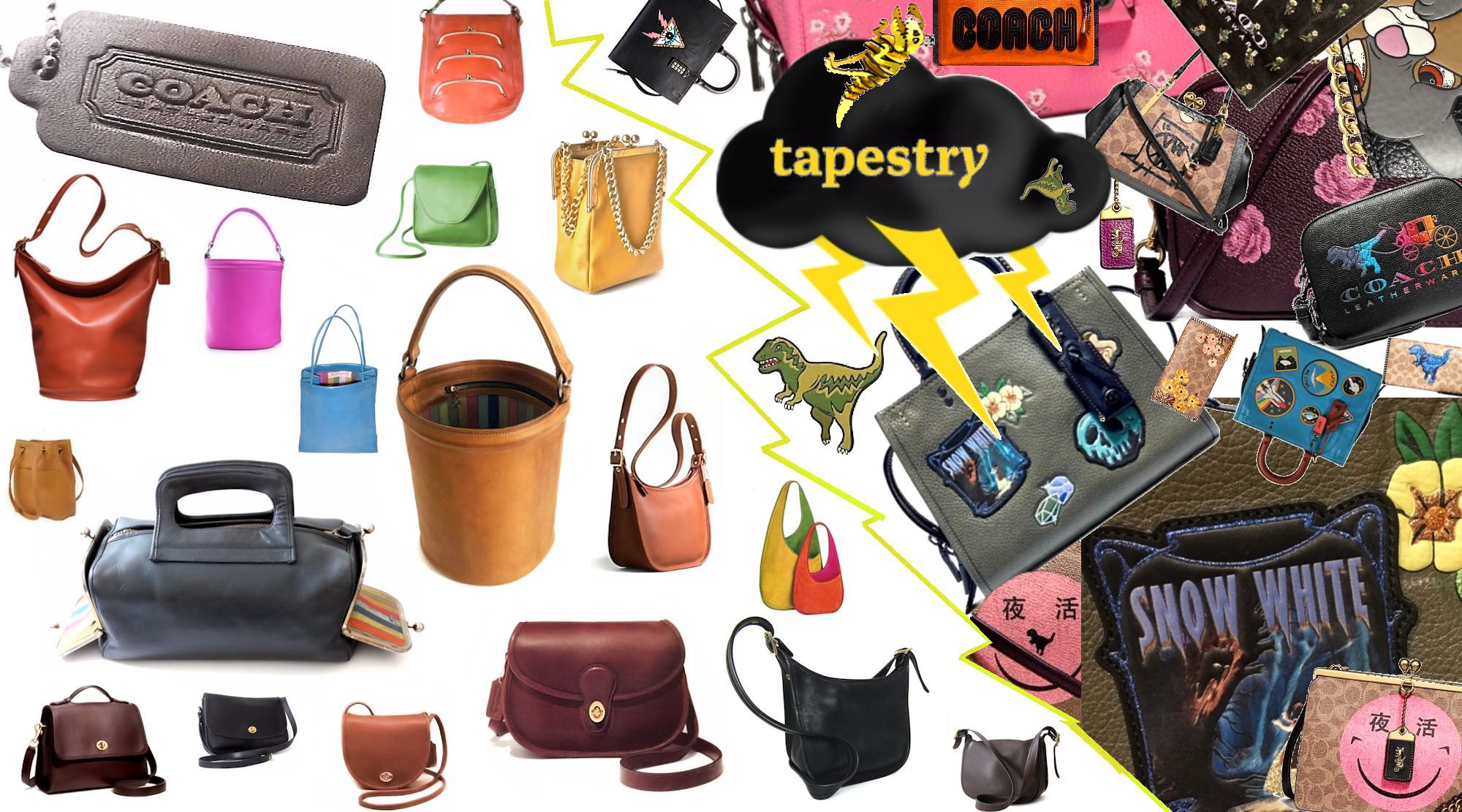
You've heard of the Coach creed? Well, what follows is our general COACH SCREED. (We were going to call it 'The Comprehensive Illustrated Guide to Coach Leather'...it does have pictures and is extremely long...but it's just too angry.)
The new Coach/Tapestry, Inc. (name change of conglomerate in 2017, now controls Coach, Stuart Weitzman and Kate Spade) is in the process of repositioning Coach as a 'designer lifestyle brand,' and we're afraid the writing is on the wall here --and in the new wording of the creed itself, which now includes the ominous term "Genuine Leather." The quality of all future Coach bags may hang in the balance. This matters since the essence of what a Coach bag was always came down to one thing: top quality full-grain leather.
If you take away, not just the natural full aniline surface (mostly gone since about 2001), but now even the full-grain leather, what's left to make it a Coach bag at all? What's left to make it any different from any other modern painted, plastic-coated leather handbag? We feel they're gutting out and erasing what had been the very essence of those once-excellent bags. Somebody really has to say something. (And no, the new Tapestry Inc. logo doesn't actually include a black cloud. We just hate them and think it should. Sponsored puff pieces abound, but remember, this is a screed.)
If you already know about the stark quality difference between full-grain full aniline leather and what the modern "genuine leather" wording indicates in the trade, then please tell others right away because many bag-buyers really still don't know, and we think everyone should. If you're unclear, look at the diagrams below or see the quick run-down on what "Genuine Leather" actually is from Business Insider. We're going to get into the details of these industrial processes below, which should make it plain to all that we have every reason to demand more than that from what was once Coach Leatherware.
At an average of $500 for a modern leather Coach bag (and some now priced at three times that), asking for a return to the uncoated, natural surface full-grain full aniline leather of old doesn't seem completely crazy, especially when new-Coach is constantly banging on about their Archive with classic this, legacy that, and everything infinitely and unquestionably "iconic." What was iconic was a sleek functional minimalism, a certain dynamic fluidity of line, always made in uncommonly excellent leather.
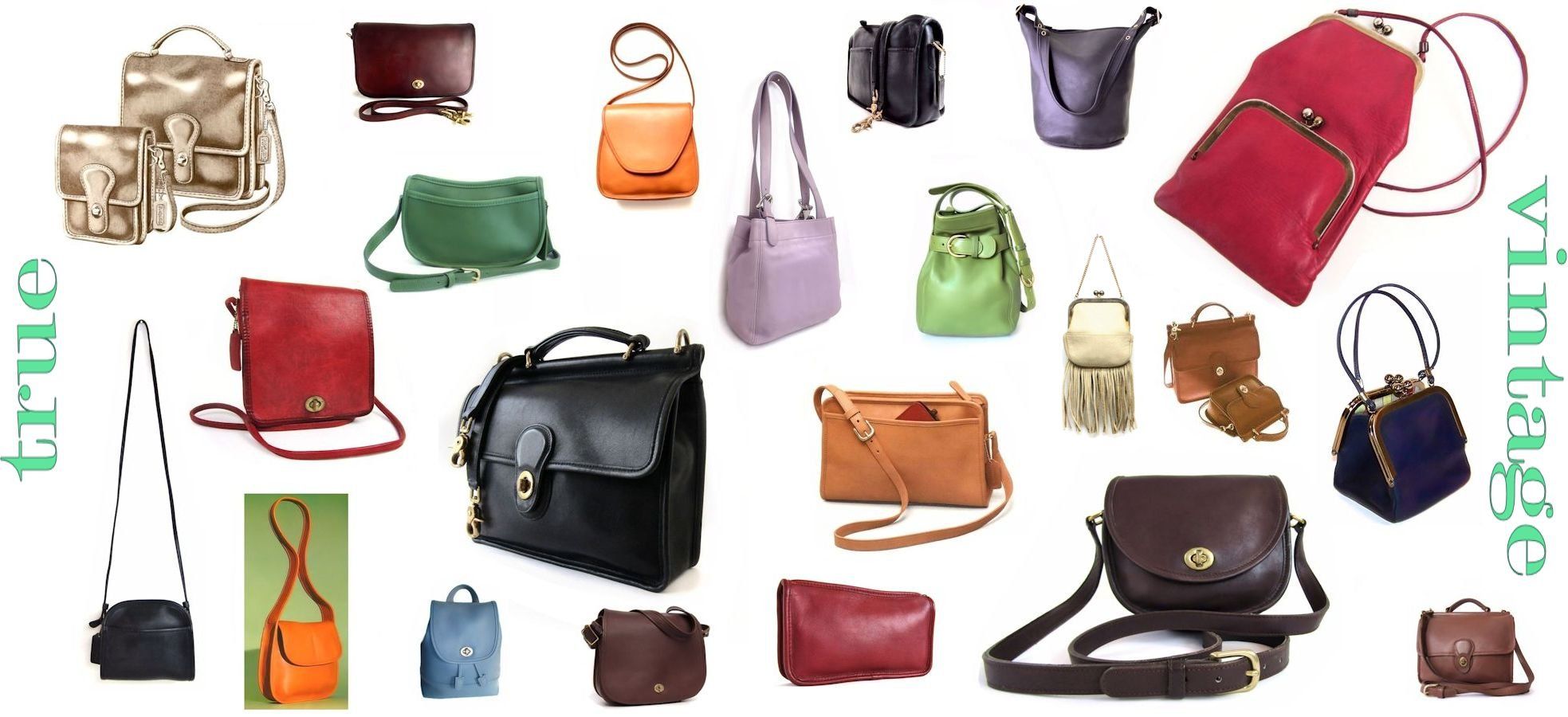
For a run of almost 40 years, c. 1962 - 2000, Coach was making some of the best quality leather handbags available at any price point. And Coach was unique in this, the only large commercial or non-artisanal outfit still making bags with a natural untreated surface, not coated with opaque paints and layers of plastic, as nearly all other leather handbags were, both then and now. A Coach bag was always first and foremost about that leather. Until recently.
The specific leather used in vintage Coach bags --full-grain hides dyed with translucent aniline dyes-- is the reason the original bags lasted so long, wore so well, looked so good, and actually improved with age. Much as they're touting it lately, the relationship with "glove-tanned" (not even mentioning the truly ridiculous "Genuine Glovetanned Leather" now appearing printed on the bottom of some current bags) was and is nothing but a marketing term. Far from being any legitimate metric of quality in leather (which full-grain actually was), this is just a blinged up way of saying "genuine leather," which we can see reflected in the creed wording in those bags. ("Glove" is just a generic name tanneries use, meaning the tannage for baseball mitts. We'll get into the details of this shortly.) What mattered was the natural surface, which you can only get with full-grain hides through-dyed with aniline colors. And that has been eliminated completely.
We don't want more Disney cartoons plastered on Coach bags. We want that vintage Coach quality leather back. And there are a lot of us who feel this way. (Not for nothing was Coach the most popular handbag maker in America for decades.) The advent of the new 'hug-it' creed seems to have increased these numbers even more, and brought things to a head. The entire extended Coven has convened and the verdict is in: this is the last straw. Get ready for it...the latest iteration of the Coach creed:
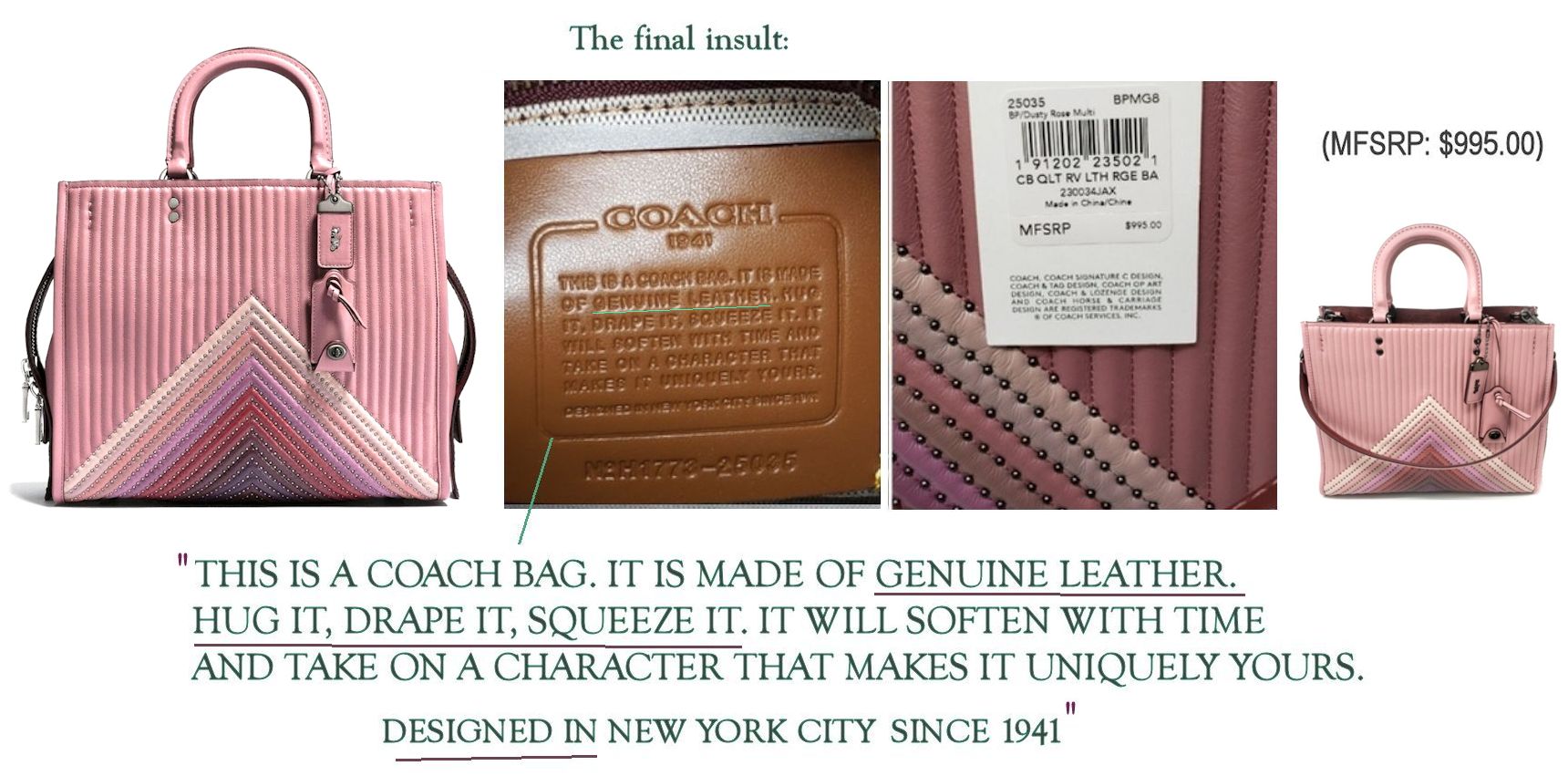
We know it's hard to believe, but yes, it's real, this is what new-Coach is up to these days, and it may be worth seeing it for yourself at a local Coach store to let it sink in. This has been appearing regularly enough lately that it seems set to become their new standard, the course being charted for the future of Coach, complete with a frankly disingenuous recapitulation of older 'hug-it' wording from 1970s Coach advertising. And while plenty of younger women found it sort of patronizing or just stupid, those with longer memories took an even dimmer view. The new wording seems to be suggesting that if only we'll just hug those stiff, plasticine bags hard enough, some kind of faux-grain split hides can be magically transformed into and behave like the excellent full-grain, full aniline leather of the old Coach bags. And that is seriously ridiculous, as anyone who ever held an original vintage Coach bag knows. (Are they proposing some new kind of leather-alchemy, or just gearing up for a future magical-merchandizing deal with Harry Potter, when the "Disney x Coach" histrionics have run their course? Who knows?)
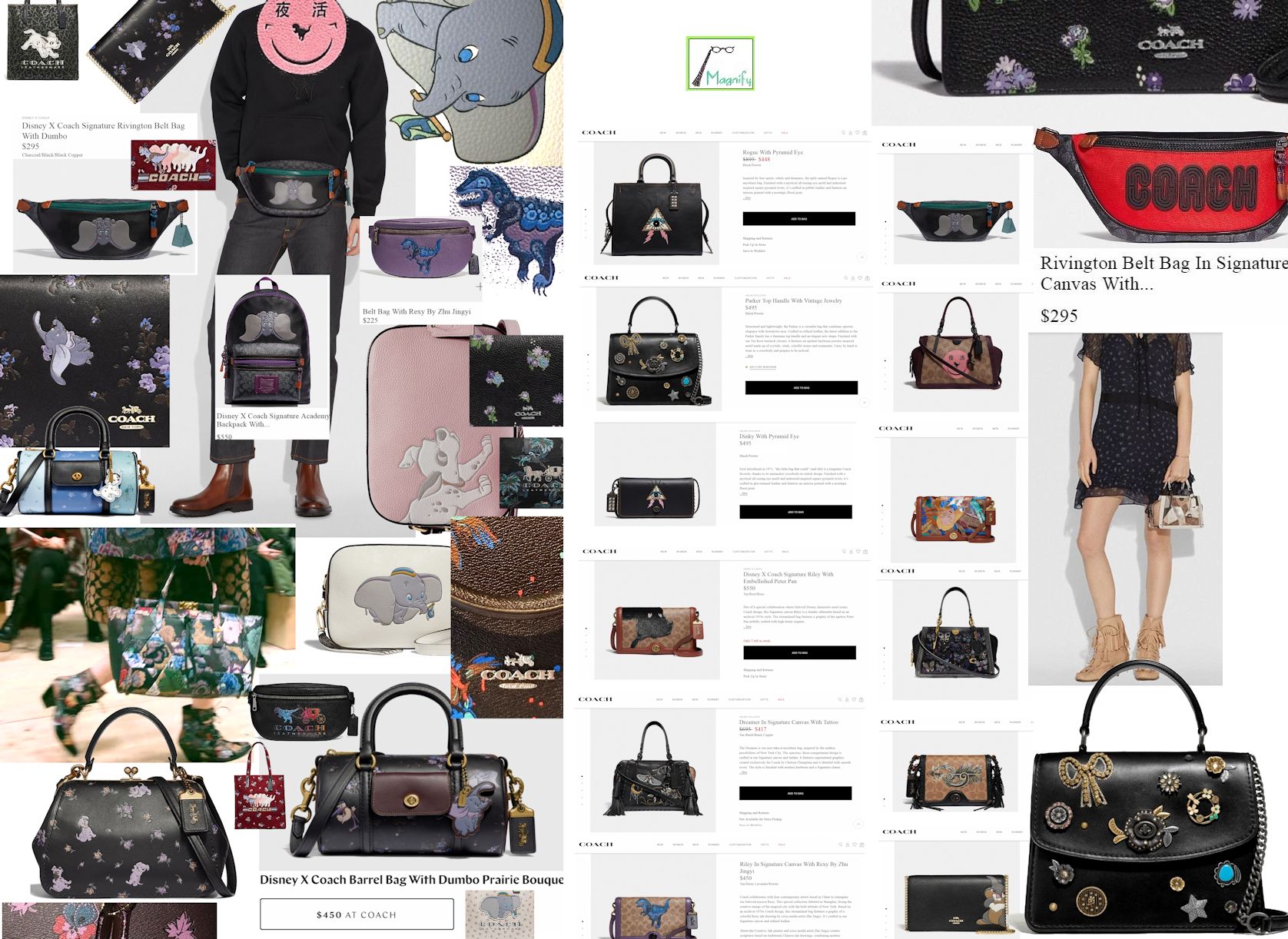
As the wording of the new hug-it creed shows (Coach Leatherware stoops to "Genuine Leather"!?), it's high time we all understood exactly what that special old Coach leather was. We're talking the concrete materials now, how those bags were made and what they were made from. Because if the language of the new creed tells us anything, it's that we're on our own now in terms of objective metrics of leather quality. The old Coach used to focus almost exclusively on describing and explaining the leather used, as the mainstay of its advertising, and the old-school Coachistas --the original buyers who put the Coach bag on the map-- knew all this stuff.
But times have changed and the new-Coach/Tapestry approach is literally opposite...silent or euphemistic at best, advocating leather-alchemy at worst. Especially for those of us who have only the dimmest memories of those sleek yet soft and chunky leather Coach bags that the older girls and the grown-ups had, pre-2001 and before logomania hit, we really need to get up to speed because Coach/Tapestry has made it no secret that they're targeting us now. And some of us feel, targeting us like children (widdle fwowers! "iconic" Dumbo!), or 'snowflakes' (so anxious for everything to be "uniquely [our] own"), or maybe just plain flakes...unable to tell when quality materials are eliminated, so long as a prominent shiny brand logo is slapped on the front of something. It's for us they devised, just before this new 'hug-it' creed, "the Storypatch" as a "badge of authenticity."
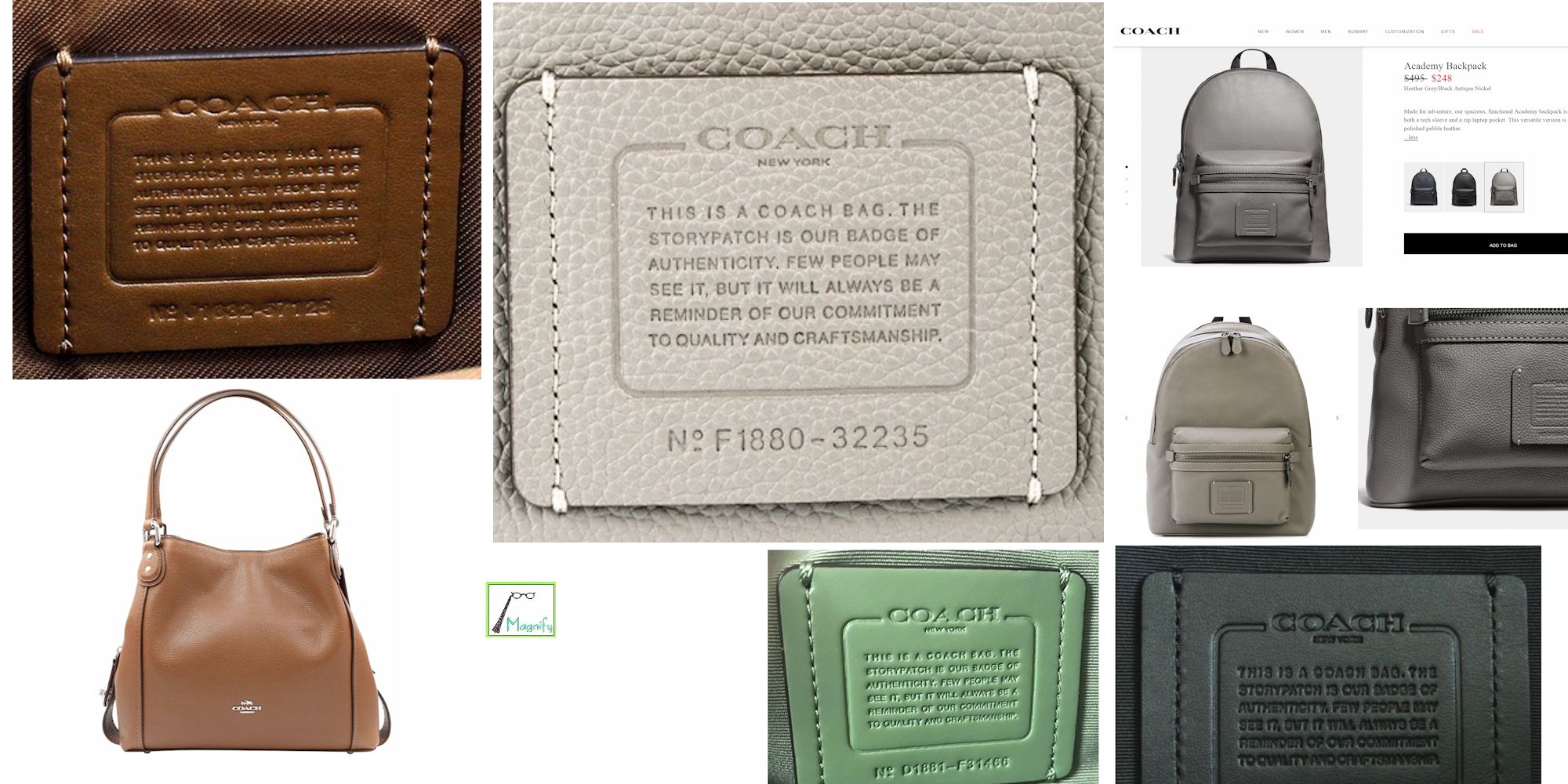
It is imperative to know, as the original Coachistas always did, that the primary purpose of the Coach creed was as a guarantee stamp, assuring buyers of concrete grades of quality leather. It was the company's way of warranting to the buyer that the highest quality materials had been used, thus the bag was actually worth the asking price. It is no coincidence that, prior to 2001, every Coach creed, from the advent of the creed stamp in the 1970s onward, contained the word "full-grain." It was guaranteed.
This is why people called it the "creed," which implies a set of beliefs, principles, a set of ethics -- a promise by the makers to uphold those ethics in their product, as the foundation of what that brand logo symbolized. And that is an entirely different concept of both branding and value itself. Where value is tied to concrete standards of quality, the brand logo is just a shorthand for that quality in the product. And so it always was with the Coach stamp. Until recently. When a creed becomes a "storypatch" (it's storytime, little girls!) and value is supposed to inhere in a logo stamp alone, no wonder it can be framed as a "badge of authenticity" -- because that much they'll still warrant us. Yes, it's really truly made in an authentically Coach/Tapestry-contracted factory somewhere in China, made of don't-ask by who-knows. But they can't tell the difference, they just want the logo because we're a designer-lifestyle-brand now. We'll cut quality and raise prices and have runway shows. It'll be great, like taking money from a baby. (Again, warned ya...screed.)
Let's review some vintage Coach ads to let this older and very different concept of both value and the purpose of branding sink in, beginning with some original versions of the hug-it language. Here's one, from the dawn of creed marking, describing the materials used c. 1975 in the Courier bag, along with 47 other Coach designs then on offer. The underlining is ours --note the concrete materials standards:
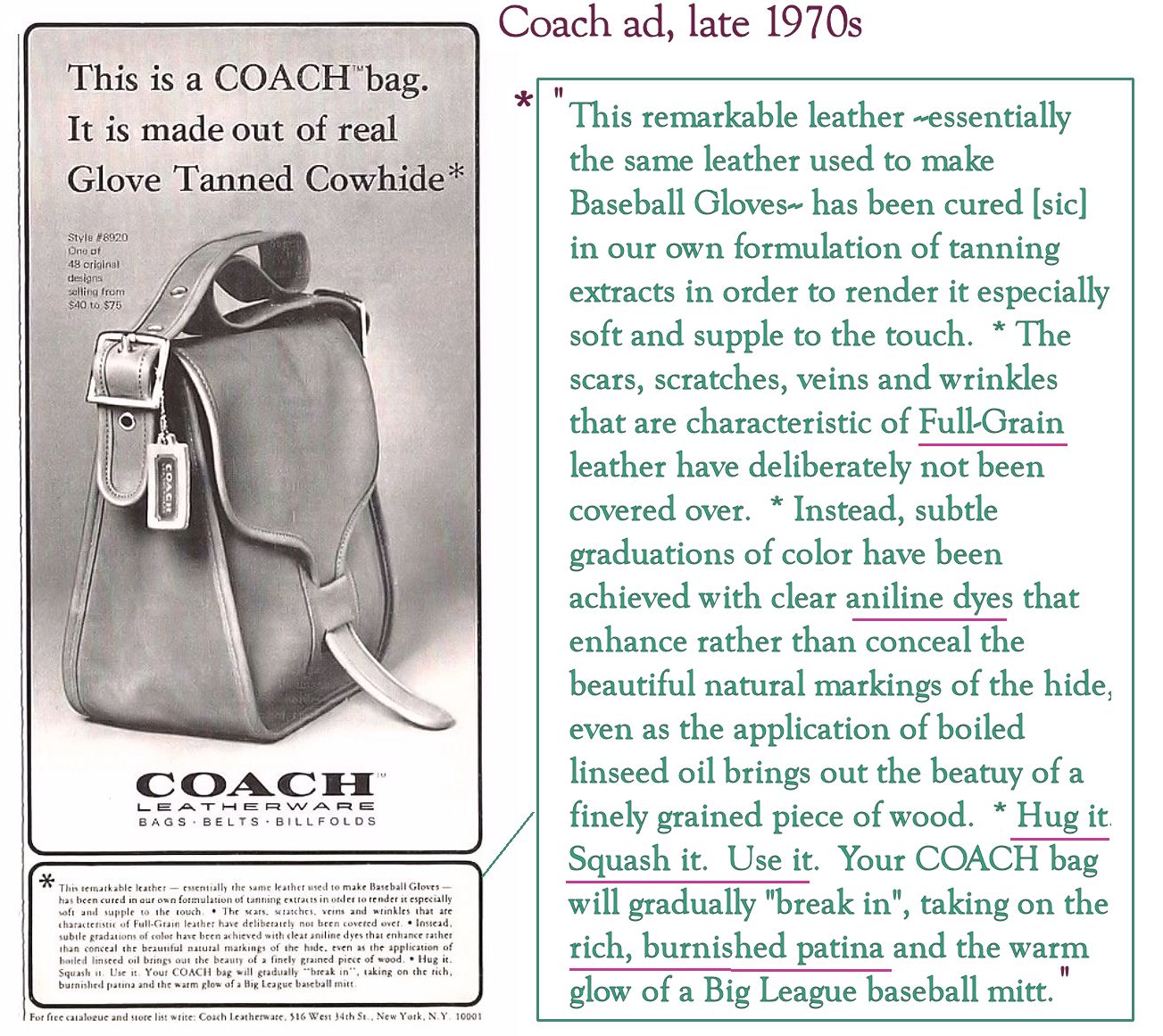
This ad, with many others, shows how the Coach company always explained their products' materials, and why they used them, as having a direct cause and effect relationship with how the bag would wear, actually improving with age. Things made with faux-grained and plasticized surfaces don't burnish. Instead their surface coatings wear through and show the physically and visually different substrate layers. This doesn't happen to old Coach bags, and that's why old Coach bags last. The burnishing and softening of the surface is a natural property of natural leather. There's a lot of flim-flam in the modern marketplace, but the facts are pretty basic.
1) The old Coach leather burnished because it was not coated with paint and plastic.
2) Only leather through-dyed with aniline dyes is not so coated, but left open or 'raw.'
3) Aniline dyes can only be used on full-grain hides.
4) All old Coach bags were full-grain -- and that is why they burnished and became 'uniquely your own'.
A full-grain leather is the real grain layer, the natural skin surface, so that when you're looking at a piece of this leather you're actually looking down into the grain, same as looking down into the grain of a piece of wood. This is totally different from a mechanically applied imitation grain pattern of one kind or another (stamped into a suede surface, layered with opaque paint, sealed with polyurethane, etc.).
Aniline dyes are translucent, clear like a stain, rather than opaque like a surface paint. They camouflage nothing. Only full-grain leather is aniline dyed for the same reason that only good natural wood is oiled or stained. Particle board is never stained, but only coated with paint or covered with fake-wood-grain decals, because that's an attempt to hide the fact that it's particle board and not real wood. The coating of modern leather products follows the same basic pattern.
Below are some typical inserts that came with new Coach bags through the 70s and into the 80s, again with the earlier hug-it language. Here, the buyer is told that "wear[ing] it everyday" is what causes a patina to develop over time on uncoated natural full-grain bags -- precisely because they're not coated with paints and plastics.
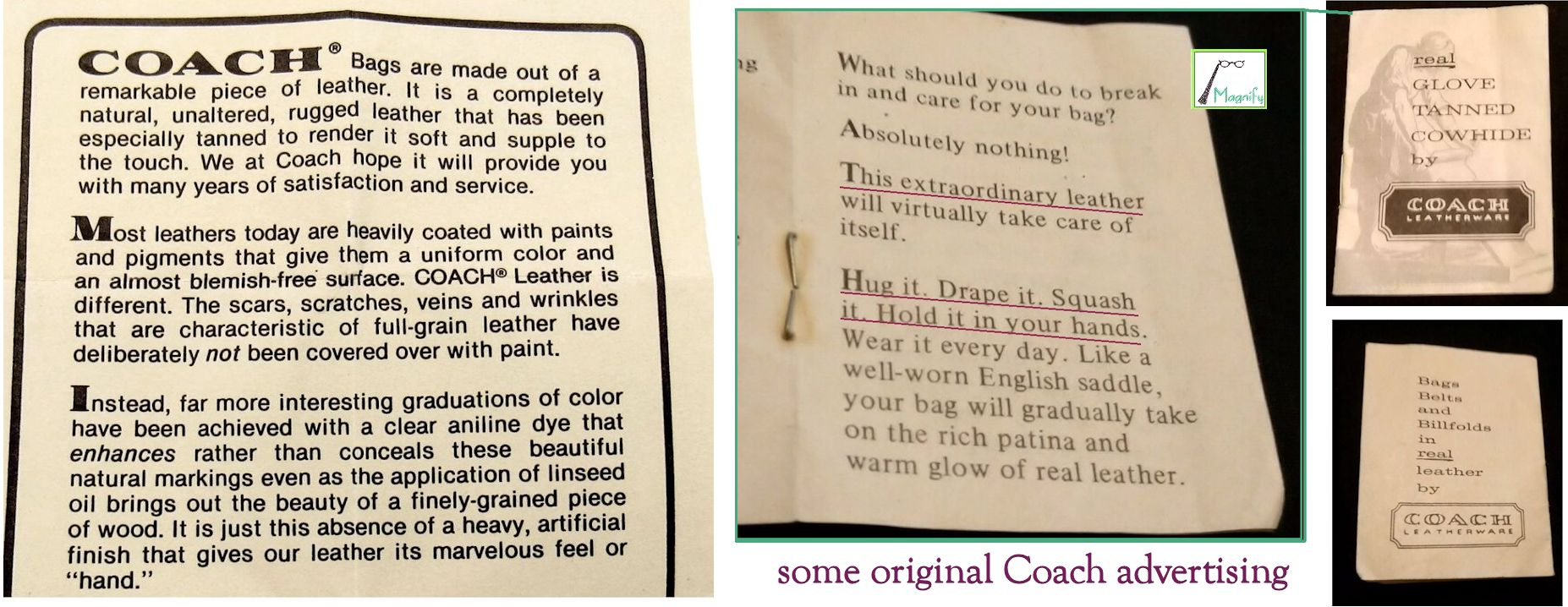
What the 2019 creed very vaguely, even euphemistically calls "a character that makes it uniquely yours" is defined very differently, far more concretely, and frankly more realistically here as "the rich patina and warm glow of real leather." And there it is, in a nutshell: back then Coach made bags of what an ordinary person would legitimately consider to be "real leather." This was the brand's claim to fame. We can see how that cause-and-effect relationship between the specific quality materials and bag longevity and patination was framed with original Coach. Clearly, the buyer was not being encouraged to attempt leather-alchemy back then on a substance no reasonable person would ever imagine as "leather." But unfortunately that's what "Genuine Leather" means these days, as we can see in one of the more common hide-stratification diagrams showing how cowhides are split into sheets and processed.
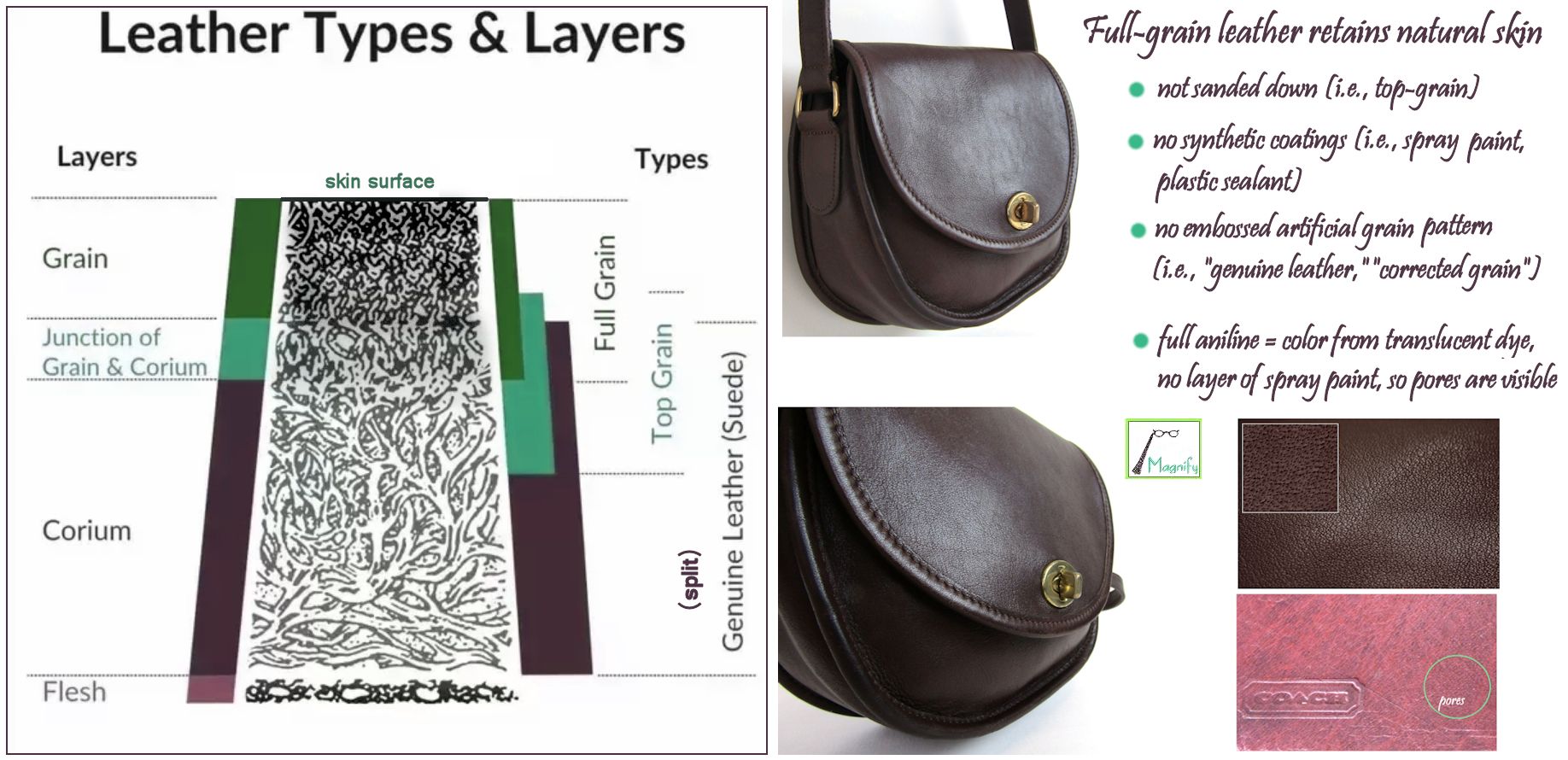
The point is, the surfaces of Coach's older leather bags really were the best grade of leather out there, full-grain full aniline, and this is why just about all of their advertising focused on describing the leather back then. The specific grade of leather was what always distinguished a Coach bag, because nearly all other handbag makers --again, both back in the day and even more so now-- used lesser grade hides with one or another kind of faux-grain machined/painted/plasticized surface.
The original Coach company, even when they were a wholesaler of men's wallets, simply never got involved with faux-grains, sanding, or in general covering up the natural markings of the hides they used. They were a leathercraft company first and foremost which, in the early 1960s, became a maker of handbags under the leadership of Miles and Lillian Cahn, and with design by Bonnie Cashin. No matter where we look in the brand's history and marketing, we see one consistent theme: natural, quality leather.
This almost single-minded emphasis on leather quality dates to the Cahn's early ownership of the company (bought out Gail Leather/Gail Novelty in 1961), which we can see from the early 60s ads below, especially the tag line, "The finest...for only a little more". It was when Miles and Lillian Cahn took control that Coach as a (retail) brand began, and began to develop its own special character. That character was always based on superior leather. (It's worth noting, the 1941 date so often heard today actually marks the proto-Coach operation, Gail, which was a wholesaler of men's small leather goods, mainly wallets and billfolds, originally part-owned by Miles Cahn's father. Miles was fighting in WWII in the early 40s, returning home and beginning to work at Gail only in 1946. Both he and Lillian knew the craft of leatherworking, and had their own separate company for years prior to buying out the (Gail) factory owners and launching something we would recognize today as Coach Leatherware. We'll have more to say about this shortly, but it's worth stressing that there would simply be no Coach bags without Miles and Lillian Cahn, and the Cahns' focus was always on ethics and quality. This screed was largely motivated by respect for them, and for Bonnie Cashin, because that respect is due.)
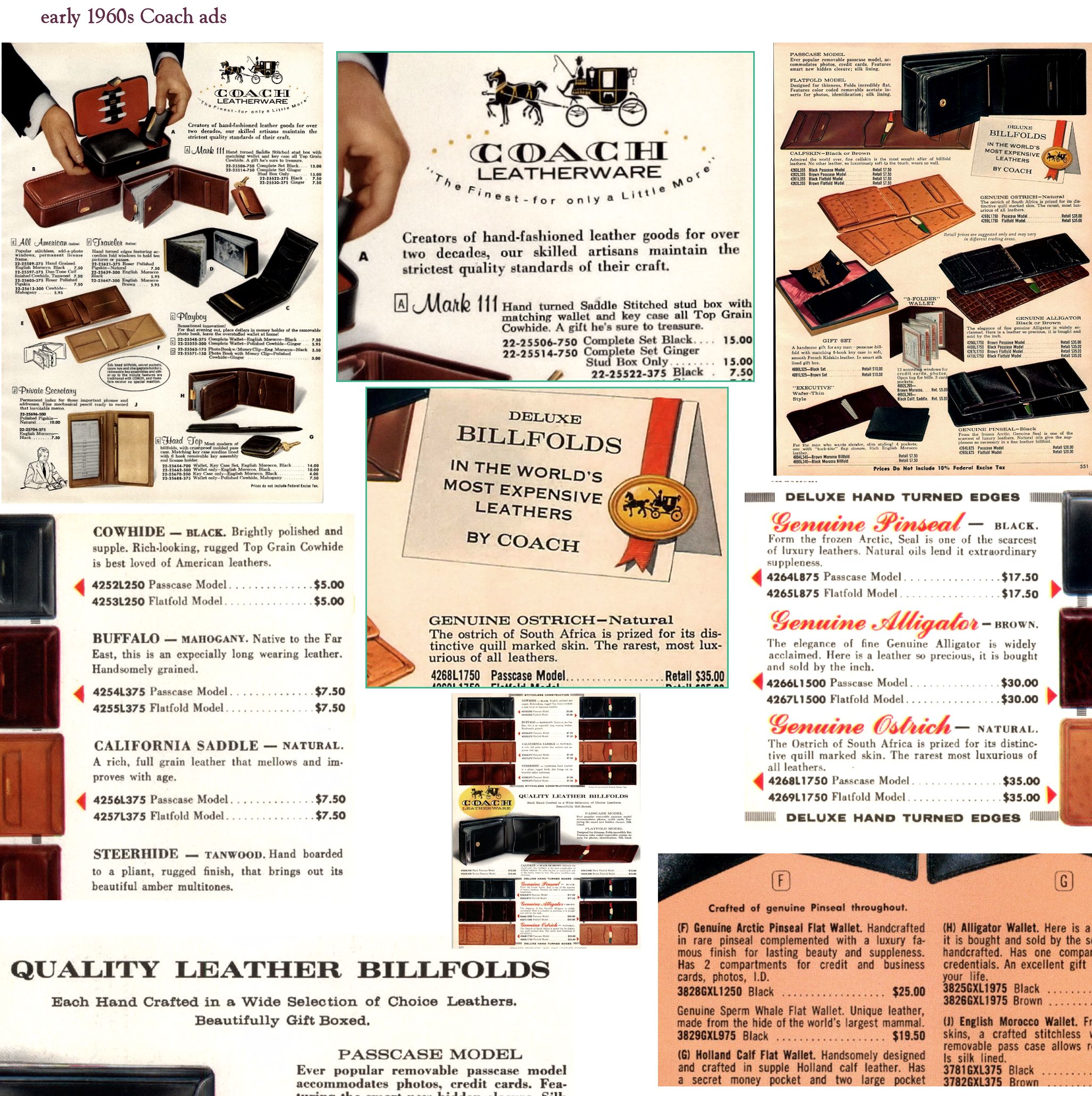
As we can see from these oldest of ads, especially when compared with competing 60s brands of wallet that stressed things like space-age materials, Coach always dwelled solidly in the realm of well-crafted and valuable grades of leather. In fact, it was a branding strategy almost totally focused on using and explaining quality leather, even well before Miles struck upon using baseball glove leather, and marketing the concept of "glove-tanned." It was understood then that the target consumer --male or female-- could both recognize quality materials, and recognize the absence of them in competing brands. Everyone was assumed to be a sensible person. (It would have never occurred to a company like old-Coach that those better materials would one day be removed from its own products, while the price was increased, yet their absence would not be detected by the buyers...but we'll get to what a different kind of company Coach was under Miles and Lillian Cahn shortly.) Whatever we might think today about 'exotic' leathers made from the hides/skins of many non-cattle animals, in terms of changing values like growing feelings of animal solidarity and desires for environmental protection, there was always a focus on using natural materials, in a natural state, and describing concretely what those materials were. It was a very different world in the 60s, and there can be an ick factor to modern sensibilities (seal? whale leather...really?), but there was an accuracy to the ads that is missing now, as well as an emphasis on quality paying dividends in greater longevity.
There was always cowhide among Coach's products, and it was always full-grain (which was known as Top Grain back then --we'll get into why in a minute). With the advent of the marketing concept of "glove-tanned," first seen in the early 60s men's line (see ad below), Coach presented it in its usual matter-of-fact way, by describing the leather itself and its origin in detail. Unlike new-Coach marketing, the old Coach ads always used concrete terms, with an honesty about them, promoting things in a particular leather on the basis of how it behaved --notice the hand grabbing and crushing the toiletries case-- and how the type of leather used actually enhanced functionality and product life-span. Because that leather actually was very good and it did behave as suggested, people liked those small cases made from it...the Cahns had struck on something here. The traditional tannage used for cowhides destined to be baseball gloves, next employed in making handbags (making women's handbags was Lillian's idea, as Miles was always proud to explain) soon took off. Finally, after about 15 years of struggle by this small company, they had something that no one else did, and it was being noticed. When they then asked (already very famous) Bonnie Cashin to design a line of handbags for them, and she agreed, the Coach bag was born, its future assured. That special cowhide quickly and completely displaced the exotic hides and skins from the Coach product line for many decades -- again, until very recently.
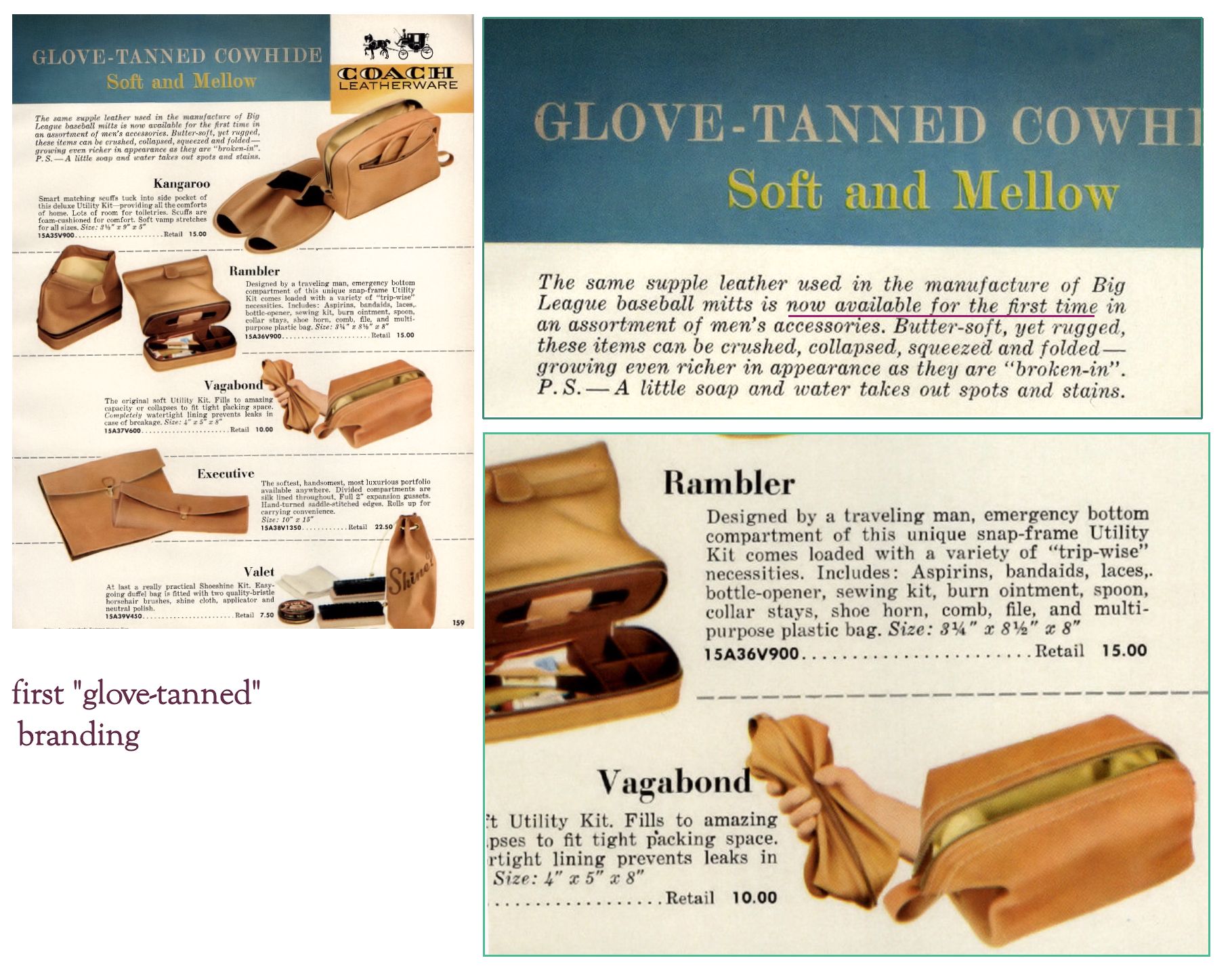
It bears mentioning that cows never were, and never are, killed for their hides. Instead, cowhides are a byproduct of food production and, until we've all stopped eating steak and burgers, there will be cowhides traded on the international commodities exchanges. The cowhides would be destroyed if not tanned into leather, but this isn't the case with the skins of most other animals, some of which are never eaten as food. One of the starkest cases of non-food-animal skins is snake skin, so it seems far less forgivable when 21st century Coach uses snakeskin today, recently become common as a trim. Notice, too, they can trouble themselves to call that "genuine snakeskin" (we haven't seen these bags in person yet, it appears to be dyed sea snake, not python, etc.), and it's anybody's guess what "refined leather" is. But worst of all, they're using this snakeskin in what we think is the most wanton way, as not only are the snakes being killed for their skins (not byproduct of food), but snakeskin is by its nature a very fragile material. Using it on the handles, of all places, amounts to bags that are essentially made to fail, meaning not just that snakes were killed for it, but killed in vain, as those new bags are already halfway to the landfill, based on serious design flaws. (Several of us sell vintage furs, in an attempt to coax people away from buying new fur and thereby supporting the modern fur industry, so we have to rant a bit about not killing animals of our own era for comparatively frivolous reasons. Yes, even non-cuddly animals that many humans fear, like snakes. Many humans fear dogs, too. Would anyone suggest this fact makes the dogs not sentient beings?)
In any case, what we see from the earliest ads is that Coach was always about the quality of the leather. The advertising always detailed to the customer exactly what that leather was. And the leather was always put to use in ways that didn't squander the hides, but instead employed them to make very functional objects that would give many years of service and could --very often did-- literally last a lifetime.
When we look at the hug-it language of that earlier period, it's clear it was meant to reassure the buyer, you don't have to baby this bag or carry it like some fragile porcelain orchid, because these bags are made well enough, and made of good enough materials, that you can safely use them without them wearing through or wearing out as things with mere surface treatments do. And as you use these bags, because the leather is the best, they will become more supple, develop more depth, take on that tactile character that only natural leather can. "Hug it. Squash it. Use it. Your Coach bag will gradually 'break in,' taking on the rich burnished patina of a Big League baseball mitt." The individual quality and longevity of a Coach bag flowed as a direct consequence from Coach's use of natural full-grain leather to construct the bag.
That was why they used the best quality leather. And now they don't. See the problem with the new 'hug-it' creed featuring, not "full-grain" anymore, but "genuine leather"? There's a reason the latest bags look and feel like plastic. In a year or two, when they've behaved like plastic and ended up in the landfill, it won't be because they weren't hugged enough.
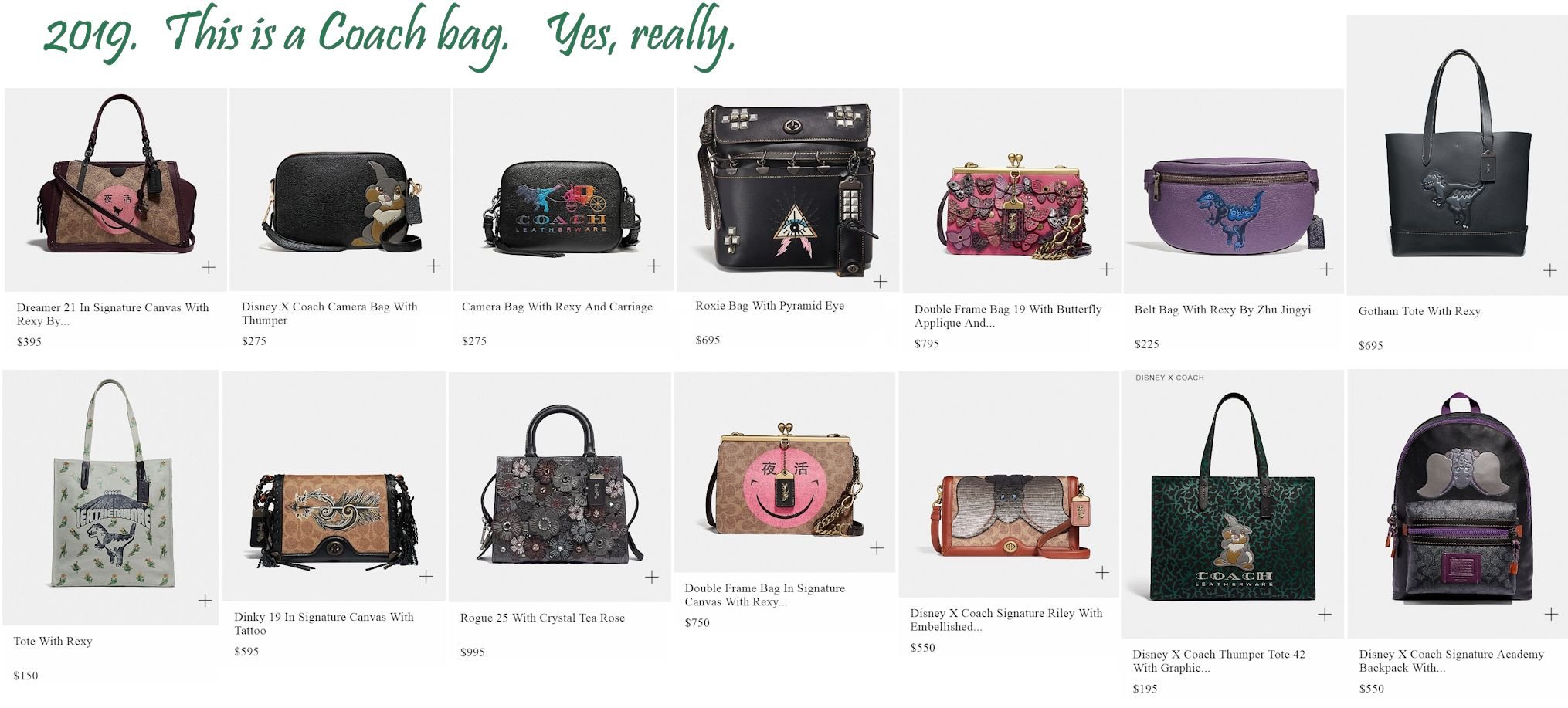
Putting aside what we may think of the aesthetics of leather bags with decal-like cartoons and twee printed florals, the issue that concerns us here is basic leather quality, as determined by its physical properties and processing. Back in the day, before the advent of modern splitting machinery and synthetic polymer coatings, leather was easy to define as the depilated (de-haired) and tanned hide of an animal, usually cattle. Initially it was all full-grain, simply because there was no mechanical process to simulate a smooth grain-like surface from any other part. If it was used upside-down, with the fuzzy underside as the surface, then it was suede, but still an intact hide, defleshed or scraped by hand. But that's over now, and has been for a century. With a few exceptions (some vegetable tanned leathers for specific purposes, industrial strength leathers for machinery, etc.), all hides are split or sliced into thinner horizontal sheets or layers now.
The initial practice of splitting was into two layers or halves, and terminology from this older method is still around and fairly common in the industry (and on the internet). It produces confusion, though, because it makes it seem there is a double meaning for the term "Top Grain." It's best to be forewarned about this, as the modern meaning of top-grain indicates the 2nd tier of quality, basically with the top layer sanded off. This is very different from the older meaning of Top Grain, when there were only two halves --not three or four layers-- possible from each hide. In the older splitting process into halves, you had the top, which was the grain layer, and the "drop split," which was the bottom portion, the inner part of the hide closer to the flesh or adipose tissue and having a suede surface on both sides. The grain layer was the good part, made into smooth leather objects, and the "split" (that underside or weaker portion) was markedly inferior and sold by tanneries for other purposes, the best of which was suede.
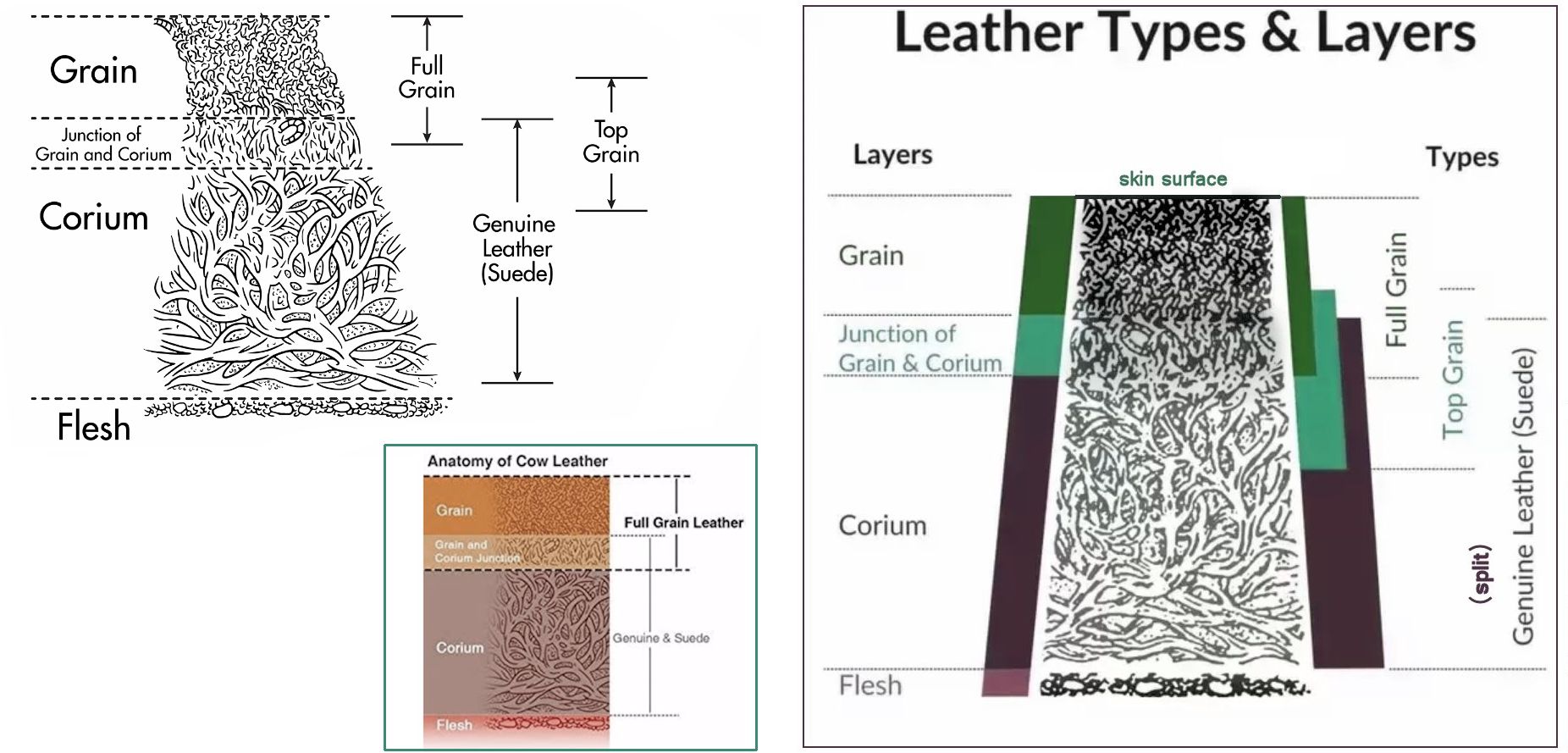
If we look again at the typical schematic rendering of leather layers (above), we see that the days of a simple top/bottom splitting of cowhides are gone. The vast bulk of today's smooth leather (i.e., everything other than suede) includes a variety of fairly unnatural surfaces, made possible by modern machinery and resulting in a hierarchy of grades of quality. It's possible to get more horizontal sheets or "splits" out of each hide now, but they're never comparable to the quality of the natural skin surface, and that surface is the grain: full-grain. Extending from the exterior surface to the corium junction, full-grain leather means the whole grain layer is intact. This is always the most expensive, especially when clear or not marred by damage, 'range marks,' etc. The reason isn't just the naturalness of the surface --this is of course what everyone imagines as leather-- but it's also an issue of strength and longevity. We can see that the area of the upper skin is the densest in terms of fiber structure, as a function of biology (thickest skin on the outside), the fibers actually forming a sort of crosshatched bond with each other. This is different from the fibers found below the meeting point of the grain layer and the corium, where the fibers become looser and lay more horizontally. This basic structural difference is why it's very difficult to tear a piece of natural smooth leather --the grain layer-- but much easier to rip a piece of suede, which is made from those looser fibers closer to the flesh. This basic structural difference is why the grain has always been valued more highly than any lower layers left over after the grain is removed.
The grain layer may vary in thickness, as the hides are now fed into large and carefully calibrated machines with rollers and blades. Just about any thickness (measured in ounces) can be precisely cut from each hide, meaning you can have thin and light full-grain, as seen in Bonnie Cashin's 60s Coach bags, or thick and meaty, like the 70s-90s bags (some of which were 8 oz. or so, a full 1/8" thick, where typical garment/accessory leather is only about 3 oz.). The advances in splitting machinery also mean it's possible to get more layers out of each hide now, and those additional ones won't be full-grain (there's only one surface per hide), but even weaker multiple split hides. And this is another reason splits are cheap.
So the basic levels of leather quality you usually hear are:
1st tier: full-grain -- the natural grain surface, not monkeyed with or adulterated
2nd tier: top-grain -- part of the grain layer, but imperfections sanded off the top, then coated to look smooth
3rd tier: Genuine Leather -- made from the drop splits, those lower suede layers, even more processed to look smooth
4th tier: bonded leather -- various % of leather shavings or pulp mixed with synthetic polymers (i.e., total crap)
If Coach leather bags were all still made entirely from full-grain hides --as they used to be-- we could just stop at the 1st tier and not worry about the rest. But now that "genuine leather" is appearing in the creed, those days are gone and delving deep into the details of modern industrial production processes for making what we consider 'frankenleather' has become necessary to even know what you're buying. (This is another reason we're angry with the new Coach. It used to be so easy.) We'll mostly ignore the generally repulsive 4th tier, "bonded leather," because it's basically a slurry of plastic with a handful of leather shavings sprinkled on the back and doesn't deserve to be called leather at all. We'd say just avoid it, it's a scam. (It's basically illegal to call bonded leather "leather" at all throughout the EU and in a number of other places. What now passes as "Genuine Leather" in the US is also not permitted to be called "leather" in a variety of other countries, and it can mean a few variations in manufacturing technique, but frankly it's never good, and almost always involves split hides surface-coated with a thick layer of something synthetic and non-leather.) We'll deal with full-grain first here, just because it's the only one that's really a natural smooth leather these days, then move into what the newer meaning of top-grain (2nd tier) is.
Full-grain is the least altered or least machined leather you can get. Possibly the most obvious definition of the full-grain leather used in all vintage Coach bags is to be found in the wording of the original creed itself. That description, combined with the warm, satiny surface you found the bag to have, and the visible lack of any flaws seen in lesser leather objects (e.g., no marring "range marks," no weak or thin areas, etc.) showed it to be a good grade of full-grain. There were two iterations of the original creed (see below), the first introduced in the 1970s and appearing into the 1980s, and the second appearing after production had expanded beyond the original NYC factory, first to other locales within the US (1980s), then to a few foreign countries through the 1990s. (In our experience Costa Rica appears the most frequently in the 90s, but it should be noted, the Costa Rican-made bags are actually just the same in terms of quality materials and fabrication as the USA-made ones of the same period. This is in distinct contrast to the lesser grades of full-grain in use after Coach was spun off by Sara Lee and production was moved to China in 2001.)
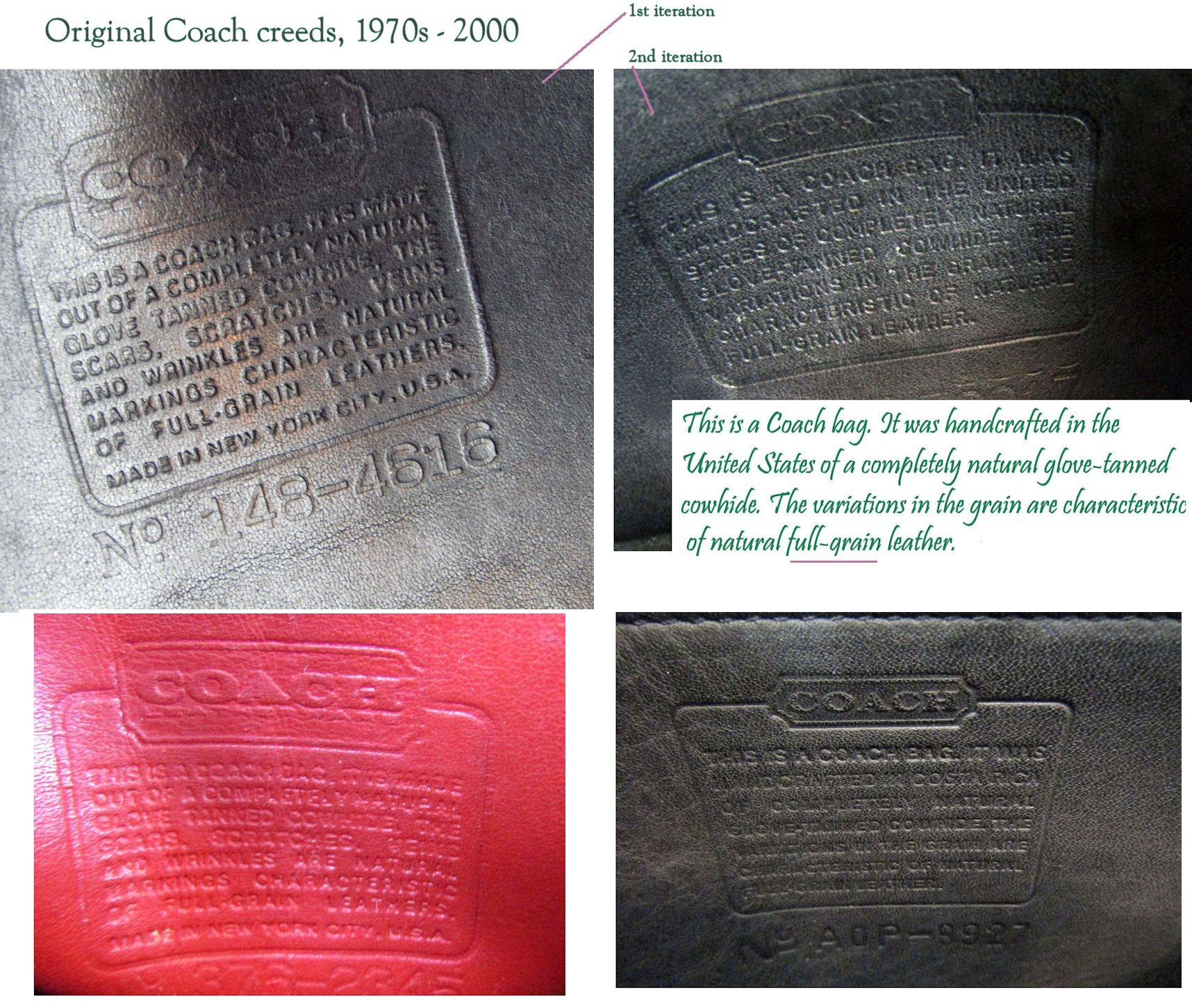
The earliest creed told buyers: "This is a Coach bag. It is made out of a completely natural glove-tanned cowhide. The scars, scratches, veins, and wrinkles are natural markings characteristic of full-grain leathers." And in some ways, this is all you had to know. It was, in essence, their guarantee that it was the best grade of leather because only the very best cowhides, or sections of cowhides, look like those seen in old Coach bags when they are left completely natural. Look closely at any vintage Coach bag (vintage = 20 years old or older) and it rapidly becomes clear that the only irregularities you'll find in the surface are just that, natural markings, of the type that arise from the physiology of the individual cow, like light fat wrinkles or veins. It's this aspect that makes each hide slightly unique, having an almost wabi-sabi quality, the slight variations or heterogeneity seen in all products of nature. Yet one never sees serious blemishes or damage in any hides used by Coach during the era of the original creeds because quality control was strict. Coach selected the best full-grain hides they could get, and used only the best parts, because they were a leathergoods outfit above all else, and this shows to this day in the surviving bags. Between us all, in the thousands of Coach bags we've bought, sold, carried, traded, hoarded or coveted over the years, never once has any one of us seen a marring "range mark" (i.e., mark from where the cattle was branded, serious scars from barbed wire, etc.) on any hide used in an old Coach bag. When it came to the leather, corners were simply not cut.
So vintage Coach bags were not just natural full-grain, but only the best portions of each full-grain hide were used, with no flawed pieces hidden in gussets, side panels, straps, etc., as was done by some other makers of bags in order to conserve on materials and thereby cut costs. Coach bags stood out in this regard. Only 1% to 5% of the cowhides coming into tanneries can ever be made into full-grain leather at all (and especially full-aniline, which again, conceals nothing), simply because only that small fraction are in good enough condition. To be free of serious surface blemishes, holes, heavy range marks, butcher or tannery damage is rare, so those clearest hides are generally selected to be used for full-grain -- that is, for purposes where that natural surface will be visible in the end product. The vast bulk of hides have too many problems, if not in one area then in another, such that most are destined to be used for tannages that allow for covering up of these things by sanding them down, concealing with paint/polymers, etc. (i.e., top-grain/corrected grain), in part because people have been conditioned to expect complete uniformity in leather now (despite the fact that this is not, and never was, the true nature of leather). Only the best cowhides are clear enough to be left natural and uncoated, meaning full-grain is the rarest, most desirable, most expensive to work with.
Within that fairly small category of hides acceptable for full-grain tannages, they're further sorted from there, from almost completely clear and with just a few fat wrinkles or other natural irregularities, through small range marks of a given number in a given section, down through visible brand marks, holes, or butcher or tannery cuts in the more important sections, like the bend or butt. Different tanneries use different grading systems (1st, 2nd, or A grade, B grade, etc.), often with range marks/irregularities categorized by severity and number within a certain percentile. No single hide is ever perfectly free of all irregularities, because it's a product of nature, but it's common to have batches graded and sold within those percentiles, as with TR, "tannery run," which varies somewhat with each tannery, but usually means you'll get an average in a batch, say 50% Grade B, having three or four defects in the best areas of the hide, then equal portions of Grade C and Grade A, say 20% each of those (grade A having only one or two flaws in mostly secondary areas, grade C having big problems in key areas meaning a lot of waste), then sometimes there's a final 10% of scraps or "utility grade," filler stuff with really heavy damage. The grades boil down to how much of each hide is usable, especially in the prime areas or cuts, and how much will be waste, once you start cutting out sections for things like making bags.

The chart above shows a couple of the many ways tanneries sell sections of hides, but also grade the whole hides with more attention paid to any irregularities in the most important areas or quadrants. Beyond the presence or absence of range marks or other flaws, and the hide section in which they appear (or don't), these various quadrants of the hide vary in consistency. If lesser hide sections are used (e.g., bellies), it will affect the quality and lifespan of the eventual bag made from them. Even full-grain is sliced from the back into fairly uniform thicknesses (measured in ounces), but some areas are just naturally stronger and with better surface texture than others, again as a function of biology. The different sections traditionally have different uses, but the "bend" or "butt" is generally seen as the best, a large continuous length that is the densest and most regular in consistency, graduating by degrees down to the "belly," which isn't good for much in a bag, often being too thin, weak, and even of a flappy, irregular density. You'll see occasional natural wrinkles and veins in the hides used in older Coach bags, but you'll never see weak spots and never bellies or anything like it (though you do in lesser bags of the period, hiding in side panels, gussets, interior pockets, etc.).
The way the four-tier model of leather grades makes it sound, a person could be forgiven for thinking that individual hides would be graded into one of those tiers, but it's not so. (The 4-grades thing is in use by a lot of outfits retailing men's leather goods today, but it's not in use by tanneries. It's the products made from those sections of hides, and how they're processed, that can be hierarchically ranked for quality.) Instead, many tanneries' finished offerings are grouped by intended end use (to make furniture, saddles, garments, footballs, etc.), or by a variety of names that describe a specific tannage (series of methods and processes), some in common use across tanneries (e.g., Latigo, Cordovan), and some devised and named by the individual tannery (e.g., "Java" at Tanneries Haas or "Chromexel" at Horween). Certain end-uses for leather require specific tannages, some traditionally employing full-grain hides, and some not. Just as a maker of handbags would develop a good reputation over time by adhering to a certain high standard of output, so it is with tanneries. Some tanneries' A grade full-grain hides are going to be superior to those of others, on the average. Some are better at certain tannages than others, too. We'll get into more detail on the particular tannage used for Coach bags in the section on "What is Glove-tanned?" below, but it's worth noting that one of the reasons those old Coach ads stressed that the leather they used was the same as in "Big League baseball mitts" was to point out the quality of the tanning. (You will sometimes hear a rumor that Miles Cahn only began using baseball glove leather for small leather goods because of some fluke where he got it on the cheap, but this is not to be credited. Baseball gloves had had about 60 years to develop into a specialty product by that time. Glove leather never went begging, least of all that tanned by the outfits supplying makers of mitts to the US major leagues.)
The naturally smooth surface of full-grain has always been valued and it's why tanneries generally select only the best or clearest hides from any given batch to make into full-grain tannages, since there are no additional processes (sanding, stamping, coating) to hide any irregularities in the surface. Every other kind of smooth leather is basically faux-grain because it's not the natural skin surface, the grain, but some artificial look-alike. It's the preservation of natural skin surface that counts, and only full-grain provides that truly durable and renewable surface, able to burnish and develop patina over time.
Coach bags were never really cheap, but it was because the materials themselves actually were superior, and turning those better full-grain hides into bags was highly skilled hand work. All the leather was a good quality full-grain, in every vintage Coach bag we've ever seen. They were noteworthy for it, and you actually could trust them. They also employed highly skilled craftspeople, and were proud of it (witness Miles Cahn's 1977 coffeetable book, The Factory, which was a sort of tribute to the workers at the NYC factory, showing members of Pocketbook Workers Union, Local 1, AFL-CIO on the shopfloor making belts and bags). On the first page of a catalogue from 1983 (below), we see such a craftsman positioning a die, with the bottom caption, "The cutter positions his dies carefully. He is mindful of the high cost of leather and is looking for choice cuts that will not throw off excessive waste." Why? Because the hides they were using were good full-grain, the best, the most expensive grade. Everyone knew it, and you could see it in the finished bags.
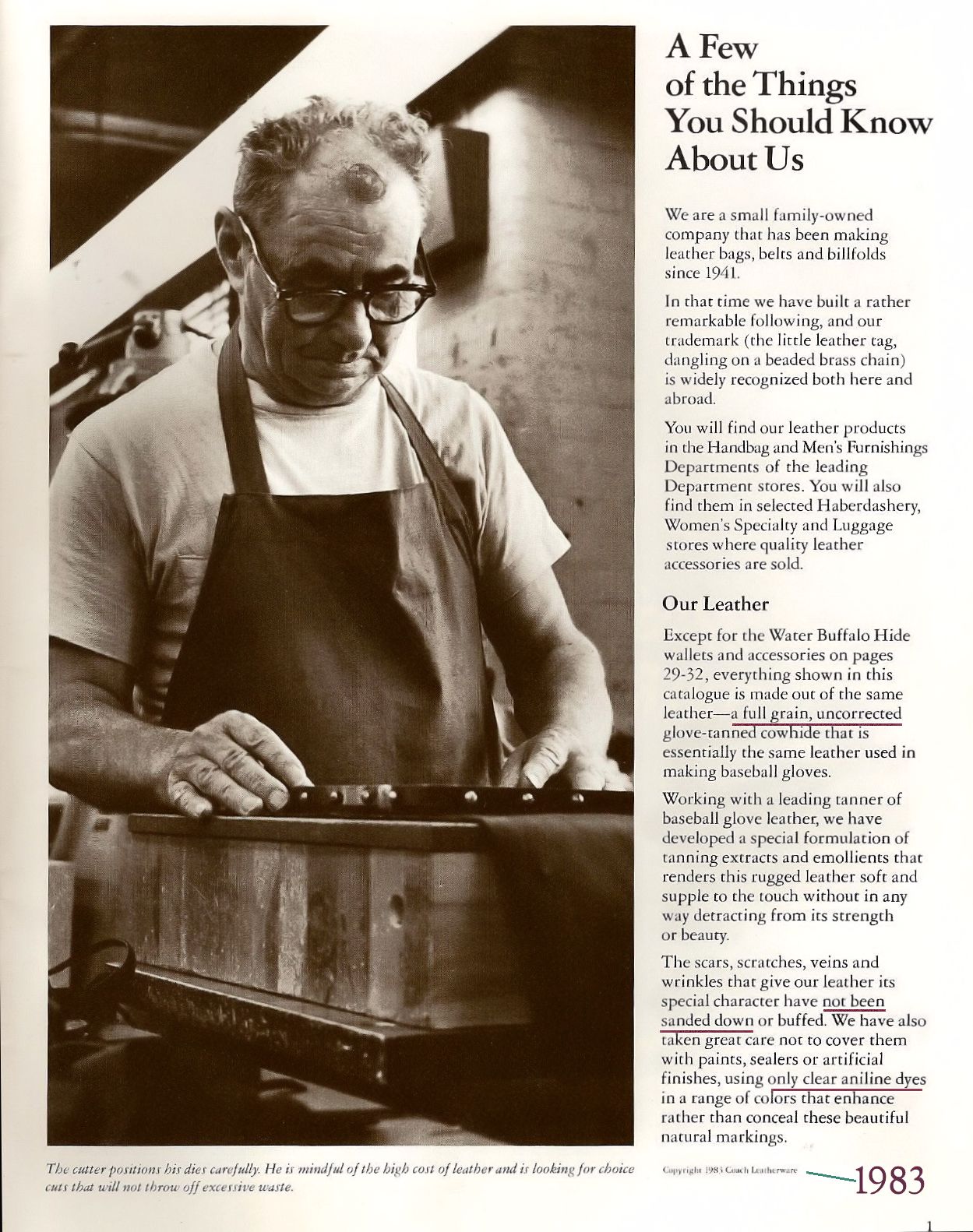
Thus, the use of full-grain leather --or not-- is fundamental, the single most significant factor in quality, both in terms of production cost and longevity. It's why the easiest metric of a good quality Coach bag is whether the word "full-grain" appears in the creed or not. The pricing wasn't trumped up or arbitrary back then, but followed a basic logic of costs of production and consequent benefits to the consumer. It was understood that a Coach bag would give many years of service, while developing a patina uniquely its own. Back then --because of the specific materials-- it actually would become your bag as it burnished, patinated, became unique.
We'll get into the significance and process of aniline dyes further along, how to recognize full-aniline by the presence of pores (actually the easiest test of the true nature and quality of a leather bag), and some specifics of the "glove" tannage used in vintage Coach leather. But first, we have to get through those less-than-best grades of leather/leather processing, because everyone needs to know they're out there.
We consider all smooth-surfaced leathers not left as full-grain to be faux-grain...because their surfaces are manmade imitations of the natural grain markings found on animal hides tanned in their natural state. Before 1996, the US Federal Trade Commission, via its "Handbag Guides"/"Leather Guides," more or less concurred in this, i.e., that "leather" meant the old Top Grain, today called full-grain, but those days are gone. We'll get into the regulatory state of things that has allowed the near-total normalization of faux-grain leather shortly. But for now, we'll define faux-grain as leather made by imprinting fake grain-like markings, even simulated pore structures, on surfaces that were substrates of a hide, including coating those surfaces with paint and/or plastic. It can also mean imprinting or "embossing" the natural markings of one animal on the sanded down or split hide of another (e.g., ostrich quill pattern on cowhide). The vast bulk of garment and accessory leather on the market today is made of one variant or another of faux-grain, especially "top-grain/corrected-grain." This category stands in the middle between what we consider the good (full-grain) and the bad (genuine leather), and we'll just pretend we didn't really see the ugly (bonded leather). So we'll start with top-grain/corrected grain.
Below we have another diagram, an attempt at a sort of flow chart, from the splitting of the hides on the left to their eventual surfaces on the right. The first thing to take away from this is that today's usual meaning of top-grain is not at all the Top Grain of old, where it just meant the top half of the hide. Now it's "corrected grain," "laminated leather," "pigmented leather," because the surface you see is the natural markings of no animal. Although not as bad in terms of artificiality of surface and weakness of hide stratum as "genuine leather" usually is, today's top-grain is still a faux-grain because the hides used to make modern top-grain have problems, blemished surfaces that need to be "corrected" and are therefore not good enough to be used as full-grain (again, aniline dyes are translucent, they show the surface). So making top-grain involves use of lesser quality hides, sanding them down from the top --removing most of the grain including the natural surface-- and spackling with polymer pastes to fill up any remaining voids, sealing it with layers of opaque paint and synthetic coatings (usually polyurethane), and stamping ("embossing") a fake grain-looking pattern under high pressure and heat into what had been, until recently, a slightly fuzzy suede-like surface. It's supposed to look like a natural or intact full-grain...when it's not.
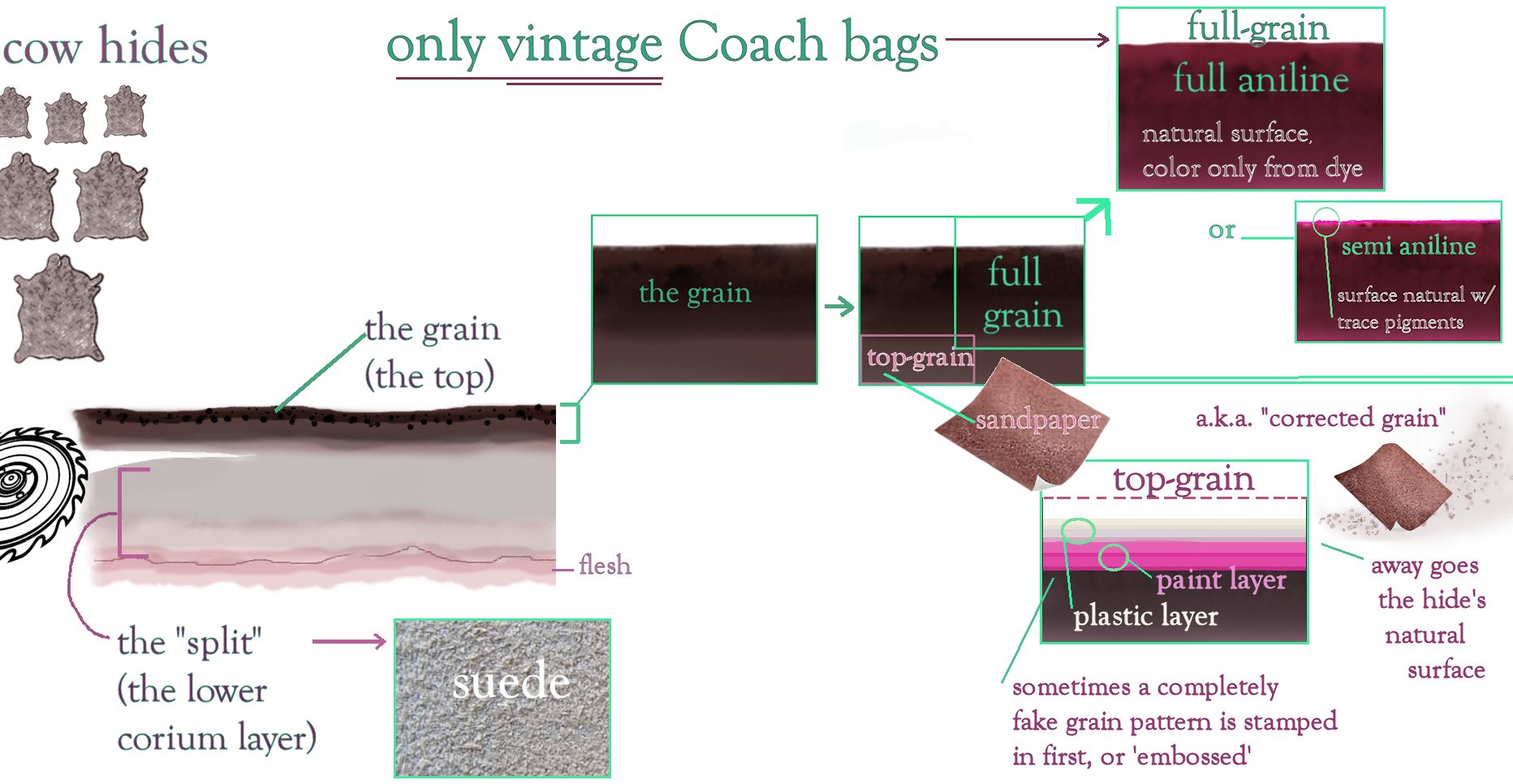

Corrected grain and top-grain are basically synonymous at this point, this new meaning of top-grain being completely normalized and forming the bulk of smooth leather used in 'better' handbags today. The processing of top-grain can vary to some degree by tannery, and some grades from each tannery are better than others in terms of less artificiality, but there is always a removal of the natural outer skin surface of the hide. (Easy way to remember how it differs from the older Top Grain halves model --in this top-grain the top is removed.) This is done with a goal of removing all irregularities in order to get a completely uniform, homogeneous surface. Everyone has seen this stuff because it's everywhere today. Total uniformity of surface is now taken as 'normal,' despite the fact that it's decidedly unnatural.
The mechanized finishing procedures used on corrected/top-grain are elaborate, and can vary to a degree. The typical sealing process is with liquefied paints and polymers, sprayed by rotating carousels of paint guns as the hides pass under on conveyor belts, then a stamping of faux grain patterns via mechanized rollers acting as dies. But there is overlap with some frankly more unpleasant methods seen in bicast, which involves more of a free-standing sheet of polyurethane/vinyl, and is usually conflated with "PU leather," a.k.a., "Genuine Leather," which has the layer of polyurethane/vinyl glued on top of split hides, rather than (heavily damaged, therefore heavily reduced) sanded-down grain-layer hides. It means there is variation in quality even within the category of top-grain/corrected grain, and some top-grain/corrected grain veers unappealingly close to bicast "PU leather"/"Genuine Leather," which is not legally considered leather at all in many places.
It may be easier to just watch a couple versions of these processes going down. Coach always used chrome-tanned leather (as does nearly everyone, vegetable and other tannages having become obscure these days). You can watch the chrome tanning and corrected/top-grain finishing process in a video from Fenice, above, about 13 minutes long (and sure to be 80s era footage, based on the music). We see some spackling of deep gouges ("stucco" @ 9:10) before the sanding off of the uppermost grain layer, then spray painting via paint guns in rotating carousels (10:00), artificial "embossed" grain patterns being stamped in by mechanized rollers (10:25), followed by dry milling or tumbling, and that batch of corrected/top-grain is mostly done. At about 11:00 we see bicast, a term now more common in automotive and upholstered furniture leather, but relevant as it began in the garment industry. If you watch this video through you'll understand just how bad "bi-cast" (i.e., bi, two, two layers) really is. The future surface of the 'leather' is the bright blue goop being poured out (11:25), built up by "creating the finishing film on a continuous support of release paper," which sheet is then glued and pressed onto either a split (suede texture) leather backing, like a decal, or onto a heavily sanded down piece of corrected/top-grain.
Thus, when the sanding of the grain surface is so deep, and the resulting suede-texture consequently so pronounced, that a mere sprayed pigment/sealant film won't cover it...things amounting to free-standing vinyl/pu coatings are then glued on. This overlap of production technique is rarely discussed, but shows that there are grades within top/corrected-grain, the lower end of which can be as bad as what gets marked "genuine leather," especially in the US. When that plastic surface is thicker than a film and more like a sheet of polyurethane on fabric backing, the only thing really distinguishing corrected/top-grain and "genuine leather" is the structure of the hide glued on the back (i.e., a sanded down part of the grain layer, vs a split layer from the corium). In those cases, any actual leather content does the consumer no good at all as leather, because it's the plastic you feel. This is really why we'd group corrected/top-grain with "genuine leather" in terms of being a faux-grain. It may be a thin film, or it may be a heavier plastic layer, but it won't breathe as real leather, it'll never burnish, and any leather in there is hidden from the user of the object anyway, so what's the point? It's no wonder most apparently-leather bags these days feel like rubber or plastic. We'd say it's because, from the point of view of the end user holding them, they pretty much are. And that shouldn't be.
Alternately, a longer video (above, about 25 minutes) from Optima, an Italian tannery, shows a slightly updated, environmentally cleaner process for making top-grain/corrected grain (skip the beginning without a strong stomach). Optima doesn't deal with splits/"genuine leather" at all, which you see traveling away early on to be sold to others. When the hides are shaved by the machine and the blobs go up the conveyor belts, that pulp is what is used in bonded leather. Later still, the sanding (as usual, euphemized as "buffing") produces a powder that was the natural grain, then on to "embossing" --fake grain patterns again, pressed in under high heat and pressure-- followed by huge rotating carousels spraying opaque paint/polymer mixtures. They're going for uniformity and homogeneity of surface, because uniformity has been normalized, and you can see them get it with a garishly shiny, plasticine bright red leather seen in flex-testing of the applied surface. Sure enough, it does all look the same in the end...but then so does a wood-grain decal on furniture. From our point of view, that finished red 'leather' shows the scope of the problem.
Thus, the new meaning of top-grain (= "corrected grain") is in large measure why a four-tier leather-quality model now exists, and nearly all modern handbags have that synthetic to semi-synthetic surface --except the vintage Coach bags. This homogeneous and 'blemish-free' surface may have its aesthetic uses (somewhere?), especially when 'the masses' have been conditioned to expect a 'perfect' uniformity in leather, but it does mean most modern leather has that slightly plasticine texture, which is why there has arisen such frequent public confusion in differentiating pleather (totally petro-chemical and synthetic) from leather (tanned hide of an animal). Because after processing, faux-grains aren't just uniform, but almost visually identical to and indistinguishable from PU. And is that really what we want in a leather bag?
So while top-grain/corrected grain wears badly compared to natural full-grain (the surface is artificial so it eventually wears through), it's still generally a better product than things being marked "Genuine Leather" today, first because at least some of the stronger grain layer is left, better tensile strength, and second because the bulk of it has only a comparatively thin film of paint and polyurethane on the surface, bonded in a strong way to the (part-grain) leather underneath. So while it is coated/laminated with some kind of film, at least it's usually not covered with a synthetic decal as seen glued to some (corium-layer) split hides. Because of the remains of that grain layer, it's structurally a bit stronger and better than "genuine leather" made from splits, the drop splits of old...what many, including many European tanneries, still consider rubbish.

A variety of terms are often heard with today's top-grain/corrected grain, some worth noting for their weasel-wordy qualities in use. Those old enough to remember Ricardo Montalban's "rich Corinthian leather," later admitted to be just a marketing term for a product coming out of a tannery in New Jersey, will have some background in this phenomenon.
"Corrected grain" feels decidedly euphemistic if you consider that "correcting" something generally means improving it. It doesn't ordinarily mean removing the desirable natural surface of something and substituting a fake one. "Laminated leather" is more accurate because after the natural surface is removed, lamination is what is done, with layers in varying thicknesses. (Coatings thicker than 0.15 mm run the risk of becoming "not leather" in much of the world, but US regulations don't even consider coatings as an issue, which we'll get to below.)
"Buffing" to describe sanding also really seems a stretch of language. "Snuffing" is also used, as in "snuffed top-grain," and it means sanding, but this term usually doesn't make it outside of tannery circles, and it's not being used in marketing patter. "Buffed" is. And any conventional understanding of buffing a surface does not mean abrading, planing or sanding it away, which we can easily see by the concept of buffing leather objects -- not with blades or sandpaper, but with a soft cloth. Instead, to buff is to polish something, usually with friction (heat) and pressure compacting some kind of fibers into a smoother, shinier state. Even burnishing (e.g., a "burnished edge" in leatherworking) is essentially polishing via compression and friction, having nothing to do with flawed-surface-removal. The mechanical procedures now used to produce "corrected/top-grain leather" involve removing the surface grain with abrasion and replacing it with something else, something made by machines, not nature. And the only thing that can really be "buffed" is full-grain leather, because it's the only thing with the intact natural grain surface fibers that could take a polish by being compacted. (You also can't "nourish" a sealed, fake PU grain layer, whatever anyone tells you about "nourishing" your bag with "leather milk"...but that's a separate rant.) You almost never hear anyone speak less than approvingly or at least apologetically about the modern meaning of top-grain, and the acceptance of "buffed" to describe a fairly violent or destructive process like being sanded down is one element of this. Corrected/top-grain is almost universally presented appealingly to the general public only because just about everyone is selling it now, and has a vested interest in making it sound good (and especially better than the competition, which is "Genuine Leather").
Today's so-called "embossed leather" is probably the most prevalent and disingenuous of the terms flying around in advertising patter, and the most worth noting. What it should be called, if anything, is "embossed-grain leather," because it bears no real relationship to the original or true meaning of embossing, which simply meant impressing patterns into the natural surface of full-grain leather for decorative effect, similar to tooling. The small incuse stamp seen in the earliest Coach marking (before the creed stamp there was just the word Coach inside a cartouche, stamped in a corner of the object), and even the old creed stamp itself, were technically a form of (actual, original) embossing. The full-grain surface was unaffected by this, just as the original meaning of "embossed leather" had nothing to do with removing layers of the surface, coating it with polymers, and stamping in something meant to simulate a grain. But that's what "embossing" is typically used to describe today, with "corrected grain," and that's hardly the same thing. (Leather quality standards are still alive in Germany; see the Leather-Dictionary description of full-grain with some more examples of these distinctions. That site also has some impressive examples of antique embossed leather from various parts of Europe, only a couple of which appear below, but it should be apparent, especially from the red piece at far left, that the natural grain, including natural pore structure, was always intact.)
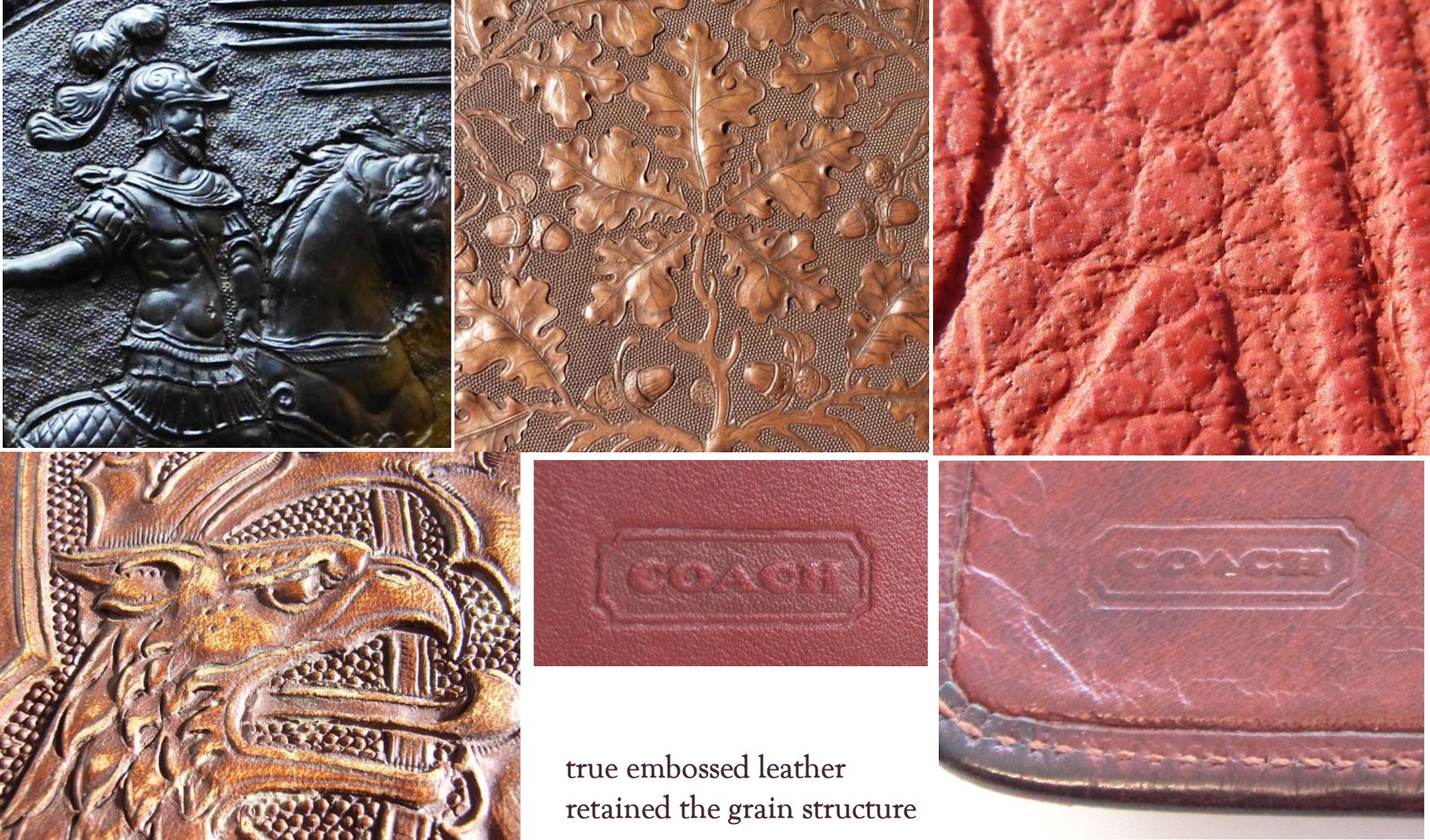
We'd say there is quite a difference between real embossed leather, where the grain layer is left natural and overstamped with ornamental dies, verses the simulated grain-like patterns you see in nearly all modern leather handbags, pressed in by large mechanized rollers under which the sanded/split hides pass. Most of these are attempting to simulate a smooth natural cowhide-grain appearance, but they can be 'embossed' in any design imaginable. When the 'embossing' isn't a fake cowhide-grain design, it can be anything from faux alligator print and faux stingray to modern "crossgrain" or even a checker pattern, if you want it. Epi leather, caviar, saffiano, all of these are (sometimes proprietary) mechanically roller-stamped patterns, sealed with paint ("pigmented leather" = painted with opaque paints) and some kind of polymer coating. If there's a wrinkle in the hide or a skip in the machine (see below), the pattern ends abruptly. This roller-printed faux-grain = embossed idea is normalized now.

The big issue for all of us with a handbag --including a Coach bag-- is the feel of the surface in your hands, including over time. There was no plastic coating or paint on an old Coach bag, ever. Unusual textures changed nothing, it was always the hide's natural surface. This is not the same at all as what is being sold as "crossgrain," "sport leather," "polished pebble finish," "refined leather" or any number of other new marketing terms. (This situation has lately reached, we think, the final frontier of ridiculousness in the new "GENUINE GLOVETANNED PEBBLE LEATHER" marking seen on some recent bags. We'll be taking a look at some of the actual materials in some bags so marked, below, in section IV.)
The easiest way to understand why this matters is probably to look at some examples of traditional texturizing processes used on full-grain leather, compared to simulations of those surfaces in their mechanically stamped faux-grain versions. All of the texturing processes began as ways to enhance or draw up the natural grain on full-grain leathers, which is worth knowing, because you would never conclude this from modern ads, especially for "pebble finish" or "polished pebble leather." Coach used to stand out as the only major outfit still using all natural hides, leather that was not so processed, which is why mention was made in the creeds of any unusual techniques, including pebble grains like the Sonoma line. While the creeds explained some of the texturizing treatments, even without reading that, you could feel difference on the surface of a Coach bag. There was no frankenleather in Coach bags, ever, whatever texture the surface had. Until recently.
If you watched either of those tanning/finishing videos, it becomes apparent that any texture can be stamped into the sanded/split leather surface, along with making it any color by coating it with opaque paint (not dye), and any finish between matte and shiny. Usually the fake grain is just a simulated smooth full-grain cowhide pattern, but a stamped faux-pebble grain is gaining ground, including at the new Coach. Things described as "polished pebble leather" or "pebble finish," used today instead of "pebble grain," are 99% sure to be basically fake pebble grain. Why? Because true pebble grain requires the grain to be present and, on everything less than a full-grain hide, it's been removed. This is why the word grain has to be eliminated in advertising by most modern retailers. Because the product is not pebble grain, but one or another bumpy-textured faux-grain pattern stamped into sanded down or split hides by machines. (Ah, such luxury, huh?)
So what is a real pebble grain, then? A person could be forgiven for not immediately knowing today, so far has the industry as a whole slid into the normalized stamping of faux-grains. True pebble grain can only be achieved with surface-intact full-grain hides, simply because the texture derives from the inner fibers naturally present in the grain layer. Pebble grain is produced by drumming or tumbling the hides to soften them and create the irregular slightly-bumpy texture by raising the natural grain structure. This was usually done in an effort to increase the surface density, decreasing porosity by producing a constriction of the grain fibers themselves, and resulting in a toughened, denser, slightly lumpy surface as a form of waterproofing or scratch resistance. Each pebbled pattern was unique to each hide, based on its inner structure. It was never some repeating artificial linear design stamped in, as seen today in 'pebble finish.' And the only reason it was called pebble grain was a vague resemblance between the naturally occurring surface of tumbled full-grain cowhides that weren't plated (ironed, pressed) and small stones, pebbles.
An alternate (lesser-known) term for the same basic process is shrunken-grain, more common with sheepskin today but also done with cowhide, and producing the same result by accentuating the underlying grain structure through a constriction of the densest top later. (Those familiar with the older Dooney & Bourke "all-weather leather" bags with the duck emblem will recognize an iteration of this material; Dooney himself began by working under Miles Cahn at Coach in the late 70s.) True pebble grain leather is often a more expensive material to work with than regular (smooth surface) full-grain hides, in part because the hides shrink significantly during tumbling as the fibers draw together, and hides are priced by the square foot. Again, in a true pebble grain, there is no stamping or printing involved, ever. And it seems that should be stressed, as too many times we have seen people online authoritatively, and entirely idiotically, smacking down legitimate questions from bag owners asking why their newer 'pebble finish' leather bags rapidly show wear, when older pebble-grain ones didn't. This is why: full-grain tumbled, vs. faux-grain stamped and painted.
So real pebble-grain is a full-grain leather with the grain accentuated to add a degree of scratch-resistance and durability to it. "Pebble finish" or "pebble leather" on anything not full-grain is always a faux-grain, a cooked-up pattern pressed via roller-dies into a leather with the upper surface either sanded off (top-grain) or sliced away (split hides). This is easily illustrated with Coach bags, old and new, then and now. We can see a true pebble grain surface made from full-grain hides in any older Coach Sonoma leather bag. Some images below show that a description of the production process of actual pebble grain once featured in the creed on Sonomas, too. Again, the creed was a quality guarantee, which is why it bothered to state these production details.

The same also applies to a tumbled (pebbled) nubuck from the mid-1990s (nubuc = nubuck, and nubuck means a full-grain). Nubuck itself, even though very lightly sanded or snuffed to achieve a velvety nap, is still always a full-grain, the whole grain surface intact, and not at all comparable to top-grain/corrected grain. In nubuck, the surface is roughened a bit, but on the order of microns, not millimeters, and the creation of that very fine velvety nap could never conceal pre-existing flaws in the hide. Corrected/top-grain differs, first, because the hides used are by definition flawed, far too damaged ever to be used as full-grain/nubuck, and those flaws are being hidden by removing an entire upper layer of the surface. Second, because corrected/top-grain isn't left in that open, raw state (a suede), but is instead plated (ironed) and stamped ("embossed") with an artificial grain-like pattern, coated with sprayed paints/polymers, the result is an artificially smooth surface that imitates smooth leather. Like true pebble grain, nubuck and pebbled/shrunken nubuck are specialty variants of full-grain leather.
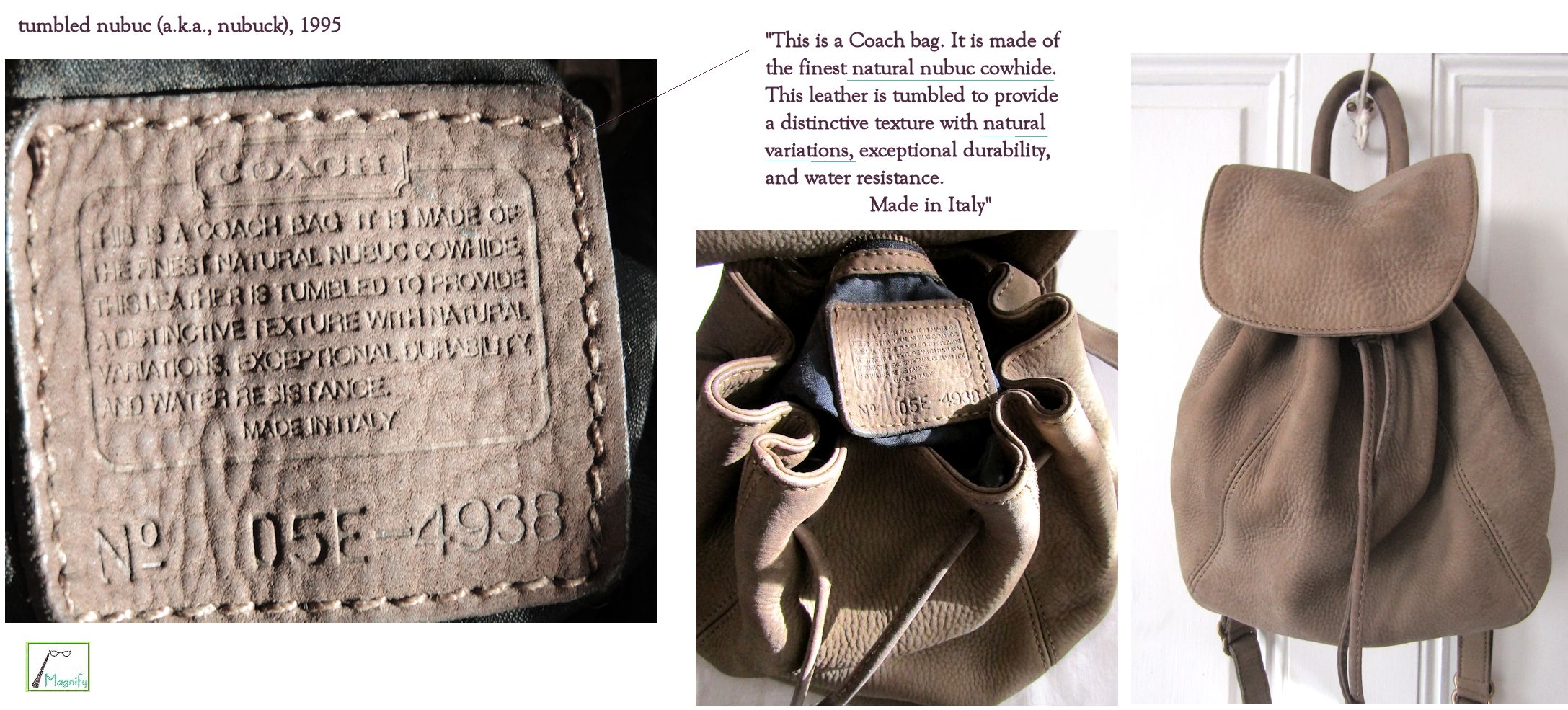
Finally, "milled" was another word sometimes used in old Coach creeds, but it generally described a process of tumbling or boarding, which is a finishing treatment that stretches the natural fibers under tension and pulls the underlying grain patterns to the surface, creating a texture of crosshatching or parallel wrinkles, also unique to each hide. These wrinkles are natural to each surface, and a far cry from homogeneously stamped linear patterns produced by metal rollers or dies, as in 99% of the modern versions of textured leather.

It's worth noting that Coach continued to produce bags in this older, natural (pebbled/shrunken/boarded) way even well after 2001, until about 2010, in the usual range of colors, but even in metallics, as seen below. The creeds of those later bags, though made in China, show us that full-grain leather was still standard with Coach at that point, with the textures produced from the natural grain, even when foiled, which surprises many people. (Metallic or foiled leather is a separate treatment, distinguishable here from faux-grains by the fact that the foil is microscopically thin, and laid upon a natural full-grain hide, still with visible pores. It's somewhere on a par with semi-aniline leather, dyed but with trace-pigmented surface, which we'll look at soon. Metallic full-grain leather is always more fragile as a surface in terms of scuffs, as the foil is extremely thin, but it's no less strong than non-foiled full-grain as a material in terms of tensile strength. And it's certainly qualitatively far better than what is being called "Genuine Leather" today.) Below, a Bonnie satchel in metallic gold from 2008 and a Sabrina bag in bronze metallic, from the same year. Both are still full-grain.
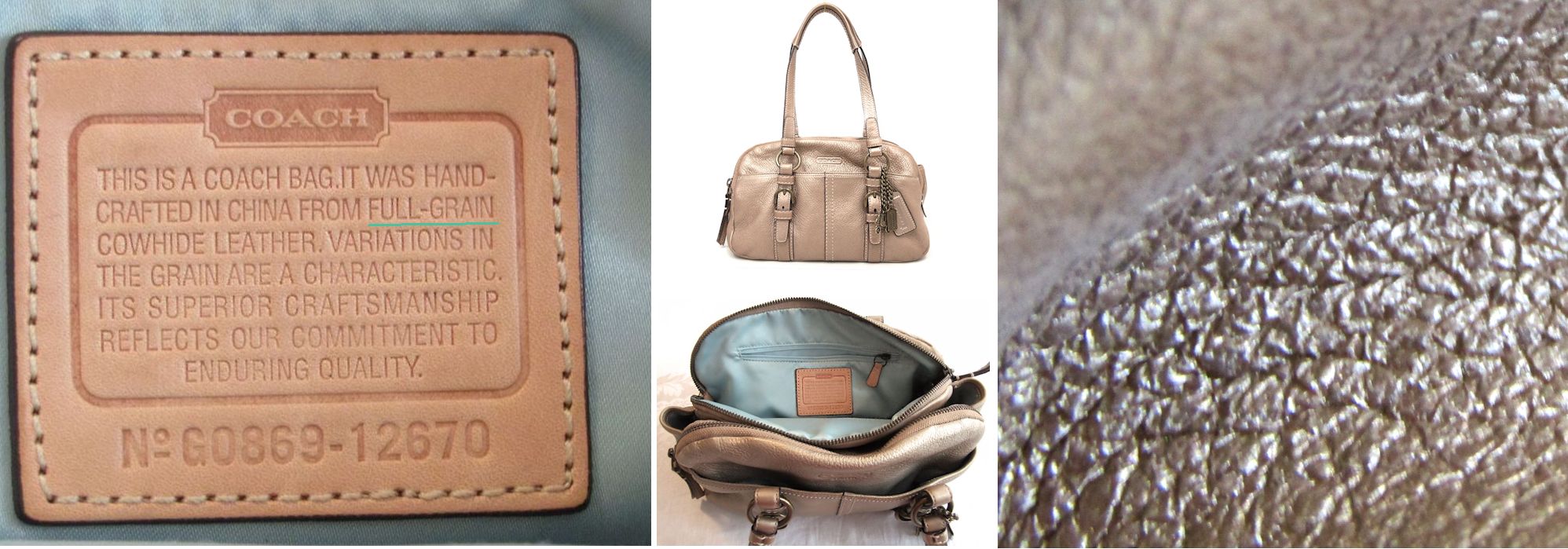
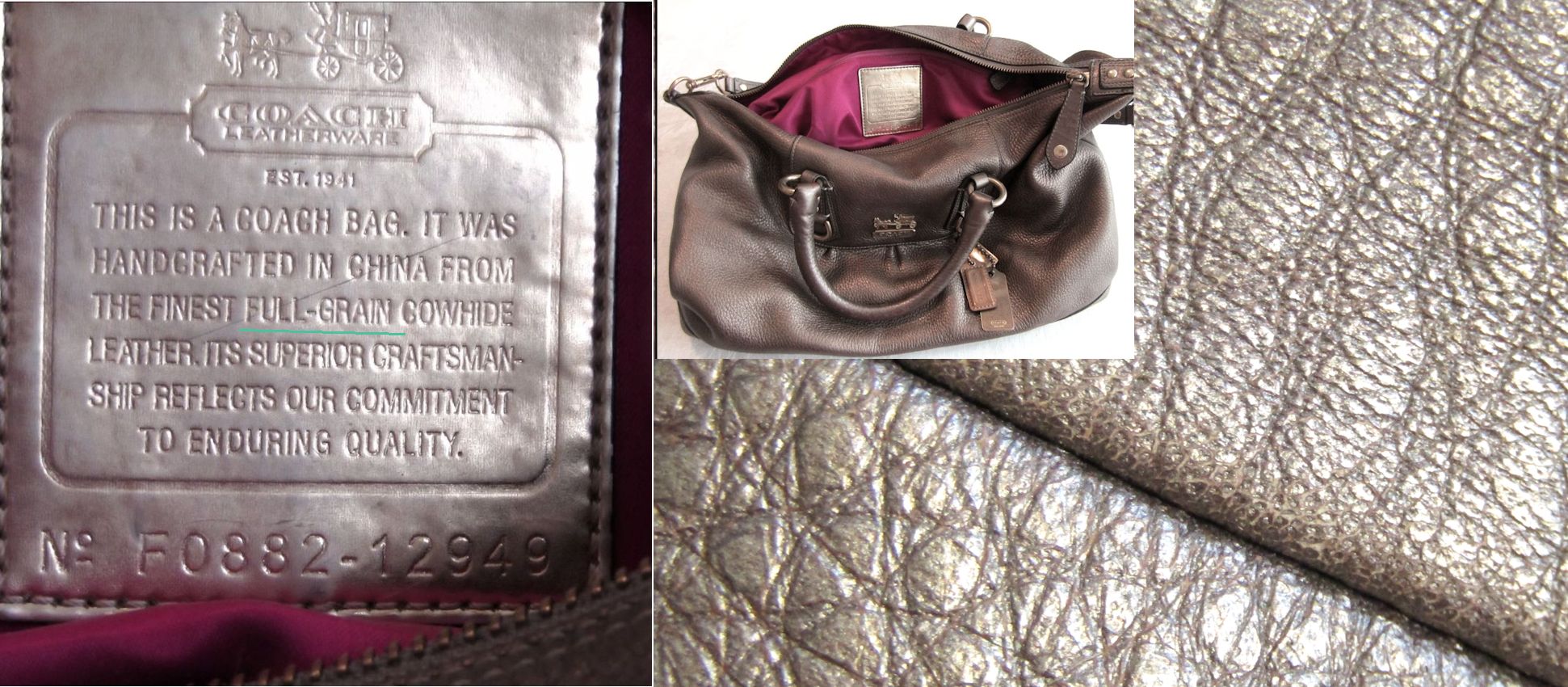
Thus, we feel there is a world of difference between full-grain bags with textured designs drawn out by raising of that natural grain, verses 'embossed' faux-grain: things with simulated patterns stamped into a manmade (grain-less) surface, then sealed with paint and polyurethane.
Making out that this is any kind of product of nature seems sort of galling if looked at this way. And worse still if there is a suggestion that it is unique --which each real pebble-grain surface is-- or will improve with age, rather than just wear though to a substrate of usually greyish suede. But new-Coach doesn't have to worry about that, what with the new single year warranty. Slap some "beloved" cartoons on it and everyone will be happy enough with their printed faux-grain "polished pebble leather" plastic-coated Disney bunny bag. Won't they?
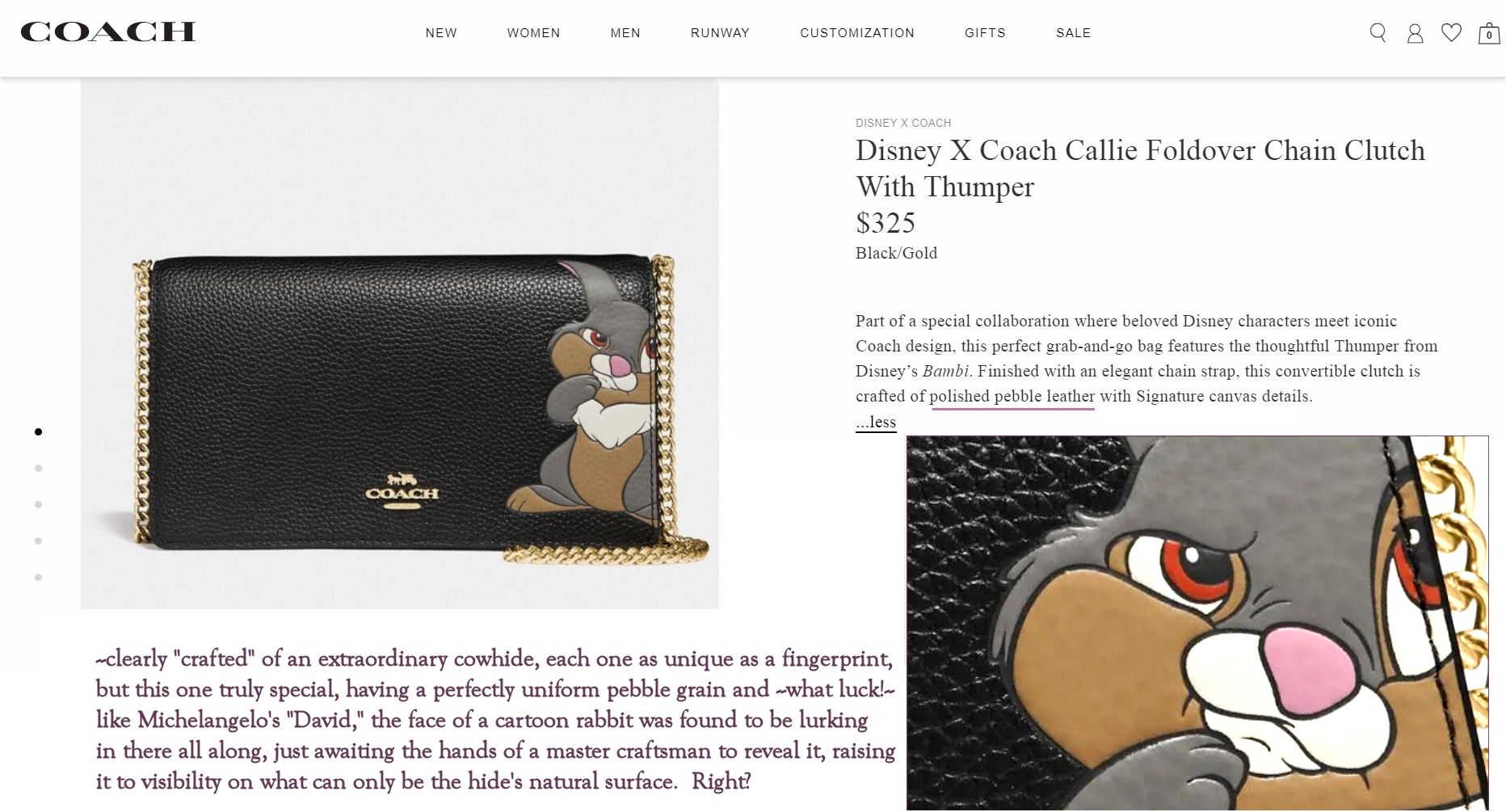
Well, obviously some of us will never see the word "elegant" in the same line with "Thumper" and not retch just a little bit. Others can never hear things like this called "iconic" without a giggle. So there has to be an option outside of these faux-grains and cartoons. We think the best one is to get to the bottom of exactly what it was about the saturated, naturally dimensional surfaces on those old Coach bags, in order to understand it enough to demand the return of it at Coach or, failing that, seek it out elsewhere if it does come to that. And the thing that made the now-vintage Coach handbags stand out, even more than the exclusive use of good full-grain hides, was the use of pure aniline dyes. There is a very depressing lack of full-aniline bags of all kinds on the market today in the US, perhaps because not enough of us know what that means anymore, and therefore don't yet know enough to demand them back. But this can remedied.
There is indeed more to that satiny, pleasantly natural surface of vintage Coach leather than just the part of the hide from which it came. There's the method of coloring, which came from immersion in a liquid dye bath rather than paint sprayed over and obscuring the surface. Precisely because Coach leather was always full-grain --and only clear full-grain hides are left natural to show their unique grain markings-- Coach bags could be colored with anilines. Aniline leather is more expensive to produce because it's a time-consuming step, a dye bath rather than a quick trip under the carousels of spraypaint guns, and only the best hides are clear enough to be left full aniline, nothing hidden. Even as late as the mid-1990s, Coach marketing (see "Selectivity" below) still mentioned the benefits of aniline dyes, still comparing it to linseed oil or translucent stains on good wood, enhancing the appearance of the natural grain, rather than coating and obscuring it as with opaque paint. (Note, as with the "sic" in the 1975 Courier bag ad, technically "cured" is inaccurate, has nothing to do with tanning/retanning or dyeing, but is actually a step that happens before hides enter the beamhouse. Curing is salting, for preservation, but this is a minor terminological point, and Coach generally got things right in the wording of their ad copy. For a run down on the most common tannery terms, see a good Glossary from the International School of Tanning Technology.)
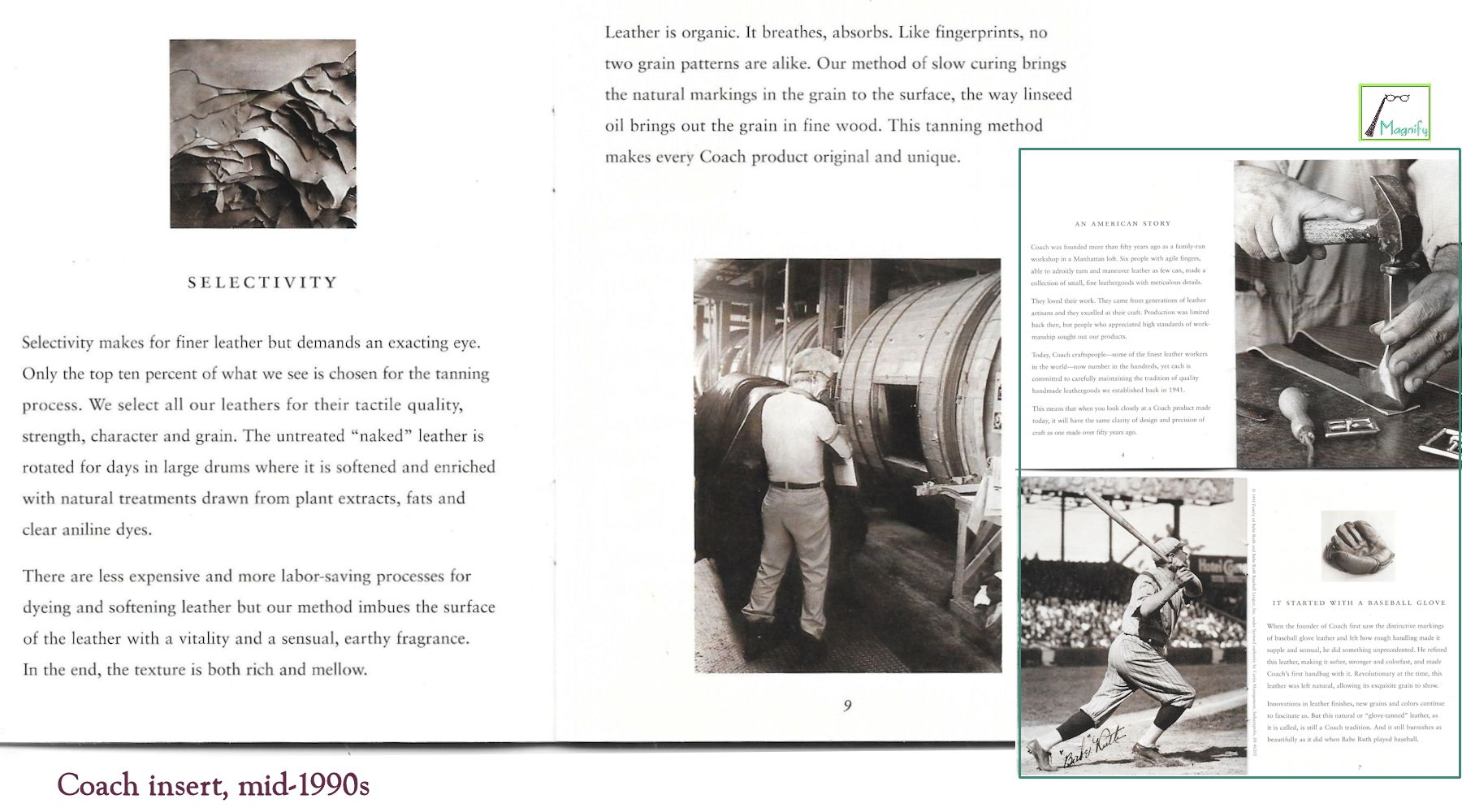
The aniline dyes are a very significant aspect of the old Coach bags, and had a real bearing on their appearance, texture, and especially longevity. Aniline was actually the first synthetic dyestuff, though it is still technically organic, a material derived from coal-tar discovered in the mid-19th century in an unrelated attempt to cure malaria with quinine. First as mauveine, then fuchsine, anilines rapidly overtook unpredictable and expensive vegetal/mineral dyestuffs in coloring wool carpets, all sorts of Victorian textiles, and eventually leather. It was good for leather in particular because aniline is soluble with oils and oils are crucial to a number of tanning processes (fat liquoring), making for supple leather. Consequently, vat dyeing with aniline/oils produces a superior leather (this is what that ad was trying to describe as 'cured with'), because it saturates through the hide, from suede side to surface, rather than merely forming a surface coating.
This is quite different from "pigmented leather," where pigments mean solid, opaque color particles resting on a surface, rather than color truly in solution as a liquid, as with aniline, permeating the hide from front to back. Pigments are paint, forming an opaque film on just the surface, as we saw in the typical 'corrected-grain/genuine leather' products. Because the paint is only a film on the surface, obviously the color wears away or may even peel over time, which irreparable problem doesn't afflict aniline dyed leather -- as so many decades-old Coach bags around today show. The nature of the coloring method, and its permeation through the entire hide, is why those old Coach bags can usually be easily refreshed if scuffed, while the modern 'faux-grain' painted/pigmented leathers really can't, unless carefully color-matching and re-painting them, usually with some kind of acrylic. (And really...just yuk.)
Because full-grain leather is the outer skin surface, with just the hair removed, and full aniline means no treatments beyond the dye, aniline leathers are porous and the natural pore structure of the hide remains intact and open. This makes aniline dyes a key element in both the quality and longevity of vintage Coach bags, but also provides us a useful method for identifying older Coach products and distinguishing them from lesser bags made by others. This natural pore structure, open and free of clogging paints, is usually visible under strong magnification, as with a 10x jewelers loupe, and a few minutes with a $3 loupe will often tell you something far more useful than hours of looking at zipper brands or scrolling 'lists of fake serial numbers' or any of the other numerical minutiae one often hears about online in the great "flood of fakes" panic regarding Coach bags. We'll have more to say about this, and the concept of "authenticity" in general, below. For now we'll just say that more and better answers are often found by going down to the level of concrete materials. There is a paucity of discussion on concrete materials, both why they matter and how to identify them, which is one of the information gaps this screed hopes to partially remedy below (IV. Concrete Materials Analysis), when we take a loupe to the leather and look at pore structure in Coach bags from several periods.
Beyond the open pore structures on the uncoated exterior surfaces, another place you can see the use of anilines in many old Coach bags is the suede interior (most 1970s-1990s bags weren't lined with fabric) and the edges of the straps, which weren't coated as on the modern bags, but instead left natural and showed a cross-section of the whole hide. Because aniline dyes penetrate the whole hide with color, suffusing it from front to back, it can't wear away like a surface treatment, peeling at the edges, and thus the straps could be left without plasticized binders or trim, as on current bags. That visible cross-section of the hide is actually another marker of leather quality, as it tells us that the tanning was thorough, with no corners cut, and that the color was thoroughly dyed -- not a thin surface coating of paint.
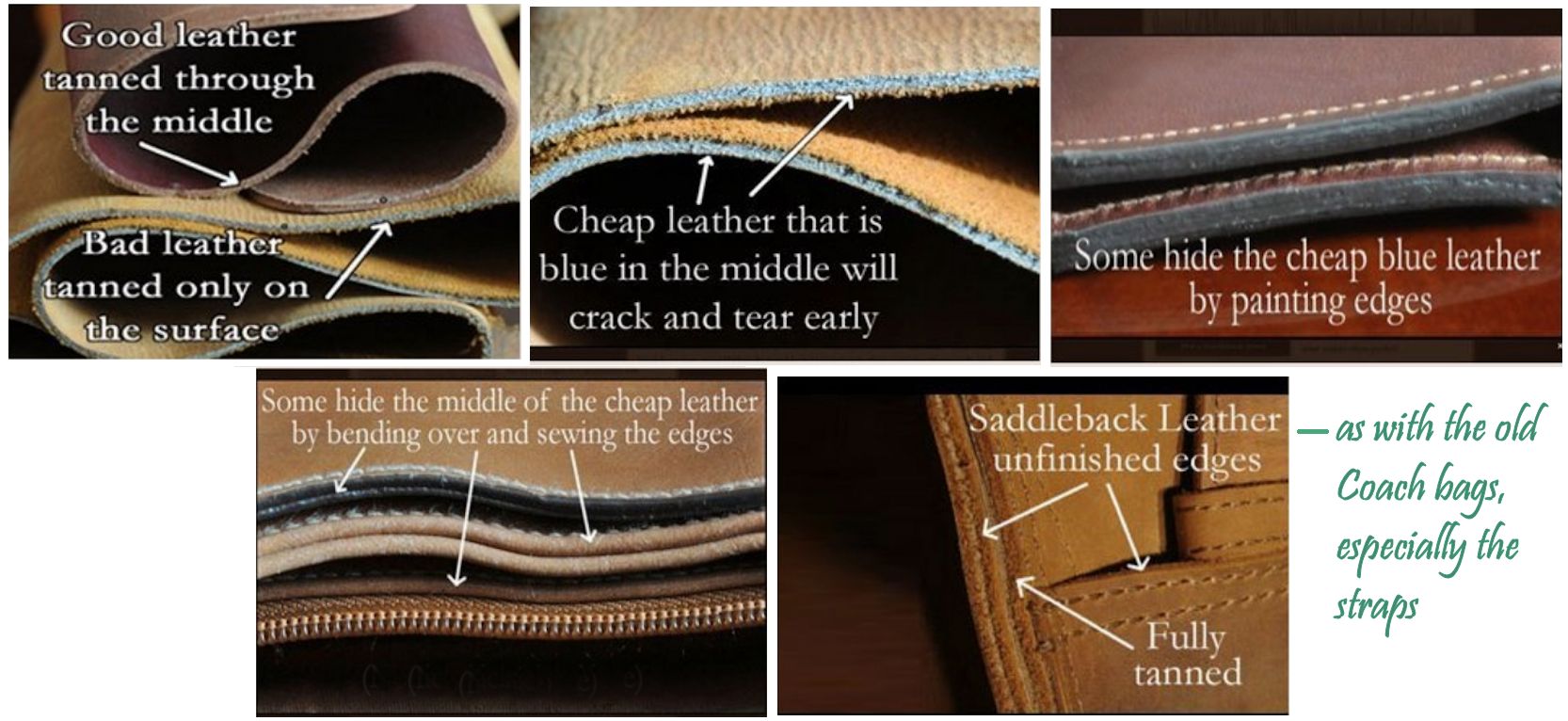
When unusual efforts are made to conceal the cross-section of the hide, say on the straps, it generally bodes no good, and may even be hiding leather that is incompletely tanned and left in a partial wet-blue state (chrome tanning produces a characteristic blue color at one stage of the process). The images above come from Saddleback Leather (which uses good full-grain hides, but only makes basic men's bags), from a nice page explaining some of the sleazy methods in use by bad tanneries to conceal insufficient tanning. Many of the same edging methods are used with non-aniline or surface-coated-only leathers, not in a deliberate effort to conceal bad tanning, but because surface-treated faux-grain leathers need that edging to slow down the chipping and peeling to which those surfaces are prone because the color is only a thin surface layer.
This means we lose information about the leather quality when makers add fabric linings, sew edges under, and/or coat the edges with paint/plastic. (Coated edges are not the same thing as burnished edges. This edge issue will become more relevant when we move on to the new versions of Coach purse straps, and specifically how they wear, compared to the old, exposed-suede-edge straps.) On a vintage Coach bag, you could usually see a cross-section of the hide on the edge of the strap, which was left natural, not as a shortcut, but as an indicator of quality. The sturdiest bags will typically have a piece of polyester rope, cord, or fabric tape sewn inside the two halves of the strap, primarily because leather will eventually stretch out under tension and weight without it. (You can actually watch a tubular strap being made by hand here, roughly of the type used on the old shopping tote, including the insertion of a length of polypropylene rope for strength.) Sometimes you can just make out the edge of this fabric tape layer on flat two-part Coach handles, usually under magnification of the cross-section or, on the rare occasions when a tubular handle eventually does wear through the leather layer from decades of use, you can see the rope layer inside. (It's worth knowing that this is what that inner usually-whitish layer is, nothing shady, but actually a sign of quality, a binding layer there for reinforcement against leather-stretch.)
Outside of the leather furniture industry, you don't hear much about aniline dyes today, but it's actually that unsealed aniline dyed surface that is the essence of why one thing feels and wears like good leather, natural and breathable, while another thing feels slick and plastic-coated, briefly, then rapidly looks worn as soon as that surface coating is scuffed or handled. Full-grain hides dyed in aniline are a world apart from all lower-tier split hides stamped with a fake grain, painted and sealed with plastic. Sadly, that later material is what is usually labeled "genuine leather" these days, and much of it may as well be pleather, for the way it feels, wears, and wears out. The structural difference is akin to a tenderloin, verses chuck beef, while the external difference is comparable to oiled mahogany verses particle board with a 'woodgrain' decal. It's a serious difference in materials quality and it has consequences for both how a bag feels in your hand, and how long you can use that bag.
To sum up, the use of good grades of full-grain, full-aniline leather is why the older Coach bags can remain in use for literally decades and, with minimal cleaning and conditioning by the owner, stay looking good. The thickness of the leather (weight in ounces) may vary, but a full-grain hide, unsealed with plastics or paints, but instead through-dyed with aniline colors, is indefinitely renewable in a way leather with mere surface coatings simply never is and never can be. Together with the solid brass hardware that was once standard on older Coach bags, this type of leather was the real reason Coach could offer a lifetime warranty, where you could send your bag back to the NYC factory for free refurbishment even multiple times, and it would come back still looking like your bag, but refreshed and happy, ready for more years of toting. It was specifically meant to be renewable in all components. The hardware also wasn't plated pot metal or zinc back then, but solid brass, specifically so that the surface never wore off. Even back in the 70s, most handbags used nickel plated zinc hardware, which was objectively inferior to Coach solid clips, d-rings, and turnlocks. As the 80s catalogue page below shows, the words "virtually indestructible" actually appeared in ad copy. Even the 3-ply nylon thread and a weight-bearing capacity of 100 lbs. was mentioned!
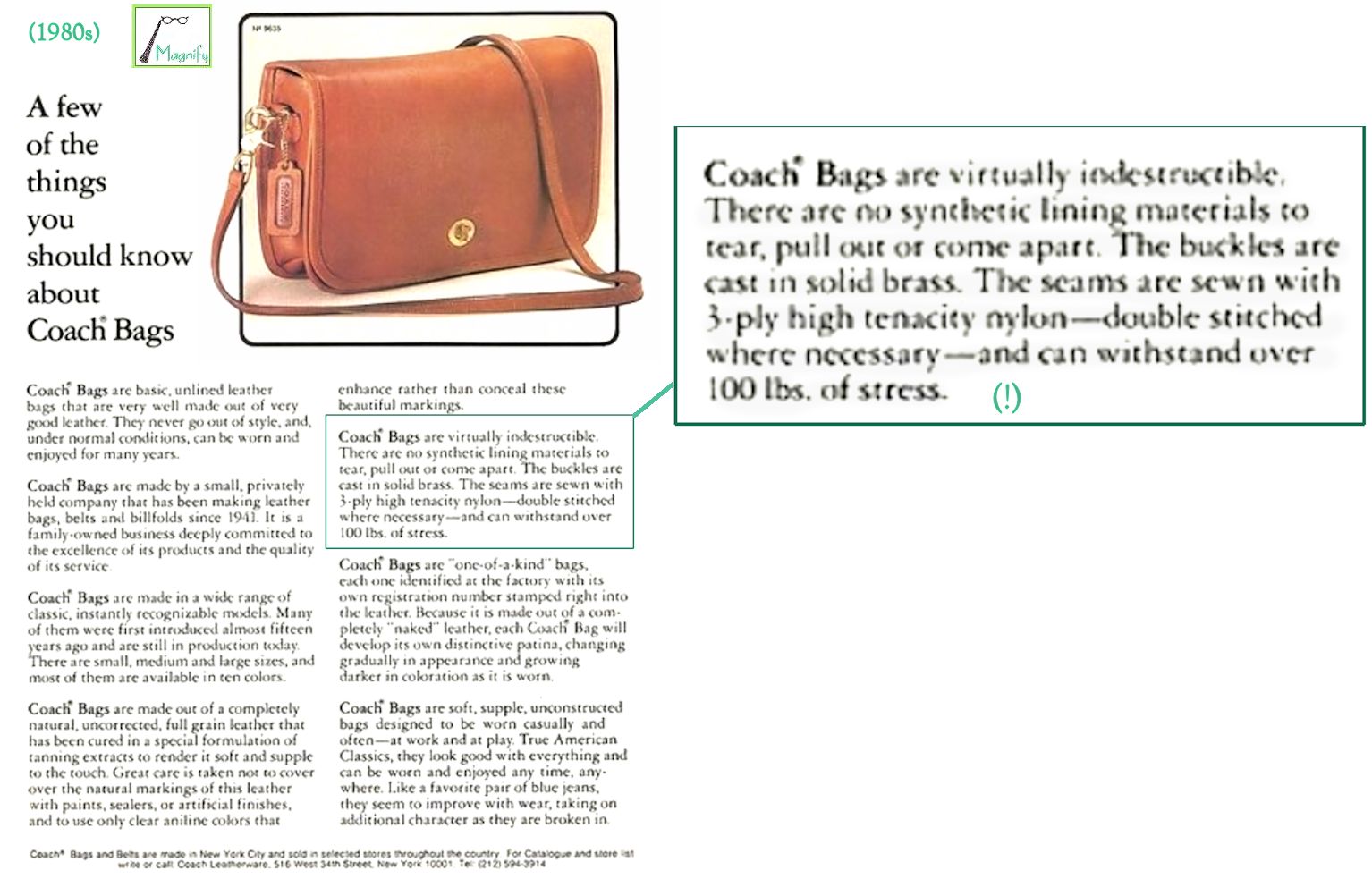
There were several essential quality materials used in the old Coach bags --full-grain, full aniline, solid brass-- and taking away any one of them changes not just the look or the feel, but the lifespan of the bags, too. The long lifespan and ability to change and improve with use was always a central element to the Cahn's product concept. And now we know enough about those basic materials to understand the idea of "glove-tanned."
So old Coach bags were made from full-grain leather --the hide's natural surface-- vat-dyed with oil-based aniline dyes? Yes. And then the leather was glove-tanned in a special secret technical process known only to and used only by Coach? No. Some of the later Coach promotional material does kind of make it sound that way, as do many of the current silly puff pieces you encounter constantly on the web. But the truth is quite different. Understanding exactly what "glove-tanned" means just became more crucial, too, since more recent Coach/Tapestry marketing has elected to stretch (we feel, maybe even pollute) this branding concept as "GENUINE GLOVETANNED LEATHER," all run together as one word, and now printed on the bottoms or backs of certain reissued/'archival' bags (see ex. below) that are now being made of mere 'genuine leather.' Some of us have even begun to suspect that this move indicates a hope that young buyers may become (even more) confused, mistaking "glovetanned" for some known benchmark of leather quality, and thus failing to notice the switch from good full-grain leather to the lower-quality splits found in 'genuine leather.' For the record, full-grain actually is a benchmark of leather quality. "Glove-tanned" is not, and was always a branding concept. This recent use of the new GLOVETANNED makes a look at the origins and meaning of glove leather worthwhile.
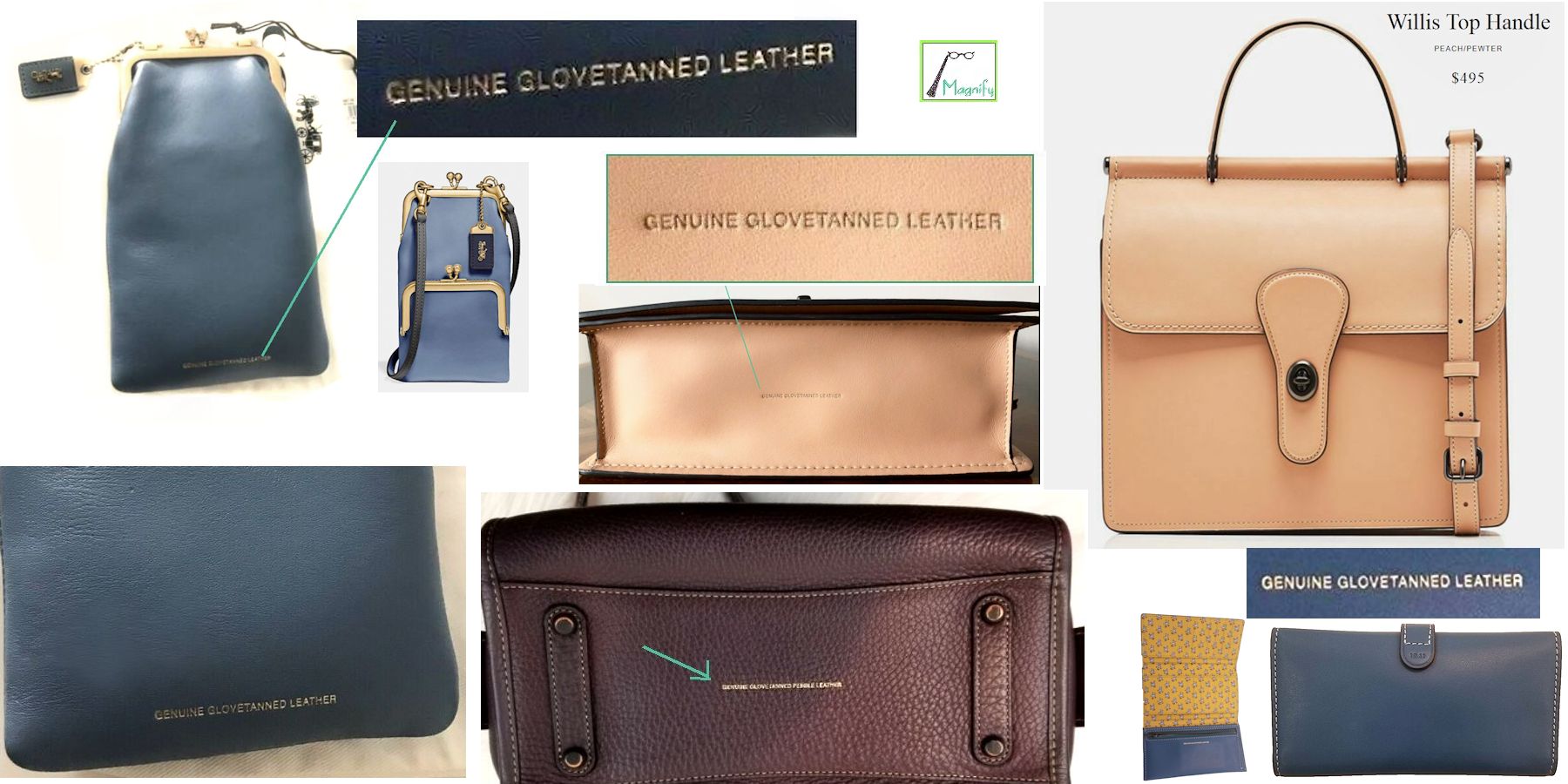
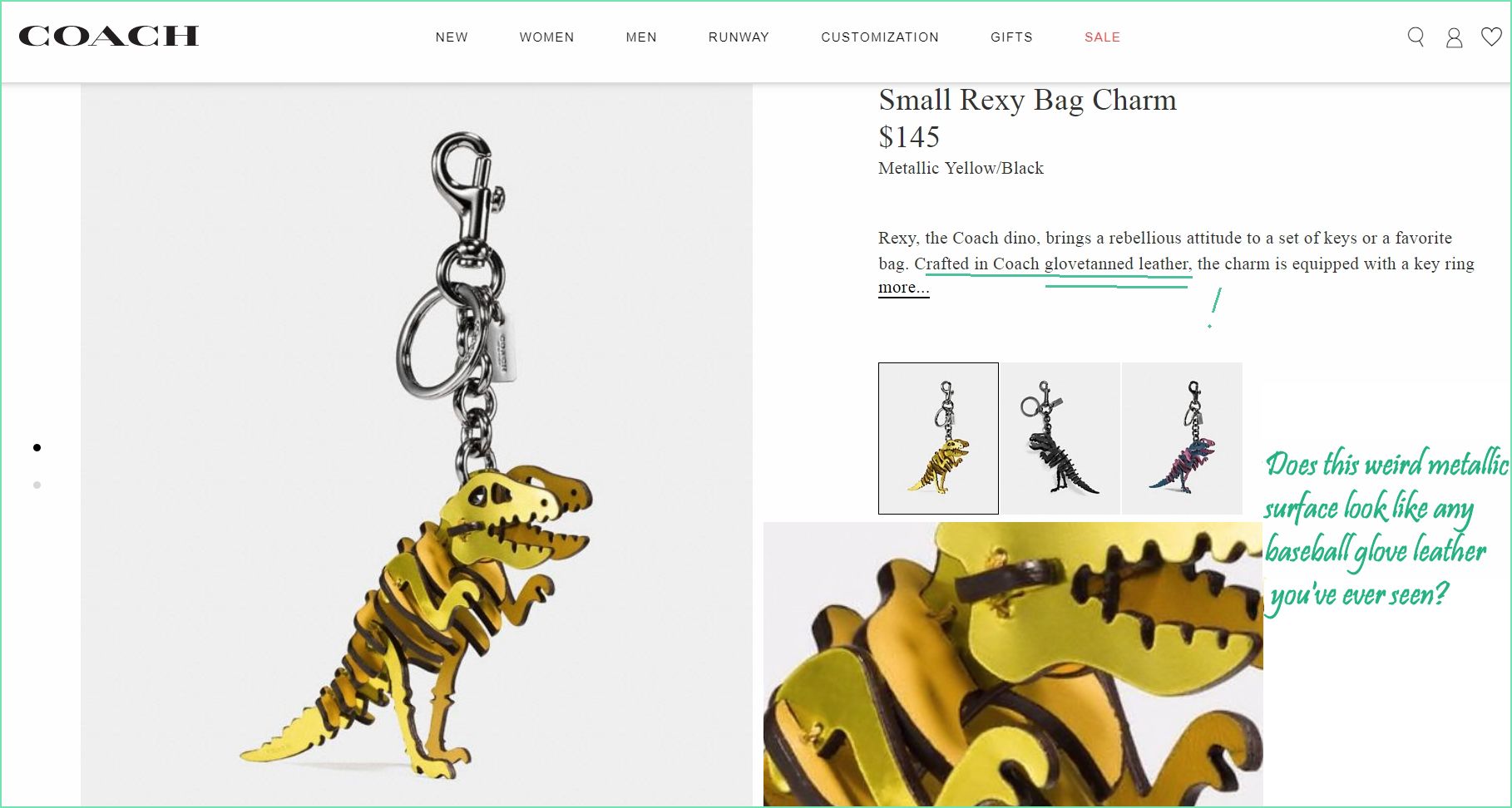
As we saw above in the early 1960s ad for men's travel cases (glove-tanned "available for the first time"), Coach began using the glove-tanned term only in the early 60s, first for men's small leather goods, which was their product line to that point. (Things a person may encounter on-line about Coach making glove-tanned leather handbags since 1941 are simply wrong. So much on the internet is simply wrong.) In their usual low-key way, they described how this particular tannage had benefits in longevity and durability. There was no question about the nature of it, as the ads made amply clear, because the baseball mitt origin was seen as a selling point. We can also see this very directly from the surviving examples of the earliest Coach hangtags used on bags. These were circular, with graphics clearly suggesting the stitching of a baseball, and bearing the words "Feel it!" imprinted on them. In other words, it's baseball glove leather, feel it for yourself. The idea of the hangtag itself was originally intended, not as some 'designer label,' but as a sample swatch, meant to show the texture and quality of the glove leather from which the bag was made. (This function as a swatch is also why so few of those tags survive today, because they were meant to be disposable, something to show buyers the source and type of leather, and allow them to rub a little piece of it between the fingers. Once you bought the bag, the swatch/tag had served its purpose and was generally removed, as paper retail tags are today.) The original Coach company was always focused on the quality of the leather used in their bags, including with a bag made of Glove leather.
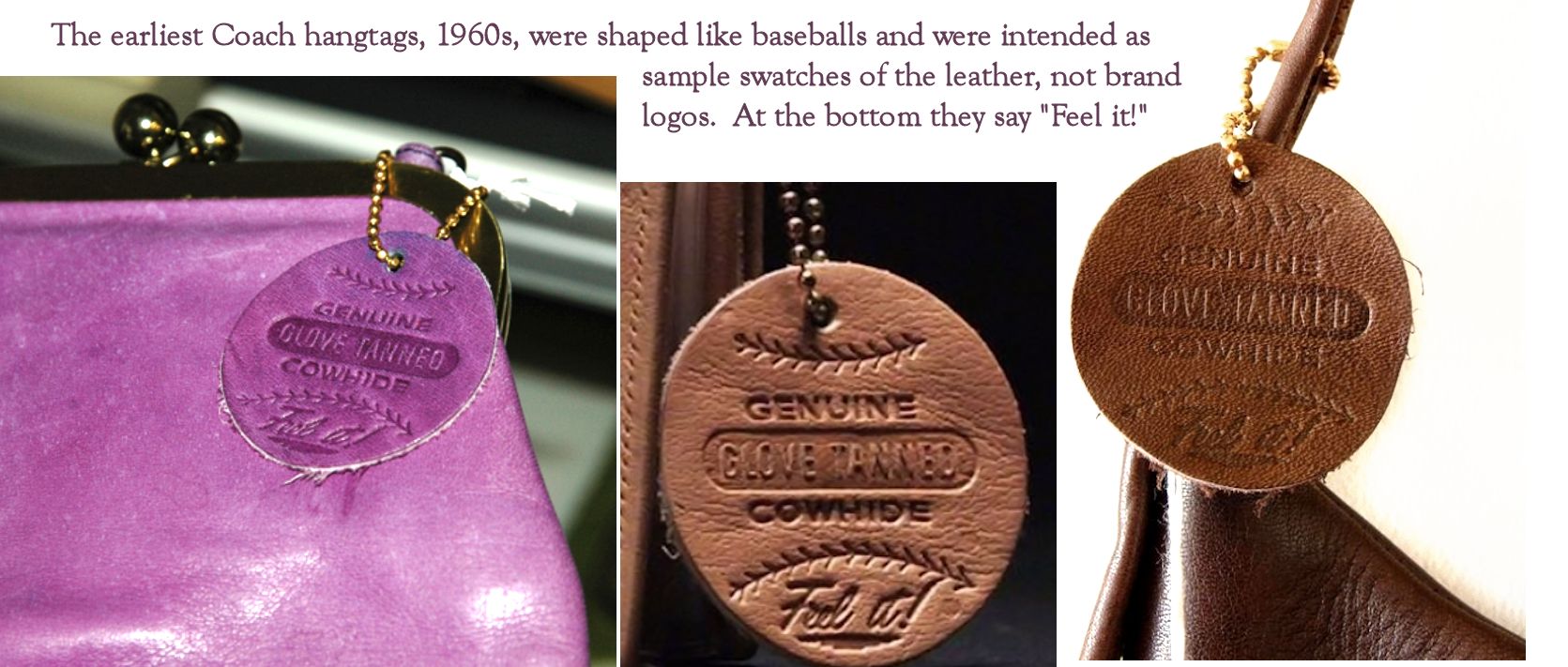
We can also see that "glove-tanned" is no known technical term or process in the leather trades. When you hear "glove-tanned" at all today, outside of Coach advertising --which is almost never-- 99% of the time it's in archaic written matter, generally mid to late 19th century, referencing terminology that dealt with alum-tawed (tanned) goat or kid skins used in kid gloves. The other 1% of the time, it's referencing contemporary faux deer hide, as a synonym for deertan/deer-tan, which is to say, lightweight cowhide processed to resemble deerskin and more like kid leather in consistency. (No commercial outfit is actually using real deer hides today, thus all modern "deerskin" is faux, really being processed or "glove-tanned" cow. They only use the "glove-tanned" term because it's vague and ill-defined, therefore avoiding any legal/authenticity issues with the term "deertan" for cow.) In any case, the term "glove-tanned" has nothing to do with deer, nor with ordinary gloves, from Coach or anyone else, for the past 100 years.
The term that does exist in the leather trades and is used by tanneries is "Glove" -- and this is a shorthand for "ball glove," meaning a general series of tanning procedures used to make the leather for baseball gloves. It distorts, almost negates that flash of creativity on the part of Miles Cahn to suggest that "glove-tanned" was something invented by Coach or cooked up in a lab or who knows what the later marketing patter is implying. But it takes away from the innovative thinking needed to make the conceptual leap of taking something fairly ho-hum and typical that many tanneries produced to make baseball mitts out of --which they called "glove tannage"-- and using that material to make accessories, first men's wallets and cases, which was the original (wholesale) product line made by Gail/Coach, then new and interesting designs like the travel cases seen in that ad (which came complete as a 'travel survival kit,' even including bandaids and aspirin).
Most of the modern confusion in Coach leather quality/terminology stems from a misunderstanding of what kind of 'glove' we're talking about, and specifically a current unawareness that it designated a 'sport tannage' having nothing to do with (non-baseball) gloves. This spark of insight is what makes Miles Cahn an interesting character. After decades in the leather trades, using all kinds of leather, he saw what was under everyone's nose, which they had missed, and seized on it to do something never done before. They took a gamble on this repurposing of glove tannage and they made it work. They told the truth about what this leather was because that itself was exciting and interesting. People knew how nice the leather was in baseball gloves. Now imagine you could get a travel case made of that, and handmade by Coach's experienced leatherworkers. With Lillian's insistence, this was extended to women's leather goods: handbags. There was innovation here, there was quality, there was highly skilled workmanship, and there was an appealing marketing shorthand --"glove-tanned." This is why Coach succeeded. And this was the work, the contribution of the Cahns. To obfuscate the origin of the original leather now takes away from contemporary understanding of who these people were, and why they are important in 20th century fashion. Everyone who loves their (especially vintage) Coach bag today, who has had these bags like old friends for years, owes a debt of gratitude to the Cahns. Their company was a unique operation that rose from rags to riches in an ethical and even an inspiring way. Glove leather. And next we'll make women's handbags of glove leather. You have to know it was a standard sport tannage to appreciate this.
So if "glove-tanned" leather was Coach's marketing term for what tanneries sell as "Glove," meaning leather made for use in baseball gloves, what is that and how is it made? The answer can depend to some degree on the tannery, and some are better than others, but as an example we'll use a truly good one, Horween. Horween is duly famous, considered by many to be the best tannery still operating in the US, and particularly for chrome tannages. (All Coach bags were always chrome tanned.) The Horween website (lower right of page) describes their "Baseball Glove" leather, while Horween's tannages chart appears below, showing Glove leather in context.

From this we can see, however, that Glove leather = full-grain leather. And not just at Horween. It always involved full-grain hides, not just for strength and longevity because a baseball glove has to survive multiple impacts by speeding projectiles, but also in grip surface, because potentially slippery synthetic surface coatings on faux-grain would affect the function of the glove. Ball glove leather should always be full-grain. Coated faux-grain split hides --that is, "genuine leather"-- are never going to make for a good baseball glove.
This is what raises issues with the current bags being marked GENUINE GLOVETANNED LEATHER on the bottoms, when the creed reads "Made of genuine leather" -- not full-grain. It implies some new and different tannage is in use now, not standard Glove leather anymore, as the vintage Coach bags always were. The truth is essentially "genuine leather" --and we've seen what that is-- and "glovetanned" is merely a marketing term, and one so vague and imprecise as to mean nothing beyond its function as an advertising device, a trade name. Remember "rich Corinthian leather"? That was perfectly legal and so is "glovetanned," because they're not actually promising or guaranteeing anything anymore, beyond the fact that this made-up term is the new marketing name for new-Coach 'genuine leather' bags. The removal of the hyphen from Miles Cahn's original glove-tanned branding term seems likely to have been calculated to erase completely any reference to tannery definitions of ball glove leather, just in case, since those are full-grain and "genuine leather" isn't. But just as there was technically no legal or FTC problem with "Corinthian" coming out of New Jersey, a company can make up whatever fanciful product names they want. (If you knew that the city state of Corinth hadn't existed since antiquity, you knew immediately that Corinthian couldn't be a real country of origin sort of designation, but instead just a branding device, a trade name. If you didn't know, well, Ricardo Montalban was there to make it sound luxurious anyway, which is why Chrysler hired him.)
Coach bags did used to be made from ball glove leather, though. Initially it came from tanneries supplying the same to makers of mitts, but later, as Coach bags became so popular that trouble arose in consistently meeting demand for materials, there was a dedicated large-scale tanning operation doing a particular glove tannage used across all the Coach bags, and specifically a fat liquoring process with extra drumming, in order to soften the heavier weight full grain hides they used, which we also find mentioned in old ads. It's the comparatively high oil/wax content in glove tannage, always on full-grain hides, that makes for that certain supple, floppy yet satiny texture in an older Coach bag, and it can stay in that supple, happy state for literally decades with even moderate care. This is why it really was an excellent choice for bags. And those older bags remain, so many years later, an excellent product. It makes us all question, why exactly can't we have, not trade-names for split hides, but that original kind of Coach leather in new styles? To a person, we would all be happy to buy Coach bags again, indefinitely (the fewest any of us has now is eight), if they remained Coach leather. The days of logomania are done, cheap blingy bags have all the edginess of a tramp-stamp, and the pre-teen crowd that might not see plasticine faux-grain bags with decal-like cartoon characters as schlock just doesn't have the cash for $500-$1000 bags in any meaningful numbers. The plan to reverse the downward spiral Coach as a brand has been suffering for the past several years by thoroughly pissing off and alienating a much larger contingent of unusually loyal core buyers who made the company a success seems...singularly obtuse.
It's worth noting, too, that none of the marketing vagaries about the meaning of 'glove-tanned' as a term date from the time when the Cahns were still running the company. That only came later, after the mid-1980s, once the Cahns had moved on to found Coach Farms, an effort to bring the goodness of then-unknown real goat cheese to Americans, which they also succeeded in doing. They sold Coach to Sara Lee, the food conglomerate, in 1985 for about $30 million, but not without requiring the new management to run the company in the same way as it had always been, maintaining existing quality and workplace practices, which Sara Lee did for another 15 years. The Cahns also distributed $1 million of their proceeds from the sale among 205 of the longest-serving Coach workers, which tells you a lot about what kind of people the Cahns were. They never forgot where they came from, nor how they got there. (Even before the sale of Coach, they were known for supporting progressive causes like the Food Bank of New York City, the NY Public Library, and even using their (new-found) money to make political statements, including the famous full-page ad in the New York Times protesting the war in Vietnam and addressing Nixon directly. It's not the kind of thing you'd ever imagine the current Coach/Tapestry leadership doing, though, it is? Now all that seems to matter is the share price.)
So Miles invented the concept of cases and small men's bags in the Glove tannage normally used for mitts, but it was Lillian Cahn who actually invented the Coach purse. Using the unusually supple full-grain Glove leather to make women's bags had never been done before, as most women's handbags then were small and rigid, a lightweight garment leather glued over a reinforced paper/cardboard or fiberboard backing, as with the common small top-handle 50s bags still seen around today in the vintage market, usually only large enough for a mirror, a lipstick, and maybe a change purse. But Lillian had other ideas, specifically the first Coach handbag, the shopping tote. This was unequivocally Lillian's idea, as Miles always pointed out. He had actually opposed making women's bags at first, feeling the market was already saturated, mainly with copies of European fashion designs. But Lillian was adamant, they reached agreement, and the first Coach bag was born.
The shape of that bag was based on the paper bags of Lillian's childhood --some versions of which are still around and may even be recalled by those with long enough memories. (The type with the string handles, which were a fairly new thing in the 30s.) She and other family members had used these brown paper bags to tote orders for food to local buyers in the neighborhood, which was one of several of the Lenovitz family's businesses during the Depression, on E. Market St. in Wilkes Barre, Pennsylvania. Lillian's mother Rosa made homemade egg noodles (multiple types of tojasos teszta, but the csiga were a favorite for weddings), but also homemade candy, in the days of literal "penny candy," where even an allowance of 5 cents could get you a large bag full. And theirs was some of the best to be had anywhere, too, still recalled fondly today.
How do we know? Because we have it on good authority from Dottie, a truly-old-school Coachista (bought her first Coach bag in the early 1960s!) and a contemporary of Lillian's, also growing up in Wilkes Barre at the same period, where they were friends as kids. And Dottie can testify that Lillian's rise to fame is an even more remarkable story of survival, perseverance, even indomitability than most people today know. Lillian was not just a remarkable girl and a good friend, but she became an amazing woman. She overcame so much! Fans of Coach bags need to know about Lillian.
Life in anthracite coal country was hard before the Depression, especially for recent Eastern European immigrants. Lillian's father Benjamin arrived from Hungary in 1928, fleeing anti-Semitism by the local police. (He had served with distinction as a sergeant in the Austro-Hungarian army during WWI, but being Jewish, this made no difference, and he and the rest of the family were at the mercy of any anti-Semitic Hungarian Christian in the eyes of the law. And there were a lot of them, as the rise of the infamous pro-Nazi Arrow Cross was soon to show.) Lillian's family had been farmers in Hungary, from a small village very near the Czech border. The rest of the family, the four children and their mother Rosa, arrived in Wilkes Barre by 1933, when Lillian was elementary school age, but unable to speak English yet. Like many other Magyar- and Yiddish-speaking children, she was treated very cruelly, and struggled dreadfully in school until English was mastered, but Lillian was uncommonly bright, and she helped others to catch up quickly, lessening the misery. The flight from Hungary itself had only been made possible in Lillian's case after an uncle had managed to bribe someone into giving her father a visa to America -- hard to come by then for anyone from the region, but most of all for Jews, as the US government was shamefully anti-Semitic at this date, too. If not for this stroke of luck, Lillian and her immediate family almost surely would have perished in the Holocaust, as did 14 other members of the Lenovitz family left behind, including her grandmother, rounded up at age 72. In the summer of 1944 everyone was deported to Auschwitz and murdered...an unspeakable trauma, the kind from which the heart is never free again.
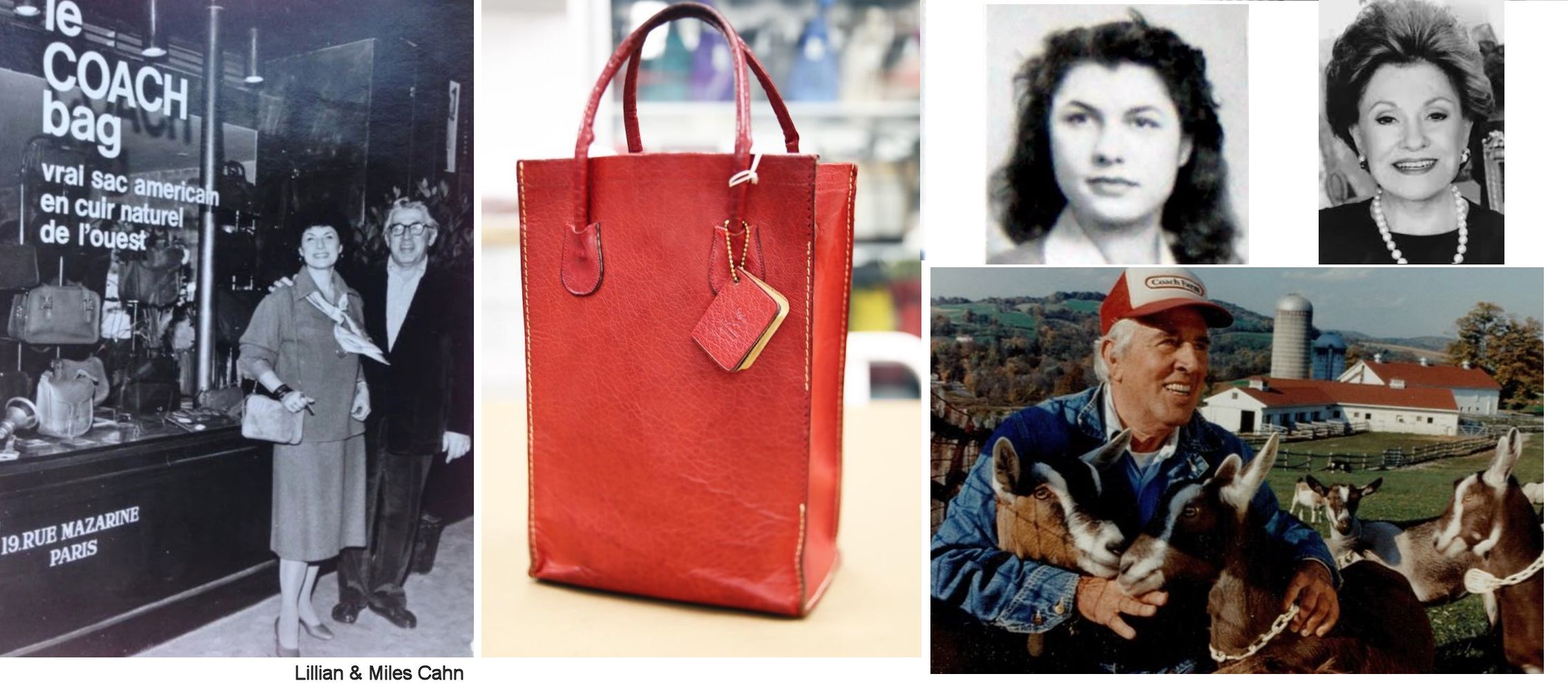
This fate they had escaped, but by the time Lillian arrived, post Crash of 1929, the mining towns of northeastern Pennsylvania were a different kind of cauldron. Striking miners, most of whom were Eastern European, including Hungarian, were openly degraded as "Hunkies" and physically brutalized, sometimes by competing ethnic factions of workers. Everyone was afraid of being labeled a "greenhorn," an immigrant. Pinkertons shot at people of all ethnic backgrounds in the streets and no one dared report anything to the police. Local scions of industry, even tycoons like Henry Ford, were openly supporting Adolph Hitler, while pro-Jewish German Americans lived in fear, both of what was happening through the 30s in Europe, and once war broke out, of possible internment in America, as was done to Japanese people on the West Coast. This general anti-immigrant feeling often mixed with anti-Semitism --just what the Lenovitz family had fled from in Hungary-- into a truly toxic brew.
Lillian's older brother, Lajos Lenovitz, has described how he was beaten repeatedly as a child by gangs in the street simply for being Jewish. (Lajos Lenovitz, that is, Lou Lenart, whom some may know from PBS's A Wing and A Prayer or Nancy Spielburg's documentary film Above and Beyond.) Lillian's brother, two years older than she, had changed his name --because of the discrimination-- and was clearly affected by these experiences in childhood. He went on to join the Marines at 18, specifically with hopes of fighting the Nazis, having heard that the Marines were the most aggressive of the fighting forces, though he was the only Jewish Marine he encountered. He became a fighter pilot, served in WWII in the Pacific theater, and was among those who went from US combat to a (then-illegal) defense of Israel, helping to establish Israel's first air force. Lou described how he felt driven to fight for a free Israel by the losses inflicted on the Lenovitz family in the Holocaust, especially the loss of their grandmother, and by the brutality they had faced as kids. Israel had to survive, he thought, whatever the cost, because no other country, including the US, was willing to accept the survivors of the Holocaust as refugees or asylum-seekers, because those refugees were Jewish. Like Lillian, Lou actually went on to change the world, going down in history as "The Man Who Saved Tel Aviv," because of his central role and personal daring during possibly the most critical moment in Israel's War of Independence in 1948. On Lillian's passing in 2013, Lou said of her, as quoted in their hometown paper, The Times Leader, "She built Coach up from nothing to become an international company." And it was true. The Man Who Saved Tel Aviv was proud of his little sister. And the town that once roiled with bias against both Eastern European immigrants and Jews was and is now proud of them both.
The Depression had lasted much longer in coal country as the mines cut back and closed, workers had less pay, and fewer and fewer people could afford to buy things like homemade candy or noodles. Lillian was a star even in high school, president of the drama club and with a real presence, both on stage and off, involved with the paper, a skilled musician, and eventually the valedictorian of her class. But the only local jobs for women, even someone of Lillian's abilities, were generally in sweatshop-like sewing factories or as domestics. College was unthinkable for most girls, but especially out of the question for poor girls and Lillian's family was poor. At that period, young people who could get out, got out, usually to the city, New York or Philadelphia. Lillian was always a force to be reckoned with and she got out. She met Miles Cahn in New York. Miles was a NYC native, the son of Russian Jewish immigrants, and it was Miles' father Jacob who was one-quarter owner of the proto-Coach company, Gail Novelty/Gail Leather. But it was never sure that Miles would join the company, as he had left City College (CUNY) to fight in Europe during WWII with the 78th Infantry, another Jewish American soldier. Thankfully, he survived, returned to complete his degree in business administration in 1946, and began to work at Gail for $50 a week. In 1947 Miles and Lillian married, and soon began their own leathergoods company, long before the leveraged buyout of Gail in 1961. Lillian went on to be the main media agent for the early Coach, as well as, Miles said, teaching him what he knew about merging fashion with function in women's bags. Lillian was always a driving force. And these people were experts, they knew how to run a leathergoods company. Nothing was mere luck or a fluke.
It took more than a decade of hard work and struggle before the Coach brand concept crystalized. But with the advent of (a) Miles' brainstorm on using a Glove tannage for bags, and (b) Lillian's sense that a different and better kind of purse was possible, the breakthrough came and so did the rise. The Cahns also knew who they needed to design a full range of handbags, and no one else would do: it had to be Bonnie Cashin. This is another adept decision we can surely credit Lillian with, as she had always had an innate trend-spotting ability, had some background in theatrical costume design from her days on the stage in high school and from acting school in New York, and Lillian carried bags herself and knew how the future Coach bags needed to be. Bonnie was already a star fashion designer, and famous since the 1940s as a costume designer for 20th Century Fox, but the Cahns approached her anyway as early as 1960, proposing going retail with a handbag line. And Bonnie declined. The Cahns' response is very instructive. They said they only wanted her, it had to be her, and they would wait until she changed her mind. Bonnie Cashin was known for working in leather, in particular, including introducing leather as a material in high fashion garments. Coach bags were always going to be about the leather, even when the full line of bags was just a dream not yet materialized. The Cahns held out and, in 1962, Bonnie Cashin changed her mind. Coach Leatherware launched as a handbag brand with Bonnie Cashin as designer.
Lillian's shopping tote was retained and became a massive success, now having inspired a thousand later iterations. Some credit Lillian Cahn with inventing the concept of the modern high-quality leather handbag itself, and we'd largely agree. Considering how the current management of Tapestry/Coach now harps on the company's past --words like heritage, tradition, 'since 1941,' archival, vintage, iconic, and 'our history' are increasingly ubiquitous-- in describing its current products, it seems very wrong that we hear so little about the real history today, about the Cahns, and especially so pitifully little about Lillian. It feels wrong, too, that this is an American story and a New York story, yes, but even more so it's an old-time Garment District story, a true rags-to-riches story, and an immigrant story. Most obvious of all, it's a Jewish story and it's a women's story. Why doesn't anyone ever talk about this now? The current Coach/Tapestry website has begun touting its efforts at 'diversity' lately, "dream it real," yata-yata, including sending a popstar spokesmodel (Selena Gomez) to a few schools via Step-Up to talk to young girls about realizing their dreams and making videos of it, (especially 7:00). If you were one of those little girls, whose story about realizing your dreams would seem more relevant coming from Coach Leatherware? The story of a woman who overcame incredible odds like Lillian did and, through brains and sheer determination, invented the product concept itself? Or a pleasant enough but otherwise product-irrelevant pop-singer who clearly knows less than the average Coachista? (The gall of "staying true to yourself, authenticity" as the primary theme from this new Coach/Tapestry...is just breathtaking.)
We feel the current rebranding is hollow, even opportunistic, and it slights a frankly inspirational couple like the Cahns as founders. There was an ethos that came with that creed stamp, there was a pride of craftsmanship. There was a positive view of immigrants, of labor, a respect for skilled workers, and it was no accident that Coach always paid their craftspeople significantly more than any competing outfit. They wanted the best, and they wanted the bags to be the best, because they were putting their name on them. All of this hangs together with the honesty in the advertising, and with the trust consumers had in the quality and the ethics of the company and its products. You could feel good about supporting Coach Leatherware. Until recently. Now it feels like there is almost an inverse correlation between the increased appeals to a hollowed-out or expurgated company 'history,' and a decline in the quality of current products as compared with the offerings of the Cahns' Coach company. We don't think the Cahns would approve of this at all. Having learned so much from Dottie, we now feel especially sure that Lillian wouldn't. We still care that this is not what their Coach company was about. We also love Lillian even more now, knowing the degree of adversity she overcame in her youth. Everyone carrying a Coach bag, particularly a vintage one, really needs to know who Lillian Cahn was, and what she gave us.
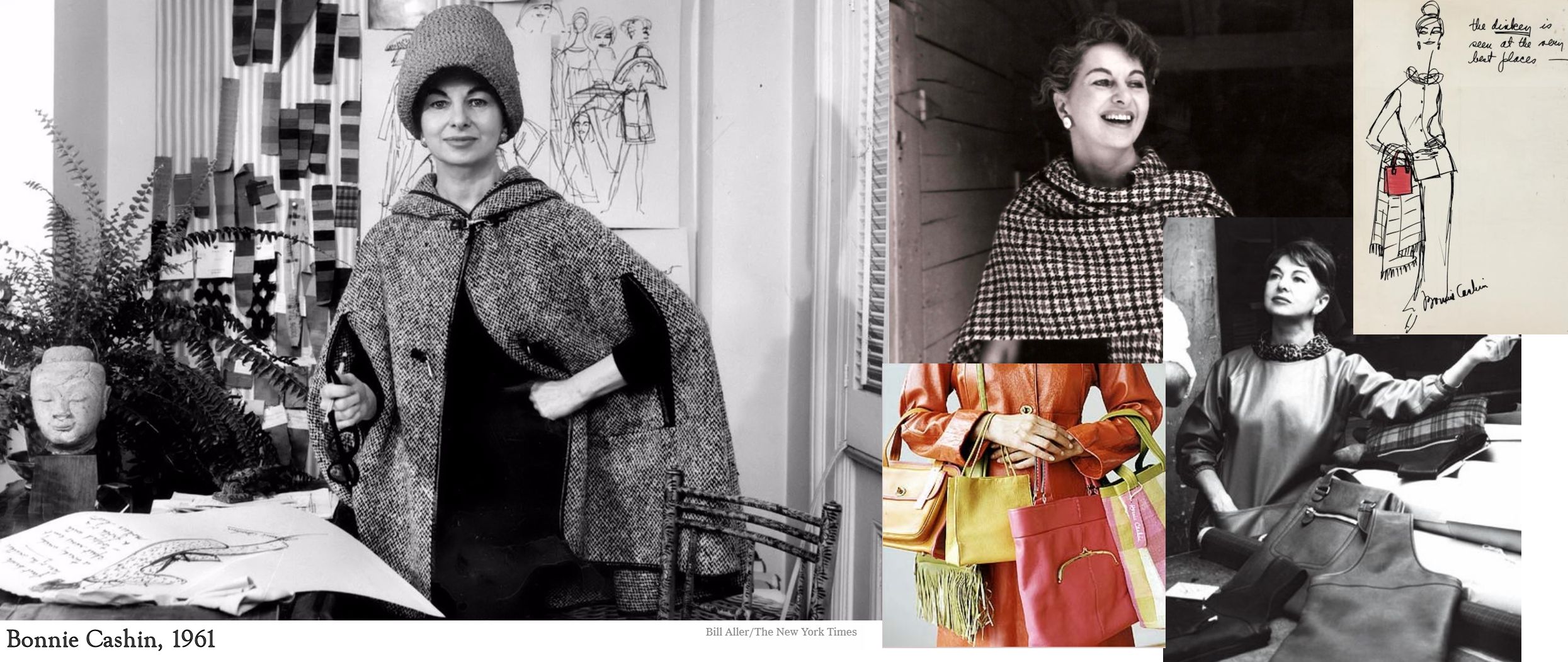
The other Coach innovator --notice that the core of Coach as a brand was created by women, for women-- was what a fashion designer should be: an iconoclast, a feminist, and a genius. And that was Bonnie Cashin (1907 - 2000), often considered the inventor of American sportswear, or the most important designer you've never heard of, although things are getting better since Dr. Stephanie Lake's book on her. Bonnie Cashin changed the way women could dress, over the course of the 20th century, and continuing today. We all love Bonnie, and if you appreciate older Coach bags, you probably do, too, though possibly without realizing it yet, as many of her innovations have been long unattributed, including by the current Coach/Tapestry, Inc. Bonnie Cashin created the leather dress, the women's jumpsuit, the poncho, the modern turtleneck, the concept of layering...really, casual modern women's clothing as we know it. She was the daughter of an inventor/photographer and a dressmaker, a perfect set of influences. She learned to sew before she could write and was sketching ensembles by the age of eight. By 19 she was the head costume designer for the Roxy Theater's dance troupe, described in Variety as "the youngest designer ever to hit Broadway." After creating uniforms for women defense workers during WWII (the jumpsuit), she moved back to California, and costume design for 20th Century Fox (Laura, Anna and the King of Siam, more than 50 films). After a trip to Paris in 1949 left her disappointed with the state of high fashion, she returned to ready-to-wear, prepared to do something about it. After introducing layering as a concept, and winning the Neiman Marcus and Coty awards for her first collection, in 1951 she finally bucked the constraints of Seventh Avenue altogether and opened Bonnie Cashin Designs, Inc. By late 1952 she had her first Vogue cover.
Bonnie would remain an independent designer, primarily to ensure that she had the freedom to create what she, as a woman, wanted to wear. (No surprise, her first collection was called "We Live as We Please.") Remaining essentially freelance, almost an outsider to the conventions of the fashion world, has played a role in the later neglect or underestimation of her role in revolutionizing what real women wore, and continue to wear today, but her boundless creativity and unique spirit were always apparent to those within the industry, as shown by the numerous design awards she always won. (After a point, she had so many that she began using them as doorstops. We love that!) Her decision to remain outside the fashion industry's fairly narrow mindset, in terms of who women were and what they could be and do, was entirely deliberate, and we would call it a courageous ethical and even political stance, which you can see clearly in this quote: Fashion is now. Fashion is acceptance. Fashion is popularity. A large part of my work is anti-fashion. It is the future. It is conjecture. It has not yet been accepted.
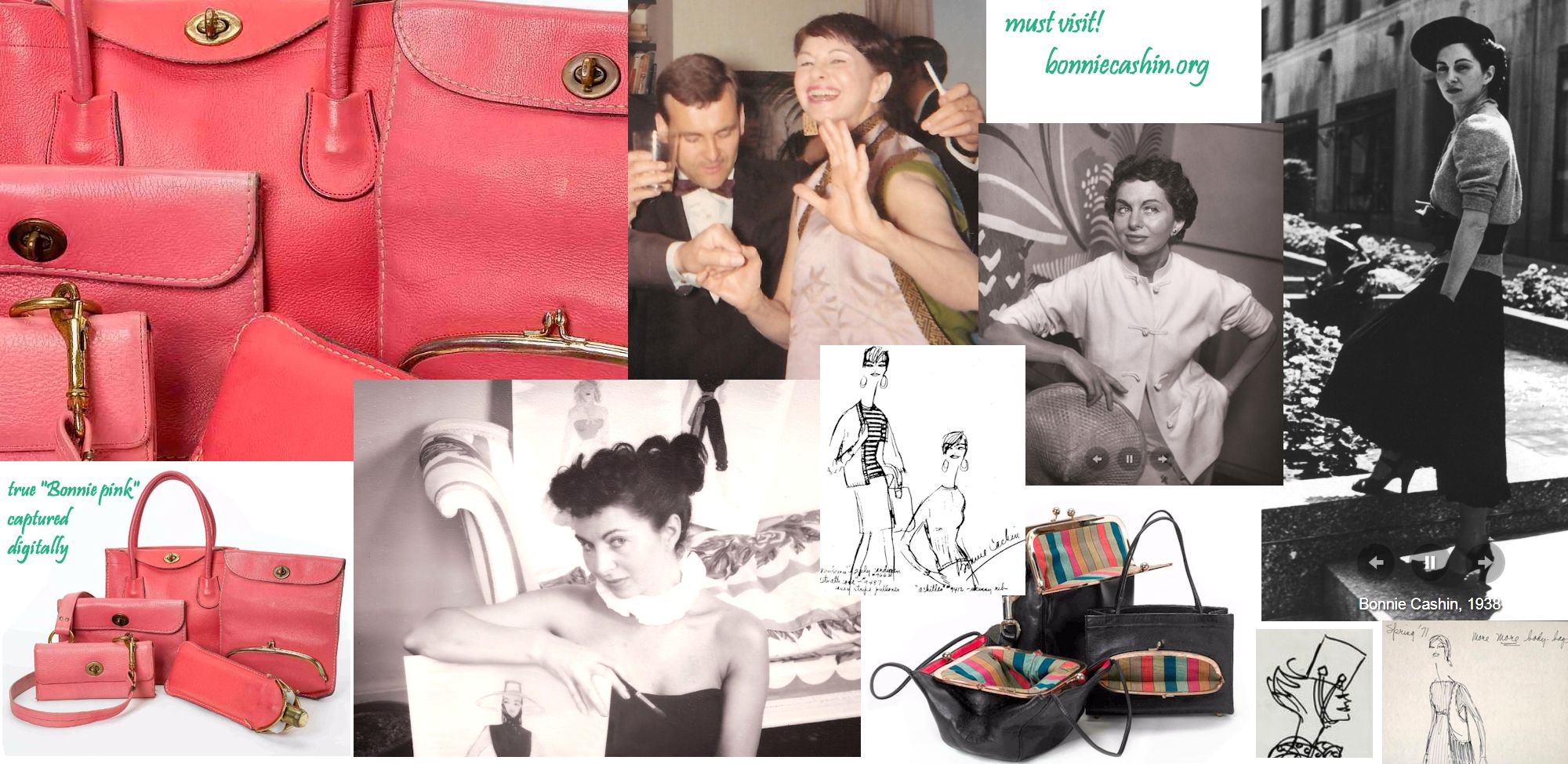
She was, of course, absolutely right that it was the future. (It is also told that she encouraged all fashion designers to read Hans Christian Andersen's "The Emperor's New Clothes" at least once a month. Again, we would agree completely!) This originality of thought is what endeared Bonnie Cashin's aesthetic to other nonconforming women like Marlene Dietrich and Mary Quant, while her insistence on maintaining design freedom was central to her functional and groundbreaking silhouettes, produced for everyone from Sills and Aquascutum to Hermès (with disputes over crediting her) and, obviously, Coach Leatherare. She worked closely with both Miles and Lillian Cahn from 1962 to 1974, still always as a free agent and never an employee, but producing an amazing volume of designs and permutations from which they could choose, including many fun sketches that hold up today as freestanding artwork. (We particularly love the ones where the models wear the bags on their heads. We would like these sketches in poster size. Remember the cat ear hat from the Women's Marches a couple years ago? Yeah, that was Bonnie, too. In the 1940s, called the bag hat, a 1948 example now in the Met. Look familiar?)
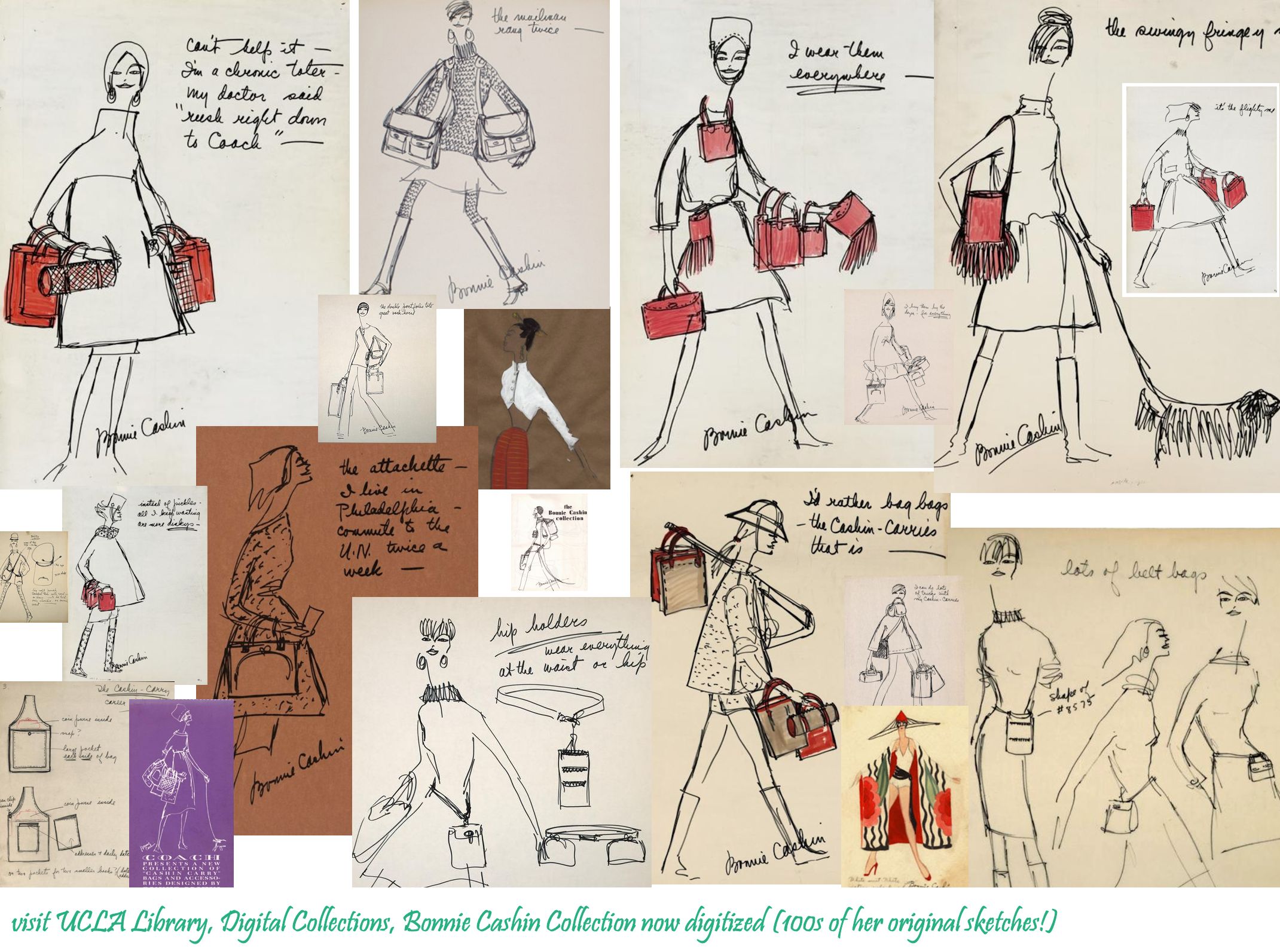
In that period, Bonnie Cashin introduced everything that made the Cahn's high-quality Coach leather into functional, attractive, and eventually iconic bags. Though there is a fair amount of dissimulation from Coach/Tapestry on this today (and particularly a deep silence since 2011 when it became apparent that they don't legally own the trademark to Cashin's work outright), Bonnie Cashin was responsible for everything from the long crossbody strap, detachable strap clutches, and the dog leash brass clips to the kisslock clasp external pockets, and even the Coach turnlock itself --which she called a "turn screw" and which was, now famously, based on the mechanism securing the top of the 1940s convertible car she had driven while working in Hollywood. And she did all this in bright yet deep and harmonizing colors, with great effort expended to get the hues just right, made possible with Coach's full-grain, full aniline leather. For anyone who has held and closely examined a true period Bonnie bag in those brightly saturated colors, you can see these people were bent on quality, and on getting everything exactly right. This is why those bags often look as good today as they did 50 years ago. (Now contrast that with a current Coach bag, with its single year warranty...what a let down.)
We think everyone interested in handbags (among many other things) can learn a lot from Bonnie, including today (a sentiment shared by many now-famous designers...the term "Cashinism" has been coined, finally.) Therefore, it's very good news that the UCLA Library, Digital Collections has now digitized their Bonnie Cashin holdings, literally hundreds of pages. This site is probably the best archive or repository we've yet found, and who could not benefit from some time spent there? The belt bags, many never put into production, seem especially prescient, as they look like they were meant for modern phones...but she drew them in the 1970s. There are dozens of Coach bags in prototypical stages, a few handwritten notes mentioning Miles and Lillian, even a particular wallet design with notes in Bonnie's hand ("make it quality --the best in the market") demonstrating that a commitment to making the very best truly was the driving motivation of these people. The surviving bags are physical evidence that they succeeded. (Compare this with the way the design of a Coach bag is handled today. Wow.)
In the same way that Miles Cahn had repurposed ball glove leather and Lillian had reimagined a paper bag as a leather purse, Bonnie Cashin's creative genius was in taking what existed elsewhere in other contexts and applying it to new needs and purposes, specifically for the then-emerging modern woman, which concept she helped to shape. She is generally credited with coining the term "hardware" to describe purse fittings like turnlocks, dog leash clips, kisslock clasps, all of which she introduced to handbags from their previous incarnations in other industries. Bonnie originated hands-free crossbody straps, a variety of belt bags, large exterior clasping pockets, convertibility in so many forms, and generally all with an action-ready stance that was radical at the time.
Bonnie always looked much younger than her years, and had had to fudge her age in some contexts, but the best estimates now place her true year of birth as 1907. To put that in context, Queen Victoria had been on the throne only six years prior, Teddy Roosevelt was President, Oklahoma became the 46th state, and women wouldn't be able to vote in America for another 13 years. Compared to the mores of the society in which she operated, Bonnie Cashin's mindset was an almost ontologically different position on who women were in the world and how that world should see women. In her characteristic way, she imagined handbags as tools for toting needed things, rather than as trinket-like objects in themselves, carted about to signal status or conformity, and with only the space for a lipstick and a mirror. Her ideology was in direct opposition to the mentality of the time, and it manifested in a material culture that, among other things, definitively swept away the view of women that had produced the typical small rigid bags in neutral tones, meant to demurely and seasonally match one's hat, gloves and shoes. She suffered for her steadfast refusal to conform, often branded as "difficult" at the time, and even in our day still slighted, denied credit when her work is constantly copied by others without attribution, and largely written out of history, including by brands that owe much of their recognition today to concepts of hers. Handbags are, yes, only handbags, but as a concrete physical manifestation of a changing worldview, a good leather bag was something that allowed ordinary women to connect in their daily lives, to identify with, and to practice that opposition to prior restrictive, conventional thinking about who women were as people, what they could do, and therefore what kind of clothing and gear they needed. As history has shown, Bonnie was so right, in so many ways...we alive today owe her a great debt. Societies don't change concretely without people like Bonnie Cashin to lead the way forward.
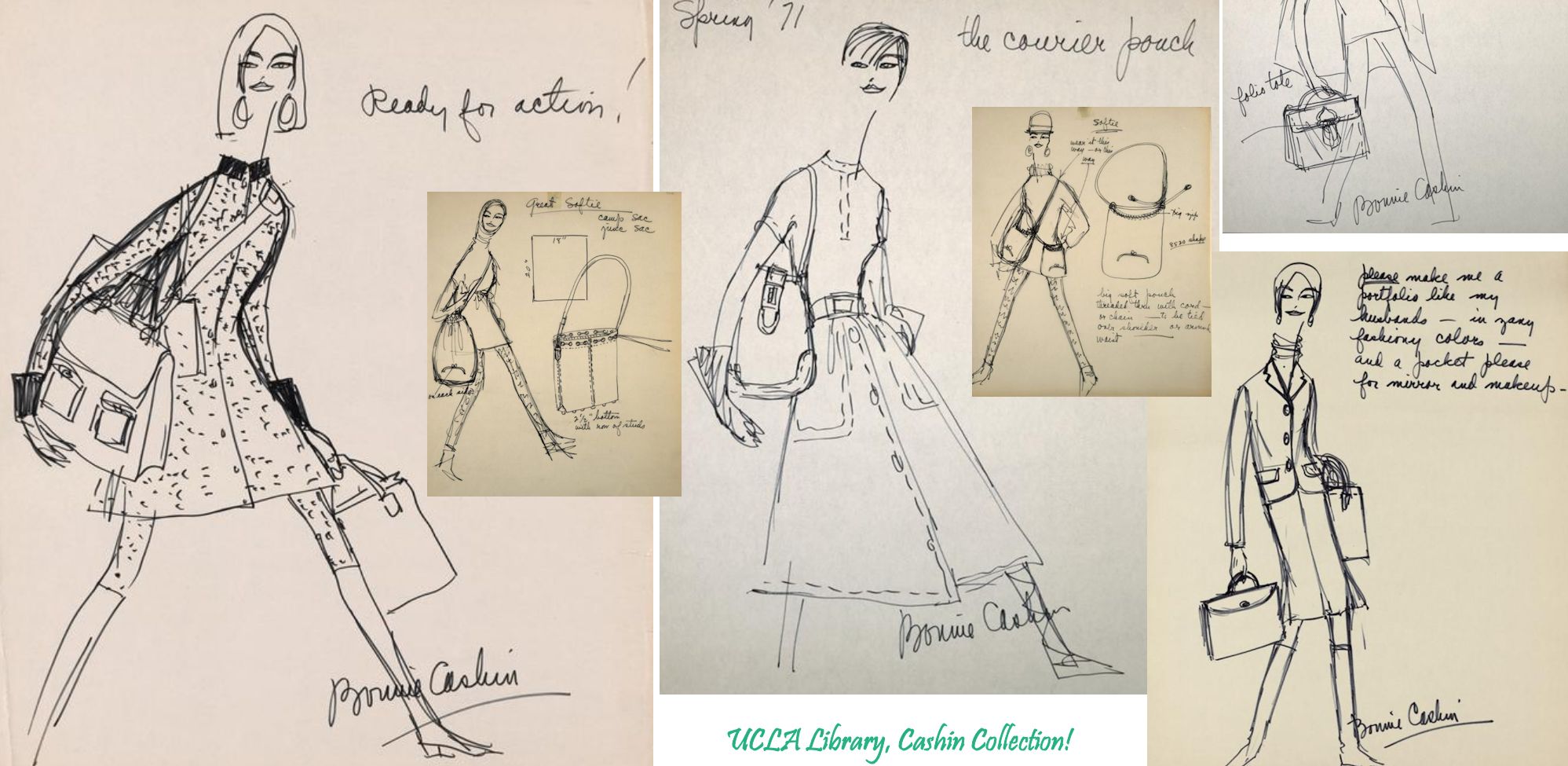
It is out of respect for smart, pathbreaking people --original thinkers like Bonnie Cashin and the Cahns-- that we feel the truth must be told about the new incarnation of the company that survives them. We want that founding spirit back -- not its literal antithesis, as seen in what we find to be gaudy, low quality and functionally poor bags being cranked out today under the Coach label. And those originators left us a model for good design, not having any particular shape or color. It has nothing to do with the current head of Coach design playing games with pop-spokespeople. Instead it was a mental archetype involving the repurposing of functionally successful mechanisms and materials to suit modern and developing needs. If Coach bags were still imagined in that way --rather than 'new designs' meaning a different type of stuck-on bauble in now-defunctionalized shapes-- they would no doubt rise again, this time to become the most popular handbag, not just in the US, but in the world, and with a reason. But instead they offer us ridiculously formed and ugly 'belt bags' in bad leather with prints of upside-down Dumbo cartoons. And that's a Coach bag. Really? (This is the kind of outrage that leads otherwise-normal people to write book-length screeds on a handbag brand.) For contrast, there is a nice summary of Bonnie Cashin's design ethos at bonniecashin.org:
Cashin's oft-stated credo, "chic is where you find it," summed up her belief that a "habit of wonder" and an ability to see relationships between objects and ideas far removed from the fashion world were vital tools for the generative designer. Rather than look at fashion history, she was apt to cite the rhythm of poetry, a new mathematical theorem, or a bird's nest as inspiration. That Cashin avoided gimmickry, and instead imaginatively translated these unrelated source materials into decades of consistent, connected, and highly functional garments, is a testament to her belief that the enthusiastic pursuit of individuality is always timeless.
We have now traveled far back to the very genesis of the Coach bag, and the people who conceived the product. We have looked at the materials used in the vintage bags, and why those particular materials were chosen. We have also gained a bit of familiarity with some abstruse and frequently disingenuous practices and terminology found in the modern leather industry manufacturing the bulk of the (faux-grain) bags available today.
The differences between vintage and modern materials are marked. It's time to put this information into practice, to analyze some actual Coach bags and see what they tell us, both on issues of product quality, and on the now-ever-present matter of 'authenticity.' We think an analysis of the actual structure of the leather from which a bag is made is a far better metric of a quality bag than any company-generated registration/'serial'/style number. This methods allows for the ruling out of counterfeits, where they do exist (which is comparatively rarely in the leather bags), but also of lower-quality Coach-made and Coach-branded modern bags. And we will say it outright: we feel the modern leather bags truly are inferior in their materials as compared with the Coach bags of even two decades ago. If you get a loupe or even a decent magnifying glass and begin to look closely at any sample of Coach leather bags, we think you'll agree. And when enough of us have done this, maybe then Coach will recall its true heritage and again produce bags to the standards that made the company famous. With their modern bags priced at $500 to $1000, expecting truly good leather from Coach, of all companies, hardly seems pie in the sky.
We find that structural, material differences in the surface of the leather are infinitely more useful in determining if something is actually a good-leather Coach bag than really any other metric. This includes the numerical or orthographic minutiae that is the focus of just about every internet 'guide' any of us has ever encountered, where lines above or below the registration numbers, word spacing in the creed stamp, or even brand of zipper are sometimes presented as 'the definitive' indicators. None of these things is ever a definitive indicator. The only thing that really is is the leather. The look of the bag, both in form and materials, should align with the creed stamp(s) in use in a given period, meaning the creed stamp is always relevant, but it is never determinative in and of itself.
A good number of creed stamp images appear throughout this screed, across a range of periods, and from that it should be possible to see the basic trajectory, and match it up --or not-- with the far more relevant grain characteristics of leather used in each period, which will be our focus here. (The big divide is after about 2000. Everything that came before was full-grain, full-aniline. Nearly everything that came after was something less.) Creed patches can act as confirmation, though, and what you want to see is a creed variant that matches with the leather used in bags of a given time period.
Others have already covered this aspect before, elsewhere, but in a nutshell:
The 1960s Coach bags had no creed stamp, had no hangtag other than the old baseball-shaped "Feel it!" sample swatch (usually gone now), and had no permanent Coach markings except (a) a small internal enameled metal plaque that read "COACH" in white letters on black background, or (b) an embossed COACH stamp inside a cartouche with chamfered corners, either riveted into the inside of the bag or embossed in a lower corner of the item's exterior, often quite small. All the leather bags were full-grain, full aniline.
The 1970s bags had either (a) in the early 70s, no creed stamp and no registration number and usually the cartouche stamp seen in the later 60s bags, also the first lozenge hangtag, single-sided, (b) in the middle 70s, the first creed, first iteration (with "scratches, veins, wrinkles" wording) and "Made in New York City," but without a registration number, or with a registration number embossed on a separate piece of leather glued in directly below the creed (see below, far right), or c) in the late 70s, the first creed, first iteration, the "Made in New York City" below the creed, and a directly stamped registration number seven digits long. Both the creed and the lozenge hangtag will have the word Leatherware under the Coach name. The registration numbers were unique to each bag at that point, were all numbers seven digits long, in a XXX-XXXX format, and had no relationship to style numbers seen in period catalogues. All the leather bags were full-grain, full aniline.

The early 1980s bags were like the late 70s bags. By the mid to later 80s, the creed appears in the second iteration (no longer NYC but United States), the hangtags are still lozenge shaped but become double-sided (i.e., less like a sample swatch), and the registration numbers have a period of a reversed format, XXXX-XXX, though still all seven digits and still having no relationship to style numbers. Still all the bags are full-grain, full aniline.
In the 1990s, smooth leather bags show the second iteration of the original creed, with either "made in the United States," or made in a handful of other countries. (Typically it's Costa Rica, Italy, Spain, Mexico or the Dominican Republic; some bags were made in Turkey but apparently few in number. Country of origin will never be anywhere in far east Asia in the 90s. Any bag that gives China as country of origin is after 2000. And any bag that gives Korea as origin is a counterfeit, and is vinyl, not leather.) Textured bags appeared in the 90s with slightly different creed formats but all were still full-grain. In 1994 the format of registration numbers switched back to XXX-XXXX and the last four digits became the style number across all bags (i.e., no more unique registration numbers). The first chunk of the number (XXX) began to indicate production codes (month by letter sequentially, year in single digit beginning with 4 for '94, final letter a code for plant of production). All 1990s Coach bags were still full-grain, full-aniline leather, whichever country they were made.
In the 2000s fabric bags with only leather trim appeared, fabric linings became standard in leather bags, and the original directly embossed creed stamps were replaced by sewn-in patches with more variable wording. The country of origin became China. In leather bags, after 2001 full aniline was replaced by semi-aniline (various types) and the registration numbers fully became style codes and grew in length. Made for outlet 'factory' bags appeared, eventually with an F in the second portion of the style number, after the dash. From 2001-2009 bags were still full-grain, though generally not full aniline.
After about 2010, things went steeply downhill, we think. More and more bags are mixed materials (leather with canvas, fabric, etc.), style numbers are variable in format (even being eliminated and removed to a white paper tag at one point a few years ago, sewn into fabric linings), and nothing that we have seen is a full-grain leather anymore. The word "full-grain" is replaced in the creed with "genuine leather," or no mention of concrete materials at all, and the creed ceases to be a creed/quality-guarantee and becomes a "storypatch." In every case we have seen so far, the bags are no longer full-grain but faux-grain. Wear is consequently rapid and irreversible.
As was mentioned above, the appearance of the word "full-grain" in the creed --or the absence of it-- is usually the single easiest way to gauge the quality and the worth of a Coach bag. If you can distinguish what a full-grain full aniline leather looks and feels like, and it's confirmed by "full-grain" wording in the creed, you'll generally never have to worry about 'authenticity' again in any vintage (vintage = 20 years old or older) leather Coach bag. This frequently comes down to pore structure, and when it looks as it should under a 10x loupe for a bag of that period, you can be confident that it's a Coach. This is because the copies, when they did exist, were frequently not even real leather at all, let alone full-grain full-aniline, the most expensive kind of leather. It was always the grade of leather that distinguished a Coach bag.
When identifying a full-grain full-aniline piece of leather --and therefore a vintage Coach bag-- you're looking for the open pores of the natural grain, where the hair follicles had been. Everything other than aniline-dyed full-grain will have a surface coated/clogged with synthetic substances (paints/plastics) to give it an artificially smooth appearance, usually over a mechanically stamped and therefore comparatively too-linear and repeating fake grain pattern. No simulated faux-grain surface will ever have the same kind of irregular pores as seen in nature and no coloring treatment but full or pure aniline dyes will leave those pores open.
We've tried to capture some of this pore structure on a variety of Coach bags below, using an assortment of cameras and phones zoomed in, but none with a proper macro lens. The hope is, as we move through time and the true grain is replaced with faux-grain, the difference will be visible. It's also worth mentioning that, in person with a 10x loupe, this is much easier to see, readily visible, especially when you know what you're looking for.
(1.) A typical vintage Coach bag, a shoulder bag/City bag in burgundy (creed color looks weird due to glare), of the type that tends to survive in good shape for decades. In this case, we can see that it's from the 1980s by the format of the registration number (XXXX-XXX), made in the United States. Taking a loupe to this sort of bag, you will always find an irregular pore structure, with the pores open, like tiny, tiny hollow cylinders or tubules, rather than the sort of shallow pockmarked effect or muddy stamping patterns seen in faux-grain. All Coach's 80s bags were full-grain leather through-dyed with anilines. Anything that doesn't show this sort of open pore structure on magnification isn't a Coach bag.
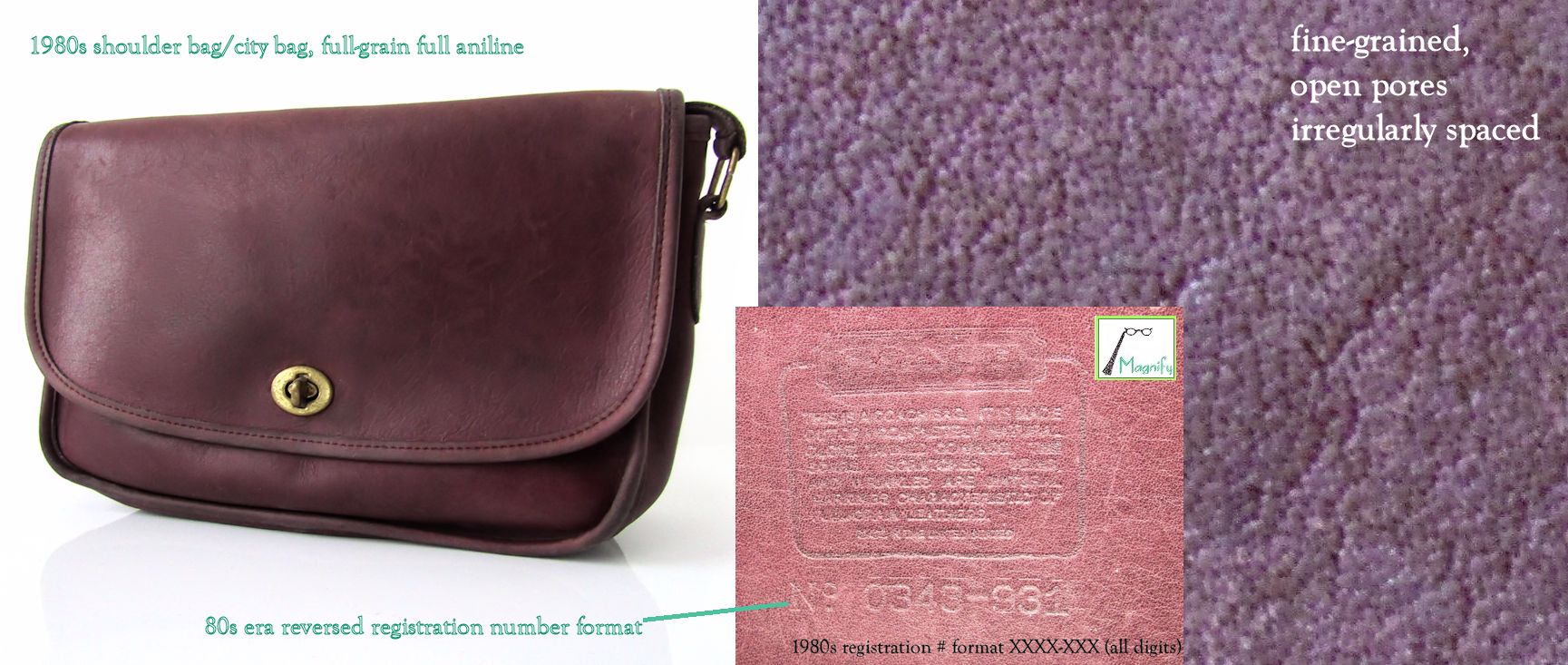
(2.) A Watson bag from the late 1990s (1996, style 9981, US made), almost as new and rarely carried, with a fine-grained and kind of dry, open pore pattern on all the smooth leather surfaces, clearly never waxed or oiled. We actually have a super-magnified image of this one (taken on the sly during a lunch break with better equipment). The image at right is more than 10x, greater magnification than anything we could get with a normal camera, but in person, a 20x loupe is enough to see even fine-grained or very small individual pores like this. The color is deeply saturated, more depth of color than seen on many earlier bags, but still visibly full-grain and full aniline, as the miniscule open pores show.
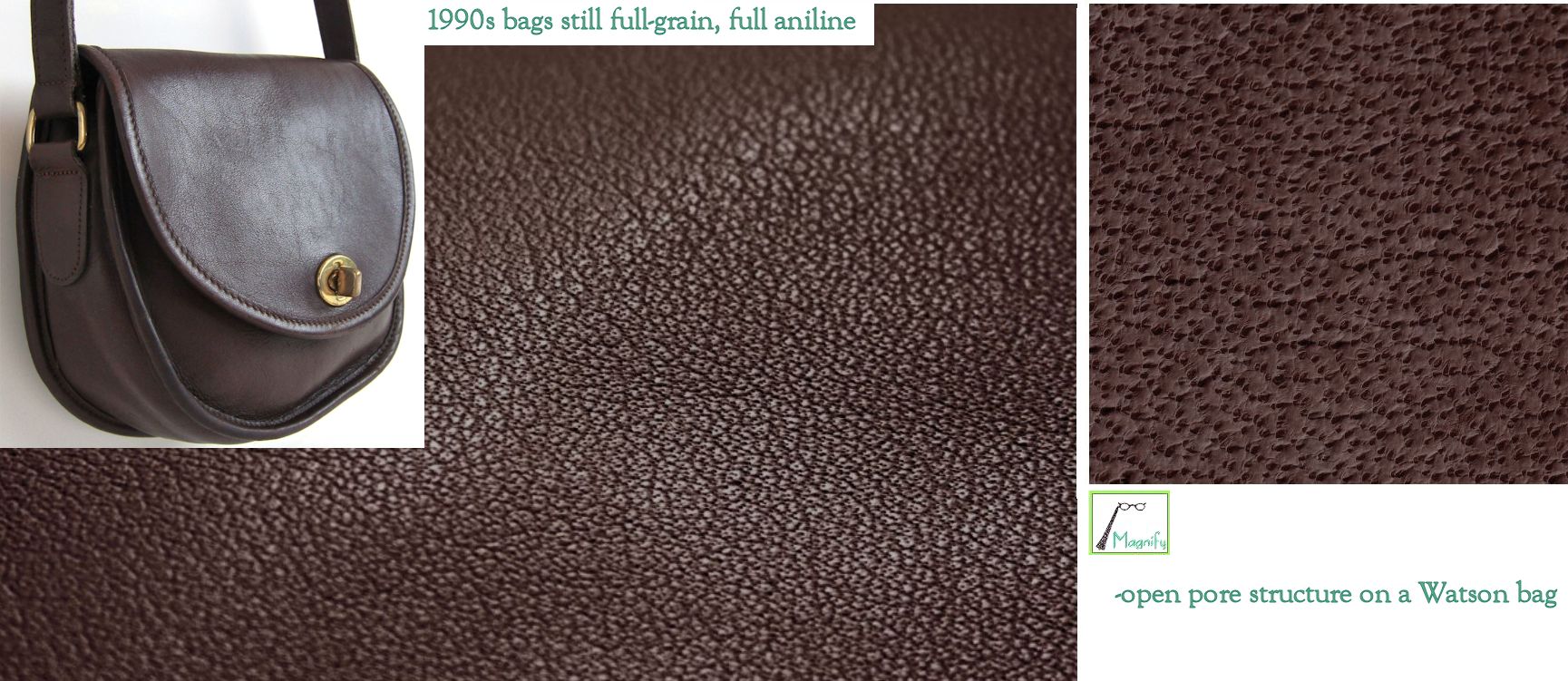
Vintage bags in almost-new condition are rare, though. What is more common is bags that were carried, occasionally conditioned over the years, and still look good, in a softened or burnished rather than a crisp way. The distinction between a fake grain/pore pattern and a real one is never more apparent than on an older bag that has slowly burnished over time. It is precisely this open, uncoated pore structure, only found in full-grain dyed with aniline, that allows for burnishing and patination as the leather is handled. And this is the deeper reason vintage Coach bags last so long and look better as they age, developing smoothed edges and a dimensional quality to the color. That smoothing and light shine at the edges, or in other places where the bag was rubbed, results from that open pore structure being compressed and worn smooth over time. It's exactly the sort of thing that cannot happen with faux-grains and painted/coated leathers (no matter how much you hug them), because that surface finish will simply flake or wear off. But while paint rubs off, aniline leather's open pores allow for compacting and smoothing out as the fibers compress and become more dense. It will never peel or flake off as painted faux-grains do, which is really the huge divide in leather bags. And now let's remember that new hug-it creed, exhorting us to hug the new plastic-coated "genuine leather" bags. This is the real issue with that, and why it amounts to advocating leather-alchemy, turning the leather equivalent of lead into gold, apparently just by wishing and hugging it really hard. Looking closely at the grain shows just how daft that is.
(3.) Below we have some true burnishing, heavily magnified, and specifically a pretty good example of the way the microscopic pore structure changes over time, stretching under (true) embossed stamps like the Coach cartouche, while compressing smooth at wear points to allow that glossy patina to appear. Seen here in a red NYC bag from the late 70s (the compact pouch/compact flap bag), this is what "the character" mentioned in old Coach ads looked like. Back then it was all true, the bags actually would come to have a unique 'pursonality' as you used them. But that's because they were full-grain leather rather than "genuine leather," and that grain with its natural open pores was intact.
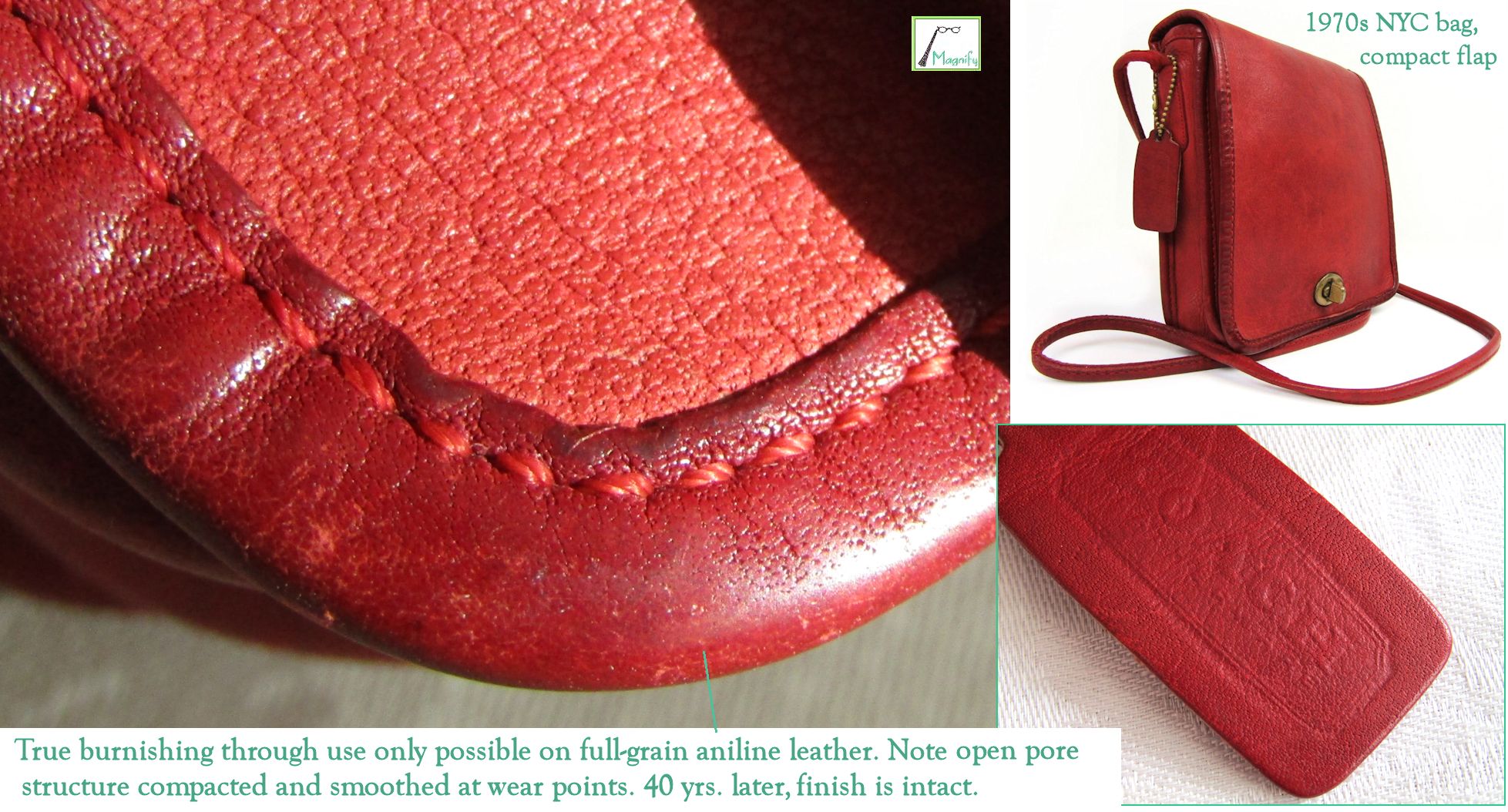
After a thing has burnished (always at the areas most handled, usually the edges) the pores remain open, never clogged or muddied looking as with stamped faux-pores covered in a paint layer, even if their depth is reduced through wear/friction. Conditioning with unadulterated oils (e.g., neatsfoot for darker colors, mink oil for lighter) will also absorb into the grain and not clog up pores, though conditioners with acrylics or synthetic resins can (and should generally be avoided). True burnishing has a characteristic look, with a glossiness at wear points rather than a substrate layer showing through, and is a sure sign of old full-grain aniline. It's something that cannot yet, to our knowledge, really be faked. The bags that have this look are most often from the 1970s, when 6 to 8 oz. leather was common, and if they have the creed patch (some earlier 70s ones predate the advent of the creed patch) it will generally be the first iteration, with the "scratches, veins, wrinkles" wording and NYC origin.
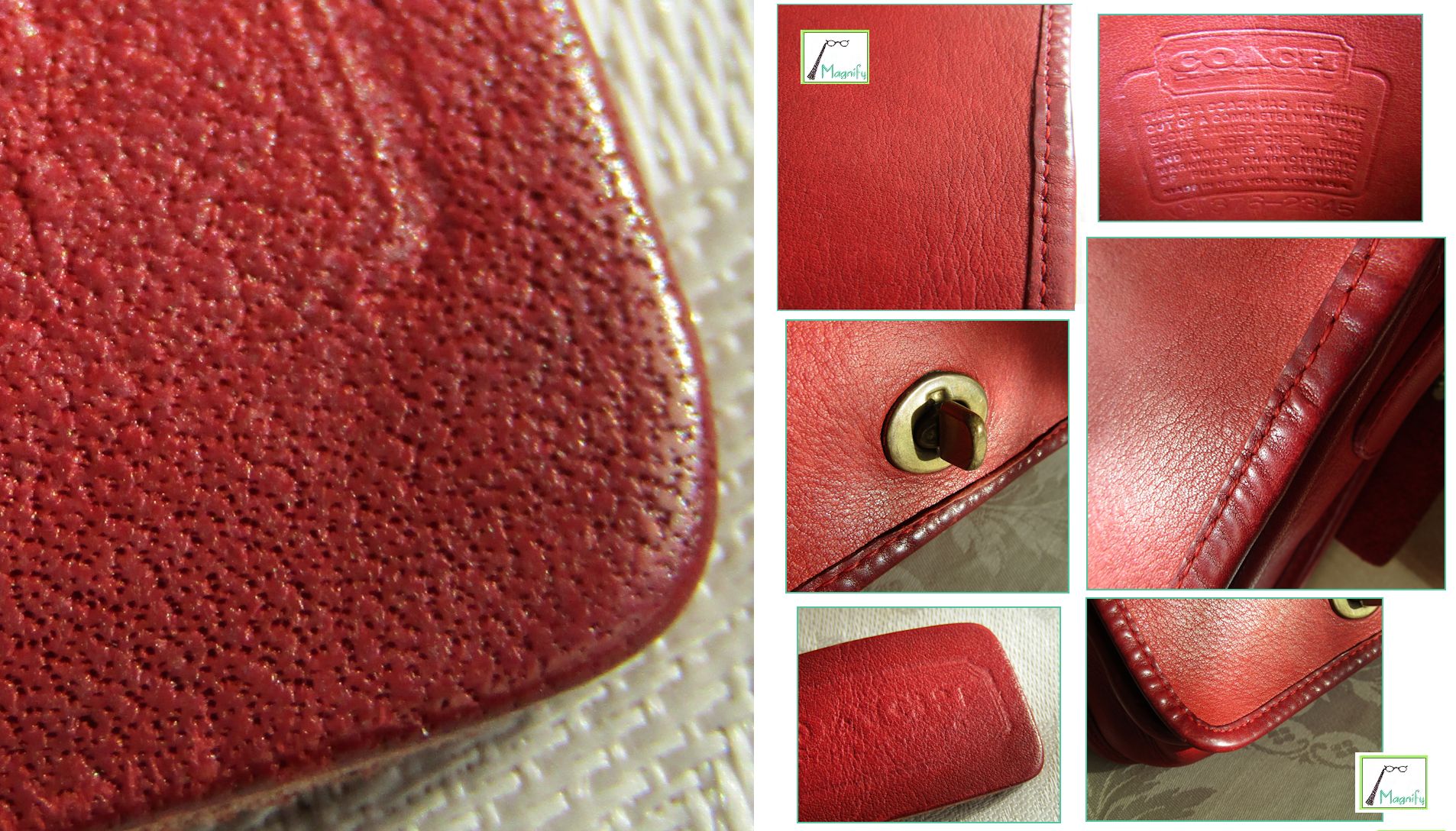
There is a different look to full-grain aniline leather's pore structure when literally brand new, never handled. This isn't easy to find these days in a Coach bag, short of pre-2000 new old stock, but we do have some examples of that here. (All of this is so much easier to see in person, with a loupe or even a decent magnifying glass...we did the best we could without a real magnifying lens.)
(4.) and (5.) Coach bags remained full-grain full aniline through the 1990s, and not just the super-chunky ones in the darker or traditional colors, as some people think. The lighter weight Soho leather, introduced in the 90s in a variety of bright and even pastel colors, was still always full-grain full aniline dyed, no coatings, which we can see from two new old stock, unused Soho bags, one lavender and one orange. Both of them, on magnification, have that characteristic open pore pattern, but with the distinct fresh, almost dry look that full-grain has when never carried, oiled or waxed.
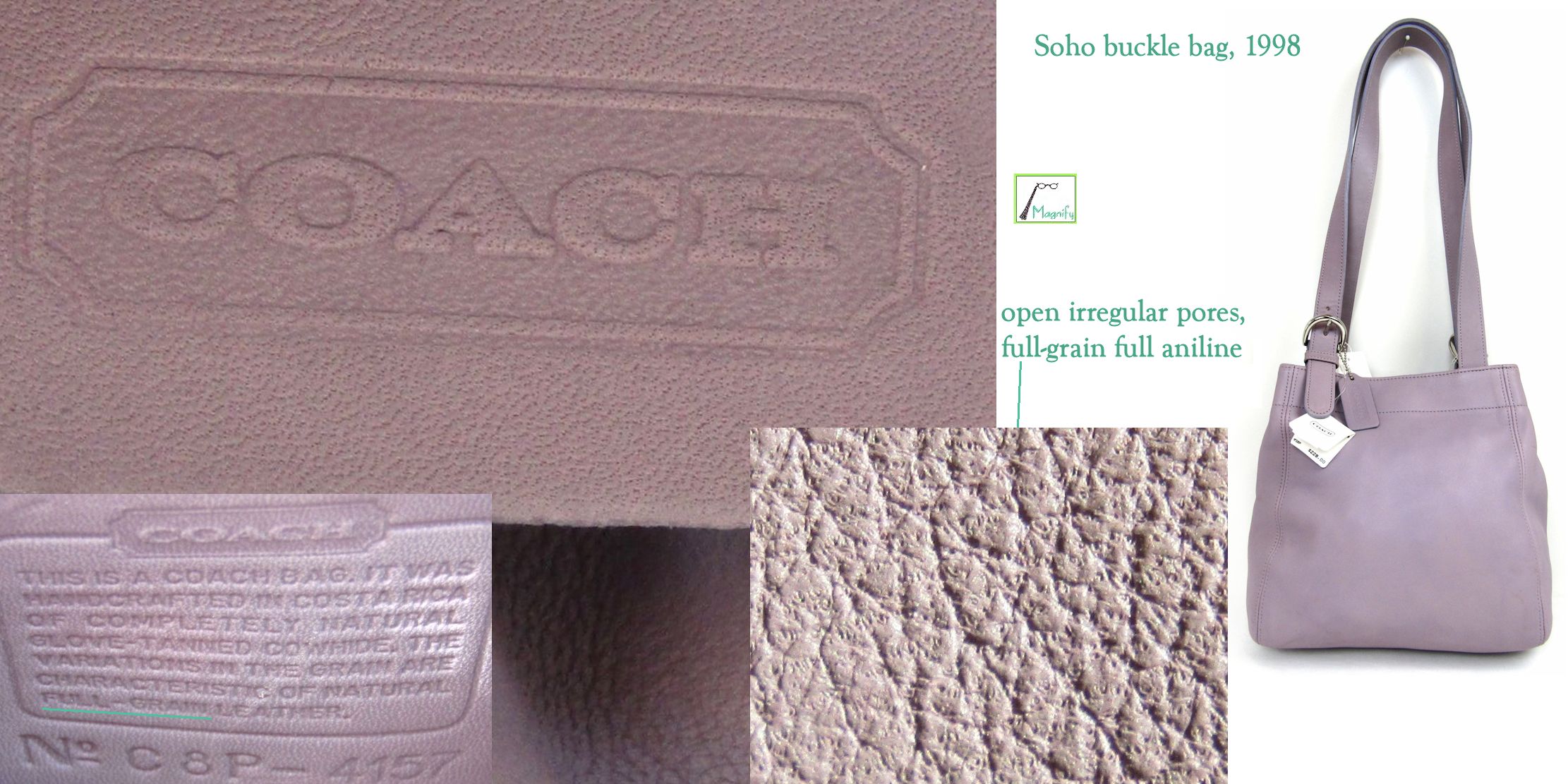

Even after 2001 when production shifted to China, the full-grain hides weren't completely abandoned for about a decade. However, that shift pretty much marked the end of the full-aniline dyed Coach bag. There were forms of semi-aniline appearing after that, which is basically a very thin --very thin-- layer of pigmented surface over a full-grain hide.
The signs of semi-aniline are (a) the creed says the word "full grain" --because anything else would rule out clear aniline dyes altogether-- and (b) you can still make out the distinct and non-repeating individual pores, sort of, which should not be completely filled up and certainly not clogged and coated over, as with faux-grain/pore patterns stamped in and painted.
(6.) Below is a red Sabrina bag from 2008, noteworthy because this particular red surface is sort of characteristic of that intermediate period (before the true fall after 2010 when "genuine leather" replaced both full-grain and, necessarily, aniline). This surface was known for gradual fading, which you can see by comparing the pink cast of the bag's leather with the bright red of the patent/coated Coach tag. And yet it's not the end of the world because the leather can be refreshed and to a degree evened out with oils, which shows it's a semi-aniline, the grain layer present and not completely sealed up. The fading seems to come from the slightly fugitive quality of the pigments in the very thin layer resting on the surface, combined with UV action. But these are still a comparatively very low percentage of pigment particles in suspension on an intact grain structure, which is quite different from acrylic/plastic/painted surfaces on faux-grain. Again, it would help a lot if we had a true macro lens, but hopefully some of the intact mostly-open pore structure can be seen here, just slightly sealed, as with other semi-anilines (now mostly seen in upholstery and certain small leather goods made for men). Because the eventual fading of the surface can be more or less regularized by the user, mild effort with common conditioning products enough to prevent a worn or ugly blotchy appearance, we'd say semi-aniline is still certainly preferable to any faux-grain painted leathers, simply because those can't be normally refreshed after any wear begins to show. And this means they have very short lifespans compared to both full-aniline, obviously, and semi-aniline, which does have a degree of stain resistance that can be understood to balance out the slight fading issues.

You may hear that full-aniline leathers actually fade the most, but this is generally in regard to leather upholstery, and it isn't an issue in the same way with a handbag. The mild variegation or graduations of color in full-aniline are actually an intended part of patination and "the warm glow of real leather" that Coach bags were meant to develop. Any natural fading follows the form of the bag, gives it that dimensional look, which we consider an improvement. With semi-aniline, the patina isn't as good, just ever so slightly plasticine, but the surface can still usually be refreshed at home with the same natural products as for aniline leather, so wearing-out due to bad grade of coated leather isn't an issue in the same way as corrected grain or "genuine leather." (We'll shortly move on to looking at how badly those faux-grains wear, and how irreparably.) It's exactly the absence of patination and burnishing that makes bags of those lesser materials look truly and hopelessly ratty, and quickly, making them an unexpectedly sorrowful experience when it's a Coach bag. And this actually wasn't a problem until quite recently, as the variety of full-grain semi-aniline things show.
(7.) Below, another instance of full-grain semi-aniline surface, as judged by the pores, this from a wristlet c. 2005. We can still make out the pores, though they are becoming a bit more clogged-looking, and the darker brown trim is particularly heavily clear-coated. And yet, the surface is still largely natural in satiny feel, it doesn't have that cool, slick or rubbery texture of the "genuine leather" Coach products from just a few years later.
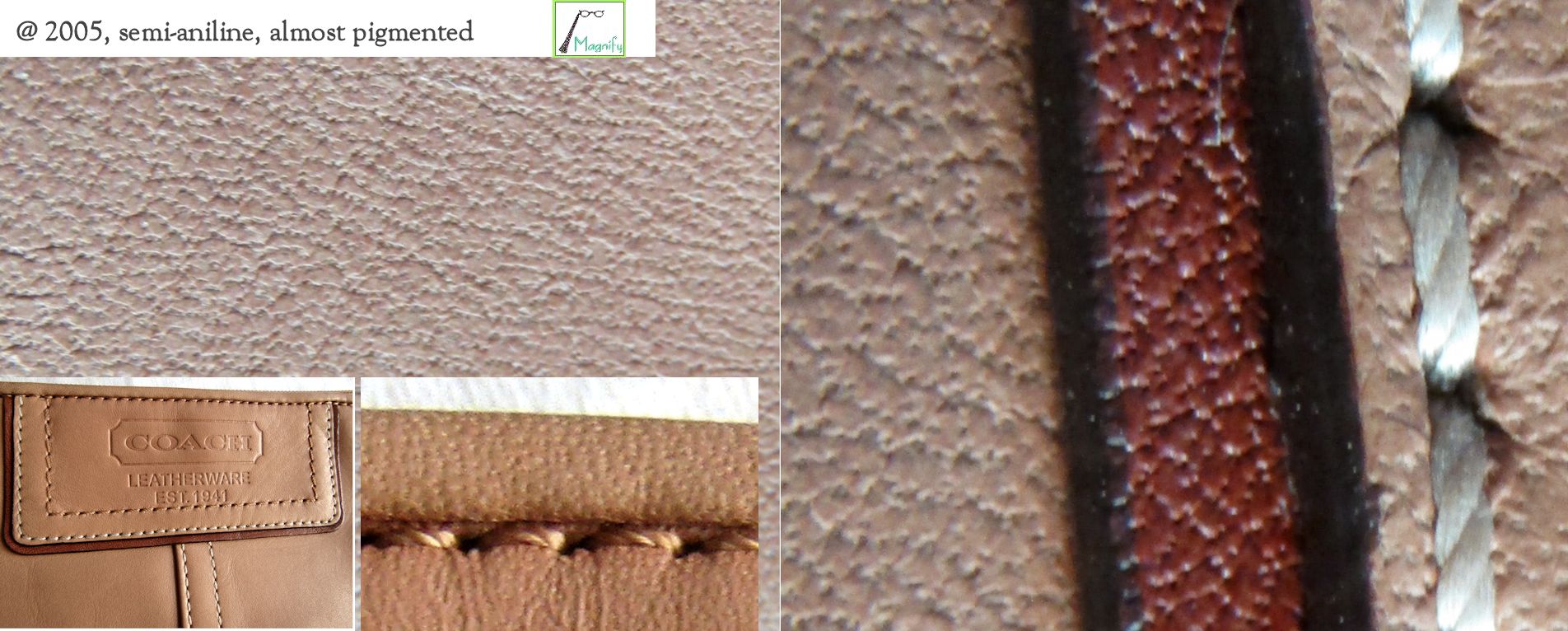
(8.) A final type of Coach leather seen in this period, the mid 2000s, that we would consider roughly on a par with the semi-anilines, is the metallic foils on full-grain, a couple of examples of which appeared above. Below are close-ups of the pore structure on those bags (a gold Bonnie satchel and a large bronze/gold Sabrina, both 2008), the best we could do without a better magnifying lens due to glare, but it should be apparent that the natural --that is, real-- grain is intact on bags still showing full-grain wording in the creed, even when coated with a very thin metallic foil. That grain layer is tough, it's what makes real leather wear and last like...real leather. Even if foiled, it can be refreshed. (Bizarre tip on how to touch up metallic/foiled leather, from the old-time rodeo circuit, no kidding, when people wore elaborate decorated gear like chaps, etc., sometimes with foiled leather trim. The original method used gold or silver eyeshadow, mixed into mink or neatsfoot oil, but later people discovered that dry metallic pigment worked better, like a dust, which you can get from artist supply stores. Mixed into the oil completely, spread as a thin paste to worn or dull areas and lightly pushed in, left to sink in, and buffed the following day. Because all the leather was full-grain back then, this worked, apparently by the oil being drawn into the grain layer and taking the micronized metal particles with it just enough to fill the pores and give it a shiny metallic look again. It only works if the leather isn't plastic-coated, though, because the pores have to be intact and open beneath the foil. One of us tried this on a slightly dulled corner of this Sabrina bag and it worked, you can't even see where it was.)
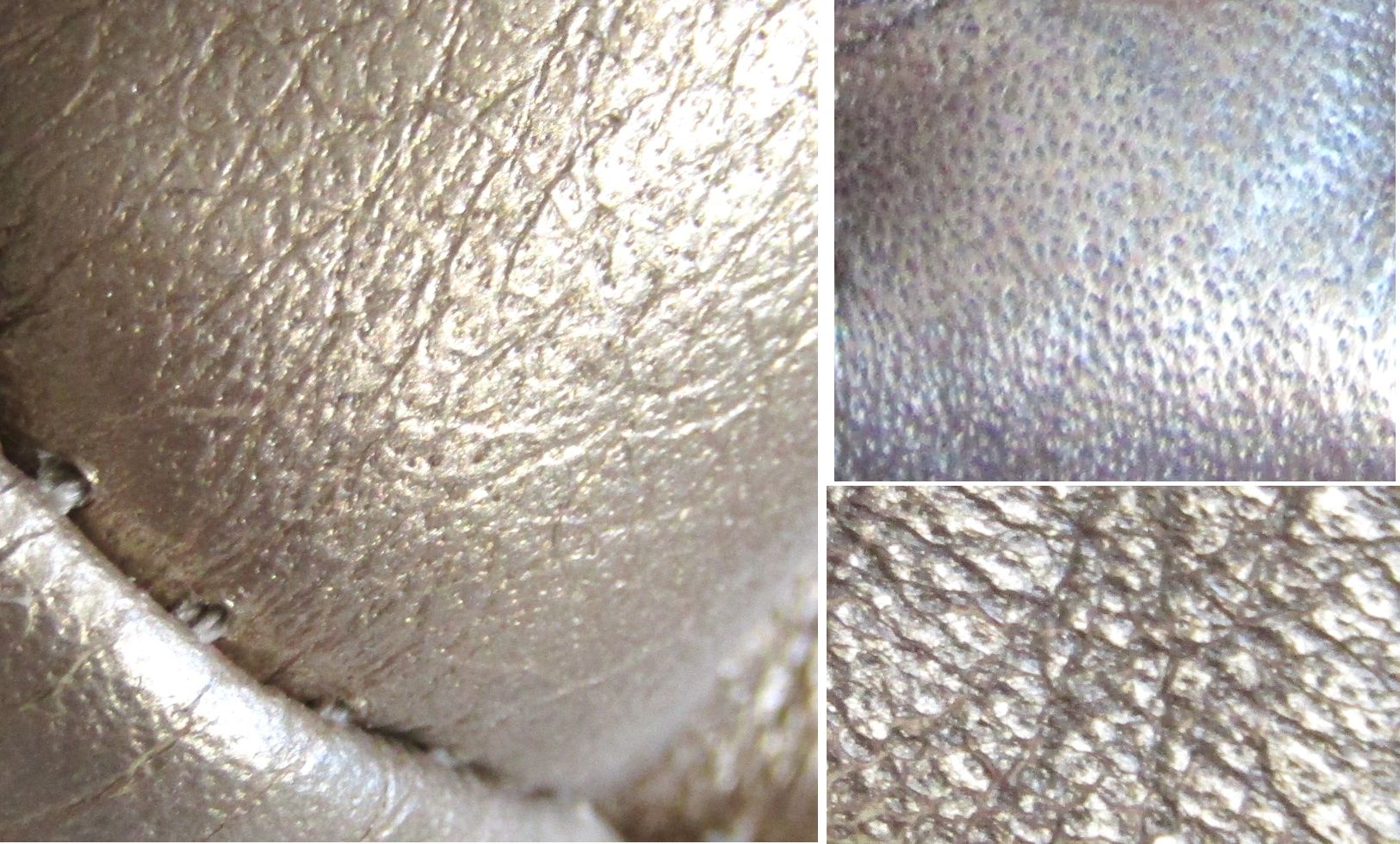
And so concludes, pretty much, the days of full-grain Coach bags, after about 2010.
Faux-grains, both corrected/top-grain and the modern "genuine leather," can start out looking pretty good, at a distance, because very clever ways of simulating natural cowhide grain patterns are now in common use. But a 10x or 20x magnifying loupe will always show some kind of coating or clogging of the pores, even on the most convincing corrected/top-grains with comparatively minimal sanding and some (abraded) original pore structure remaining. (Harder to distinguish is semi-aniline, but Coach only did semi-aniline from 2001-2009 or so, never earlier.) But once a faux-grain thing is used a while, that's when it really shows its stripes, the surface deteriorating rapidly as the fake grain pattern and the paint covering it wear through.
This is why it's worth looking for the pore structure, especially on things that appear perfect when new, because often the only way to tell a fresh faux surface (other than destructive testing measures like stretching, scraping, burning samples) is with strong magnification, looking for that open pore structure, and specifically, pores arranged in a variable or random way across the changing surface of the grain, as seen on natural skin. Even when the faux-grain (that is, the fake stamped-in pore structure --because such things aren't uncommon) is cleverly done, over the expanse of the surface there will almost always be signs of it being too linear or regular, like a printed, machined pattern not possible in nature, in addition to the more universal clogged-up and coated look, from opaque paint and polyurethane.
By comparison with the old full-grain bags, some of the most depressing modern bags are the Legacy series that came out a few years ago, 2012 and 2013. When these were announced, many hoped the logomania madness was finally over and good leather Coach bags would be regularly available again, e.g., see the little clip from The Wall Street Journal site. But 'lighter weight leather' wasn't the main difference. "Genuine Leather" was, and this was reflected in the creed, as can be seen in the 'Legacy' duffle bags below. Many were burned by the cheap split hides used in the Legacy bags.
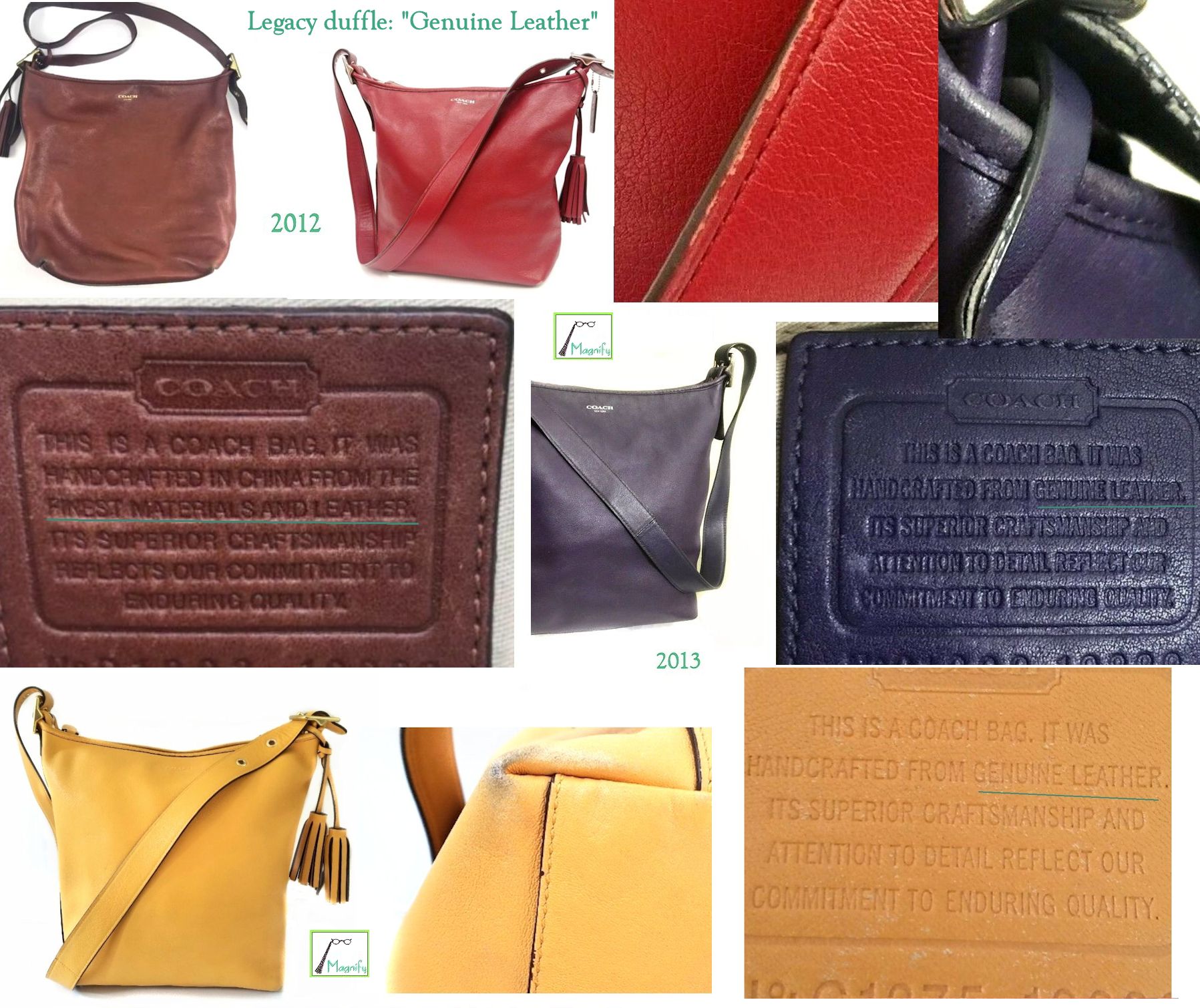
As many of those who bought these know by now, deterioration of the finish, especially at the edges, was rapid and irreparable. That's what characterizes 'genuine leather' as that term is used today, because it's split hides, painted and plastic-coated. This made it even more ironic when in 2018 another duffle was introduced, and this happens to be the single bag any of us has seen in the past several years where the word "full-grain" actually appears in the creed. And yet, based on the way it's framed --see 2018 duffle creed images below-- there are enough inconsistencies that no one is prepared to gamble again.
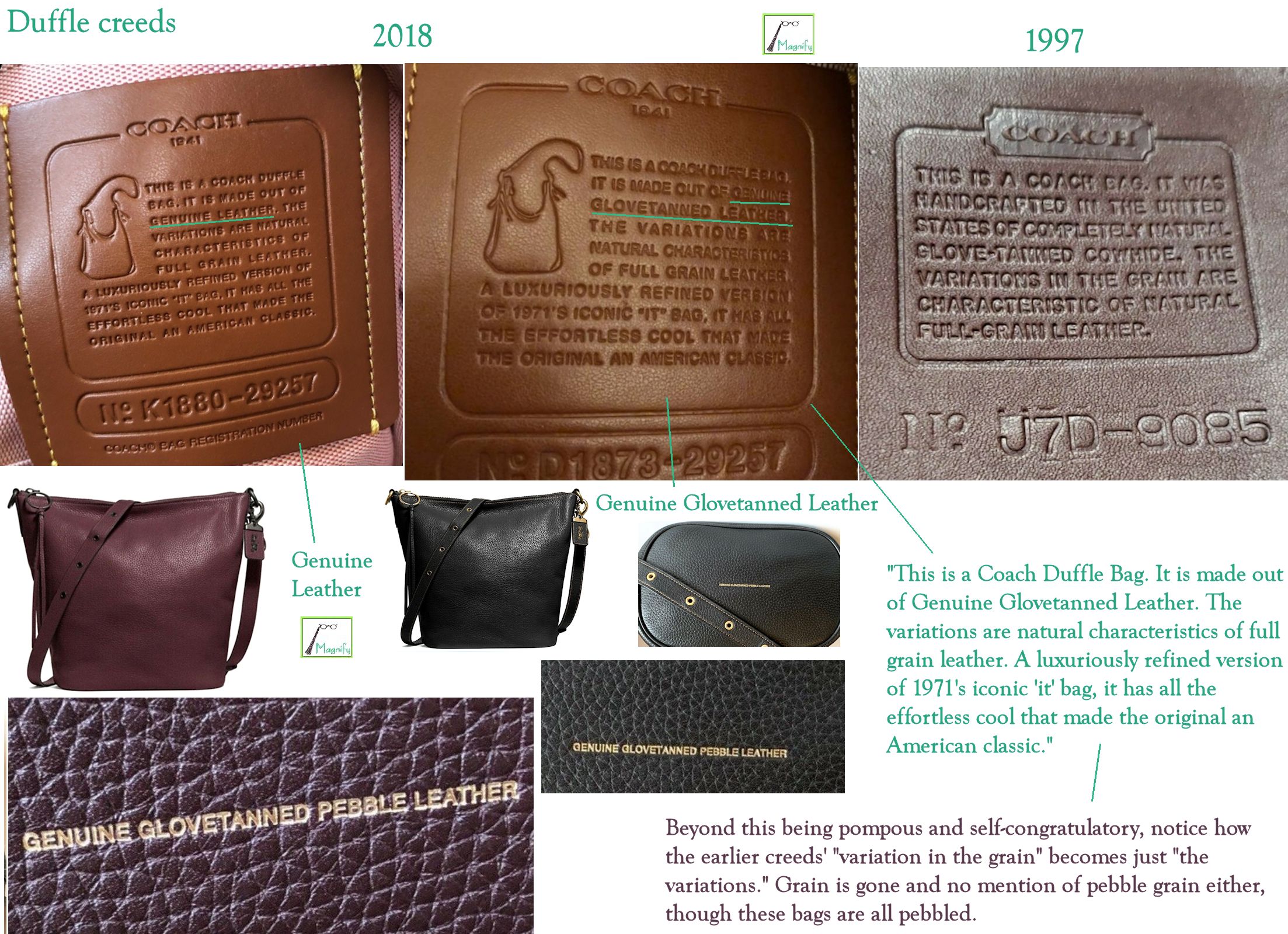
One creed variant (or remember, it's a storypatch now, no quality guarantees involved anymore) says "genuine leather" right above "characteristic of full grain," while another, seemingly more frequent and later, says "genuine glovetanned leather." And all say "Genuine Glovetanned Pebble Leather" printed on the bottom -- so now no one trusts. Pebble-grain glove leather is almost an oxymoron since no baseball gloves were ever made in pebble grain leather, as should be obvious. So while some of these latest duffles could actually be a full grain semi-aniline pebble-grain, not obviously painted over or coated when two of us saw them, these pebbled duffles would be a one-off for current Coach bags, if indeed an occurrence of full-grain and true pebble grain, as we'll see below with a Rogue with identical stamping on the bottom. Since the Legacy duffles of a few years ago, many people have paid particular attention to what happens to other bags in the brief time they've been around and it doesn't look good. Why even bother gambling on a style that (a) doesn't compare with the old duffle/feed sac versions anyway, (b) has an arrogant and foolish pseudo-creed (the idea of an "it" bag didn't exist in 1971) that deprives Bonnie Cashin of all credit for both the duffle and the feed sac, and (c) which can still be found in its original form in the secondary market, generally for a better price than the $450 they were asking. The bottom line is that trust has been shattered.
So let's take a look at what happens when 'genuine glovetanned pebble leather' (oxymoron that it is) is carried for a little while. A quick look at a 2017 Rogue bag in 'melon' removes any doubt about the trade name character of "Glovetanned." The Rogue bag below bears the Hug-it creed with "genuine glovetanned leather," but also goes that further step in having "Genuine Glovetanned Pebble Leather" imprinted on the bottom. We've already seen that "pebble leather" is not "pebble grain" in 99% of cases these days, and never when the word "full-grain" doesn't appear. Instead, "pebble leather" is generally grainless, a faux pebble surface. Like "genuine leather" more generally, it's made from interior sections of split hides that have been machine-stamped with a bumpy pattern and coated in paint, as we'll see clearly below. The use of "genuine" here might seem as brazen, using the earlier Chrysler example, as if Chrysler had said "genuine Corinthian leather," suggesting other manufacturers had been trying to fake 'Corinthian leather.' Which is obviously idiotic when there is no such thing, just a made-up name. (It's worth noting, too, that Chrysler's business was making cars, not leather upholstery. They've been mocked for 40 years over "rich Corinthian leather" and they were not primarily a leather goods manufacturer; the upholstery was just an extra when you bought the car. Looked at in this light, what was once Coach Leatherware now twisting Miles Cahn's innocent original (baseball) glove-tanned branding concept for full-grain into a dodgy trade name obfuscating objectively inferior 'genuine leather' seems...far more egregious.)
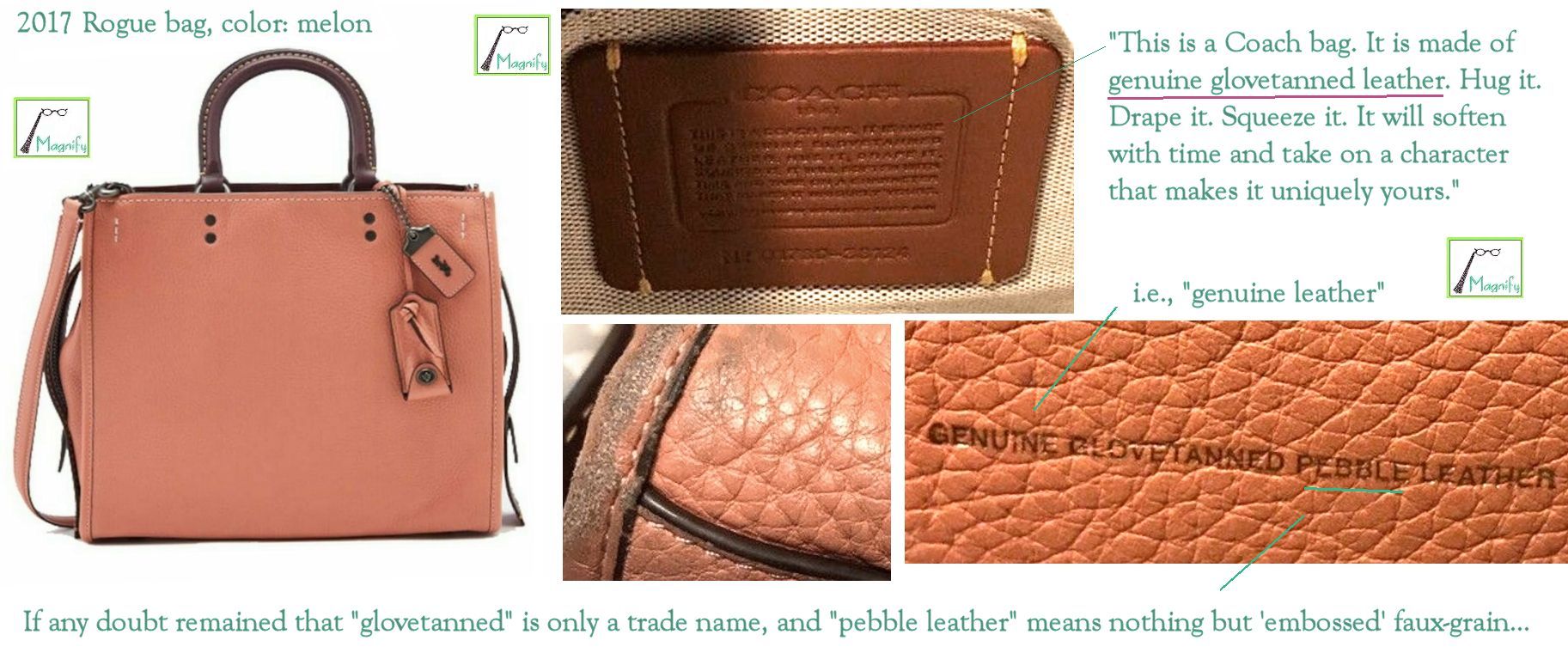
So why are they using the word "genuine" at all? Because the real meaning, with the trade names removed, is simply: "genuine leather." Glovetanned is meaningless as a materials designation, and so is "pebble," referring only to a bumpy surface of some kind, and having nothing to do with the grain, let alone a processing method for durability in full-grain leather. It is, in some real way, a bad joke. And the joke is on the consumer. (If buying this "Rogue" is presented as some kind of individual rebelliousness --a word we hear from new-Coach quite a lot-- one wonders how sycophancy, cowering or simpering obedience might manifest in a bag.)
Let's look at the pore structure --or the lack of it-- on a couple of post-2010 Coach bags, beginning with some irreparable and comparatively very rapid wear that this lack of grain structure makes inevitable, whatever the surface texture. This has happened to countless people in the last several years, but Samantha is still so upset over the state of a recent Phoebe bag, followed by a similar Edie bag, that she can tell you better herself just how the sorry state of these fairly new bags came about.
We're using my recent bags to illustrate the problem with 'made of genuine leather' because I was true believer, and loyal to Coach even after logomania and canvas drove many others away. So I'm basically motivated by anger over the pitiful fate of my poor Phoebe and Edie bags, which didn't even survive infancy. And I feel deprived because I really liked this shape and layout, even trying to replace the Phoebe when it went south with the Turnlock Edie, which has the same basic pocket arrangement. (If you have to carry concealed at work and aren't forced into a shoulder rig at all times this is a great bag design, with the almost hidden large lowslung central zip pocket. I have yet to find any bag better in layout than this, from any maker.) So I'm truly angry that BOTH are crap leather, as my experience shows. I want this bag in good full-grain leather, like an old Coach. If they made that I'd take several in different colors. When buying, I had assumed that's what I was getting, a nice slouchy bag that would be a kind of work horse and break in over time. That wasn't what happened. Now, after the pow-wow that spawned this super-post, I understand why it didn't. And you'll see, too, if you buy the current 'genuine leather' bags...just awful. They really _have_ to do something about this.
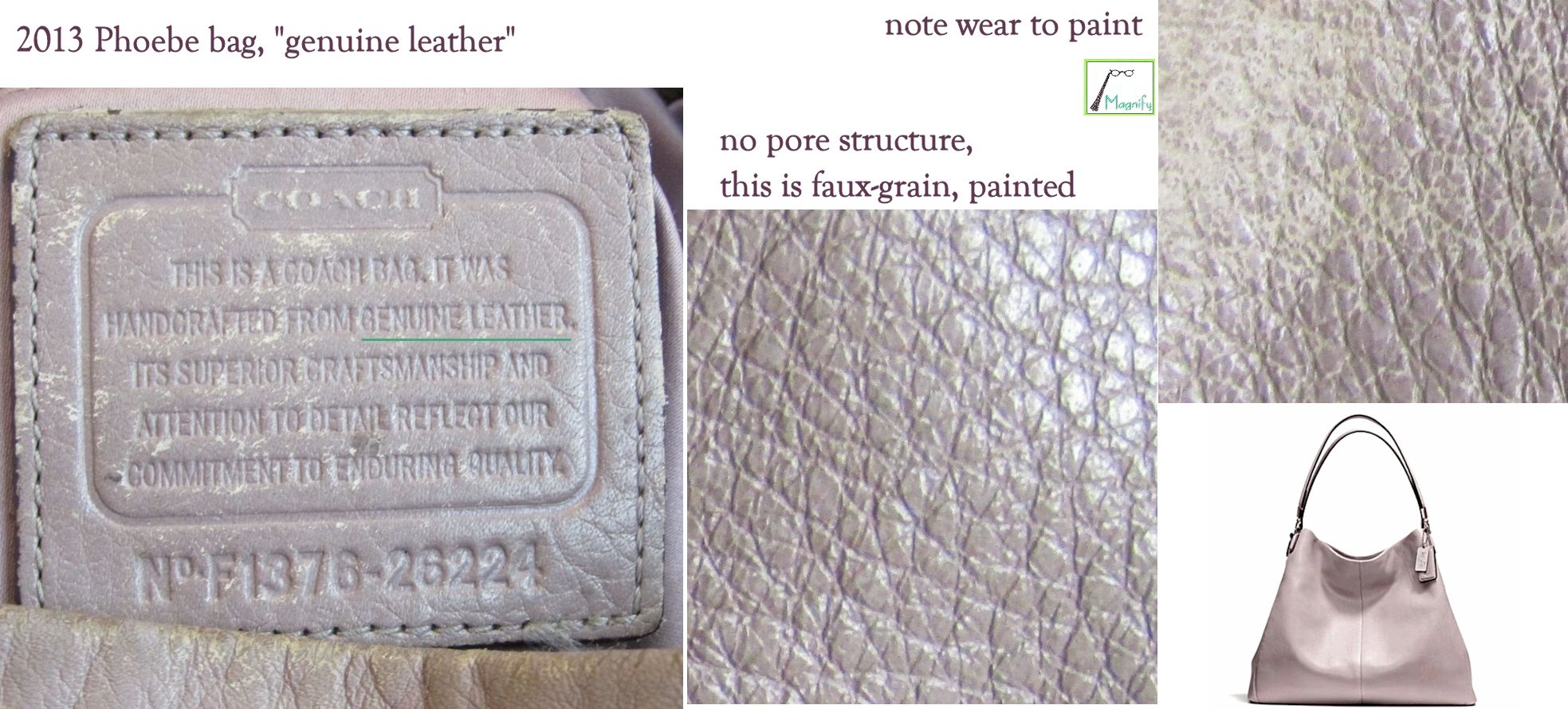
So my poor Madison Phoebe bag. Above we see what a 'genuine leather' faux-grain looks like under magnification. The pores are coated, and they're fake too, stamped in by machines. It looks like plastic because, well, it is. There is a really obvious difference between this and the natural open pore structure on the old Coach bags, which I know now from looking through a magnifier at every one I have. This Phoebe is from 2013, retailed around $300, and apparently it's made of split hides that had a fuzzy suede-like surface, stamped with a fake grain pattern and covered over in reddish grey paint. Look at the way the coating is crazing and flaking even near the ends of the handles (you should see the tops of the handles, plastic trim just peeled right off!), and even on the edges of the pockets it's cracking. Multiple surfaces that aren't even wear points have lost their painted coating, too, including down to the creed patch itself. Now I'm not known to be hard on bags and I have other Coach bags, vintage ones, that I've carried on and off since the age of 13. Those still look fine. I carried this Phoebe about a year and a half, not even daily, and look at it. It's a bad bag. And the leather is why. There's no fixing this, once the paint is off, because it's not just the paint layer that's gone, it took the fake grain print with it. I tried all the usual conditioning things when this started and nothing helped. It's shot. (Now it lives on a hook in the mudroom and holds the kids' winter gloves. Somebody told me Bonnie Cashin designed a bag in the 60s called the "junk sac"...I'm sure she didn't mean it like this!)
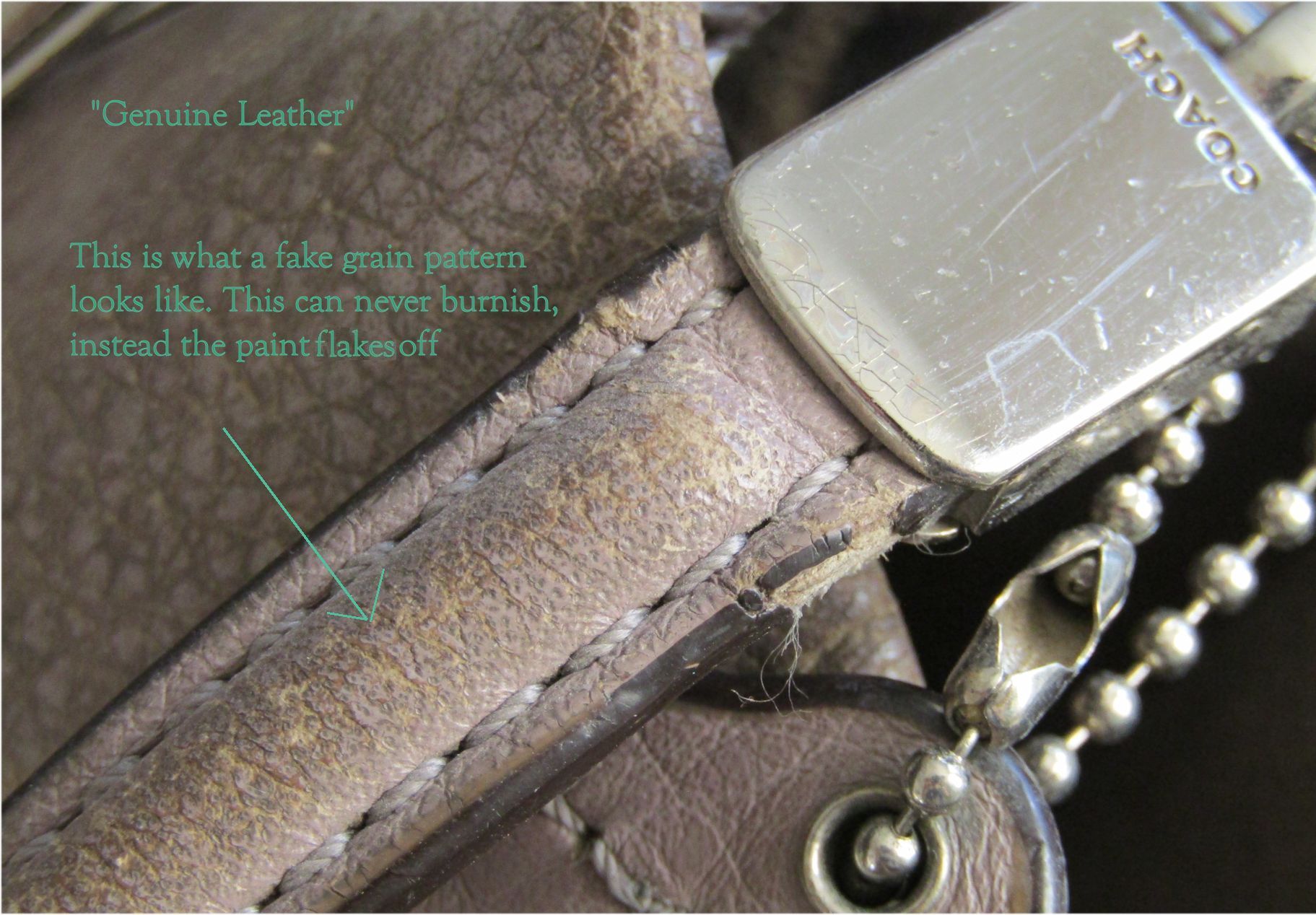
The way the worn areas are tan and sort of nubby, almost fuzzy, where the would-be grain itself is worn away is what makes it clear this was split hides with a stamped pattern, painted. Hopefully you can see this in the enlarged photos. The plastic edging on the straps went first of all, but I figured I must be putting too much pressure on them in slinging it over the shoulder (I blamed myself, tried to rationalize). I snipped off a few pieces of the brown edging that were dangling and tried brown Edge Kote. (Someone else had this idea too, and tried as hard as me. Maybe hers lasted...mine didn't because then new areas of the vinyl edging started peeling up and they took the Edge Kote with them.) So bad, this new strap edging. Same situation with Tandy's Leather Edge Paint, AR64, which is a viscous paint, while the new Coach strap edging is some kind of applied strip of vinyl. Paint it down all you want, but if you intend to hold the bag by the strap, it's temporary at best. And why should we have to go through this anyway??
After the straps, then the bottom corners started looking scruffy. Conditioning it did nothing (which it usually does on a Coach bag). But it couldn't help suede, and that's basically what this bag has under the printed grain and paint. I really didn't expect this at all. No other Coach bag I'd ever had wore out this way -- and that includes several from the mid-2000s. It was so upsetting because I really liked the layout, apparently unique to Coach. Why couldn't Coach make this in Coach leather anymore?
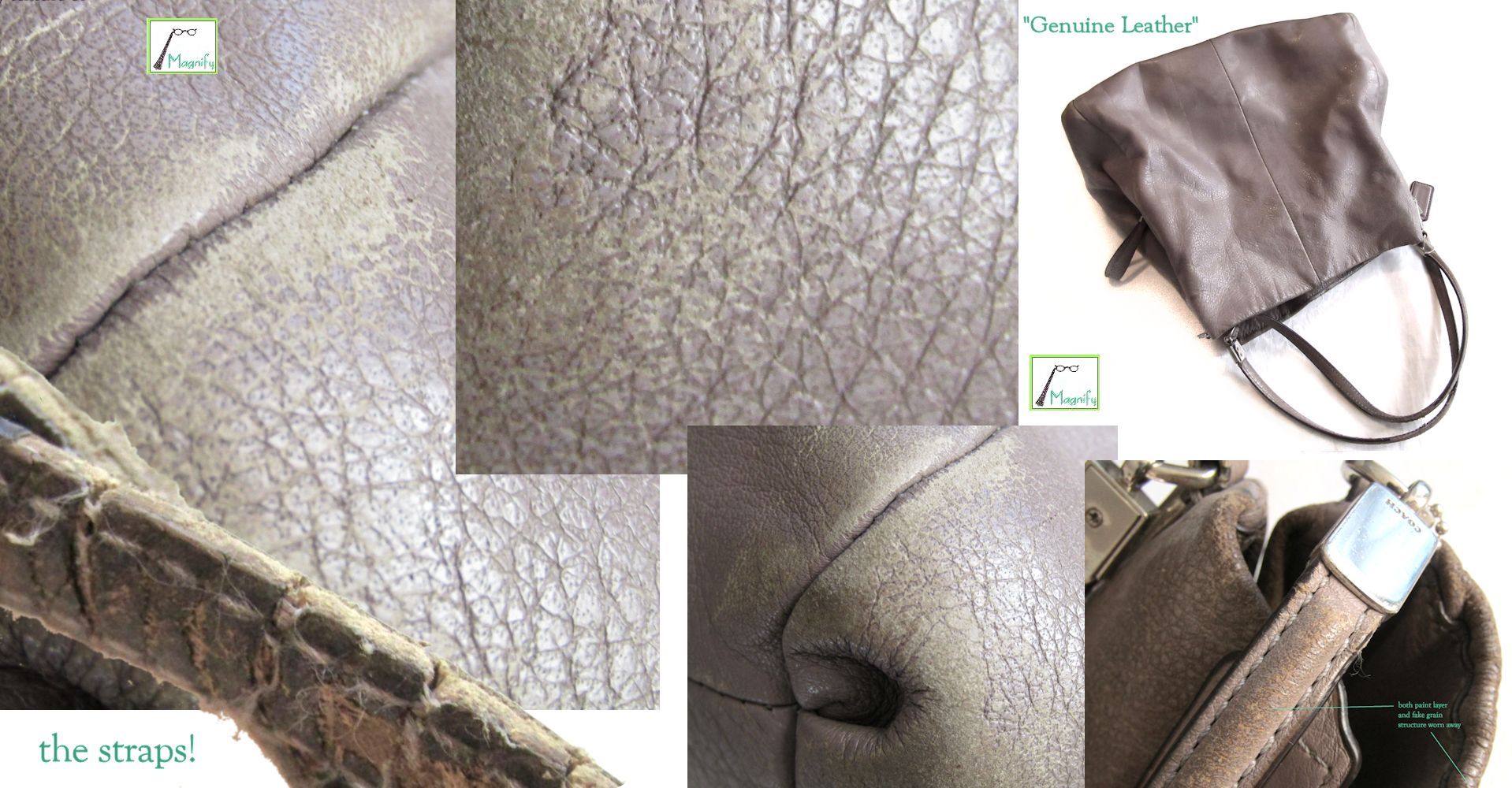
I had figured the Phoebe was a fluke, only noticing the "genuine leather" in the creed after carrying it awhile. (Maybe it was an outlet model or something, I thought, and you don't ask where someone bought your gift, which the Phoebe had been. But no. It turns out the factory outlet bags have an F in the second half of the serial/registration number, which I didn't know then. Apparently this came from a normal Coach store, almost surely in King of Prussia, PA.)
Having assumed I just got a lemon Phoebe somehow, and the shape was so good, a few years later I tried again, thinking the similar Turnlock Edie 31 would be a replacement. (Edie style 36855, basically the next model, same good middle zipped pocket, and just recently vanished from the Coach site to be rechristened as Dalton 31, at $400 to $500, and clearly in the same shitty 'polished pebble' leather.) I think it was 2016 that I got the Edie from the Coach website, it might have been 2017, but just a few years ago -- and that's the last time I'm ever buying anything from there again, unless they chuck this 'genuine leather' rip-off and go back to the _real_ Coach leather. Now this Edie felt a little weirdly rubbery from the day it arrived, which you wouldn't expect from either Coach or a pebble grain. (But now we know about that "polished pebble leather," don't we.) I thought it was just me, being too picky. I did wonder what was going on with the "Made in Vietnam" tag (apparently some Coach bags are made there since 2008), and even more so with the lack of a registration/serial number below the creed. But that was the period when they had eliminated the serial numbers everywhere and there was just the white tag inside the bag's pocket seam, creeds with no numbers for a couple of years there. (They must have had a lot of complaints about that because it seemed everyone totally hated it -- and notice how quickly they brought the serial numbers back onto the patch.)
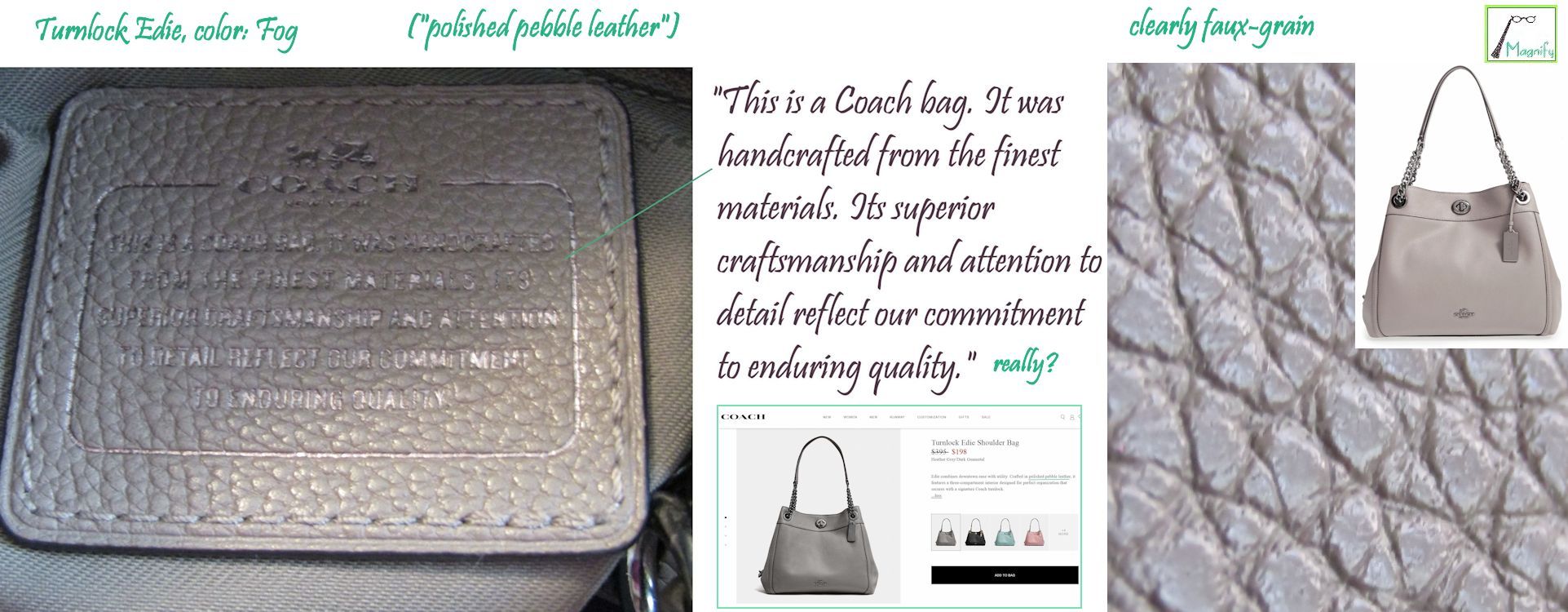
So there's my Edie, and just look at the grain...totally fake. Since using the magnifying glass, now I get why this always felt kind of rubbery. Up close, the thick paint over the fake pebble surface looks like some kind of terrible grey mudslide has oozed down over a bed of rocks...or maybe fake rocks, lol. I have a Coach Dakota bag from the 90s, sort of a shrunken/pebble grain, and it looks nothing like this under magnification, instead you can see the individual open pores on that one. And it's not a durable surface at all, either, like you'd think for pebble grain. Because it's not actually pebble _grain_. There's also a tiny scuff on one side, I think it was from brushing against a wooden fence, but it actually looks ripped up there, from just a light brushing against something. There's no getting rid of it either, forget just rubbing it away like you could with an old Coach pebble grain bag, this is permanent because the finish is just stamped and painted over a suede-like split hide. Another issue is the gunmetal hardware. That surface immediately began to wear off and it's because of basic flawed design -- look at the toggle type bar attachment of the chain handles. _Of course_ that's going to wear the finish off, starting as soon as the bag is moved, when the dark metallic color is only microns thick. And it did wear, like immediately, before even the straps started to go.
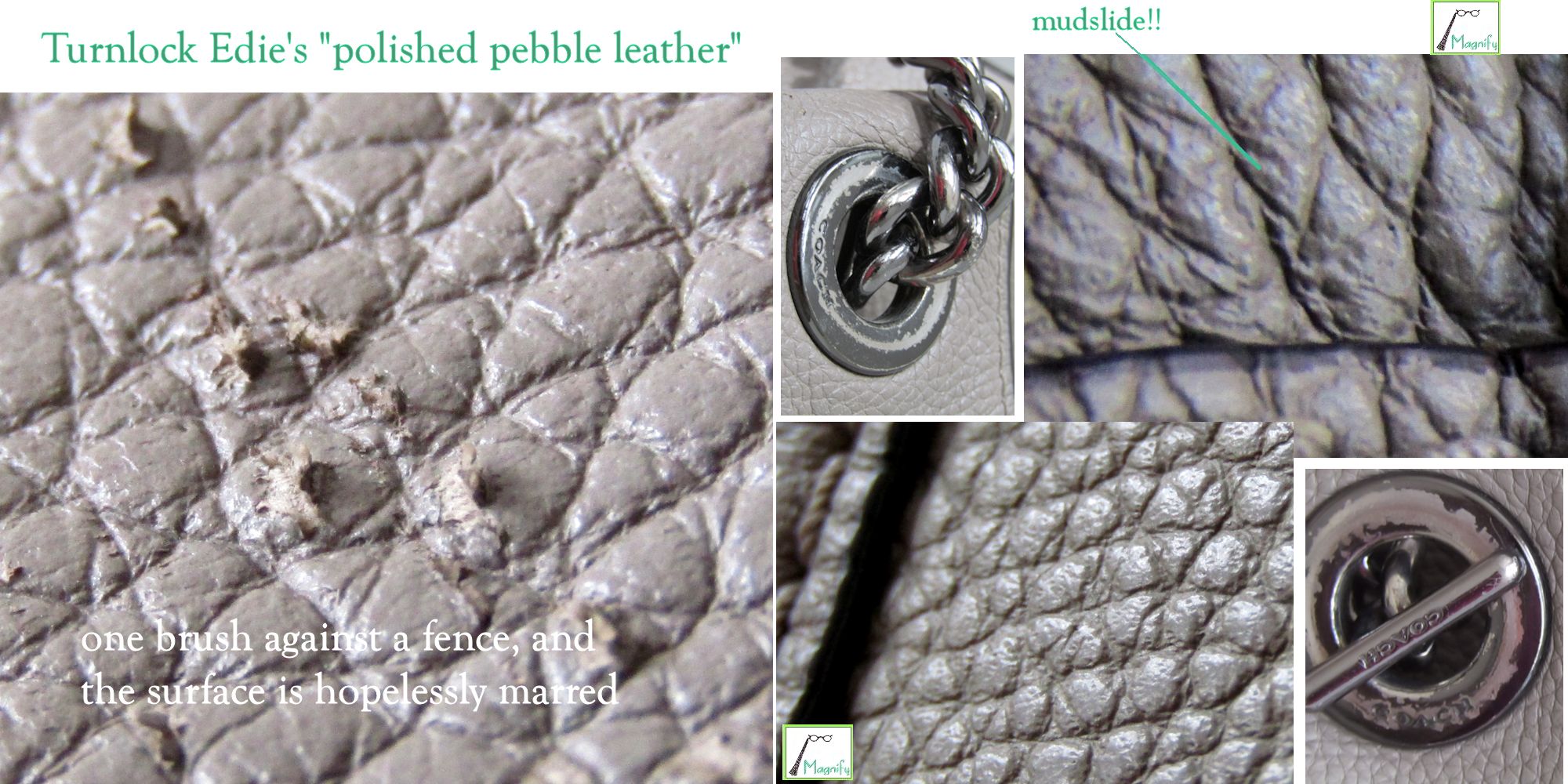
I had only carried this bag for a few months before the straps started to go. It started the same as with the Phoebe, a bit of separation first, some tufts of white string showing...but by then of course I knew what was coming. And just look at the straps now! First the Phoebe, now the Edie. We recently clipped a piece of this brown plastic edging off and burned it to test, and it burned like some kind of smelly plastic. Look how it's not even the old liquid edge paint, but actually a pre-fab strip of vinyl and who knows what else, glued over some white string. (The string seems like a filament, burns like a synthetic, not cotton. I know fabric better than leather and this is probably nylon.) The Edie straps are almost as bad as the Phoebe now and I already know there's no true fixing it, there would only be replacing them. And why bother, when the body of the bag will only go the way of the Phoebe anyway?
This strap-wear problem is something that has affected far too many people, we know it's no 'abuse of the bag' or whatever now. Just carrying it normally by the straps...wrecks the straps. And worse yet, Coach won't fix straps, even under the paltry new one-year warranty. (Try it, you'll see.) It's bad enough that the old free-refurbishment policy is gone, and gone for years. (Apparently that was in force the whole time Coach bags were full-grain full-aniline...at any time you could send your bag back to the factory for free refurbishment and they'd mail it back to you. If we look at old ads, it turns out that repairs were why there was a registration number at all, the reason there were serial/registration numbers in the first place was so you could take advantage of the permanent warranty on the bag.) So now there is a charge for repairs, but even with that, they just won't deal with straps. And why? Because look at how they're made now -- they know they'll give out in under a year, so they exclude them from even a one-year warranty. And when a leather bag can only be expected to last a single year, that's a bad leather bag. It doesn't matter if one year is said to be 'industry standard' now. All we learn from that is that standards have crashed and most leather bags on the market now are inferior to the old ones. And it really didn't have to be this way. I really liked the shape of this Edie bag, but I want it in good materials. And it was about $400, which should get you more than vinyl-edged straps and painted fake grain leather anywhere, but _especially from Coach_.
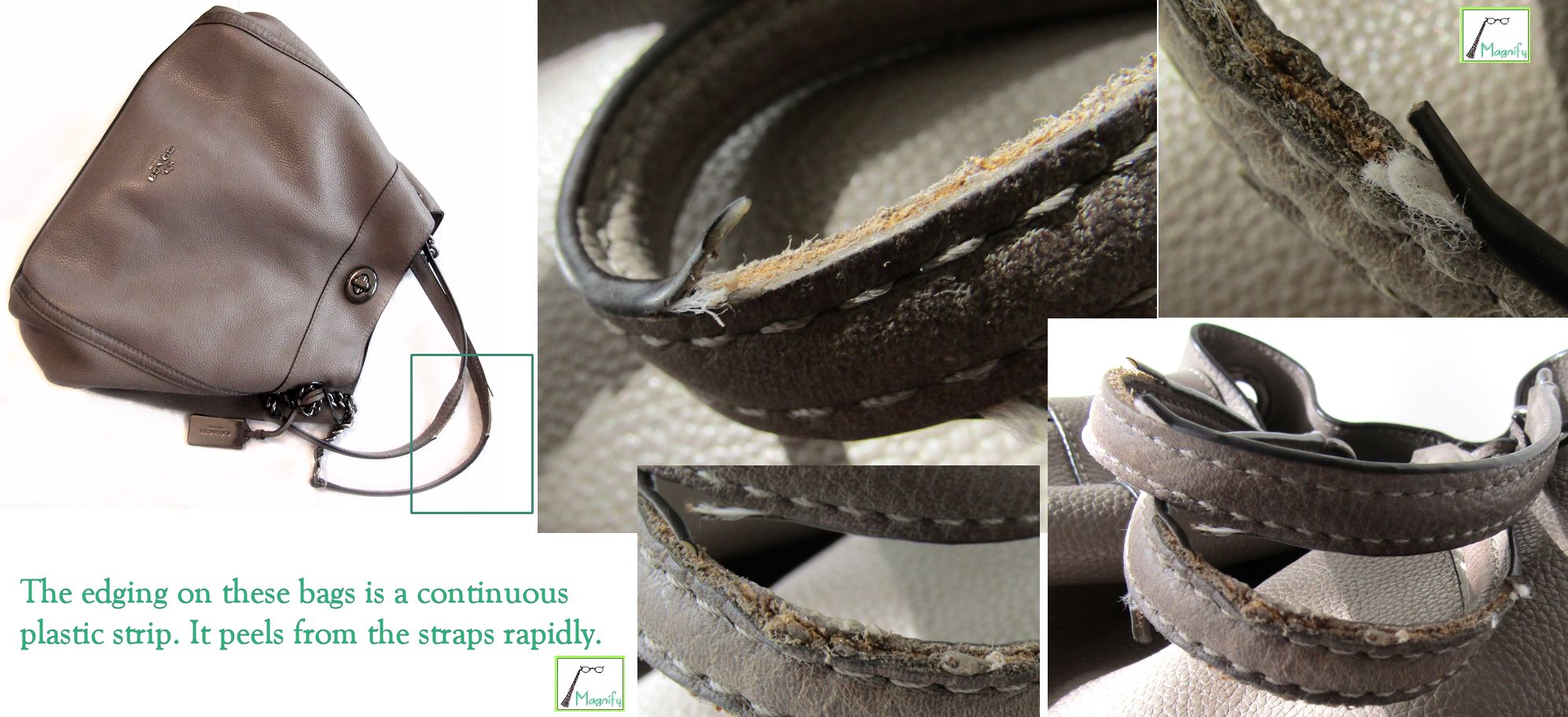
After talking to others who had the same problems, now I really think they're basically gaslighting us on the leather. It's not just us individually, getting lemons. The leather really is crap now compared to what a Coach bag used to be like. I guess I should have realized this from the wording of the then-new creed..."This is a Coach bag. It was handcrafted from the finest materials. [WHAT materials?] Its superior craftsmanship and attention to detail reflect our commitment to enduring quality." If this is "superior craftsmanship," makes you wonder, what could shoddy be like? This is nothing like any previous generation of Coach bag, that's for sure. And what could "enduring quality" even mean, if this is it? If a thing can't endure even a year without wearing out --just look at the close-ups of the straps! it's revolting!-- and the older ones endured for 40 years...SMH.
I feel everyone should be warned about this new Coach, Inc. --not to be trusted on leather anymore!-- and the repro Willis bags are what really made an enemy of me. I've had original Willis bags since high school, some hand-me-downs (because they never wear out) and some rescued from thrift, usually in black or brown, because this kind of high-quality or serious sort of bag just wasn't what (then-blinged out) Coach was doing and you could only get vintage ones. And then in 2011 they claimed to be reviving the classic bags. For those of us already into the vintage bags, it was like someone said "we're getting the band back together!" I saw the new Willis in pink -- I had to have it! And better still that it was almost a true Bonnie Cashin pink, it had the striped lining like old Bonnie bags, and it wasn't in cheezy logo fabric, but was going to be in the old Coach leather. It didn't totally look like a "Willis" exactly, with the rounded shape more like the Logan bag of the late 80s, but I liked it anyway, and you couldn't get the Logans anymore either. Pink sold out fast just about everywhere so I had to travel into the next state to get one in pink -- yes, that kind of crazy, but I really thought, 'they're bringing back the Bonnie bags!' But no, they weren't. So as it stands, there is still only the original vintage Willis in good Coach leather --that is, full-grain aniline dyed-- and everything else is frankly inferior. I wish now I still had my pink 2011 Willis, just for illustration purposes, but it got so scuffed and so ratty so fast that it actually pained me to have it around...eventually I gave it to thrift (who knows what they did with it), because it hurt me to see it in that state. A Coach Willis bag, you call that a Willis?! It was such a disappointment.
How did the Willis start? When the 70th anniversary thing was being launched Coach itself was suggesting the Musette (saddlebag), a Bonnie design from 1969, was the predecessor, but the Station bag (previously called "Shoulder Pouch Large" in catalogs) was around in the mid 1980s and that seems a more direct antecedent. The Beekman briefcase from 1992 also had a dowel but was larger, wider. The first actual Willis, as per Coach's advertising, was in 1993, including the dowel and in the shape that became standard. (The Winnie was a little later and just a smaller version.) If you look at the creeds, where numbering changed to indicate dates in 1994, the bulk of the original Willis bags seem to fall in the late 90s and very early 2000s. It's actually the only Coach bag we know of where full-grain leather, almost as meaty as the 1990s bags, was still in use as late as 2005 or even 2006 (see far right creed image below, appears to be May 2005). It seems the original Willis was made in the US, then in Costa Rica, Dominican Republic, even Turkey (not too common for Coach), and finally, 2001 - c. 2006, in China.
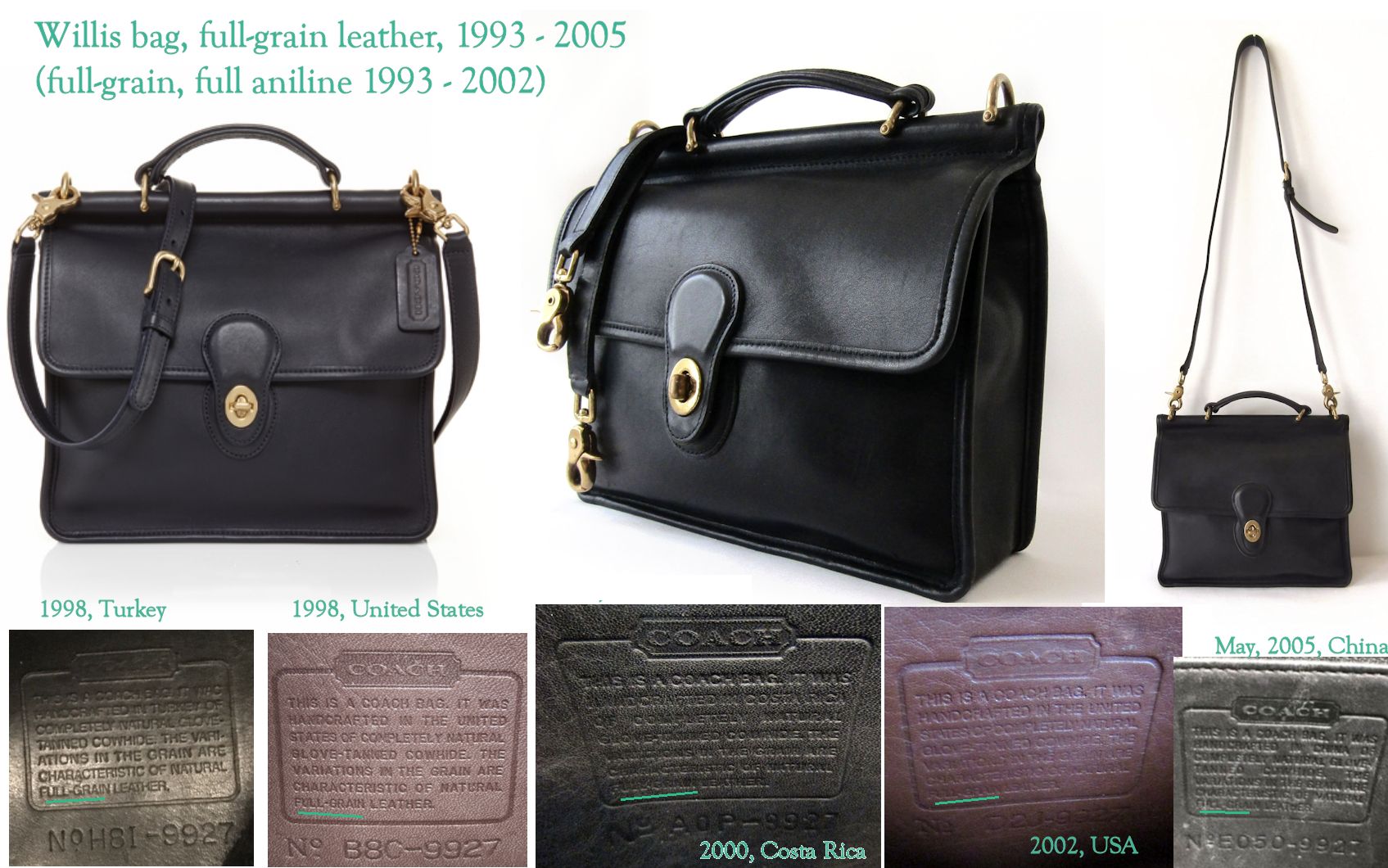
The original Willis is a heavy grade of full-grain, full aniline leather. The hardware is solid brass and the dowel is wood. An important point is that the brass horse-bit shaped rings for both crossbody strap and top handle actually pierce the wooden dowel for strength. Beyond the grade of the leather, this is a big reason these bags don't wear out. The interiors are natural suede, creed stamped directly into inner zippered leather pocket, and there's a full-length pocket on the back. An original Willis is squarer and slightly larger than the 2011 first repro, but that's hardly the most significant difference. The most serious problem with the 2011-2012 models was that they were "genuine leather" -- not full-grain, and they wore out like painted faux-grain hides do. This is why I was so stricken by the short lifespan of my pink 'anniversary' Willis.
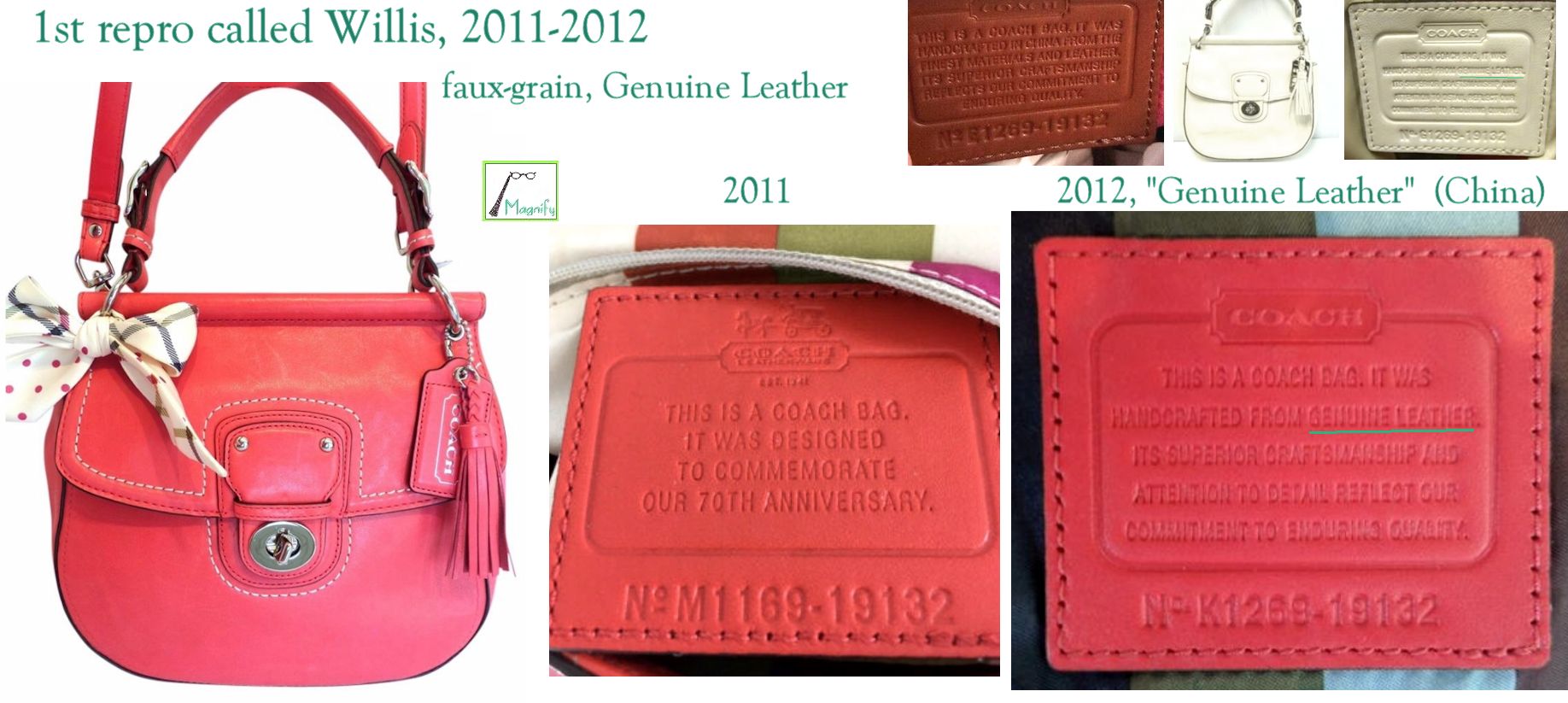
The bad grade of leather wasn't the only problem with the first repro in 2011, though. The attachment of the strap on the same weirdly large and cumbersome ring as the top handle was a great annoyance. And neither strap nor handle pierced the dowel, so it just felt flimsy. The top handle was also an awkward length, too long for a top handle and too short for anything else, and yet there was no removing it, so it just stayed there and flopped around, taking up space on the single ring and getting in the way of the attachment of the longer strap. It was just a bad design. The leather was also very thin and flimsy, especially if you were expecting an original Willis, with a stiffness that was really not worthy of Coach. And I had so wanted to love this bag, seriously. Instead it was just...depressing. If it had been made to the standards of the original, I'd probably still be carrying it sometimes today because I still like the shape and the striped lining. But it was 'genuine leather,' so it's gone. I've heard the doctor's bag/Madison satchel was at some point made in actual full-grain leather in 2011-2, as a special edition, but I don't like that shape, and none of the other 'classic' bags from that period that I've ever seen (the dinkys, the buckets, etc.) were real old Coach leather. Just "genuine leather" or some kind of vague hyperbole on the creeds. I've never looked at newer Coach bags the same way again since...the pink betrayal.
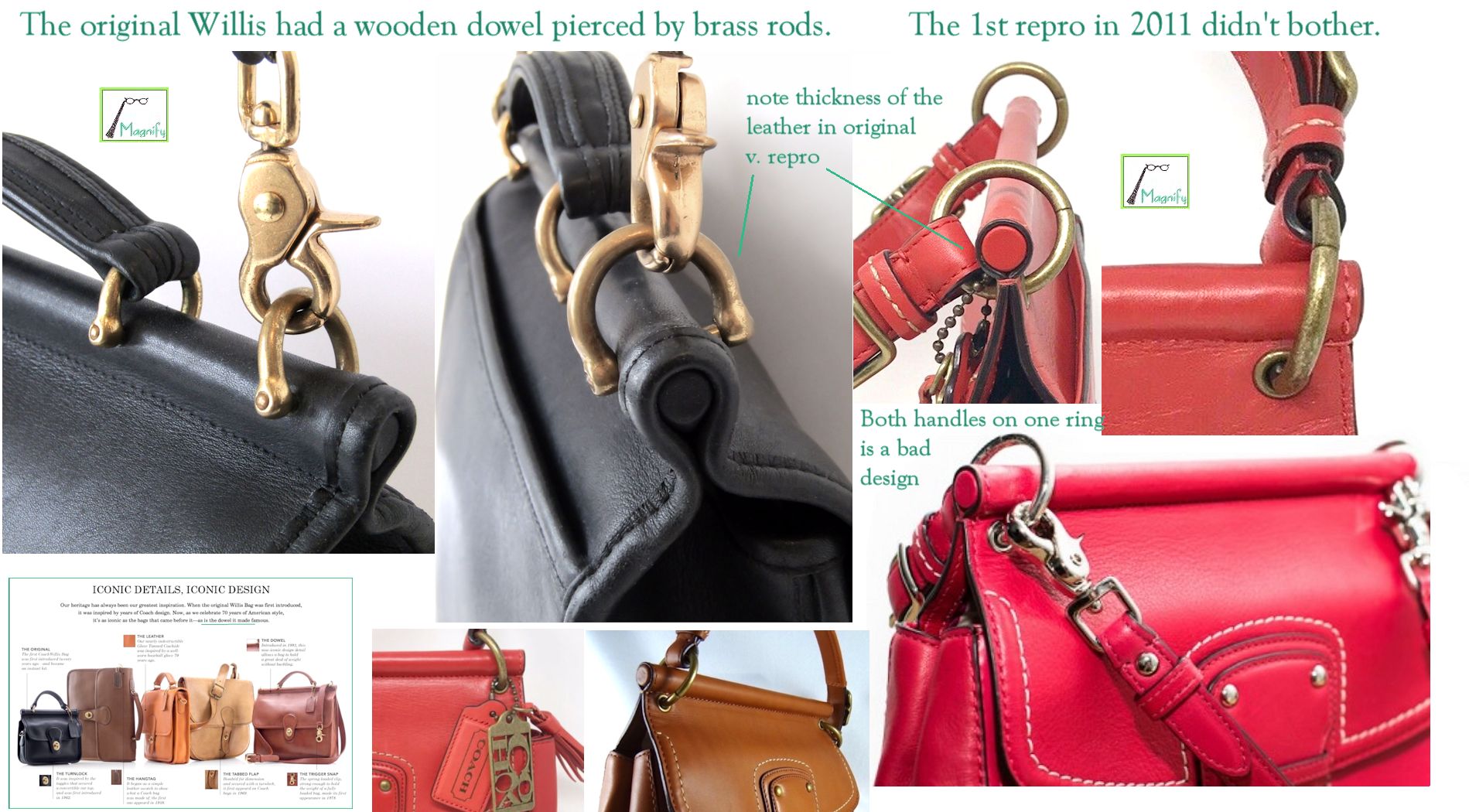
So I returned to my old Willis bags in subdued colors, which I still have, and carry when the mood strikes. Nobody makes a better floppy kind of leather bag than old Coach, even in this structured style (an old Willis easily sits up on its own, it holds its shape even though it's soft to hold, because the leather is so thick). I retrieve the old ones whenever I see a good one in the wild and try to rehome them because, thanks to Tapestry Inc., you just can't get this kind of leather bag anymore. And then I heard they were bringing out an "archival" Willis -- again. Obviously this time I knew better than to get excited. But I was still unprepared for the true wretchedness of the 2019 Willis. In every particular I find this bag almost an insult to the thing it claims to be reviving. At least the 2011 shape was cute and the colors were generally interesting. The 2019 version seems like a child's drawing of a handbag, and doesn't look minimalist so much as just cheap. First, there is the bag-specific creed, with the now-standard duplicity of "genuine glovetanned leather" -- which really means 'genuine leather,' as we've seen. And there is a puffed up arrogance in the idea of something from the 90s being "archival" anyway. If I hear the word "icon" or "iconic" one more time from the posers now running Coach....
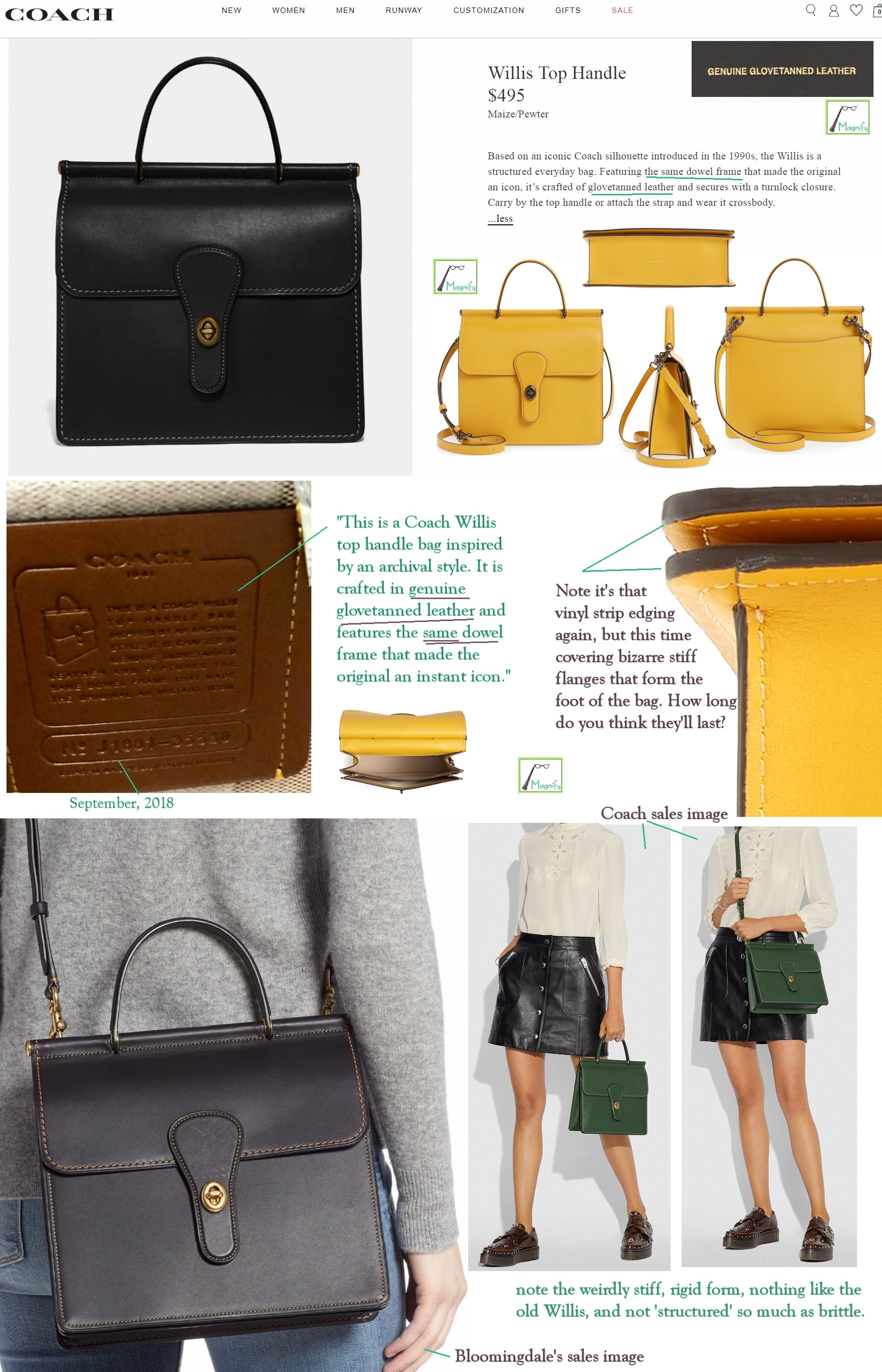
Then there's the shape of the bag (box would be a better word) itself. So rigid, so stiff, and with truly ludicrous bottom flanges that are nothing less than made to fail. (Note that plastic edging...no wonder these things are out of warranty within a year.) And if I thought the problems with the rings not piercing the dowel were bad in 2011, the flimsy little leather loops on the back of the 2019 bag are shockingly lame. It makes the wording of the ads and the creed/'storypatch' about "the same dowel" seem laughable. Are they kidding? The advertising photos above come from the Coach site, Nordstrom's and one from Bloomingdale's. If this is the best they can get that thing to look, it's not saying much for it. There is a cartoon quality about this repro, almost like a stage prop ('we need a handbag? ok, I've got some cardboard and we'll paint it'), especially when compared with the original.
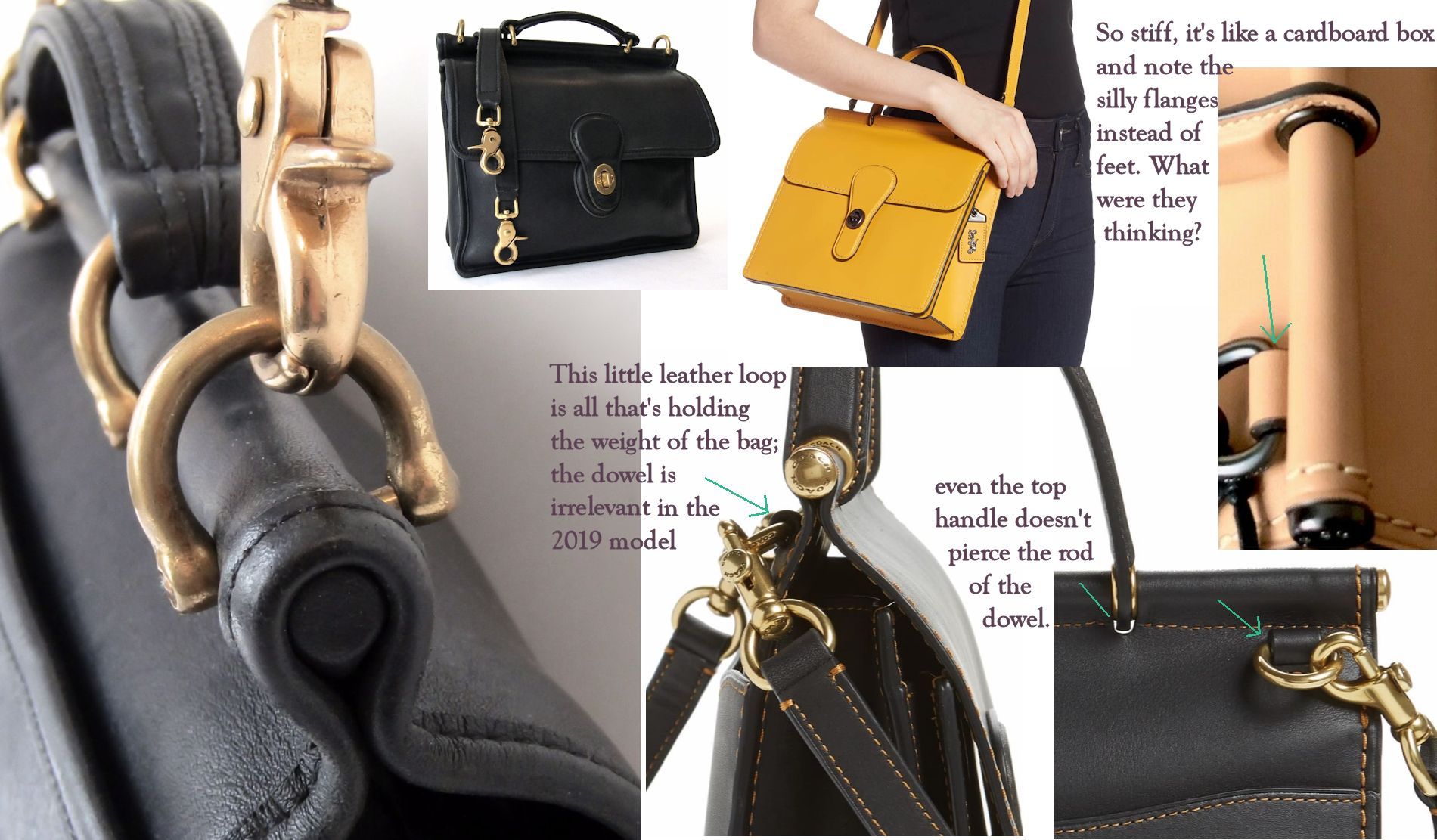
Overall, this 2018-2019 Willis is literally the worst repro design of any Coach bag I've seen for years. It's uncomfortable, almost brittle in texture (Bonnie would have loathed it, I feel sure), the lining is chintzy, the attachment of the crossbody strap with flimsy loops behind the dowel is a joke, and the weird protruding flanges trimmed in plastic pretty much guarantee these bags, if they are carried at all, will be heading off to a landfill by 2020. Anyone considering it, I would say benefit by my depressing experience with the 2011 version, which I was fully prepared to love -- but the design was bad and the leather was worse. These new things just aren't Coach bags anymore, it's as simple as that. Will they do anything about that? Probably not, but certainly not if we remain tolerant of things like this as a Willis bag.
The double frame pouch, first produced in the mid to late 1960s but just revived in 2018-2019, including appearing frequently in Coach's 2019/2020 runway shows, is actually the bag that launched this Screed. And a large part of the reason for that, beyond the senselessly diminished leather quality of the modern renditions as compared with the originals, is the advice we've received from Dottie, one of the original Coach customers, who bought the red frame pouch below in about 1966 or 1967. Her advice: "Honey, warn those young girls, those scraptrash bags are junk. Terrible! And they've dressed those poor models like clowns. Lil [Lillian Cahn] never would have put her name anywhere near that stuff." And how does she know? Because she remembers that, decades before Coach was born, even as a girl Lillian always knew style, and that it was dependent in large measure on materials and their relationship to each other. She actually had a remarkable innate ability with this, in making things seem more than the sum of their parts, which is why she was responsible for many improvements to costume design with the high school drama club. But even before that, Lillian was known among her friends for being able to "turn chaff into wheat," often on a budget of zero, just by rearranging elements into something unexpected but completely harmonious. Dottie thinks this ability --which all her friends were aware of to some degree-- is actually a deeper reason that Coach bags came out so well. "Scraptrash" never would have flown.
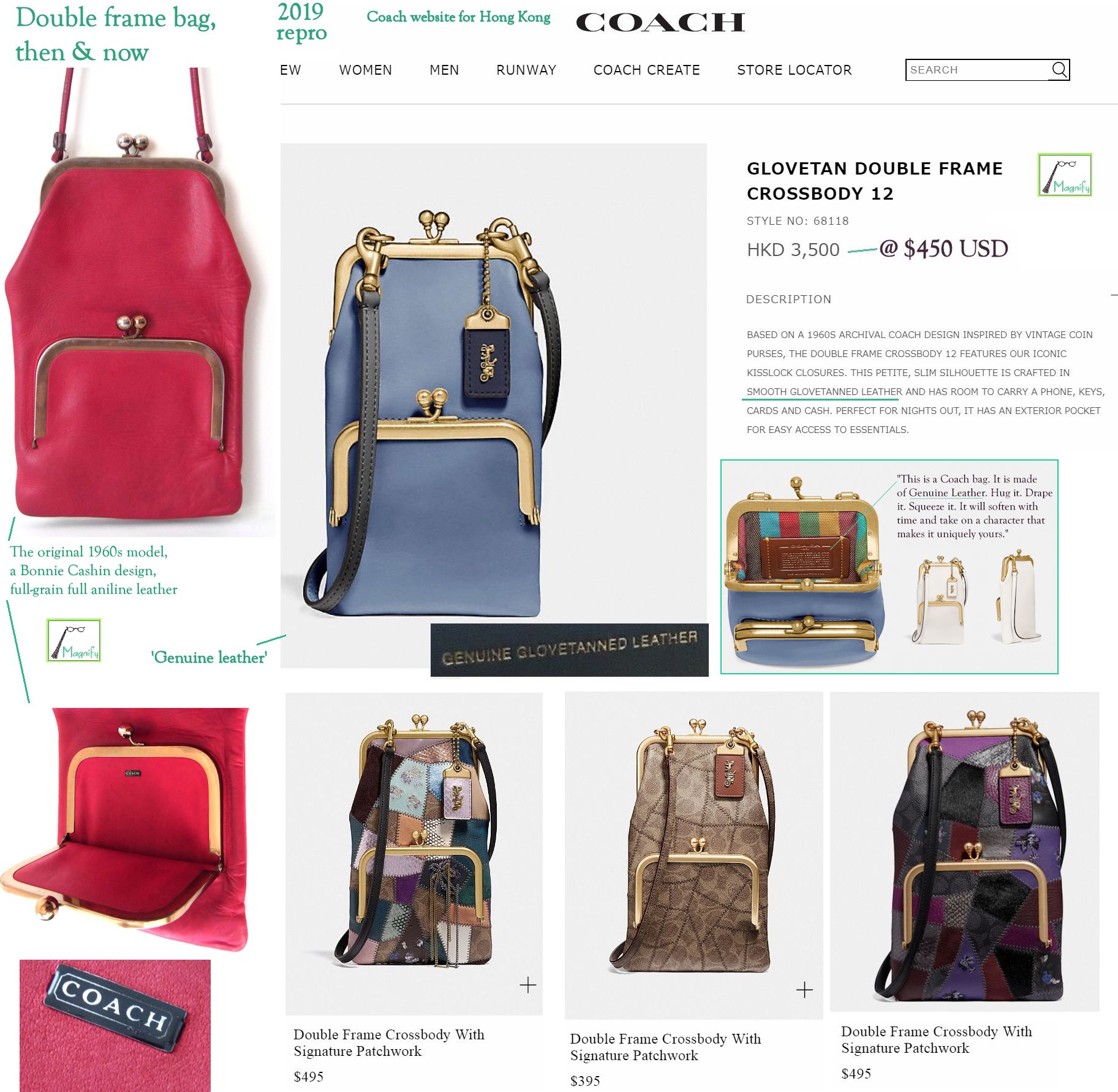
Dottie bought the red Coach double frame pouch, above left, in a department store in Philadelphia, department stores on the East Coast being the only place Coach bags were sold at the time. She thinks it probably had the old baseball swatch tag, but those were meant to be removed, same as the store's paper tags tied on with string. There were no actual Coach stores in the 60s, and no one really knew or recognized them as a brand yet, per se, though Bonnie Cashin was famous and the general feeling was that if Bonnie Cashin was designing for them, it had to be modern and would be sort of free-spirited. And the bags were. She thinks she got this one at Strawbridge & Clothier downtown, but it could have been Bloomingdales, which was a good store then, but only recently arrived in Philadelphia and not in the price class of a Nan Duskin's or a Bonwitt Teller, etc., as Coach bags weren't 'trying to be snooty' then, but rather just a sort of post-beatnik modern woman's fun yet functional bag. She doesn't remember what it cost, but it was the smaller of a few models, and it was clear even then that Coach bags were different and of a better quality than the typical bags you saw around then. (Dottie says she felt at the time that she might be 'too old' for a bright red shoulder pouch, being in her mid 40s at the time, but she didn't care, as she liked the convenient front kisslock design for the new business cards she had just gotten --women usually didn't have their own cards back then-- and red was always her color.)
It was the Johnson years, and she thinks 1967 but definitely before 1968, because she had this bag at a gathering in Center City protesting the Vietnam War and she remembers a recording of MLK was being broadcast to the crowd (he had just spoken at a local campus, it was before the assassination in April of '68). And as everyone was standing, listening, a hand came from behind and began to pull this bag from her, even though she was wearing it mostly under her jacket because of the press of the crowd. (This is why she remembers the events distinctly -- an attempted purse-snatching!) So Dottie and the hand had a tug of war over this bag and, finally, she was able to turn around and see the guy. When yelling at him did nothing and he still wouldn't let go, "instinct took over" and she hit him in the head with an open bottle of orange soda she was holding. Twice! Apparently they were some heavy glass bottles back then because it came nowhere near breaking but just gave him "a good thwop!" The would-be purse-snatcher let go after being bonked, staggered back, and instantly disappeared into the crowd -- obviously without this little red bag. Dottie was covered in orange soda, and her suede jacket basically ruined, but the little red bag was fine, and the thin strap held, too, not harmed by the tug of war and clearly much stronger than it looks. Coach bags were always good leather then, so she just wiped it off with a damp cloth at home, and it was none the worse for what it had been through. Dottie carried this bag many times, but this was definitely the most extreme experience it ever had.
If we look at the construction of this red bag, the use of good full-grain leather is immediately apparent, and it's important in a design like this because the leather body of the bag must flex in unusual ways on account of the double metal-framed pockets. This style, as far as we know, never originally came with a fabric lining, and this need to flex while in use is very likely why, as other Bonnie Cashin bags did have linings, when the sides were straighter and the bottoms flat. But in a pouch of this shape, when full and holding weight, any fabric lining would tend to separate or pull away from the frame. Dottie credits its good shape today in part to the unlined natural suede interior, obviously through-dyed with aniline red, and sturdier over long use than any fabric would have been. The inner lining of the front kisslock pocket is also an unusually nice smooth leather of the same color, a blue-based red, and this lining is interesting, inside the front pocket, because not only can we see the obvious open pore structure characteristic of aniline dyed full-grain leather, but the particular cowhide used here happened to bear a very faint scar. Looking closely you can see that this is healed, a sure sign that the surface is completely natural, which can be seen from the pore structure around this little scratch (magnify image below for a close-up). The size of the bag is about 11.5" from top kisslock clasp by 7" wide with a 17" drop.
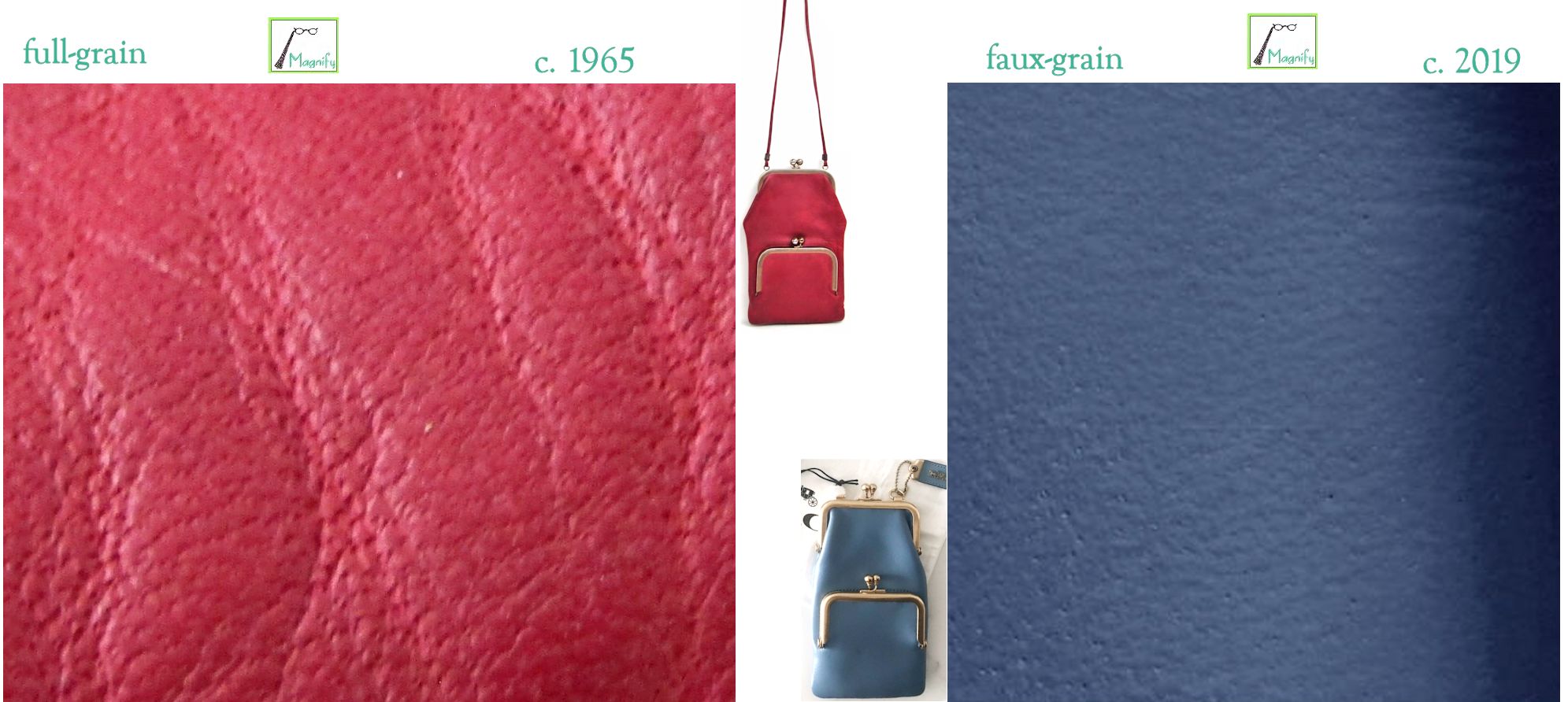
Now this red pouch was carried over a long period of time, on and off, and 50+ years later, it still looks fine. The corners are sound, no color loss or wear-through, the frames snap shut as they always did, and even the tubular cord is stronger than it looks, as shown by the attempted snatching back in the 60s. If we compare this older red bag with the modern versions, immediately problems arise. In solid colors, they have reproduced the basic shape now in slate blue and white. (No credit for it given to Bonnie Cashin, either, as usual these days.) The new versions are all "genuine leather," which means faux-grain, split hides painted over and covered with a plasticized layer, which can be seen close up. (The muddy painted look and lack of real pore structure should, we hope, be visible in the magnified images above --and that includes in stock 'beautified' sales images generated by the new Coach company.) We also find the disingenuous new 'hug-it' creed inside, still advocating leather alchemy on 'genuine leather,' a striped synthetic fabric (polyester?) lining that seems a sorry substitute for Bonnie Cashin's old striped madras cloth, and a strangely awkward and stiff creed/"storypatch" plaque sewn in a very obnoxious location, and sure to snag things when you try to put them in the bag. (It's another 'what were they thinking?' feature. And the answer seems to be, they weren't thinking, at least, not of the user.) Finally, and possibly most ridiculous of all, is the "GENUINE GLOVETANNED LEATHER" surface printed on the lower back of the bag, yet deliberately and strategically hidden by the strap in all the stock advertising photos. As we've seen, this translates realistically into "genuine leather," which is hardly something to brag about. And it looks especially bad and jarring just stamped onto the lower back, which is probably why they hid it. Overall, it's a sad come down from the original version in so many ways, and for no good reason other than what appears to be...avarice.
But wait, it gets worse. Not content to remake the double frame kisslock pouch in a degraded form of smooth 'genuine leather,' they went that further mile into something Dottie calls "scraptrash," and rightly so. This is what used to be done with remnants left over from other things, just to use up what amounted to trash or detritus, as a way to wring every last cent out of a bolt of material. And in this case, both grandmothers and quilts are insulted ("Not your grandmother's patchwork"), while a mixture of debris taking in lowly grades of printed leather and scraps of canvas are machine-stitched together --in stock patterns, mind you, none is unique-- and retailed for $500 for a small bag like this.
Dottie's great-granddaughter (she's an adoptive-grandmother to the rest of us) happened to see images from Coach's recent runway show on the Vogue website (see screen captures below) and recognized that little red bag, which she had borrowed before. And when she showed Dottie the scraptrash bags in the same shape, including with spiky stupidities as 'bag charms' hanging from them, we won't say all hell broke loose, but it wasn't good. Dottie immediately thought of Lillian, gone for several years now, and became, in her words, "almost vengeful." She feels it's a betrayal of the memory of a woman, and her company, who revolutionized not just handbags, but why and how people would carry bags, too. There was a respect for women then and Coach was unusual in that. There was a concern for what women needed their bags to do, which was shared by Bonnie Cashin, and that was why the Cahns held out for her as the only designer they wanted for their original handbag line. The new Coach Inc. in general flies in the face of all of this, but in no instance more gratuitously than with the scraptrash frame bags. Dottie feels they're a slap in every way, and young women need to know the truth about the real history and significance of this brand, specifically its significance for women. Thus, the Screed was born, in an effort to record and consolidate in one place everything the old-school, original Coachistas knew about these bags. It's a work in progress, bits of it still scattered across FB, emails, and message boards even now, but Dottie --and all of us really-- feels that if any of the background on real Coach bags saves just one young girl somewhere from the sad disappointment of an overpriced and qualitatively poor scraptrash bag, or alerts her to someone like Lillian's story of survival and eventual triumph, it's all worth it.
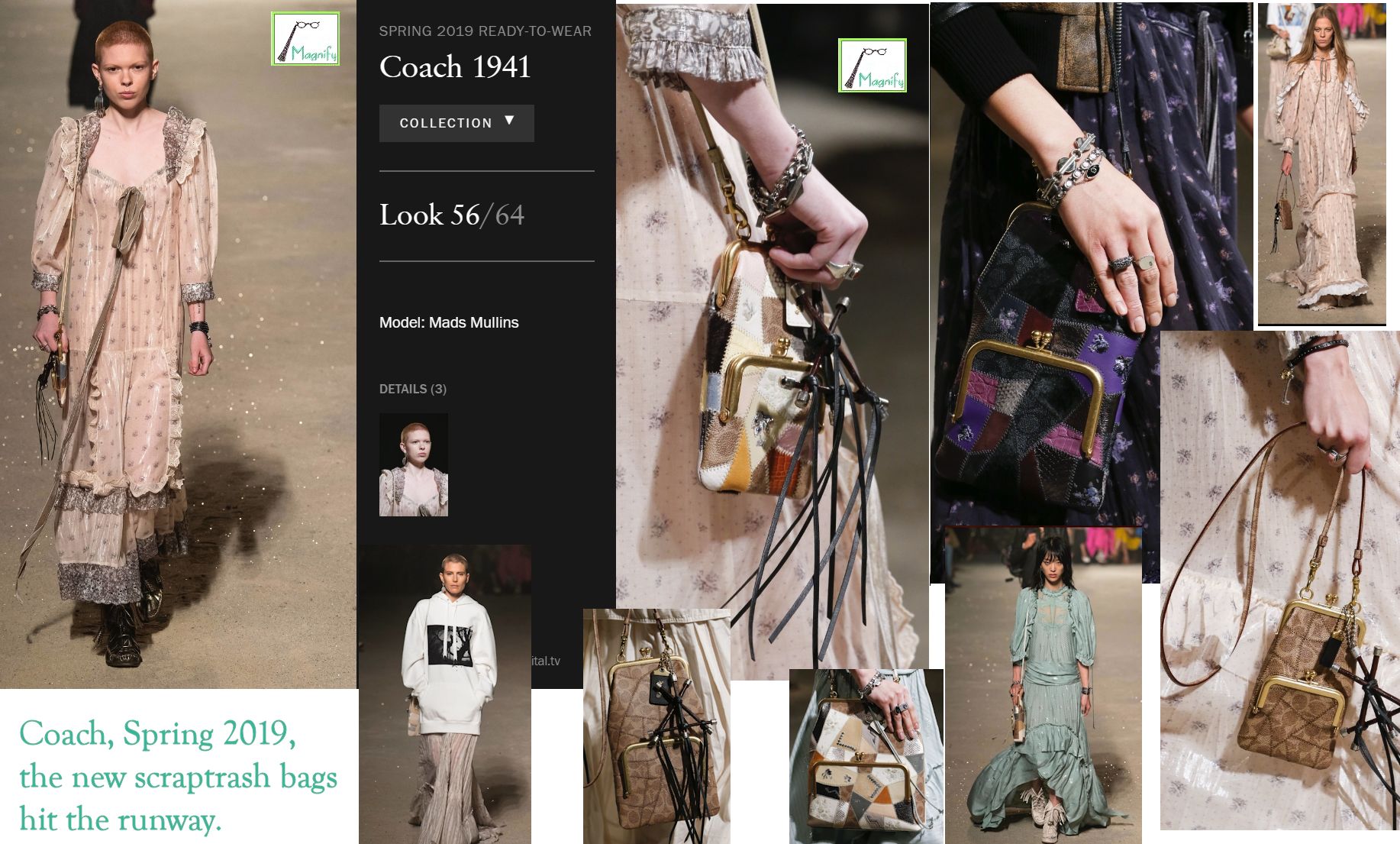
It was years after buying this little red bag that Dottie realized Lillian Cahn was Lil Lenovitz, from Wilkes Barre, after she came across an article somewhere about the Cahns' open opposition to the war in Vietnam, and Miles and Lillian were pictured. (Lillian still looked so young and vibrant that someone she hadn't seen in decades immediately recognized her!) After that point, Dottie took a greater interest in Coach, just because the bags really were better than others, and she was so happy that Lil's talents were being recognized by a wider public. Her memories of Lillian are that she was very bright, but just sweet-natured too. She would tutor other students just to be helpful, was always a lot of fun, and was even very kind to Dottie's then-pesky little brother, who was much younger and had an obsessive crush on her, as did "droves" of boys. Lillian was always a very pretty girl, but she also had that innate fashion sense, including under limited resources. Their group eventually lost touch, most leaving town right after school to find work, and of course there was no Facebook back then, when people didn't even really have telephones. (Like no phones at all, no landlines to normal households, and long distance was seriously expensive.) There were some letters at first, then just cards, but unless you happened to run into someone while you were both home on a visit to family, people dispersed and you might never know where life had taken them.
Thus such was Dottie's happy surprise to realize that Lillian Cahn, the force behind Coach bags, was actually her Lil, still in New York and really "moving and shaking" there. And immediately she remembered how their little group of girls would sit around the big table at their friend Libby's house, having rounded up all the fashion magazines they could from mothers or older sisters (they weren't so easy to come by back then, and there was no TV either). They'd divide them up at random and each girl would carefully cut out pictures of starlets and the latest styles, to paste into collages of different looks or themes, kind of like a hands-on Pinterest. And Lillian's collages were always highly superior, especially when magazines with pictures in color were available. Though she'd always praise others' efforts instead, this is really how she first became the group's 'style guru,' such that even older girls would sometimes ask her advice before deciding how to dress for an important date or other event.
Even as a teenager Lillian was able to make-over just about anybody by simple restylings of hair or adding a belt, and she did this a lot, because she wanted her girlfriends to look good so that they would feel good about themselves. This was a real issue then because everybody was poor and you got negatively judged, and potentially treated very badly, directly based on what you wore and how you wore it. Looking 'poor' meant being perceived as weak and the other kids (especially the native English speakers) could be vicious. As a small child Dottie had been called "Schnoz" and "Four Eyes" as 'nicknames' for months before she figured out exactly what it meant in English and how degrading this was. (Before that, she had been proud of her glasses, because the family had to save to afford them.) As a result, she became convinced early that she was "just ugly" and almost never wore her glasses, being ashamed of them, and feeling sure they made her nose "look even bigger." Who changed her mind? It was Lil, after Dottie had tripped and fell over a tree root (again) because she couldn't see it without the glasses. When she confessed that she needed glasses, but couldn't wear them in public because they "made [her] too ugly," Lillian said that was crazy and the glasses must be a terrible shape if they could do that. She'd have to find better ones. It had never occurred to Dottie before that size or shape of frame could make any difference at all. For a couple of weeks she made mock frames from wire and it was true, the size really was the problem, because she was wearing frames from years ago, child size, and in the wrong shape, too. The very first thing Dottie bought for herself with her own money from an after-school job was new glasses. And the person who changed her mind about how to see the world through those glasses was Lil. She had convinced her that it was wrong to put how others see you over and above how well you see, and how you see yourself. These were new ideas to Dottie, and she began to look at her former tormentors in a new light. She decided to trust her own perception, and to make sure that it was as clear as possible, before worrying about how others were perceiving her. And she grew more confident after that. Lillian was a born leader with such charisma that her confidence actually rubbed off on those around her, including Dottie. She influenced her friends to feel that even poor Jewish immigrant girls like them could do anything they put their minds to, no matter what anybody else said. Dottie never forgot it.
It really was always felt in their group that Lil was going to be somebody and would do something creative and important one day -- and that feeling was right! None of us would have any Coach bags now without one determined woman: Lillian Lenovitz Cahn. Dottie feels the young women of today deserve to know about her, and they deserve better bags than what the current leadership of what was once Lillian's company think we deserve. If we value the bags that the original Coach gave us, we owe it to the Cahns to demand more from Coach now. Dottie feels we owe it to Lillian in particular --the mother of the Coach bag-- who had been encouraging young girls to have confidence in themselves since she was just a girl herself.
Now think again of the recent 'govetanned/hug-it' Rogue bags, the retail price of which is just shy of $1000 USD for 'genuine leather.' This would be one thing if it came from, say, a Louis Vuitton, where everyone knows they are buying canvas, but it's the designer name they're seeking, which has become so well established over 150 years, going back to the days of monarchy and patronage, that it is far more likely to hold its value on that account, rather than on the value of canvas as such. And at least that canvas is tough, isn't ripped apart by slight brushing against objects (e.g., Edie bag), since it originated with luggage. (The LV brand began with an orphan who specialized in packing, benefited by the patronage of Empress Eugenie, and ended up inventing flat-topped luggage. The flat-topped steamer trunks eventually displaced the dome-tops previously in use, and were made status symbols by the traveling aristocracies of the late 19th century.) Weirdly, the all-over LV logo print was initially devised as an anti-counterfeiting device, and of the first of its kind, because it was the (often custom) design standard itself that Louis' son George sought to protect (the monogram design didn't exist in Louis' lifetime), never making claims to any 'superior materials.' Trunks don't need to be leather for optimum functionality, but handbags functioning as handbags, rather than some effort at status symbol...they kind of do have to be a decent leather to function well over time. For reasons like this, the deeper meaning of authenticity deserves our attention, but not from the usual distorted, we would even go so far as to say dumbed down perspective one typically hears since the 'flood of fakes!' panic swept the internet.
We place authenticity in single quotes above because the truth is, we all feel the now-ubiquitous 'flood of fake Coach bags' narrative, seen in some especially hysterical forms on the web as 'guides to spot fakes,' is not merely overblown, but misconceived, wrongly framed, possibly even destructive. It is in the company's interest not to quash or dispel even the most histrionic renditions of this 'Coach is faked everywhere' narrative, especially when those 'guides' insist that the signet trait of the 'genuine' product is perfection itself ('all stitching will be perfect,' and/or 'only the highest quality materials'). When you consider that the Coach bag, in the space of just 20 years and using this company's own prior standards, has been reduced from the best (very expensive handmade full-grain full aniline leather) to something like the worst (very economical Chinese mass-machined printed logo fabric), it gives those "authenticity guides" promoting a method of 'perfection testing' a ring of comedy. Worse still are the paid 'authentication services' (yes, such things exist), which seem to recommend consumers adopt an almost worshipful stance in relation to the manufacturer --who naturally is and always will be the final arbiter of 'worth.' 'Authenticators' become 'expert' in the numerical minutiae of company-generated branding, while often knowing next to nothing of materials used or fabrication processes. It's also interesting that an increasingly litigious Coach company doesn't seem to pursue any actions against those commercial 'authenticating' outfits, though they are obviously not affiliated with the company and are generating proceeds from the brand. One can only assume it's because they benefit the brand by promulgating exactly that worshipful stance, relying solely on company-generated devices (serial numbers, style codes, etc.) or printed patterns as methods of 'authenticating,' while remaining totally oblivious to and silent about concrete materials. This entire framing sets up The Company, in its infinite perfection and wisdom, as both the final arbiter of 'authenticity,' but also the sole arbiter of value itself. And we think that is insane. It's also a real harm to the buyer of now-diminished-quality leather bags.
This new framing, intentionally or not, has in some ways acted as both a smokescreen and gag in the marketplace. Only the Coach boutiques can be trusted to sell 'authentic' Coach. One must buy new, from them, every year (recalling, of course, the warranty is a mere one year now). Not even their own factory outlets can be entirely trusted, as they specifically produce lower quality models for sale there, and beggars can't be choosers, now can they? (Victor Luis has said they are moving to do away with "outlet pricing" now anyway, in an attempt to increase 'the status' of the brand, which apparently they plan to do via cartoon characters and scraptrash.) The secondary market can never threaten profits (for any newer bags) as all bags not bought directly at retail from a Coach boutique are automatically suspect 'and probably fake.' (Statistical analysis alone, using Coach's own sales figures, proves this to be a ridiculous contention, but no matter, there's a flood of fakes!!)
We find the entire subject of authenticity has degenerated into stupidity. We would say, if anything, the vintage bags are the real and the modern poor-quality ones are basically the fakes, on the basis of quality and longevity. But that point of view is hard to hear above the din. Should buyers eventually notice an objective decline in product quality (e.g., leather quality), the 'perfection/highest-quality' model is there to assure them, no, it must not be 'a real Coach,' it must be a fake, and by the way, the problem is you. This 'bad bag = must be counterfeit' idea is potent and has a power to silence, especially when some idea of real shame is supposed to attach to 'being taken in by a fake.' Anxiety, even worries of stigma can only be eliminated by shopping worshipfully at an authorized Coach store, and if you can't say anything nice, don't say anything at all. Overall it's a very convenient rubric, if a company is in the midst of gutting quality while raising prices, and especially where current marketing is focused on trumpeting their products as having only, without any real evidence or concrete particulars, the highest quality and craftsmanship. All the better if there is a generally ignorant but duly worshipful cheerleading squad (post-Cahn Coach, and particularly Lew Frankfort and Reed Krakoff, have condescendingly called this the "aspirational buyer") to endlessly hype "the flood of fakes!" line. We think women deserve better than to be gaslighted this way.
We have not dealt here with the fabric bags, which we broadly class under logomania bags, nor do we intend to. (This is because, first, this screed concerns Coach leather, and especially vintage leather, and second, we don't have enough example photos of them to contribute anything that hasn't been put forward before.) Though it is seldom mentioned, it's worth stating that the vast, vast bulk of counterfeits were and are copies of the modern fabric bags, post 2000. And the reason is obvious: it's actually fairly difficult to distinguish one Chinese factory's C-logo printed fabric from another's.
The days of inhouse production at the Coach factory are long gone, as we can see from their more recent annual filings with the SEC (Securities and Exchange Commission; a link to their 2015 filing), wherein we find, "We utilize a flexible, cost-effective global sourcing model, in which independent manufacturers supply our products, allowing us to bring our broad range of products to market rapidly and efficiently." (Our emphasis.) Further along, under heading of Manufacturing, we find, "Our manufacturers are located in many countries, including Vietnam, mainland China, the Philippines, India, Thailand, Italy, Hong Kong, Myanmar and the United States." And in 2015, no one independent factory supplied more than about 10% of products. Think about what this means. It means that when a contract is up, in any one of these locales, and a run of, say, 5000 articles is completed, anything rolling off the conveyor belt after that 5000th object is fake -- though it be physically identical in materials to all articles numbered before it. We don't think this under-contract/not-under-contract dichotomy is a sufficient rationale or grounding for imputing value to an object, and especially not a leather bag. It has the reasoning backwards. The first question in determining if something is any good or not shouldn't be 'who made or contracted to make it?' The first question should be 'how well is it made?' Only if it's any good in the first place do we then want to know who made it. This is why we think concrete materials and construction are of primary importance, while the idea of "authentic" logos is basically BS.
One of the best ways to gauge what kinds of copies of a product are floating around in the market is to look at court filings, specifically under the Lanham Act (i.e., trademark infringement, trademark counterfeiting, and/or copyright infringement). And the first thing to grasp is the difference between infringement and counterfeiting. A knockoff and a counterfeit are actually very different things, especially in the way each one presents to the public. In a nutshell, a knockoff copies the basic design elements of a product, essentially stealing the work of the designer (e.g., Bonnie Cashin), and claiming credit for it to another brand or person. This is hardly the sort of thing anyone would need an 'authentication service' to help them detect, as we'll see below. On the other hand, a counterfeit is made to deceive by unknown/undisclosed persons, usually by faking materials and identifying marks, the classic example being the counterfeiting of money, e.g., the 'wooden nickel,' the fake gold coin, etc. If we look at the recent lawsuits Coach has had it becomes rapidly apparent that it's not primarily the vintage leather bags that were/are being counterfeited, but the modern fabric ones. There has been a sharply increased number of suits since (a) the company became publicly traded after 2000, and (b) the advent of fabric logo bags. Concurrently, there was a rush to register as many trademarks as possible as, in 1990, only a few were registered, those relating to the leather wallets and bags. (See images below for how they have proliferated -- and these don't include the times Coach tried and failed at registration, at points even going so far as Coach, Inc. v. Marybeth Peters, Register of Copyrights, 2005, basically trying to copyright the letter "c".)
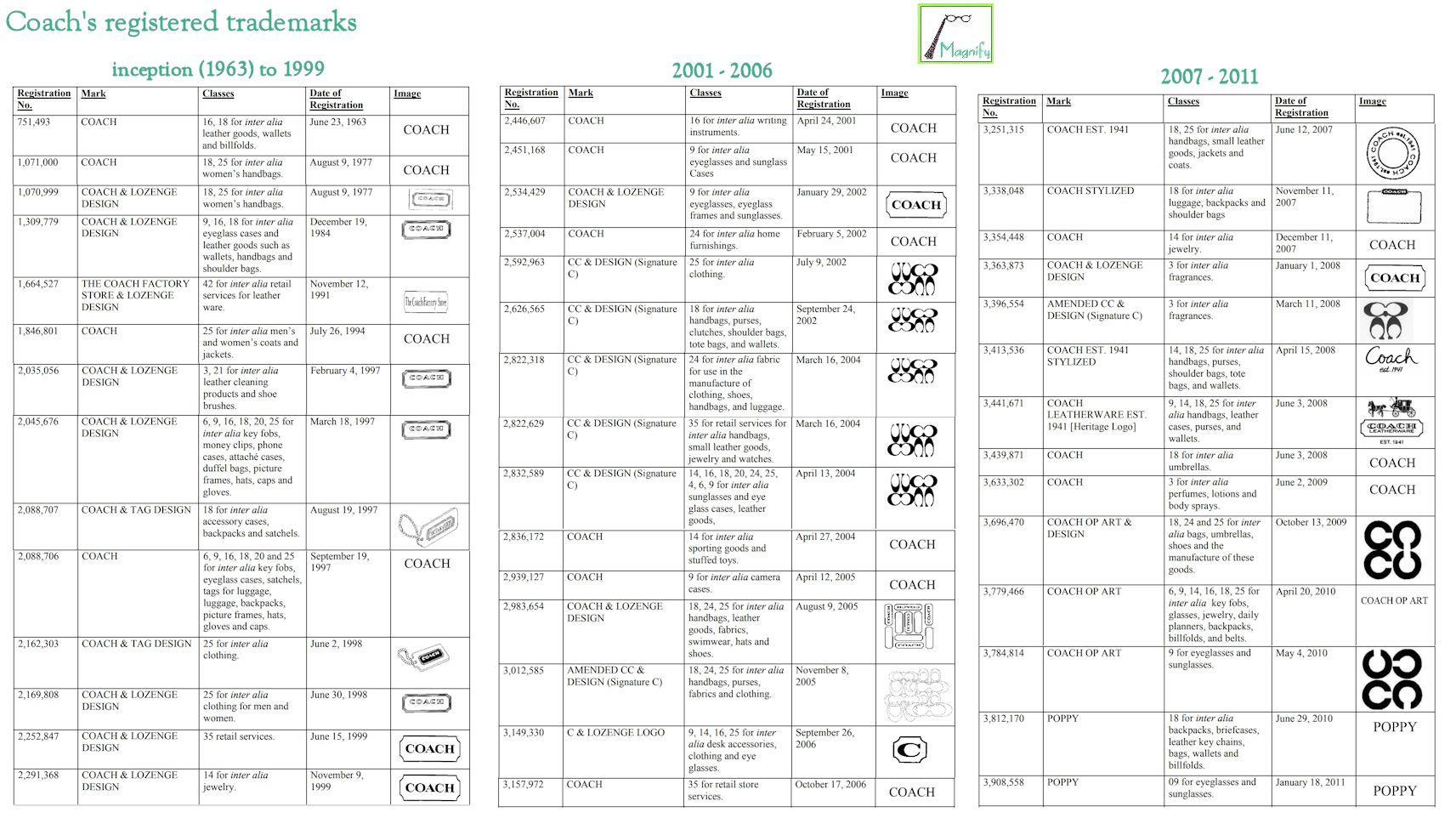
The suits fall into two general categories. The first concerns counterfeits of fabric bags or plastic accessories, by far the most numerous and recent. But the second sort is more relevant here, which can be seen from a few older suits that dealt with leather bags, not as counterfeits, but as knockoffs, "trade dress"/copyright infringement, which is to say, the theft of (usually Bonnie's) designs by other companies claiming credit to themselves. This is a significant difference, and from it we learn that the prevalence of faked leather Coach bags is actually fairly low, especially in the past 20 years or so.
So the vast bulk of Coach's recent legal action has dealt with quite literal counterfeits, rather than things merely encroaching on "trade dress." A counterfeit = "a spurious mark which is identical with, or substantially indistinguishable from, a registered mark," and this means things cooked up deliberately to replicate Coach designs including fake tags, fake creed patches, logos, etc. The outcomes have been mixed (Coach seems to have a habit of over-reaching in terms of seeking damages in the millions from rinky-dink resellers stupidly selling fakes), but the type of products generally haven't. The counterfeits that were apparently deemed worth pursuing in court were fabric bags and other fabric or plastic accessories, generally obtained recently from China, which is also where most of the actual Coach-produced items were manufactured. (There are lots of cases like this...Coach, Inc. v. Asia Pacific Trading Company, 2009, counterfeit CC logo sunglasses; Coach, Inc. v. Ocean Point Gifts, 2010, counterfeit accessories sold in a retail shop; Coach, Inc. v. Sharon O'Brien, 2011, a rinky-dink website was selling counterfeit Coach logo phonecases for an average of $20; Coach, Inc. v. Gail D. Becka, dba Hair Cottage, dba Gagas Gift Boutique, 2011, small giftshop in Georgia buys fake bags from China online, possibly unknowingly, and resells locally; Coach, Inc. v. Sassy Couture, 2012, counterfeit items sold on a website; Coach, Inc. v. Goodfellow, dba The Southwest Flea Market, 2013, a flea-market owner sued when counterfeit bags were found; Coach, Inc. v. Sun Supermarket, Inc. and Mi Kyong Rojas, 2013, defendant travelled to China, bought fake bags, sold in NC store; Coach, Inc. v. Sapatis, 2014, another flea-market owner sued for counterfeit bags sold there...and there are many more.)
The takeaway is that the rise of counterfeiting is fairly recent, post 2000, and basically involves fabric rather than leather, which is easy to understand by a consideration of basic materials costs. There are just a handful of cases that are worth looking at regarding leather bags, the most significant from decades ago. Two involved copies of older classic bags by fairly two-bit operations, both in New York, and didn't get involved with counterfeiting, so much as issues of trademark and trade dress infringement, which is to say, look-alike bags without any particular Coach-named branding. And the significant element in both instances was that the fake bags were not real leather, but made of vinyl. (See ex. Coach, Inc. v. We Care Trading Co., Inc., 2001 U.S. Dist. LEXIS 9879 (S.D.N.Y. 2001), where we find that We Care handbags introduced into evidence were "comprised of vinyl made to simulate leather, bound edges, simulated brass hardware, and a Coach look-alike blank hangtag, that is, a hangtag that looks like a Coach tag except that the word 'Coach' is not embossed in its center.") In that case from 2001, the bags at issue were late 1990s era, before Coach had branched into fabric at all, still had only two trademarks registered, and had a trade dress defined as "glove-tanned leather, bound edges, brass or nickel-plated brass hardware, and a lozenge-shaped hangtag with a beaded chain." And the copy bags were vinyl. And they bothered to bring suit anyway. This tells us something. Specifically, it tells us that if there were truly good, almost indistinguishable simulacrum copies of Coach's old-school leather bags ("flood of fakes!") suffusing the market back then, to the point that reasonable buyers couldn't tell the difference --let alone hard-core Coachistas-- you'd better believe they'd be going after them, and not wasting time with two-bit operations selling vinyl look-alikes that seem comparatively laughable to anyone remotely familiar with Coach. And especially not ones that didn't say "Coach" but instead "We Care" and merely replicated some design elements in plastic.
Another one dealing with pvc/vinyl copies of leather bags was more recent, 2017, and was actually the second time Coach went after something called La Vani (Coach, Inc. and Coach Services, Inc. v. La Vani, Inc., Weihong Cui, et al., 1:17-cv-01203 (SDNY)), which apparently makes some very bad looking pvc/vinyl bags, openly describes them as "faux leather," and --unless they have fixed it by now-- are misspelling design as "Dasign" on the head page of their website. Clearly this is a highly sophisticated operation, right? And they, too, are not making counterfeits bearing the Coach name, but instead their own mark, which is hardly the sort of thing that could ever require an 'authentication' to detect. This suit was noticed by others ("Coach Does Not Want Others Using Its Hangtag Design"), because of the attempt to use "trade dress" to protect and claim to themselves any hangtag, even a blank one without the Coach name on it, but if we look at the ruling in the suit above, Coach trade dress was defined very differently when the bags were still made of good leather. The new hangtags, as we saw on the Rogue above, look like plastic keychains, don't even bear the word Coach anymore but just a carriage, or are clunky metal things tied on with a thong (e.g., the Edie). They're often not connected with a beadchain anymore (too heavy for that) and bear little resemblance to the swatch-like leather hangtags of the past that used to define Coach's trade dress. Perhaps the thinking is that since logomania Cs just code as tacky now, they'll identify the brand --not with a return to good leather, certainly not!-- with a logo hangtag, any hangtag, with their name or not. (Remember, this is the new-Coach company that tried to copyright the letter C. Because the worse the leather gets, the less there is to distinguish Coach bags from any schlock-bags to be found. This is the real problem, and it's one new-Coach/Tapestry could fix. As long-time fans of the brand, a return to old-Coach full-grain full aniline leather is really all that most now-alienated former Coach buyers want. That was why people loved Coach bags. It was never because of the brand name, but because of what that brand guaranteed.)
The last case relevant to Coach leather bags we'll look at also involves trade dress, is from even longer ago (1990), and is the most instructive: Coach Leatherware Co. v. AnnTaylor, Inc., 751 F. Supp. 1104 (S.D.N.Y. 1990). Back then AnnTaylor was a major brand of 'career clothing' and accessories, owned by Merril Lynch and sharing a similar target demographic to Coach at that time. Thus we would say AnnTaylor, working with Laura Leather Goods, posed a true and real threat to Coach, basically by theft of design that would, if allowed to proliferate, dilute and eventually possibly destroy the Coach brand. (Coach had to sue these people, and if you look at the photos below you'll see why.)
The issue was copyright infringement/trade dress --again, not counterfeiting-- as AnnTaylor, working with Laura Leather Goods, was making and selling true knockoff Coach bags. In this case, the Dinky, the Duffle Sac, and the Convertible Clutch were at issue, but there were a variety of others they copied, some of which are still floating around today. The only Coach-like bags not in plastic/vinyl, but in some kind of actual leather (though still not full-grain and full aniline leather) that we've ever encountered were knockoffs like this, not counterfeits. They bear the branding of some other company, not Coach, and are a kind of design theft rather than forgery. It's a significant distinction if you're worried about fakes. This is what is usually encountered as a fake Coach leather bag -- and they're not marked Coach.
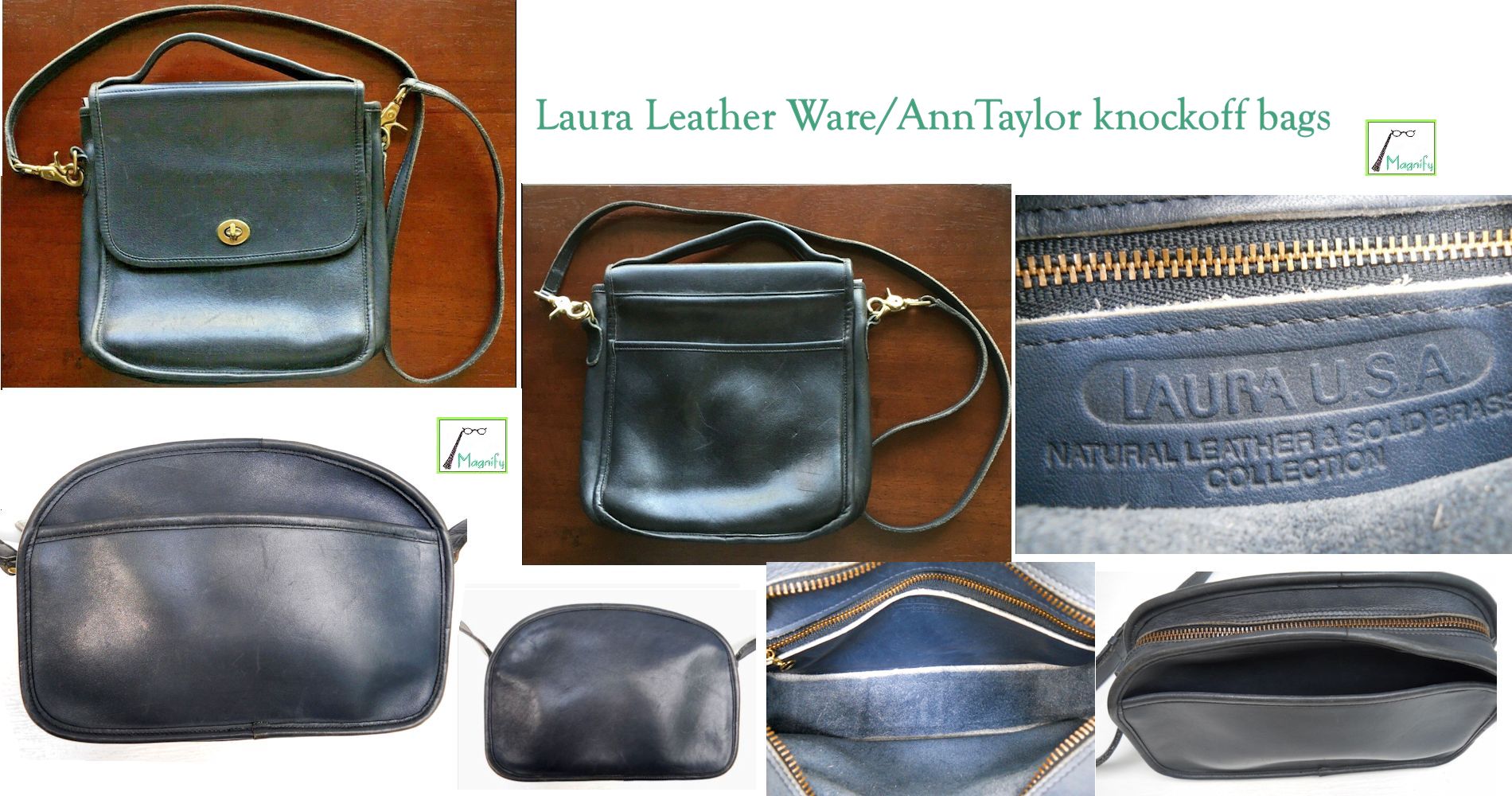
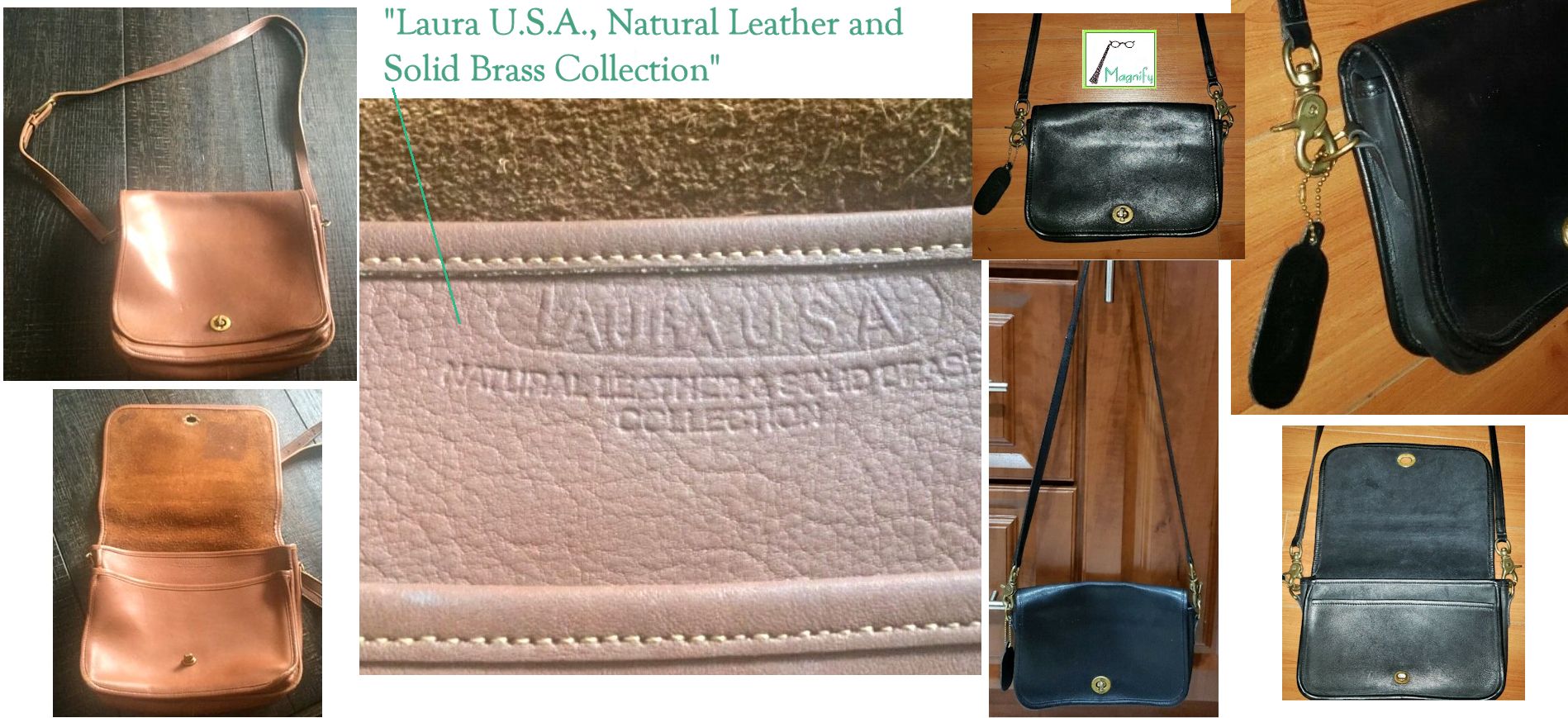
The AnnTaylor bags were branded "AnnTaylor" and/or "Laura USA" rather obviously, naturally not making any effort to pass themselves off as forged Coach. Instead they were basically stealing Coach designs and taking the credit for them, trading on Coach's success --which was largely due to use of actually superior leather-- to sell their own lesser quality 'genuine leather' bags.
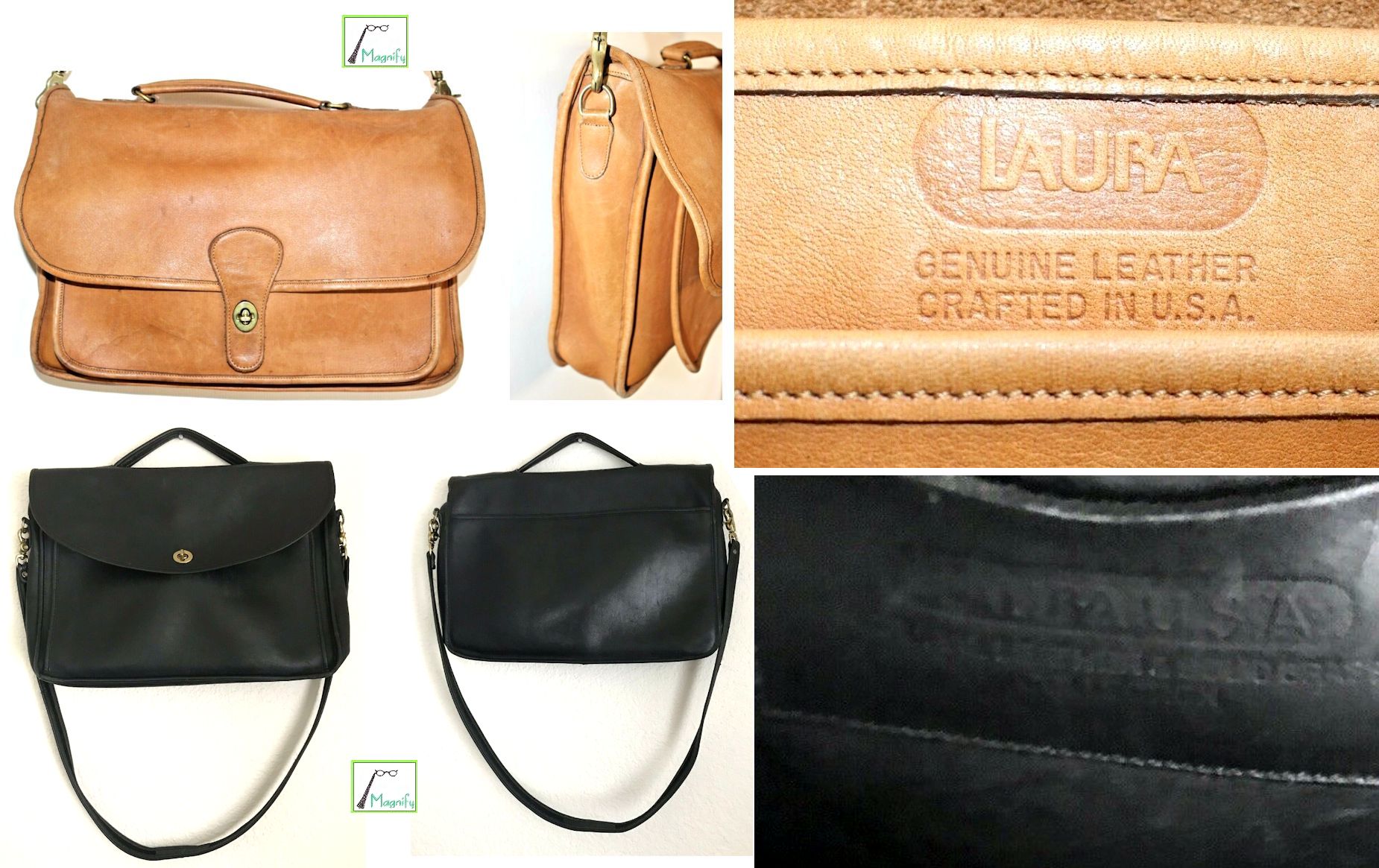
These knockoffs by "Laura USA" are just the sort of theft by copying that Bonnie Cashin's designs had long faced (and continue to face even today), where it's the distinctive form and presentation of the item that is copied --with design credit for it stolen by someone else, and generally made in lesser, cheaper materials. In this case, Coach eventually won, as they should have (mainly on infringement of their distinctive leather hangtag, trade dress). No one worried about fake Coach bags today could ever be 'fooled' by an old AnnTaylor/Laura-branded bag, as we can see from this sampling of now-vintage ones still floating around, usually on eBay (and identified as such, not sold as Coach, obviously). In court, the obvious markings from another company was AnnTayor's argument, too: "Appellants argue that the sophisticated consumers likely to purchase Coach products are informed enough to realize that handbags lacking a Coach registration number and the Coach name are not Coach products." But this is where the basic foolishness of today's ideas of 'authenticity' are a problem. Confusing pre-existing Coach buyers was never the real threat here at all, nor was that the intent of AnnTaylor. The real threat was (a) taking neophyte/new buyers who would have bought from Coach, and (b) diluting the product quality, specifically the grade of leather, in the minds of consumers more generally. The key to understanding the problem here rests in grasping that Coach bags weren't special merely because of a brand name or logo stuck on them at this point. They were special --and cost a bit more-- because they were made with more costly materials, largely by hand, and they had a lifetime warranty. AnnTaylor/Laura bags were nothing like that. They were pigmented at best, not full aniline, in various tannages, and had no particular warranty. Therefore they could sell them much cheaper, which they were doing. And this is what we would call a fake, the thing to be aware of, and the reason you want to see the inside of the bag if, say, shopping on eBay. If it looks externally like a Coach but inside it says "Laura," well, you know what it means. And no one needs an 'authentication consultant' for that.
The fakes in some kind of leather rather than vinyl, which can be convincing from a distance, are not counterfeits, but knockoffs. They are in the market now as a residue of attempts by one large brand to steal the designs of another --or really, of Bonnie Cashin-- constructed in subpar leather and with credit for the style passed off as being their own, which is what a knockoff is.
Those were some "Laura USA" knockoffs, and they got sued. Below we have a sampling of other companies doing the same, but on a more limited scale. Dorcelle was briefly prolific, making dead-on look-alikes as early as the late 70s, into the mid 80s, but it seems they folded quickly. And to some degree we can see why, by looking at the bad cut of leather used on the bottom of the tan top-handle bag below. Coach's artisans never did this sort of thing because the bottom receives the most stress, especially when the bag is full, and it would wear out quickly and look bad, which it has. If this were a Coach bag, it would have meant the buyer --because back then Coach offered free refurbishment-- would have sent it back to the factory (where registration numbers could be traced back to makers) and someone would have had to basically refabricate the whole thing. Coach didn't use bellies or bad cuts, first because it was beneath the standards of the company and its skilled workers, but also because it wasn't cost effective when they were warranting the longevity of the bag. That was a major point in what you used to get by buying a Coach, which you clearly didn't get with a here-today/gone-tomorrow "Dorcelle USA": a guarantee for the future.
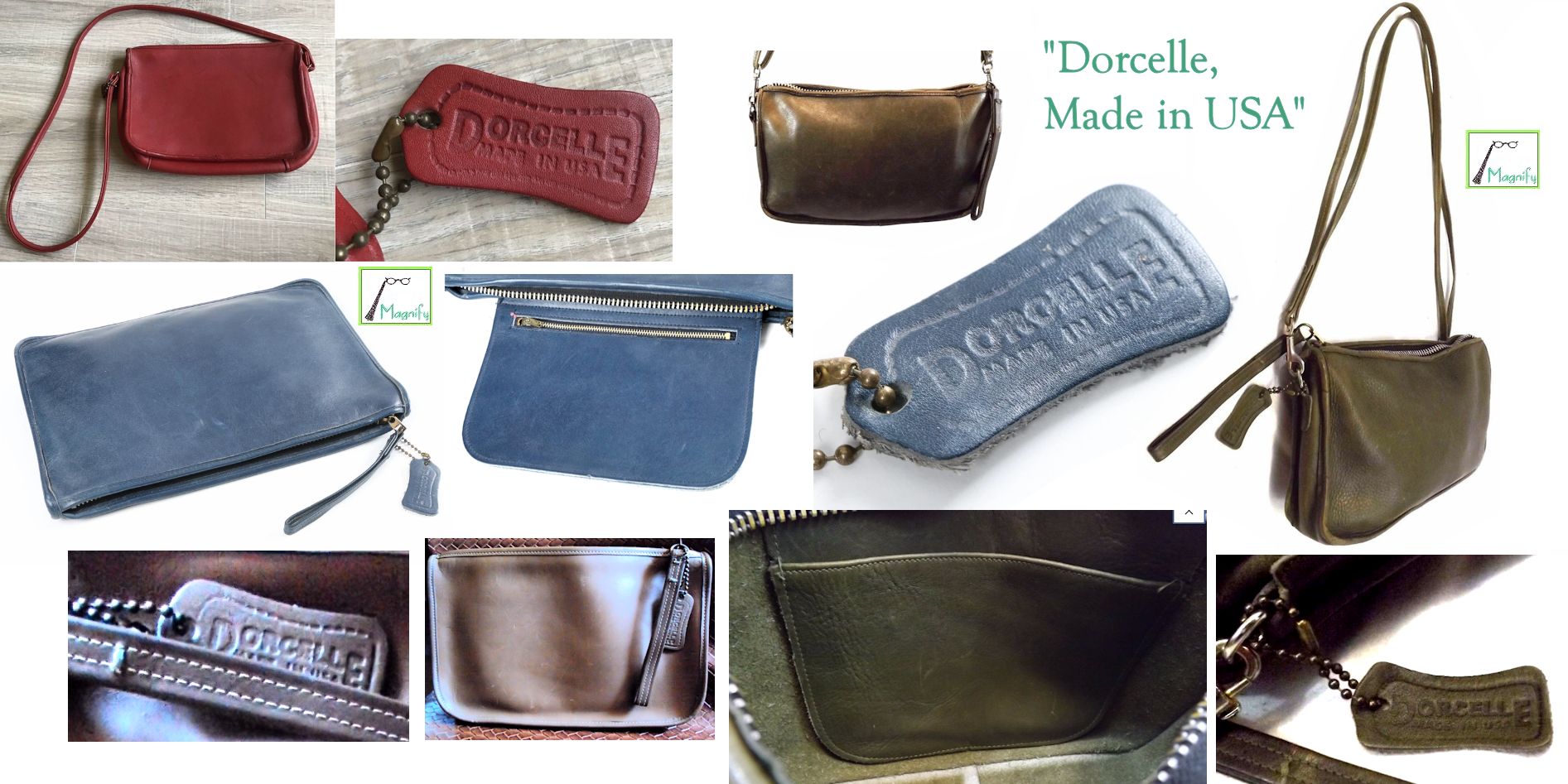
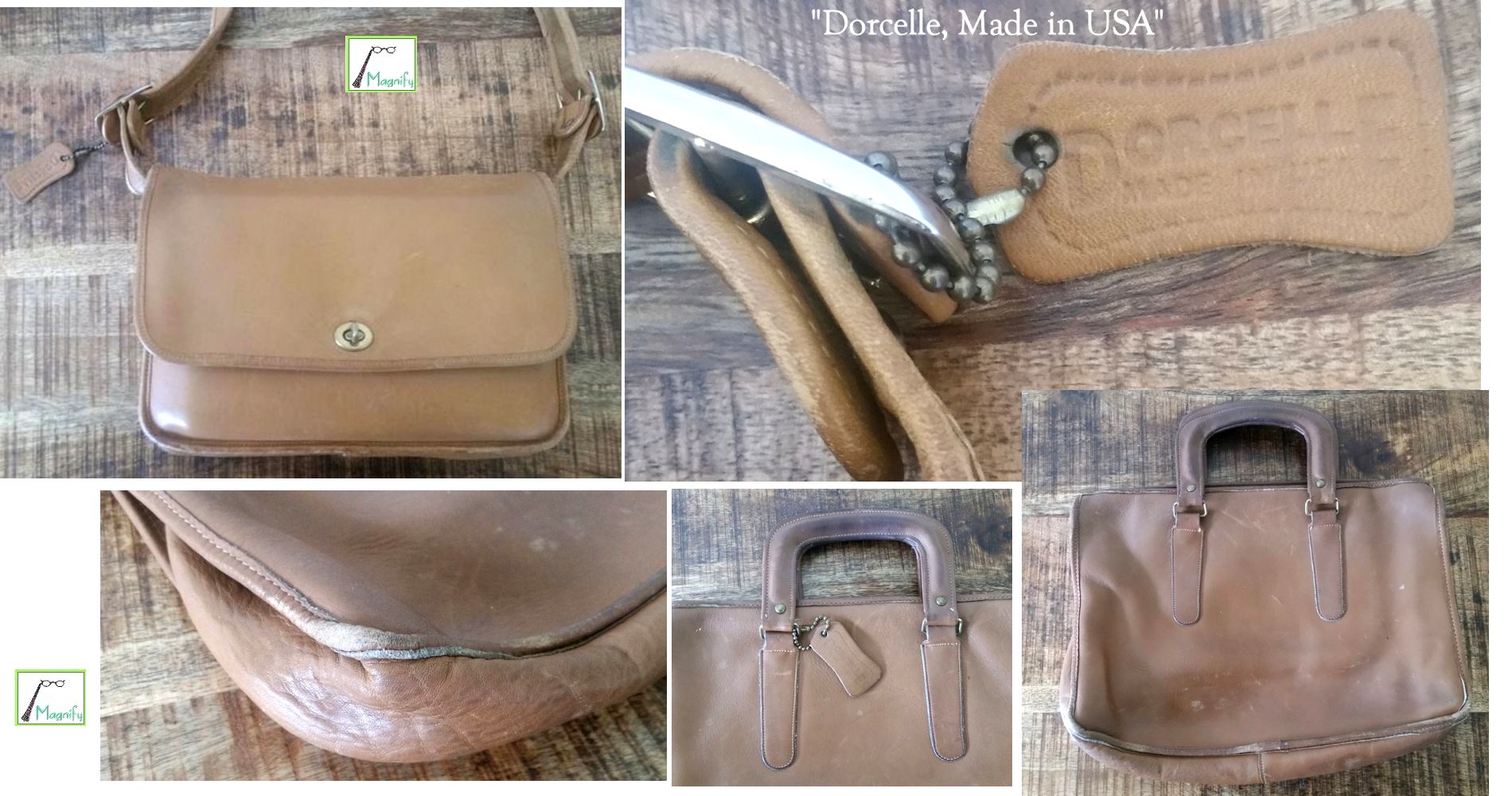
But it wasn't just Laura and Dorcelle. There were a bunch of copyist companies out there, and for some reason the Station Bag (introduced in the 80s) and the Willis (1990s) shape was a particular favorite. Some brand called Kirkland made a fairly wretched Willis/Murphy/Station sort of bag, naturally in a plasticine "genuine leather" (this is from when Coach would never stoop to such things), and there was a somewhat more convincing Station/Willis one made by Hunt Club. Briefcases were copied too, as design elements cannot be copyrighted if they're functional, and Coach bags were generally functional first and foremost. But what is worth noting in all of these cases is that they're not counterfeits. They don't say Coach anywhere on them, but rather some other company's name that was stealing (again, usually Bonnie's) design. And naturally they never have a creed, whatever you may hear about 'the line spacing should be perfect,' yata yata. That's the fabric bags. No one has convincingly counterfeited the leather bags that we know of.
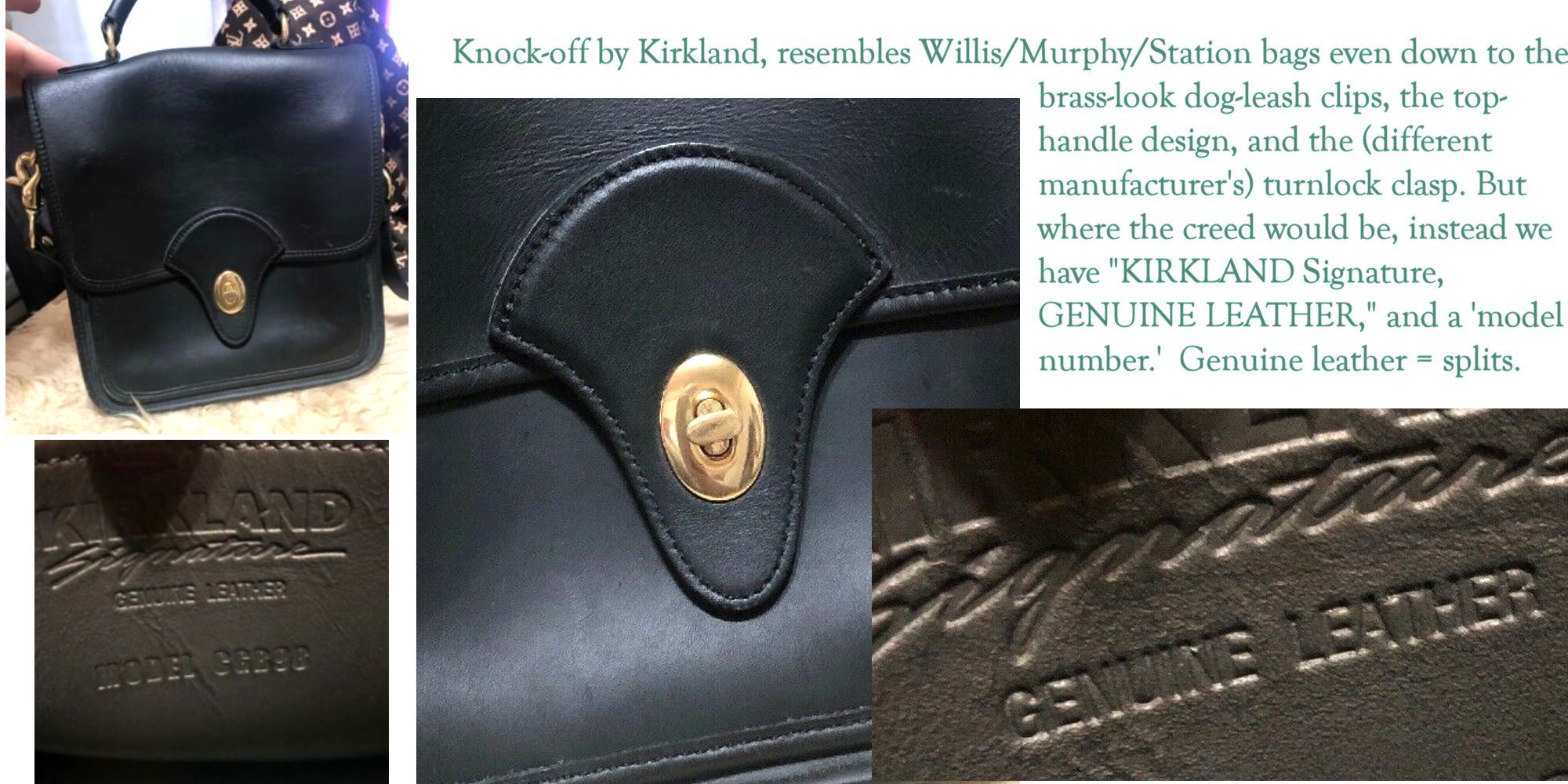
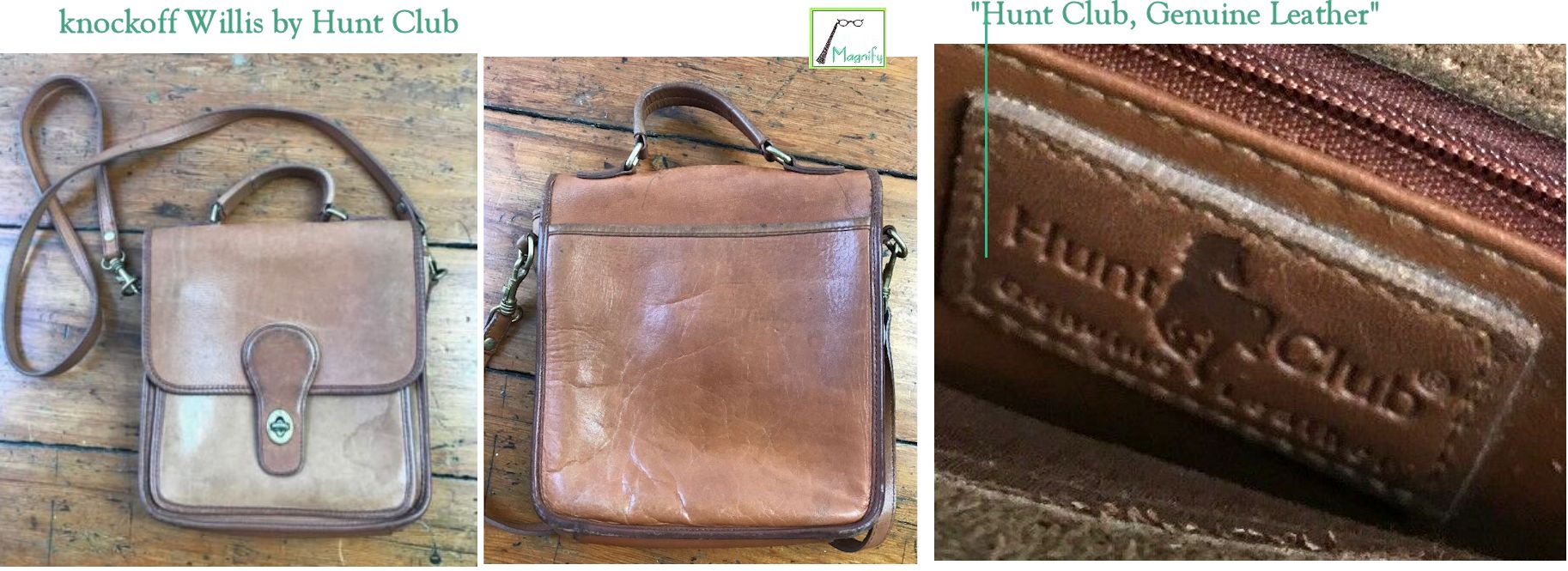
So we think, in terms of leather bags, no one needs to cower before the threat of almost-indistinguishable fakes, nor pay some fear-mongering 'expert' a fee for authentication, mainly because there are no almost-indistinguishable fakes. Are there copies? Absolutely. But the vast, vast bulk of these that any of us has ever seen are either (a) made of (real but lesser) leather, but marked for some other company, not Coach, as seen above, or (b) fraudulently marked for Coach, but made of vinyl/pvc.
And that's the last class of fake we'll look at here, the modern vinyl counterfeits. We have a fairly repulsive red one below, lurking on eBay maybe even now, just plasticine-looking on its face, but evidently made of pvc based on strings poking out from the edges, too. And here is the one time you'll want to know anything much about the registration/serial number: NT-anything is always a counterfeit. It's believed they originated in Korea, but it may as well be China, it's immaterial, as they're all synthetic --vinyl, polyurethane, or polyvinyl chloride over fabric backing, which rapidly wears off, as you see around in images of them peeling disgustingly. They are never leather, not even bad leather. And they're easy to spot because there will always be at least seven characters in a Coach handbag's registration number -- and never beginning with the infamous NT. But the most obvious give-away, as usual, is that they're made of plastic.
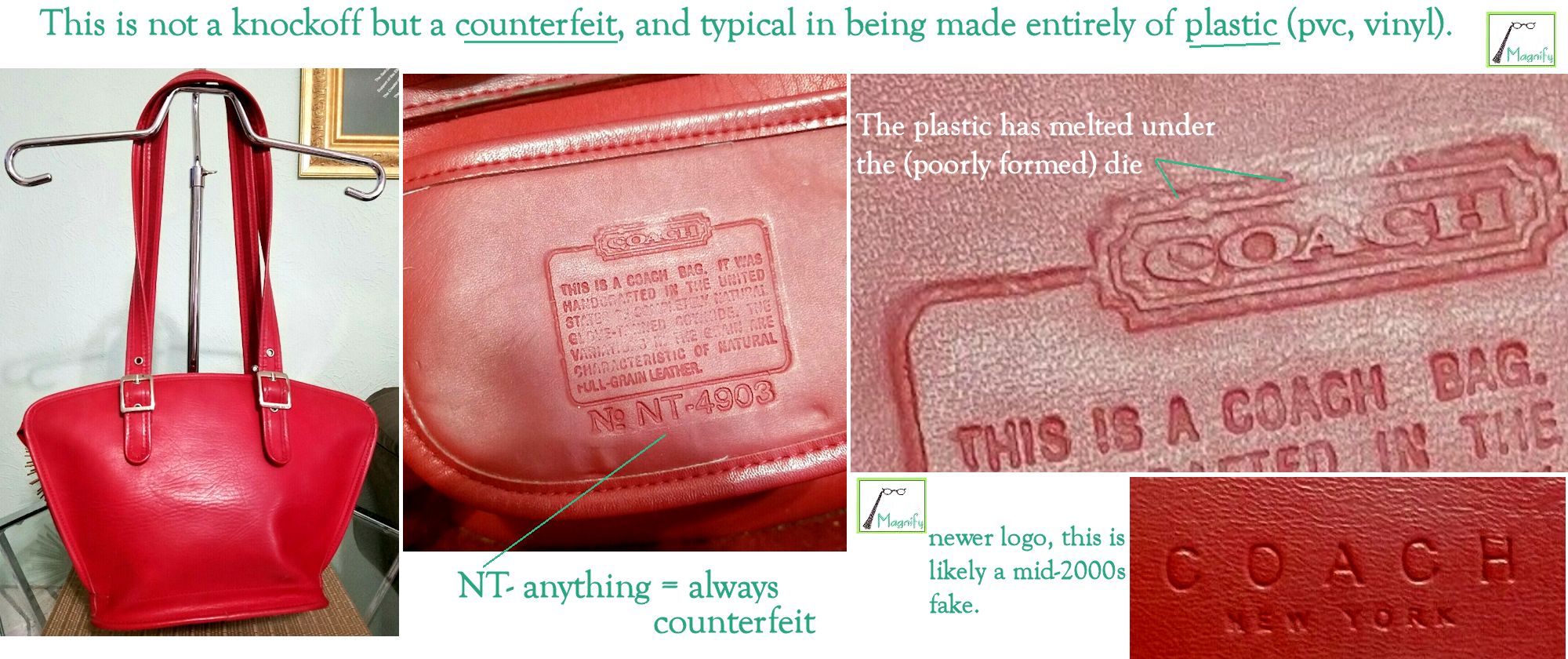
Things like this show why the "flood of fakes" hype is not helpful at all, and possibly does more harm than good. It obfuscates the quality issue. The biggest gulf between a vintage Coach bag and anything trying to imitate it is always the quality of the materials, which is something no other similar-looking bag, let alone a counterfeit, has been able to achieve. Coach bags, back then, truly were made of better leather than just about everything else, and it's because they used full-grain full aniline hides. If you can distinguish what a full-grain full aniline leather looks and feels like, you'll never have to worry about 'authenticity' again. Not once in all these years has any one of us ever seen anything trying to copy a Coach bag that could pass the pore structure test, or even close. And the reason is obvious. It's the same reason that all that fake-stamped "14K Italy" stuff that flooded the US market decades ago wasn't actually gold but base metal. We didn't hear anyone complaining that the stuff was no good because it wasn't actually made in Italy, mind you. The origin wasn't the problem, but the fact that it was ferrous rather than precious metal. The problem was a low quality and therefore cheap material posing as a valuable one.
That's what really makes a thing a fake: fake materials. Far more than any company-generated numerical or orthographic minutiae --lists of ostensibly 'known fake serial numbers' or the shape of the A, etc.-- the most salient question to be answered is always one of physical materials: what is it made of? We can compare this with adulterated foods, which problem was rampant in the 19th century before regulation, such that sugar typically contained pipeclay and sand, flour was cut with stone dust, bread often had chalk and plaster as major ingredients for bulking, and pickles were made to look green with arsenic (yes, really, Scheel's green). Issues like this were how trademarks and brands began, as a guarantee against what competitors were doing. Adulterated food clearly harmed consumers in a way far beyond the Lanham Act. Violations of a company's trademark or trade dress is hardly in the same category in terms of consequences to the consumer as fake materials posing as genuine. The one is a species of infringement possibly hurting corporate profits; the other directly harms the buyer, who ends up paying for gold and getting lead, paying for sugar and getting sand, or paying for leather and getting plastic. And there's a more relevant name for that: fraud. If you bought a bag and paid the price for hand-fabrication on full-grain leather, but instead you got mass-machined vinyl or polyvinyl chloride on fabric, you've been cheated, and cheated out of the "years of service" an old school Coach bag used to provide. This is why, from the point of view of the buyer and user, value inheres in materials, not in corporate logos or brand tags. The essential materials content was what those brand logos were originally devised to guarantee -- most especially the Coach creed and the Coach leather hangtag. Those logos were only representations, guarantee marks by the company that the materials in the bag were what they said they were, and would behave as expected. This is why you bought Coach. Not because it had a Coach tag, but because the Coach tag ensured you were getting a quality leather bag. Or at least it used to. When we've all fully processed this, rejected the gaslighting, and begun to demand more again...maybe then there will be new leather Coach bags of superior quality in the marketplace again -- and not just vintage ones.
All of this makes you wonder, how can it be true that most of the leather around now really has a fake surface, but no one talks about it? How could the words "genuine leather" have been quietly twisted into designating such a miserable product as drop splits coated over with paints and plastics? And how could that be legal, right? Aren't we supposed to have consumer protections or something in the US? This is pretty much the trajectory of issues that came up as many of us started looking into why the new Coach bags seemed so poor compared to older ones, wearing out in short periods of time, feeling rubbery, just seeming flimsy and somehow off, and especially recently, after 2010. First individually, then as a group, we started asking, what the hell is going on here? Several of us had real trouble believing it, that it could be this bad, but also this wholesale, across leather bags in general, and yet with such a deadly silence. (That's why it seems like gaslighting more than anything else. Now we know, when thousands of women experience something as a problem, but each one is made to feel the problem is her individually, it's almost never her individually. Maybe we need the Me Too movement of new Coach bags?)
It started a discussion, specifically, what exactly is the full-grain you used to see in the creed? And what is it when it's not full-grain anymore? Well, now we know. And it's pretty depressing. After digging into leather processing and terminology, which made clear what's going on with the frankenleather of today, the next question was 'how is this legal?' We found an answer to that, too. It is legal in the US now (especially since 1996), though not really in many other developed countries. That's kind of disturbing, too. The details of how exactly such things are (that is, became) legal are...tedious. (If you found the earlier convoluted processes in making corrected grain leathers almost lethally dull, well, prepare to die because the mincing fine points of legal verbiage are why things like corrected grain/bicast/pigmented/pu leather are quietly lurking everywhere now. Naturally the foundational rationales for it are even more convoluted.) And yet, if you're buying anything in leather --bags, obviously, but also wallets, jackets, even furniture-- and you're hoping to get actual leather that will behave like a cowhide and not a length of pvc, some awareness of the background on how things got the way they are now really helps to avoid the worst of the faux-grains.
The short answer to how it can be legal to call painted split hides "leather" is: it wasn't until about 25 years ago. That was when the Federal Trade Commission's "Handbag Guides" were merged with the "Leather Guides," which were modified in 1996, and that brought the "removal of the limitation that only top grain leather should be called 'leather' without qualification." Now recall what Top Grain used to mean in the older halves model of splitting hides? In 1996 it definitely didn't mean the modern sanded stuff (corrected grain/top grain, with grain sanded off the top). Instead it meant full-grain, or at very least, something made from the upper half of the hide, the grain layer. Drop splits weren't "leather." Now if we read this again, we see immediately, what they're really saying is that the requirement that "leather" be made from the grain --the naturally smooth top of the hide-- was removed. And that opened the gates for everything with a fake surface to be called leather, frankenleathers of all kinds, including things made from drop splits, which hadn't been the case before. Thus, "Genuine Leather" means nothing now. The older "100% leather" tag largely disappeared, and only bonded leather, with percentages by weight, has a disclosure requirement (i.e., must be qualified, a "provision regarding the disclosure of the percentage of non-leather and leather material contained in bonded leather").
The FTC's "Leather Guides" (technically, 15 U.S.C. 45, 46; 61 FR 51583, Oct. 3, 1996, 24. Guides for Select Leather and Imitation Leather Products), are actually just that, guidelines, like suggestions more than rules. (The real law is Section 5 of the FTC Act (15 U.S.C. 45), Unfair or Deceptive Acts or Practices, which "prohibits unfair or deceptive acts or practices in or affecting commerce." This is so broad and vague that the "Guides" idea was devised as a method of making suggestions to businesses on how to label or advertise products accurately to consumers.) The current "Leather Guides" remain unchanged from 1996, when the bar was lowered enough to let in not just any faux-grain, but even lowly split leather, including PU leather (with the glued on decal, a.k.a., bicast) which is not legal as leather in most of the rest of the world, as we'll see. If you were around in the 90s and have vague memories of a lot of ostensibly leather things starting to have unaccountably nasty surface textures after the mid-90s, this may be the reason. Faux-grains of many types quickly became normalized, and not just the corrected grain (which had been around before because, under the top/bottom halves model, a sanded portion of the grain layer was generally allowable as being part of the grain half). Heavily coated split hides, the bottom portion covered/coated to look smooth, became ok as "leather." Even "genuine leather," which it hadn't been before.
It's also worth noting that the FTC announced earlier this year that they would be conducting a periodic review of these "Leather Guides", with the public comment period open for about two months, and now closed. (But you already knew that. Almost all American consumers knew all about this opportunity to make comments to the agency controlling the state of consumer protection law regarding leather, right? Right.) But the sad fact is, this is the second time the "Guides" were reviewed, and the prior one in 2008 went so badly --suggestions were made that would have brought the US into line with, say, Europe, but they were smacked down-- that all relevant issues are already off the table. The 1996 state of affairs was left in place, and remains in place now. Thus, what is done or not done in the final ruling for 2019 is already irrelevant for handbags, as the only thing still being considered, other than outright repeal of the Guides, is whether or not leather upholstery will be included, or remain as it is now, excluded from the "Guides" as leather. (Upholstery leather is relevant, though, because it's one of the only areas where you still hear a word about full-grain and full aniline dyes these days, verses everything else, and that's because the remaining sectors of the leather upholstery industry, both automotive and furniture, that are still using real leather (full-grain anilines) are in the fight of their lives, trying to stay afloat and make consumers understand what 'bonded leather' really is, before they buy it and learn too late for themselves. We'll touch on this upholstery row shortly just because there are things to be learned from it regarding leather handbags, mostly in the form of cautionary tales.)
So the current sorry state of affairs was actually entrenched by the previous FTC 'review' of the Leather Guides. Some excerpts from that ruling by the FTC in 2008 are instructive. First, here is their description of the initial changes in 1996:
"The language of the Luggage Guides, the Shoe Guides, the Handbag Guides, and the Waist Belt Rule was updated and clarified in the Leather Guides, and unnecessary provisions were deleted. Further, the Leather Guides modified a number of provisions from the older guides and rule. Among these modifications..." was "the removal of the limitation that only top grain leather should be called 'leather' without qualification, and the addition of a provision regarding the disclosure of the percentage of non-leather and leather material contained in bonded leather."
Our italics. And again, that was the old "top-grain" there, meaning the top half, the grain layer. Before 1996 "leather" couldn't include the lower half of hides, the drop splits with fuzzy suede-like surfaces coated with paint and plastic to look smooth, unless they described or "qualified" the content as something not natural leather. But now they're fine. In fact, now they get to be "genuine leather," where they clearly weren't before. One would think perhaps the reason for a review in 2019, potentially updating these definitions, might be to take into account the ever-expanding variety of new and duplicitous ways to industrially fake smooth leather-like surfaces but still call it leather. But no. And we know that because of how things unfolded in 2008. Back then the usual trade groups submitted comments, but the most relevant came from the LIA (Leather Industries of America, formerly the Tanners' Council of America), the main trade group representing America's tanners and leatherworkers. In their submission they described how the laxity of US regulation harms both consumers and producers, saying the Guides "require expansion to make them more comprehensive and consistent with global industry practice." And they were right about that, because much of what can be called "genuine leather" in the US --in 2008 and now-- would never fly in other countries, as we'll soon see in a review of standards in use elsewhere.
Looking at a modern Coach bag, as compared to a vintage one, we can see that the proposed changes suggested by the LIA in 2008, had they been adopted, would have largely fixed many of the problems of faux-grain more than a decade ago, because they would have formalized grades of leather, and stopped the 1996 and later model of lumping together every kind of split and painted hide in with full-grain, no distinction. (No wonder full-grain became so rare. Would you sell 22K gold, if it wasn't distinguishable in the marketplace from 10K and even heavy gold plate? No.) But the suggested grades or definitions weren't adopted by the FTC. Instead they were smacked down with a finality, meaning that was the one shot for this 'additional definitions' model, and now it's dead. Here's a sampling, quoted from the 2008 final ruling by the FTC:
"LIA [Leather Industries of America] proposes adding definitions for the following terms to the Guides: (1) top grain or full grain leather, (2) corrected grain leather, (3) semi-aniline leather, (4) leather, (5) coated leather, (6) laminated leather, (7) split leather, (8) leatherette, (9) bonded leather, and (10) chamois."
In other words, there would have been a way to distinguish by marking if something had an artificial, PU or vinyl surface, verses a natural one. Split leather couldn't have been called "genuine leather," as though things other than this cheap unnatural product were inferior, somehow not 'genuine,' though anything above 'bonded' is better than drop splits, which again, are considered rubbish in many places. Laminated leather would have had a meaningful name in America, which it should, as it's become standard and people don't even know it, until things wear out unnaturally quickly. There would have been a direct benefit in advertising for anyone actually using full-grain, which Coach always had done and noted in the creed, and a return to good quality full-grain would have become formalized as a benchmark. But no. This would have been a problem, costly in compliance for big businesses, especially those importing 'leather' from China, Pakistan, Myanmar, etc., and also making familiar we-thought-it-was-leather products suddenly unappealing to consumers. But why clue them in, when they can't tell the difference anyway, the FTC concluded:
"The definitions that LIA suggests for the terms 'top grain' or 'full grain' leather, 'corrected grain' leather, 'split leather,' and 'semi-aniline' leather are based on the presence or absence of grain surface and the finishes used on the material. These definitions are not needed, [!] as the Guides apply to all types of leather, as well as non-leather material with the appearance of leather. Further, the record contains no evidence regarding consumer understanding of these terms, [really?] several of which may be unfamiliar to many consumers. Absent evidence as to how consumers would understand these suggested terms [could it be any worse than no understanding at all?], it is difficult to determine whether adoption of the definitions would assist or hinder consumers. [Consumers? Or did you mean Big Business?] For these reasons, the Commission is not adding these suggested definitions. However, if industry members desire to label their products with these terms, they may do so provided that the terms used are truthful and non-deceptive."
Thus, there is no marking requirement at all. Naturally all the huge corporations cranking things out of cheap split leather and corrected grain will keep on using it, but voluntarily announce their shoddiness proudly, then, won't they? But no matter. The Guides already "apply to all types of leather." This is like saying 'the guides already apply to all types of gold,' and so we'll make no distinction between 9K and 18K and 22K. It's all the same, it's gold, right? Or imitation gold, because the guides cover that, too. But how do they cover it?
If we look at 15 U.S.C. 45, 46; 61 FR 51583, Oct. 3, 1996, 24. Guides for Select Leather and Imitation Leather Products, §24.2 Deception as to composition, (d), we find that "the use of a stamp, tag, label, card, or other device in the shape of a tanned hide or skin or in the shape of a silhouette of an animal [that is, the typical "Genuine Leather" symbol], in connection with any industry product that has the appearance of leather" is fine, as long as the object is "made wholly or in substantial part from animal skin or hide."
Again, our italics. And there it is: "in substantial part." It's definitely true, "genuine leather" (and corrected grain, and even some better varieties of bonded) are made "in substantial part" of leather...like a split hide glued behind a sheet of vinyl, because that's what everyone knows is real leather now. Just like particle board is made of wood. Or wood pulp with plastic and glue, but hey, there's wood in there! Following the leather analogy, that would make it "genuine wood." Sugar is fine too, so long as the material from sugar cane is more substantial than the sand and the clay; bread is bread, as long as it's a substantial part food and the plaster, chalk and sawdust are somehow not as substantial; pepper, as long as some part is real ground peppercorns and it's not entirely the sweepings of warehouse floors mixed with dust. All of these are actual examples of established, though horrendous, industry practices for food production in the 19th century. (They're not even the worst...if you don't know what they used to do with meat, you don't want to.) And the idea eventually evolved that hidden adulteration with a profit motive might be a bad thing, or at least most consumers felt it was, when they became aware of it. But not so, consumers of leather, with their little pea brains, they'd only be confused by imposing standards on manufacturers, as everyone knows. Give them a hide-shaped sticker, they don't know the difference anyway, and they won't know for maybe a whole year. We'll get kudos for not completely rescinding the "Guides" (as we threaten to do at each review). And we'll completely ignore the rest of the world, as we usually do, too (next they'll be demanding universal healthcare or who knows what), and leave the marking 'suggestions' intact, because they're utterly useless. And so goes consumer protection in America. But don't despair. You can go hug a new plastic Coach bag and maybe if you just wish really hard....
So that was 2008. When the 'review' came around again several months ago, the LIA was there again, but this time their 2019 submission to the FTC only focused on upholstery and automotive leather, and mainly trying to regulate bonded leather, because they were already shot down on everything else in 2008. Again it is mentioned that US rules are lax or nonexistent if compared with consumer protections in Europe, but the 2019 statement was still very tame compared to the one from 2008. It seems everyone has more or less given up hope on "leather" meaning real, full-grain leather ever again in the garment and handbag arenas. But this is why it's worth looking at what is going on in other countries, because while faux-grain and PU leather exists everywhere, it's not universal everywhere, which is a big difference.
From a consumer's point of view, rules for what counts as leather are better in just about every major European country, mainly because they either limit the thickness of any surface coatings, or require grain-less split hides to be described as such (and not as "leather"), or both. There is still enough variation across countries that an EU-wide harmonized labeling system is under consideration (see "Study on the feasibility of a leather labeling system at the European level"), and this will probably come as the European tanner's association, COTANCE (Confederation of National Associations of Tanners and Dressers of the European Community) has been advocating it for years. But harmonized EU-wide or not, the state of leather quality standards is still better almost everywhere else. Looking at a sampling of more or less comparable places shows that the US really is alone in using this "in substantial part" criterion. In most places there is either a tight definition of split leather ("genuine leather" in the US) as something different from and inferior to full-grain leather, or a threshold for the thickness of tolerable coatings (usually 0.15 mm, a tiny fraction of a millimeter), and if something exceeds that coatedness, it can't be called "leather" anymore. (For comparison, 0.1 mm is 100 µm or 100 microns, which is the average diameter of a human hair (range 17 - 181 microns). It's really thin.)
France: We'll start with French leather regulations covering definitions (Decree No. 2010-29, 8 January 2010) because they're unusual in not focusing on coatings in a fraction of a millimeter, but instead on distinguishing between cuir ("leather") and croûte or refente de cuir ("crust" or "split leather"), which are commonly known in France as distinctly inferior to the grain layer. Article 1, paragraph I tells us that "leather" is the product obtained through tanning of an animal hide and "preserving the natural structure of the fibers of the hide and having preserved all or part of its grain." (Interestingly, the grain is considered the cream, literally "the flower," while the drop split is, yes, seen as the dross, almost rubbish.) Paragraph II defines "the crust or leather split" as "the inner part of a skin obtained by dividing the thickness of the leather, or by means of any other operation which has led to the complete elimination of the outer [grain] layer and in which all pores structures holding hairs, feathers or scales have been destroyed." And that's a split. Corrected/top-grain can be called leather in France, if at least some grain layer remains after the sanding, but what passes as "genuine leather" in the US can't be called "leather" in France.
Italy: Italy is strict because tanning/leathergoods have long been such a part of their economy. There have even been issues raised of protectionism from other EU countries, because Italy is so strict, and yet who hasn't heard that Italian leather is the best? The handling of definitions and standards have actually protected the reputation of the industry as a whole, including via the creation of a leathermark held in common by members of the trade (which is, compared with the US situation, somewhere between a trademark and a brand in terms of intellectual property rights, which are enforceable). In essence "leather" in Italy (as of a recent update in 2013) means hides with the "natural structure of their fibers intact, as well as all articles created from [those hides], with covering layers made from other material with a thickness of 0.15 mm or less." It's very specific about intact fiber structure and limitations on surface coatings. So no bonded leather allowed, and no laminated/corrected grain where the coating is 0.15mm or greater. This 0.15 mm threshold for coatings is also far less than PU leather or bicast, with its synthetic sticker glued on splits/suede, and typically less even than a film. Most 'genuine leather' in the US fails this standard. There is also a powerful Italian Leather Trade Association, which collectively holds the leathermark symbol, and this is known to consumers as a logo indicating the genuine product (i.e., not just actual leather, but Italian leather). It differs from consumer quality marks in other places (e.g., the Blue Angel mark in Germany) in that infringing products deceptively using the leathermark, far from merely not meeting approved production standards and being deprived of the use of the mark on their wares, instead may have the Italian Leather Trade Association call down governmental/EU enforcement on them over things inaccurately marked as (Italian) leather, involving an element of punishment. (This vigilant guild-like system would never happen in the US, much as it might benefit consumers if it did.)
Spain: less stringent than Italy, but still regulated (Royal Decree 165/1988, amending Royal Decree 769/1984) where what can be called leather (or fur) is defined through phases of tanning, marketing and sale. Article 3, par. 2, from 1990, specifically bans leather terms from being used for things that are made of hide, but "have lost their natural structure by having been subjected to mechanical or chemical fragmentation," which is to say pulverized, with such pulped fibers produced in preparation for "their agglomeration or reconstitution." So no bonded leather allowed as leather, as usual. Faux grains like splits/genuine leather and laminated/corrected grain are also regulated --as to their surfaces, just as the LIA had suggested to the FTC-- but less strictly than other countries, limiting any surface coating to "0.3 mm or one third of the total thickness" of the finished hide, which ever is greater. (Basically this is a difference of 0.15 mm from the more typical standard, thus coatings can be twice as thick in Spain.) Some laminated could definitely pass this test, but polyurethane/vinyl covered splits (PU leather, much 'genuine leather') still generally couldn't.
UK: mostly relies on a voluntary system where products must meet defined standards from the UK Standards Institute (BS 2780:1983 N.159), and there are a variety of quality marks (from the UK Leather Confederation, licensed through UK COTENCE) that can be awarded as certifications, generally only after the products have been submitted for some quite elaborate chemical testing (mainly through BLC), and passed. The leathermark system in the UK is old, created in the 70s by the International Tanners' Council, and the original hidemark is still owned by the UKLF (UK Leather Federation), which can and occasionally does take legal action against sellers fraudulently using the hidemark on things not meeting the definition of leather. More consumers seem to rely on the expanded array of quality assurance leathermarks, though, which cover not just chemical content/physical structure of leather, but suitability for use, child safety and heavy metals, environmental compliance, etc. (The All About Leather UK site has a good summary of these marks, LeatherSure, ConsumerSure, MetalSure, QualitySure, and EcoSure.) In terms of basics, what is leather and what isn't, the British Standard Glossary of Leather Terms (BS 2780) bars bonded leather (things made from pulverized and reconstituted fibers) from being sold as "leather," but things with surface coatings greater than 0.15 mm are also disqualified from being "leather" too, and this is that same tiny fraction of a millimeter you see again and again across the world. Anything that exceeds that degree of coating (with paint, polyurethane, etc.) won't get the hidemark because it isn't "leather" anymore. They also specifically define 'bonded leather' without calling it that, and ban it. ("If a tanned hide or skin disintegrated mechanically and/or chemically into fibrous particles, small pieces or powder and then, with or without combination of a binding agent, is made into sheets or forms, such sheets are not leather.") Things floating around all over the US marked as "genuine leather" would never get the British LeatherSure certification as being leather.
Australia: has a unique system of stylized initial symbols to indicate six different grades of leather. These include the highest grades of leather, as A= Aniline Leather, which is necessarily full-grain, and full aniline, always the best. NB = Nubuck Leather, which is the same thing but with a velvety rather than a smooth surface, but still full-grain, full aniline. PL = Pull-Up Leather, which is a full-grain that is oiled or waxed to accentuate the natural grain, having a sort of pre-burnished look. SA = Semi-Aniline, which we saw in the flow chart earlier, still a full-grain and with only trace pigments on the surface, like Coach bags of the mid-2000s. After this quality dips, and it's made clear in the definitions of these grades. P = Pigmented Leather, which has a heavy painted surface on lower quality hides -- but note, they're not defined as splits, but instead a grain leather with the surface so heavily coated as to be obscured, which is very different (and still better) than what can be called "genuine leather" in the US at present. The final category is CG = Corrected Grain, and this is also the lowest category. It's worth paying attention to how Corrected Grain is defined, which is the 2nd tier after full-grain in that 4-tier leather quality model shown in numerous hide diagrams.
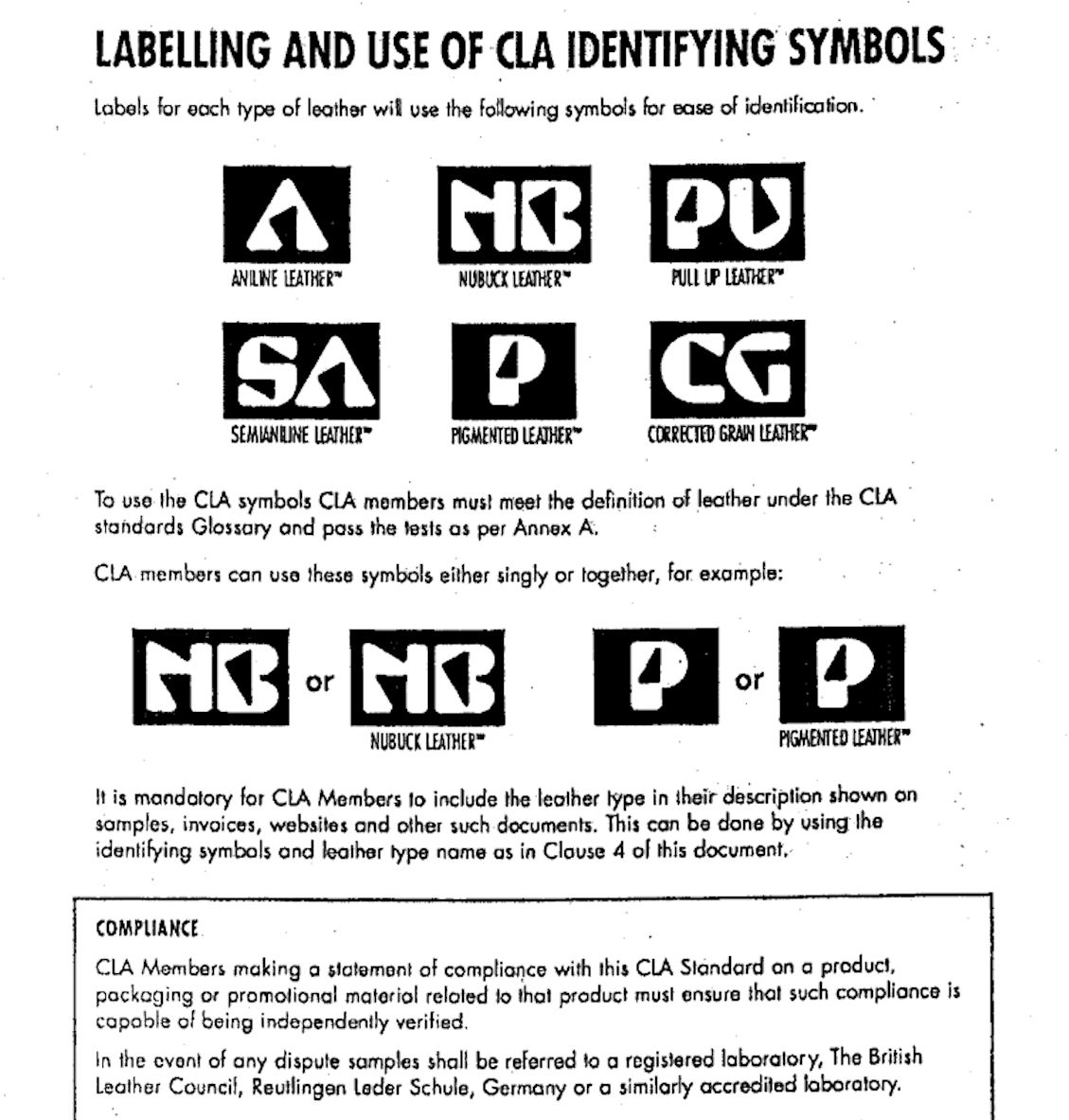
These symbols were specifically devised by the Commercial Leather Association of Australia and New Zealand to help consumers of leather upholstery judge quality, and were registered with the Australian Competition and Consumer Commission (kind of like the US FTC). The original CLA filing for the "CG" symbol for "corrected grain" can be read on-line, and there we find (page 2), not just wording defining leather that is almost identical to the British Standards (BS 2780) in use in the UK (including the common 0.15 mm maximum limit for any surface coating), but also a description of "corrected grain" (our emphasis) as: "The leather is drum dyed with the natural grain removed, a heavy layer of pigment and protective finish is applied. The leather is then embossed with an artificial patterned grain, which provides a uniform appearance, no natural markings such as scars, growth marks, fat wrinkles. Lower grade hides are selected for this type of leather treatment. Specific technical characteristics and test methods" are described in a table appearing directly under this paragraph, which includes standards for both pigmented (painted) and corrected grain in tear strength, colorfastness to rubbing, acidity/alkalinity, and finish adhesion. From this we can see that it's the fake finish itself --the presence of a heavy surface coating on both pigmented and corrected grain-- that forms the basis of the divide in quality and durability of leather. This document also shows (page 4) some consequences of first, second and third "breach" by any "repeat offenders" using the CLA symbols for inferior leathers, after which they are kicked out of the association, and possible consumer notifications and even legal action for damages can ensue.
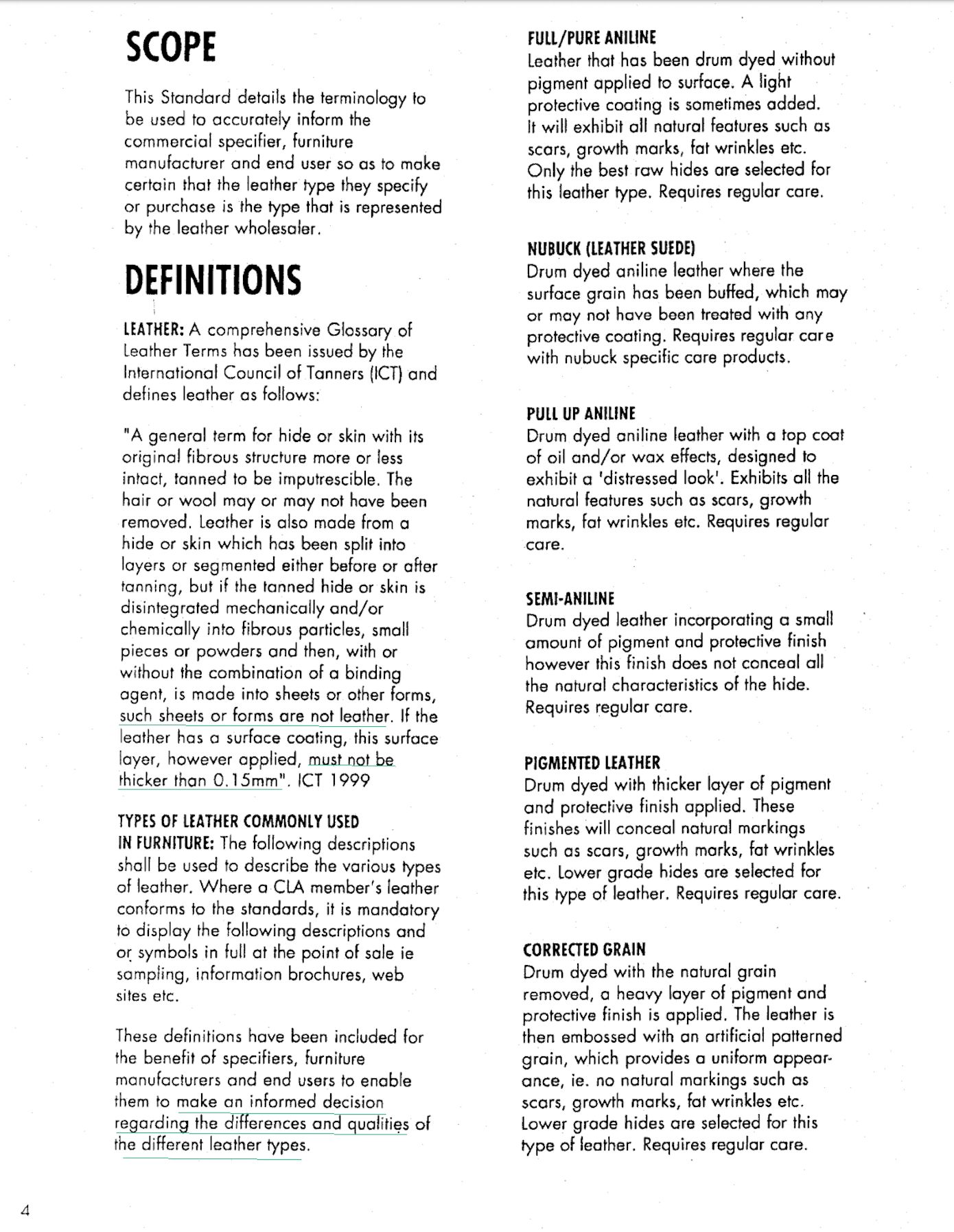
As we can see from the definitions above, it's very different in Australia from the situation in the US, where the FTC has already concluded back in 2008 that American consumers are simply incapable of understanding any distinctions among grades of things made "in substantial part" of leather, and would only be confused by any efforts to inform us about the presence of unnatural surface coatings like paint and plastic. (Makes you wonder, what exactly does the FTC think is wrong with the intelligence of Americans, such that Australians have had no trouble grasping these things, but Americans would be "hindered" by the truth, wandering zombie-like in a befuddled state. Is it something in the water, or what?)
It's precisely because split hides with any degree of coating have already been deemed to be just fine in the US, no distinction needed between full-grain and faux-grain since '96, that potentially applying the paltry consumer protection standards of 'the Leather Guides' to upholstery leather is a mess. It's likely partly why upholstery has remained excluded from the 'Guides,' including in the 2008 review, because it brings things into sharp focus. Leather upholstery is in fact the most comprehensively regulated product in terms of leather quality standards in just about every other developed country in the world. Many of the standards were formalized and defined specifically for upholstery, as we can see by looking at the Australian case in particular. And some of this focus no doubt arose from the fact that getting scammed on leather furniture can easily mean a loss in the five figures, where full-grain full aniline is sought, but split hides or --again, only in the USA-- even such a lowly and vile composite product as 'bonded leather' might be legally passed off as the best grade of full-grain. To see just what this means, it's worth taking a look at some images of what bonded leather really is, from someone who took the trouble to have an American lab analyze the material, and then submitted the results to the FTC for the their 2019 review of the Guides. See the submission by Thomas Paciorkowski, Esq. to the FTC, which includes the magnified image of the fiber analysis conducted by the Leather Lab of the University of Cincinnati, below.
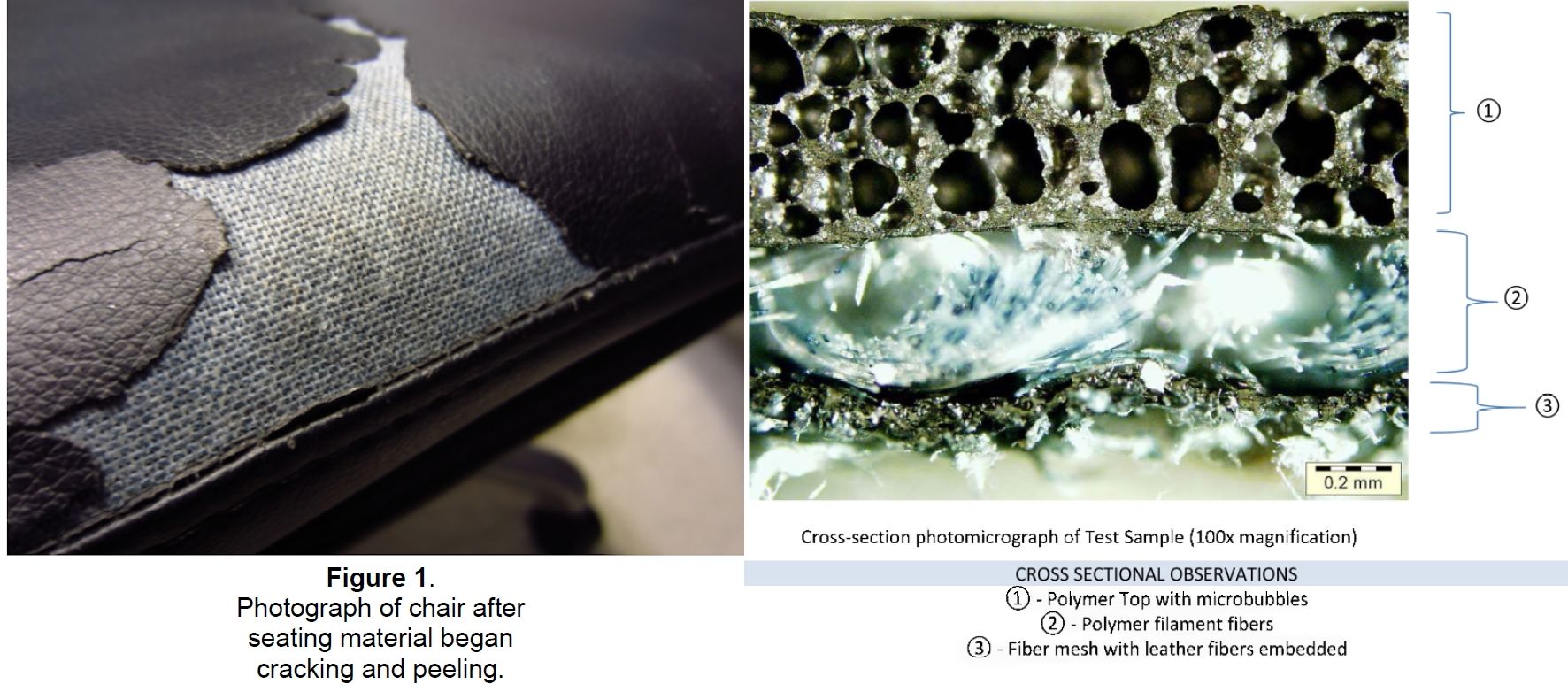
And that is 'bonded leather,' a slurry of plastics with some degree of leather shavings sprinkled on the back, basically in order to be able to call it "leather." (How many grains of sugar should we give them with the sand? How many flakes of real peppercorn with the dirt from the warehouse floor? There's a real similarity here with 'bonded leather.') Many Americans paid for leather chairs or sofas, described as "leather," and this is what they got, as the flurry of lawsuits and various consumer complaint stories appearing in local media outlets around the country has made clear over the last few years. (Some sellers had even had the audacity to imply that "bonded leather" was actually better than 'ordinary leather,' as though 'bonded for strength and stain resistance' or something.) And all perfectly legal as far as the Leather Guides, not because they don't specify disclosure of the particular percentage of allowable leather shavings in 'bonded leather' --they do-- but because they still exclude upholstery altogether, along with automotive leather. Of course, when what at first looked like and was described as "leather" deteriorated so rapidly that suspicions were raised as to its true materials content, people started looking into the legality of this stuff, and how wasn't this fraud, filing suits, raising questions about the FTC's exclusions, and making submissions during the comment period for their latest review earlier this year.
This kind of consumer-defrauding is exactly the sort of thing that could never happen in Europe, where sheets of pulverized and reconstituted leather shavings mixed with plastic are never allowed to be called and sold as "leather" really anywhere. But it's also exactly the sort of thing completely prevented by the leather symbol system in Australia. And why? Because Australians have had the benefit of knowing what kinds of leather exist. They weren't 'confused' by it. Instead, those symbols serve to warn Australian shoppers in advance about the cheap, new, rapidly deteriorating products made possible by modern industrial processing. Because the CLA polices what is being sold by its members, people walking into a furniture store immediately see that leather furniture is designated as to specific grades of materials. Pricing follows these grades. Everyone gets to know what 'full aniline' means, and how that real leather lasts and improves with age when compared to, say, corrected grain, which is priced much lower for that reason. Corrected grain might or might not be better if you have pets that go on the furniture, but it will certainly cost you less. It will never cost you as much as full-grain full aniline, no matter whose logo might appear on it. This is a significant improvement over the US situation, in practice and in principle.
But it gets worse, in the US, because even if 'bonded leather' were mandated to be disclosed to consumers of leather furniture (i.e., revising the 'Leather Guides' to cover upholstery at all and setting a lower limit, as a percentage by weight, of acceptable leather shavings mixed into the latex/plastics in "bonded leather"), a wall is hit immediately when we realize that consumer protections for leather furniture around the world are not based on how to label 'bonded' at all. Rather, bonded/pulverized is simply banned outright as not being real "leather" anywhere. Instead, all of those systems of consumer marking in other countries deal with specifying and limiting the surface coatings. That is, they're all based, whether formalized in law or by voluntary industry participation, on exactly the criteria the FTC already decided were useless and irrelevant when the Leather Industries of America suggested such a system of grades/definitions in 2008.
This is why the 2019 FTC review of the 'Leather Guides' has a farcical quality. The current total exclusion of leather furniture from American regulation as leather is almost the polar opposite of the situation in other countries, where not only is upholstery the thing most tightly regulated, but it's regulated by specifically limiting faux-grain coatings if a thing wants to be sold as leather at all. That is, the criteria now used everywhere else are exactly the criteria the US FTC decided a decade ago were "unnecessary" and too hard for Americans to understand. Here things made with any kind of plastic-coated and painted faux-grain are "in substantial part" leather, though they're not in any comparable place where consumers have protection. It's a problem for the FTC, and it's one they made for themselves.
Finally, let's look at Germany, where not only are leather quality standards still alive (witness the source of the leather-dictionary.com site, possibly the most comprehensive leather site on the internet, including in English), but something that might work as a model to correct the US situation is in place. Germany's is a voluntary system of consumer marking --the Blue Angel/Blaue Engle-- and the mark is recognized by 90% of consumers, in part because it's been in place for 40 years, and it works. Although it was initiated by government action, it's administered by third parties, which is possibly a useful framework for the US when it appears no help from the government, per se, is likely to be forthcoming while the FTC maintains anachronistic and bizarre criteria like "in substantial part" leather. Better still, the Blue Angel is an ecomark, and one of the most well-known globally. We think this combination of environmental and consumer protection rolled into one quality mark makes a lot of sense in terms of sustainability. One of the darkest aspects of disposable one-year-warranty leather goods, including handbags in their millions (how many women do you know who don't have at least one handbag?), is where all those plastic-coated quickly worn-out bags will go in a year or two. They'll be headed off to a landfill, where they will remain, in some constituents, for next 1000 years. Great. Was it worth it for that disappointing one year of use? We don't think so.
So in Germany, while there are no strict laws as laws for labeling, instead a standard (RAL 062 A2, Delimitation of the Concept Leather from Other Materials) developed by the industry is administered by RAL (RAL gGmbH, German Institute for Quality Assurance, Deutsches Institut für Gütesicherung und Kennzeichnung), which awards yearly certifications to applicant manufacturers in the form of the Blue Angel symbol. Manufacturers are allowed to use the Blue Angel mark on their products if they pass all the tests. This is a little blue and white symbol with a laurel wreath which you find on the paper tags accompanying products for sale, and it's widely known by consumers (especially with leather upholstery, what a surprise) as a trustworthy guarantee, not least because the standards are high and there is supervision of compliance via lab tests. The courts also generally follow the RAL standards, if the need arises, in deciding cases, so no one ever ends up stuck with 'leather' chairs like the one in the photo above...it would be impossible.
The Blue Angel is a guarantee that the leather is real leather, including differentiations of full-grain full aniline, full-grain semi-aniline, and recently even a more narrow designation as semi-aniline, refined (where any pigment coating should be below 0.015 or 0.01 mm in thickness). But it's better than just a coating threshold, because it's actually a reliable ecomark. Environmental standards must be met as well as consumer quality standards, and this --if a comparable device were in use in the US market-- would more than compensate for the lack of any distinctions between "in substantial part" grades of leather as per the FTC. Consumers would benefit, but so would ethical and environmentally conscious manufacturers. We think this is the way of the future.
The standards manufacturers must meet in Germany (and this is not just for leather, but for all kinds of products) cover all phases of production, waste handling, and even worker protections as would be governed by OSHA in the US. For leather this means a variety of chemicals and dyes are regulated (dodgy ones banned outright, and if you want Blue Angel certification, you switch to something safer), but so are processes specific to chrome tanning, including verification that no hexavalent chromium exists in the finished leather. All chemical constituents have to be disclosed, which makes nebulous frankenleather basically null. It also means that competing products like murky imports from China with no track record on production methods, labor conditions, or chemical content are not on at all the same footing in the marketplace as Blue Angel-verified products. No wonder this standard is popular. In fact it was the first worldwide ecolabel, introduced in 1978 by the German government but taken up by the industry, now overseen by a third party, and forming the model for many later ecolabeling standards in other countries. There's a lot to recommend this model.
So technically the standard says, "a material in a quote or purchase can only be described as leather, genuine leather, or with an expression which, according to the trade view, refers to leather or a type of leather (e.g., box calf, nappa, nubuck, morocco, etc.), which has been manufactured from the unsplit or split animal hide or pelt, through tanning or retaining the fibres in their natural condition. For leather with a surface coating, respectively from synthetic material, foil or lacquer, the coating added must not be thicker that 0.15mm." Our italics. And there it is again, the usual 0.15 mm as the cut-off for coatings if something wants to pass as "leather." Trade names are also regulated, and can't include known leather terminology (e.g., nubuck, morocco) for things that don't meet the standard that fibers remain in their natural condition (that is, not pulverized/'bonded'), and if coated at all, that extraneous surface material be under 0.15 mm in thickness.
If this kind of standard existed in the US, there would be no reason for this screed. There would also be an easy insignia we could all look for on products across manufacturers, and know the leather wasn't sourced in unethical ways in some unknown thirdworld country, worked up in a sweatshop in yet another unknown country, and brought into the US leaving a swathe of pollution where it came from and bound to continue to harm nature after our sad year's use of it. A single mark that took in fairness to consumers, fairness to workers, and fairness to the environment is something we feel very sure Americans could understand, whatever low regard the current FTC may have for us.
We think an ecolabel with the guiding principles of the Blue Angel model could possibly solve some real problems in a relatively easy way, and without even a list of proposed terms, as the LIA suggested, in the (hardly functional) 'Leather Guides.' Just a symbol for intact-grain leather would be enough (and it's important to remember, this isn't crazy as only the grain layer could be called "leather" in the US until 1996). A single mark would be easier than the many 'Sure' marks used in the UK, and even easier than the initials marks of Australia. And if such a quality mark were based on the Blue Angel, it could be an ecomark integrally. Vegans would finally be safe from unknowingly purchasing things that contained animal products (this is a real problem, as things like 'bonded leather' show), and there would also be an assurance that nothing harmful was lurking in now largely-petro-chemical pleather, either. Mycoleather, sustainably made from mushrooms and sometimes known as Muskin now, would be accelerated in its displacement of petro-chemical and non-biodegradable PVC leather substitutes, possibly even helping to raise awareness of the real tolls on the environment casued by our reliance on cattle as a food source (major emissions come just from cows, along with a massive squandering of land in forest destruction for pasturage). Consumers of many mindsets would benefit. And if products aspired to a standard that awarded a symbol you could see at the store --or on the web-- and trust, knowing it meant a thing was what it said it was in materials, was produced in environmentally sound ways, and had some kind of accountability behind it, who wouldn't want that? Who wouldn't be willing to pay a little more for something that bore a known mark that guaranteed you could trust it and feel good about its longevity, origin and footprint?
Interestingly, a mark like that is almost exactly how the old Coach creed functioned, isn't it? Remember that early tag line, "the finest...for just a little more"? This was what made Coach special as a company: the ethics and basic integrity of Miles and Lillian Cahn. We really think this, as manifested in everything from their respect for their workforce to the reliably high standards of their products, is what made their Coach company a success. And this is what the new Coach/Tapestry Inc. is actually taking away when they make a mockery of the creed, turning it into an ideologically and materially bankrupt "storypatch," a ridiculous "hug-it" call to leather-alchemy, or one or another bag-specific version of "iconic" egomania. The old Coach creed was a quality guarantee, plain and simple. It was like a Blue Angel for handbags, and it meant you were getting real leather, no plastic, made by skilled workers fairly paid, in facilities that met the standards of OSHA and the EPA. (The Blue Angel is meant to ensure high environmental standards in the manufacturing process, absence of harmful chemicals in the product, and good durability or suitability for use over time within its category of product. An old Coach bag clearly met these marks, at massive scale and completely voluntarily.)
We can't forget this significance of the old creed, let alone be bamboozled out of ever knowing what purpose it actually served. The Cahns actually provided a pretty good model for consumer-friendly leathergoods, and they did it against a tide of growing industrial duplicity in leather (notice how the old Coach ads stress, this isn't coated, this is natural leather, real leather, over and over). Specifically, their products proclaimed materials standards, and ethics, and traceability, stamped permanently into each item as the creed. Even today, sometimes decades later, we can see what year a bag was made and where it was fabricated. There's an accountability to it, which began as registration numbers for purposes of lifetime warranty and refurbishment, but the year digit in the second space of the number is good, too, and most people like that you can determine the age of a Coach bag by looking at that number, which gives it a sense of place in a timeline. It's almost the conceptual opposite of the throw-away faux-grain bags of today, from many manufacturers, and we can see this mindset --that things might "endure" more than a year-- is lost on those now running the Coach company by the fact that, several years ago, they eliminated the serial numbers altogether, and only brought them back after popular protest which they obviously hadn't expected.
There are so many of these 'what were they thinking?' moments lately, in everything from product design features (i.e., snakeskin on handles, both senselessly cruel and made to fail), to weird faux-70s imagery in advertising and on the runway (e.g., imagery of last Coach show described as reminiscent of "a bad trip" by more than one commentator), to increasingly bizarre marketing patter like the duplicitous revival of the leather-alchemy hug-it creed, now even extending to a tag line of, "Wear it out to wear it in." See an example of this, below, from a Dreamer bag. It would indeed require some heavyduty dreaming to believe that today's "Glovetanned Leather" is going to burnish like a full-grain full aniline leather of old. We hope you can see in the enlarged image (hit the magnify box), if you've made it this far, that this is obvious faux-grain. If any doubt remained now that Glovetanned Leather is just a trade name that glosses the post-1996 US meaning of "genuine leather," and the elimination of the old hyphen between glove and tanned wasn't enough to convince, all doubt is removed by the deliberate and otherwise grammatically incorrect capitalization of "Leather" here. "Glovetanned Leather" is now a Coach trade name for their version of "genuine leather," and that stuff is nothing like the full-grain full anilines of the Cahn's excellent old Coach bags. This is why people are angry. They should fix this, before it's too late.
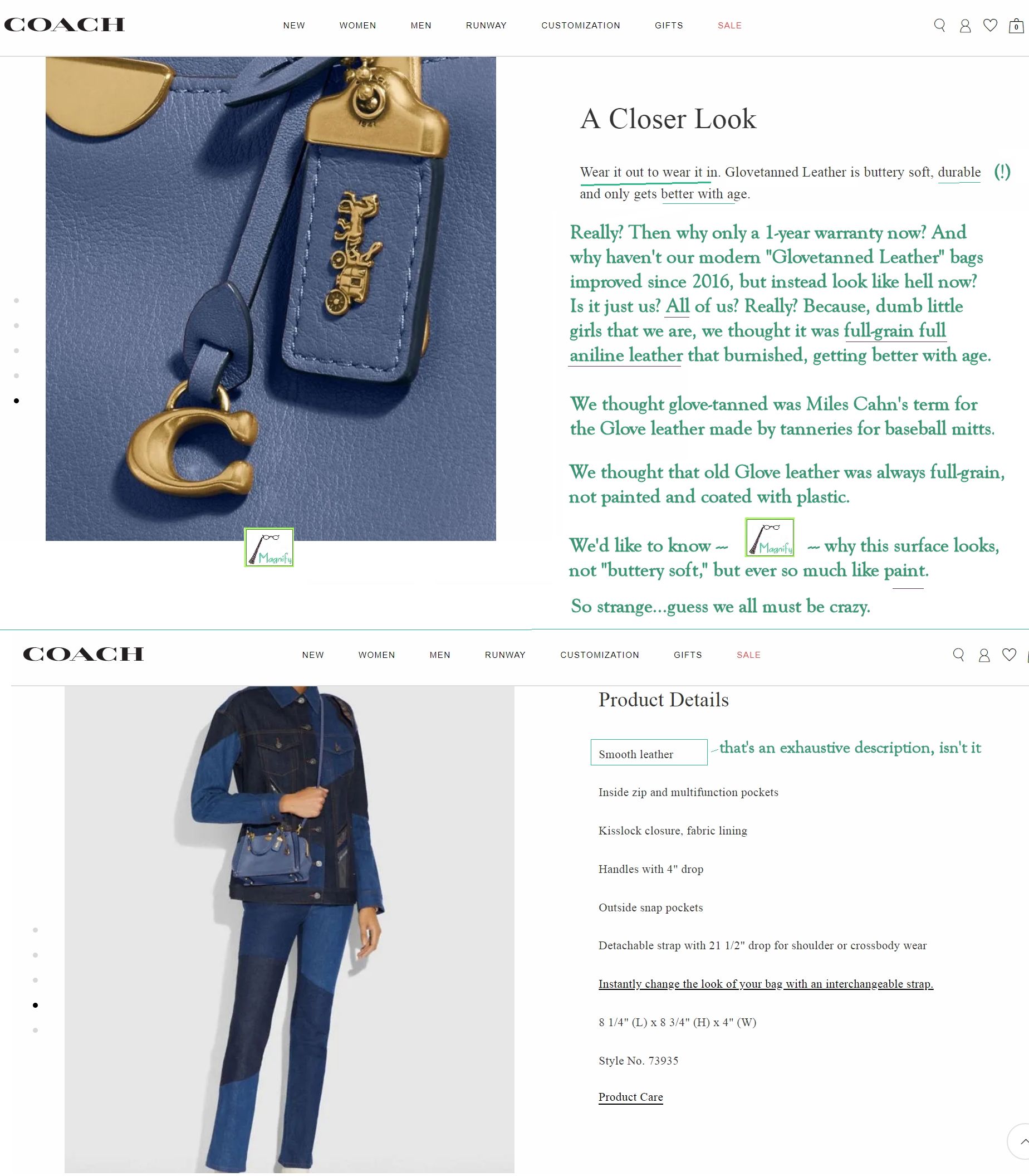
Now, maybe this issue of full-grain/faux-grain, especially subcategories like "pebble-grain" verses the new grainless "pebble leather," seems a bit tedious, but we think it's important that we all know what these leather terms mean, not just because new-Coach has grown very coy on the matter of leather quality lately, but also because the vast bulk of full-grain products we see around these days, described as such and of almost any type, are being aimed very squarely at (cis) men, from a lot of manufacturers, to the point that it's actually kind of weird. There is a subtext to it.
Apparently it's still widely thought that only (rugged, outdoorsy, straight) men can appreciate full-grain leather, not wanting to be swindled when they buy boots (e.g., Redwing video, "The leather will teach you"), wallets (Saddleback Leather does some fun marketing for briefcases), or bags (even Hermes makes it a point to describe the "reassuring grain" in a man's bag). It used to be that all Coach leather was full-grain, including all handbags. Coach stood out among leather goods makers in the past, being quasi-feminist, sort of androgynous in its marketing, and speaking to everyone as an equal: a like-minded, sensible person just interested in a good leather bag. If there is a nostalgia for old-Coach, that approach is part of what is missed.
And that demographic --the people who wanted an attractive, good-quality leather bag-- has not gone away. If anything, new brands and companies are rising to fill the hole that Coach (used-to-be-Leatherware) has left, which we can see in everything from Senreve and their Coda belt bag (just having a moment again when it was appreciated by Selma Blair, then seconded by Sarah Michelle Gellar) to Linjer and its Tulip bag, famously out of stock and with tens of thousands on a waiting list. Both of these newer companies are using full-grain leather, and stating it as such to the (presumably female) consumer. Senreve is a French company with a generally feminist bent, using Italian leather and even going so far as to specifically describe the finishing processes (tumbling, talking of tanneries, etc.) to women, much like old-Coach used to do in the creed. Linjer is Norwegian with production facilities in Hong Kong, but catering to a similar demographic, and bothering to use full-grain, stated as such, and adding that it will last "for years." Not one year, but plural years, again, as with old-Coach.
This isn't a coincidence. There is a demand for what Coach used to provide, and it's bigger than a rise and fall in a fad for designer handbags as such. Premising a concept of "transforming" (new-Coach's word) a leatherware company into a global 'house of brands' on an assumption that the target consumer is really just a frivolous little woman at heart, obsessed with ornamenting and status-decorating herself, swallows whole some very outdated ideas, and in fact misses the onward march of cultural history itself.
The tacit Western historical associations linking materials with gender (leather for men, fabric for women) are becoming increasingly attenuated the further forward in time we move, and no amount of cartoon dinosaurs or bunnies is going to turn that back. The reference points that linked leather with men and the public sphere date back to times of travel by horse (everything from grooms, stable boys, and footmen to armor, the fox hunt, the Wild West, and some idea of the public streets as the domain of men), and those days are not coming back. Similarly, the association of fabric and cloth with women is wearing thin. It's ancient and it runs deep (for example, it has everything to do with why men 'shouldn't' sew or decorate anything without risking a queer label, not mentioning the gender divide of "housework"), but the antecedents are so far removed from today's reality as to be almost unrecognizable. (You'd have to go back to the time of 'education' for girls consisting of 'refinements' like needlework and the skills of decorating themselves and their private domestic world of the home, or the days of drudgery for the majority of women, tasked with making their own and their families' clothing and linens, then struggling to keep it all ordered and clean with manual boiling and bluing of the laundry on 'blue Mondays.' Thankfully these are antique concepts now, dimly remembered if at all and having only an historical interest.) The gendered subtexts to materials are still floating around, but their origins are mostly forgotten now.
A derivative tacit weirdness of gendered materials exists in bags, too, which we can see by the fine line bags made for men tried to tread over the course of the 20th century. Briefcases and travel bags were safe, because their dedicated functions gave them associations --public world, powerful person-- that were safe. And they were almost always made of leather, which completely avoided the worries of fabric as a 'too-soft' material, too much like curtains and frills and long gowns. (Doubt it? Imagine a "businessman" of the mid-20th century carrying a soft briefcase made of fabric. See?) At that point, a man with a fabric bag, and especially one that was not expressly military (e.g., the duffle bags of sailors, the packs and ammo bags of soldiers) might even have been associated with an older idea, the 'carpetbagger' (a carpetbag was 19th century make-shift luggage made from actual scraps of carpet), or a "bum, a hobo." "Hobos" were supposed to carry bindles, make-shift bags always of fabric like a handkerchief or a blanket on a stick (which is actually where the idea of a women's hobo purse came from, the slouchy crescent shape resembling a tied up square of cloth). Now picture that "hobo" --notice, too, "bums and hobos" are always male-- with a leather travel bag. And suddenly that guy isn't a "hobo" anymore, is he? There are gender but also class and even race stereotypes tacitly expressed by bags. Bags carried in the public thoroughfares by any person are always speaking something in a much older language, whether every person can hear it or not.
From earlier stereotypes a pattern grew up over the 20th century and, as long as men's leather bags were rugged --this is a perniciously laden term-- it was fine. When it wasn't fine was when such a bag began to lack a dedicated (assumed male) business, scholastic, or outdoorsy function (not a briefcase, a hiker/military backpack, a schoolbag, a professional/doctor's bag, a messenger's bag, a travel case). If it veered too far toward a bag without a particular occupational function, risk entered. Why? Because that would make it a "purse." And men were just not supposed to carry purses. (By this point the older meaning of purse as a money bag was dead, as with pocketbook, which also was once a male business accessory. Memory of that older use faded away with the etui and reticule as carried by women.) In the 20th century stigma attached to men carrying bags on a general basis, without a good, specific reason. Only women were supposed to carry bags that way, which is what made them "purses" or "handbags." It was senseless, even idiotic really, but conformity was enforced and children learned the rule young so it has persisted for many decades.
And now, after all this time, that idea is finally starting to seriously fracture. Fault lines are developing fast, and phones have greatly accelerated it. Men have been carrying no-particular-purpose bags in Europe for years already, sometimes including vintage Coach bags made 'for women,' but something is afoot in the US now, too. And we know it because multiple Coachistas have experienced depletion of their vintage bag hoards over the past few years -- due to bags being 'borrowed' by husbands and boyfriends, in one case, 'borrowed' six years ago and now basically his. And they're not the briefcase styles, which were always unisex, but smaller bags, which is something new. (These men are not known to each other, yet they seem to have particular favorites, and not necessarily just the ones you might expect, like the 70s messenger/saddlebag styles in black or brown that were always fairly neutral. Multiple small black bags have been commandeered too, often with modifications made to the straps, dinky and penny bags, station and murphy shapes, several passport-style bags, and still others without names.) Why is this happening? Probably there are a lot of reasons, but the obvious ones include the need to carry a phone or a tablet all the time, an absence in the market of high quality bags in similar small sizes and basic shapes pitched specifically to men, and the fact that everybody just likes the way old Coach bags burnished and softened over time. It seems to indicate two things, at least. The first is an opportunity for makers of leather bags to buck outdated gender conventions --kind of like old Coach always did-- and make bags for everyone in all shapes and sizes. And a chance to literally double your consumer base doesn't come every day. The other implication is that men still have some feeling that they 'should' know something about leather quality, and therefore most of them have picked up and retained some idea that full-grain is better and burnishing is good, even if they know this from things as disparate as cowboy boots, 50s biker jackets, Berluti shoes or horse tack. The good full-grain leather in Coach bags seems to be why these are felt to be acceptable to 'borrow,' while there has been no interest in any other brand of handbag, vintage or modern.
If we consider that Coach had been a wholesaler of men's small leathergoods before 1961, then shifted into mostly women's handbags in similarly high grades of leather for about 40 years, we can see that a change in the quality of leather used was going to cause problems after the spin-off by Sara Lee. Even after Coach became publicly traded and production was shifted to China, there was an intermediate period where the men's line still mentioned leather quality (i.e., being full-grain), likely because there would have been confusion and pushback if it changed gear very suddenly. It was still assumed that men probably knew something about leather quality, and so a rapid and total shift to "genuine leather" wasn't possible. A similar sense that too many women had come to expect a Coach handbag to be superior leather may also explain the bags of the 2001-2010 period, full-grain retained but not full aniline or natural surface. The glut of fabric bags with leather trim really helped to blur the issue, as did logomania more generally, but it's worth noting that men were not generally pitched CC logo fabric items, even at the height of logomania. Too many of them still expected leather (especially in belts, wallets, certainly briefcases, 'traditional' items) to be a good grade of leather in order to be acceptable for the money. There was some awareness that adult men thought Coach things were good because the leather was better, not because the Coach logo was worth anything in particular to them as just a brand logo. But, as so much of the recent "Rexy" crap shows, even this idea is being axed now at new-Coach.
What it's being replaced with is far from good, or progressive. Apparently it's assumed that no one really knows the difference between good and bad leather anymore, but if anyone does, it'll still be "businessmen," the last holdovers. The revised Musette bag, originally an early 70s Bonnie Cashin design for everyone (mainly because no one else was making semi-business bags like that for women), is now presented to "today's businessman." And look at some more recent screengrabs from the Coach site, specifically how a "Rogue" briefcase (that name...oh, how dangerous, rebellious, outlaw-worthy, right?) listed in the "Men" category is described...as rruuggged! (Those handles are almost growling, they're so rugged. Because he's still "The Boss." But only of "embossed pebble leather.") And unlike things marketed to women, He-the-Boss is warned in advance, 'now don't think you're getting real pebble-grain anymore, no, it's just embossed on a faux (sanded/split) surface,' which seems intended to weed out any potential whiners who still expected Coach to make full-grain bags in real pebble-grain, as they always had before. But that's only a worry with the (business)men, everybody else being assumed to be dumbed down enough now not to notice. We'll know zero of leather quality, obviously, but may actually be so benighted as to need new-Coach to find plastic faux-unique mementos for us, too, as we can see on the uber-gaudy hot pink bag on the right. And guess what part of the site that appears. The "Women" area? No, you're kidding.
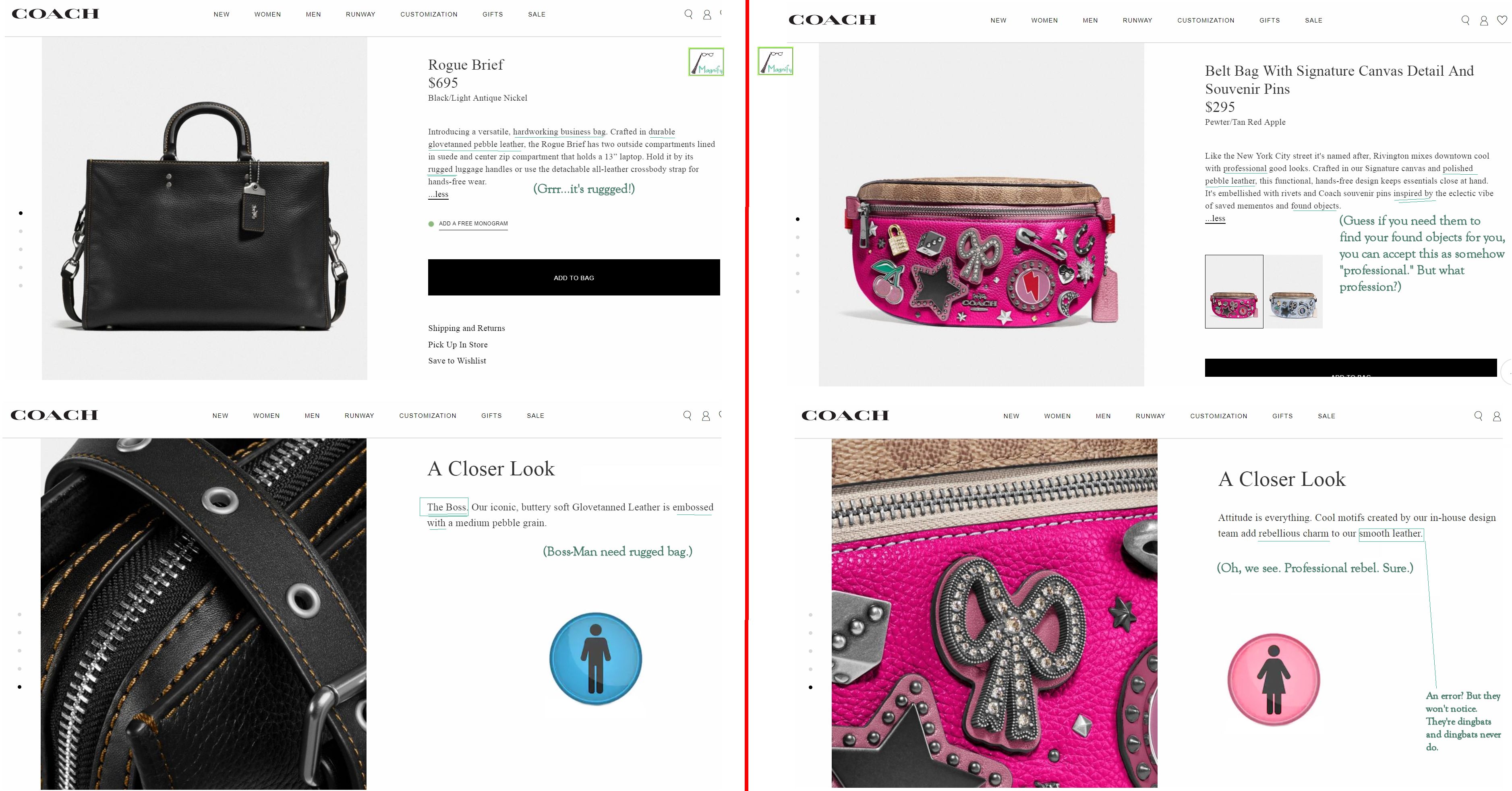
So the stark contrast between the old-Coach gender-neutrality and the new-Coach tendency to exaggerate anachronistic stereotypes had already sparked a discussion about increasingly gendered advertising, especially if compared with the relative 'humanism' seen in the 70s ads where the classic Coach bags were defined by the company. Those days are long gone, as we can see above...don't cross that red line now, boys and girls.
All of this was bad enough, but then, in late June, new-Coach sunk to unimagined lows, and dropped an unbelievably queerbaiting "50 Years Proud" video --below-- to commemorate the 50th anniversary of the rebellion at Stonewall.
And we take this with deadly seriousness. That choice by new-Coach broke the heart of the most knowledgeable Coachista any of us ever knew, and the person who coined the term Coachista in the first place, back in the 80s. (She hated the new and cutsie corporate "Coachie" as a term and saw Coachistas as the informed, woke connoisseurs of Coach bags.) Estelle taught a lot of us much of what we know about Coach bags and leather quality, but also about heart, fearlessness, and having the courage of one's convictions. She was a heroine. And she was fighting for her life at the 50th anniversary this year. Some of us will never forgive new-Coach for that video 'statement.' We lost Estelle, the Ultimate Coachista, to pancreatic cancer on July 12th and with her went an encyclopedic knowledge of both leatherworking and of Coach bags that can never be replaced. With her also went a history of the Gay Liberation movement that is at risk of being forgotten or distorted. In particular, with her went an awareness of the real import of handbags as a political statement in the time when transwomen risked their very lives to carry a purse on the street. The irony and stupidity of Coach --the handbag company-- not understanding enough to even pick up on this, though they'll splurge on an otherwise irrelevant song and dance number...is vile. And therefore, we feel driven to tell others about Estelle and the effect this had on her.
It's worse to be noticed, but mischaracterized, than not to be noticed at all, and this is what cut Estelle to the quick. She had loved handbags even as a child because "carrying a bag is like taking a friend with you," but it also became a physical manifestation of her true self, her real identity, which she had grown up having to hide. She had physically fought off anti-queer attackers in the streets for decades just for carrying a purse. Sometimes it was a Coach purse. In the last weeks of her life she had been assembling photos of and notes on her heroines --with their handbags-- in the hopes of posting this information while the 50th anniversary was still fresh in people's minds. But she left us before she could complete it. In honor of Estelle, we are going to attempt to do some of that work, to the best of our admittedly inferior abilities, to try to explain her reaction to new-Coach's "50 Years Proud" song and dance number, and what should have been said instead. There is a reason Estelle was heartbroken by it. We believe everyone needs to know about this.
Estelle's take on "50 Years Proud" was that it was a direct slap to the memory of Marsha P. Johnson and Sylvia Rivera. Sadly, many of us didn't even know who they were at first. But now we do. Now we do, and we'll never forget.
Estelle felt this video-ad was worse than pinkwashing as the 70s imagery, the period, and the people (rather frivolously) referenced, were actually the apex of something: a time when carrying a handbag was a radical act proclaiming full personhood, fraught with danger and holding a deeply socio-political significance. It could literally get you beaten to death. The activists of that time were advocating for nothing less than revolutionary change because that's how deeply entrenched the binary gender norms were, enforced with extreme violence. Coach --the handbag company-- had a golden opportunity, one that will probably never come again, to make a wider public aware of these facts and to speak, not just to the choir, but to everyone, all genders, all races, all people. And they squandered it in the worst and most queerbaiting way, as though they could capitalize on the symbolism of Stonewall, while demeaning the very people whose courage and true defiance --not the fake new-Coach "defiance" we see in their 2019 ads-- changed the world. The grandpeople of this movement spent their youth and their strength fighting so that the generation that is young today wouldn't have to endure that brutality. And now this mega-corporation will trade on their struggles without even mentioning their names? It is heartbreaking.
The Cut also immediately connected Coach's video with Marsha and Sylvia, who are about to be honored --finally-- with a monument in New York City. Pressure for some kind of recognition has been growing for years, especially in NYC. And there's Coach, among the brands loudly sponsoring this year's Shanghai Pride festival, but ignoring these heroines at home. But then, both Marsha and especially Sylvia would have torn to shreds any corporation exploiting their struggles and efforts to truly help the queer youth of NYC, most of whom were homeless and destitute when STAR was formed. But this didn't stop new-Coach from trying to commercialize those struggles, with a massive outlay of cash on a glossy video that is vague, self-serving, and entirely silent about anything that matters. It also didn't stop them from making a highly publicized yet comparatively minor donation to Hetrick-Martin, which is and was a near opposite to the revolutionary efforts of STAR (which was clearly first, not HMI). The funds that Tapestry/Coach has could have made a real difference for small, struggling groups like The Marsha P. Johnson Institute. But Tapestry/Coach would never do that, would they? And we now perfectly understand Estelle's heartbroken rage over this.So now for some truth, in honor of an important contingent of early Coachistas: the pioneering transwomen, the drag queens, the flame queens, the "fags with bags," whom all should know about, but few do. There would have been no T in LGBT without them, let alone LGBTQ+. There would have been no marriage equality without them. There would have been no Stonewall Rebellion without them. And Coach could have remedied this glaring erasure in a very public way just now. But they didn't. They didn't.
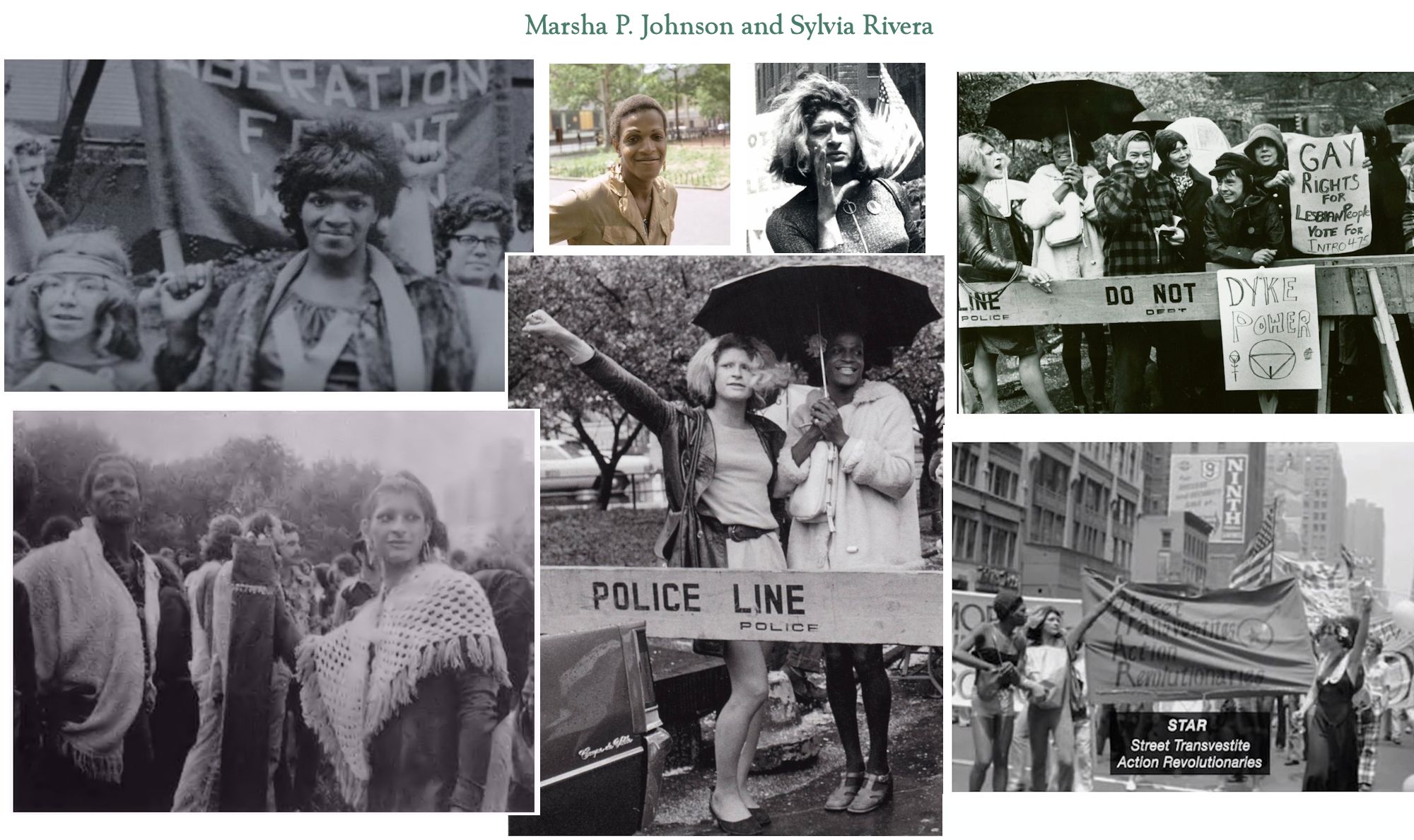
There aren't many original images from the Stonewall and Gay Liberation era (because the media didn't cover 'gay issues' at that point), but one thing jumps out again and again: the handbags. And the sheer bravery needed to carry a handbag in that place and time at all. Why? Because it was understood as a symbol of women. Merely holding one was a radical act that put you in danger, first because women had long ago been socially constructed as a victim class, weak and helpless, but second because social strictures were very sharply delineated. If you didn't look 'feminine' enough to 'pass' for a woman, you could be killed for it, by police, vigilantes, packs of men of all kinds. And many were.
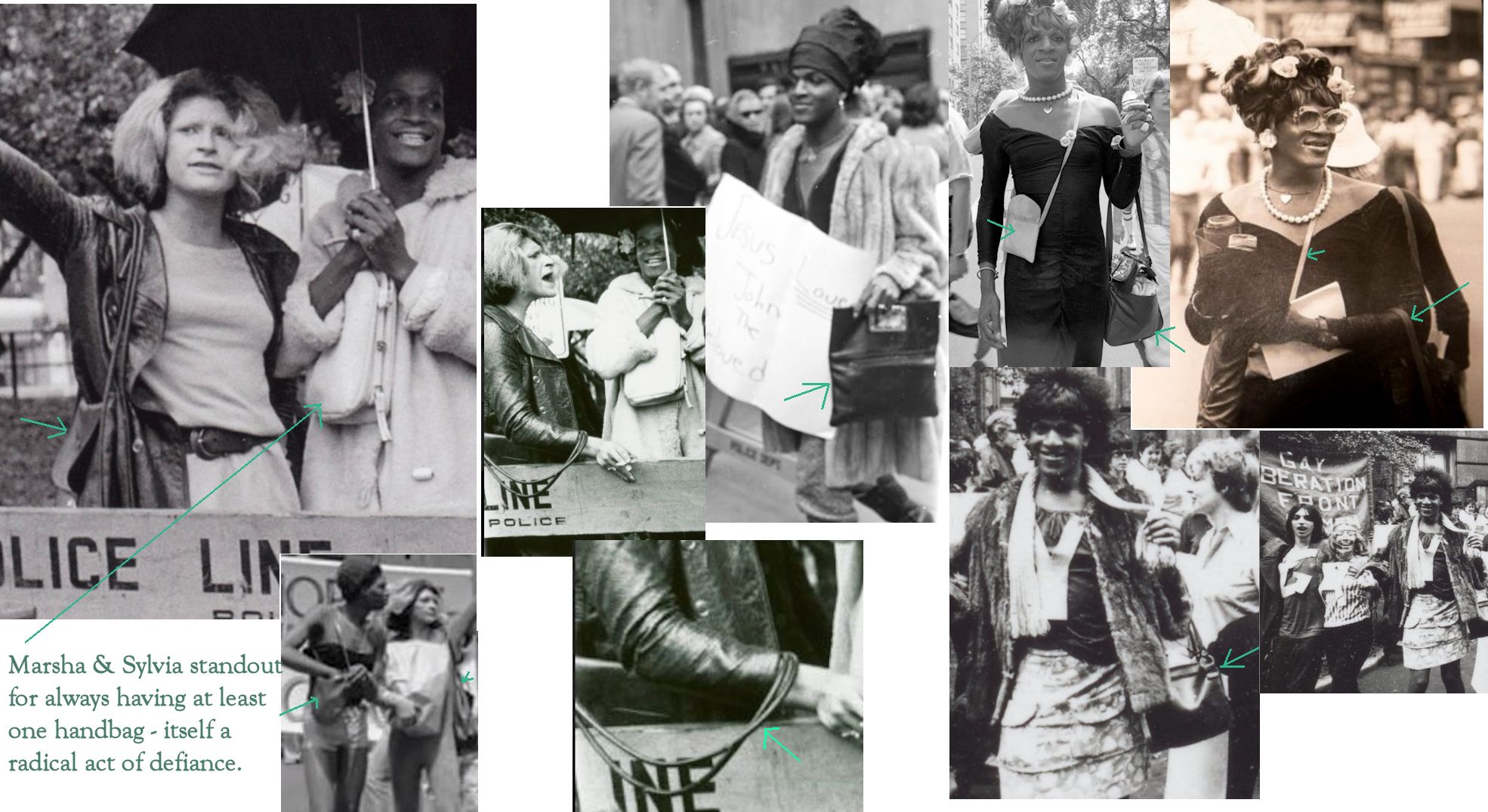
The transwomen, going by many terms and identifying in a thousand different ways before the modern terminology arose, both before and after Gay Liberation became a mass movement, knowingly defied the most violently enforced social dichotomy. They had been out in the open, including in the streets rather than just behind a bar's doors, for years by the time of the rising at the Stonewall Inn, and they knew they literally risked their lives. Why the hell didn't Coach --again, the handbag company-- recognize at least the most visible, bravest, and important of these heroines by name? Purses and handbags were a real issue on account of the "three pieces of gender-appropriate clothing" that the police used as a rule back then. Carrying a purse was almost like wearing a target. Carrying a tote was a grave risk, too, and you needed a tote because often you couldn't leave from or return home "in drag" without risking being evicted, beaten, firebombed. Many people largely lived out of tote bags because you couldn't safely sleep where you were known to be a "transvestite, a queen," a transwoman. Anything could happen. You were a criminal and the violence was just as likely to come from gangs of 'ordinary men' as from the police. This is how bad it really was. It's also why bags --stuffed with your true identity, your makeup and clothing and shoes-- were such an issue.
This is why the bags Marsha and Sylvia usually carried are significant. Both Marsha and Sylvia were in the vanguard of the vanguard, as it was only shortly before the rebellion that drag queens/transwomen were even allowed to enter the Stonewall Inn at all, which was essentially a mafia-controlled gay men's bar. It was the poor and often homeless transwomen, often surviving as sex workers and openly despised by all echelons of society, even including sections of the (assimilationist, Mattachine) gay community, who had nothing to lose, and so they risked it all, to be themselves, not in a whisper, but out loud. Their sacrifices made it possible for the transwomen and transmen of today to walk the streets in greater --though hardly complete-- safety. They led the way by being dangerously visible while others hid, and they paid the price. In some cases, they paid it with their lives. The improvements of today --for everyone-- would not have come without them. Everyone should know who they were.
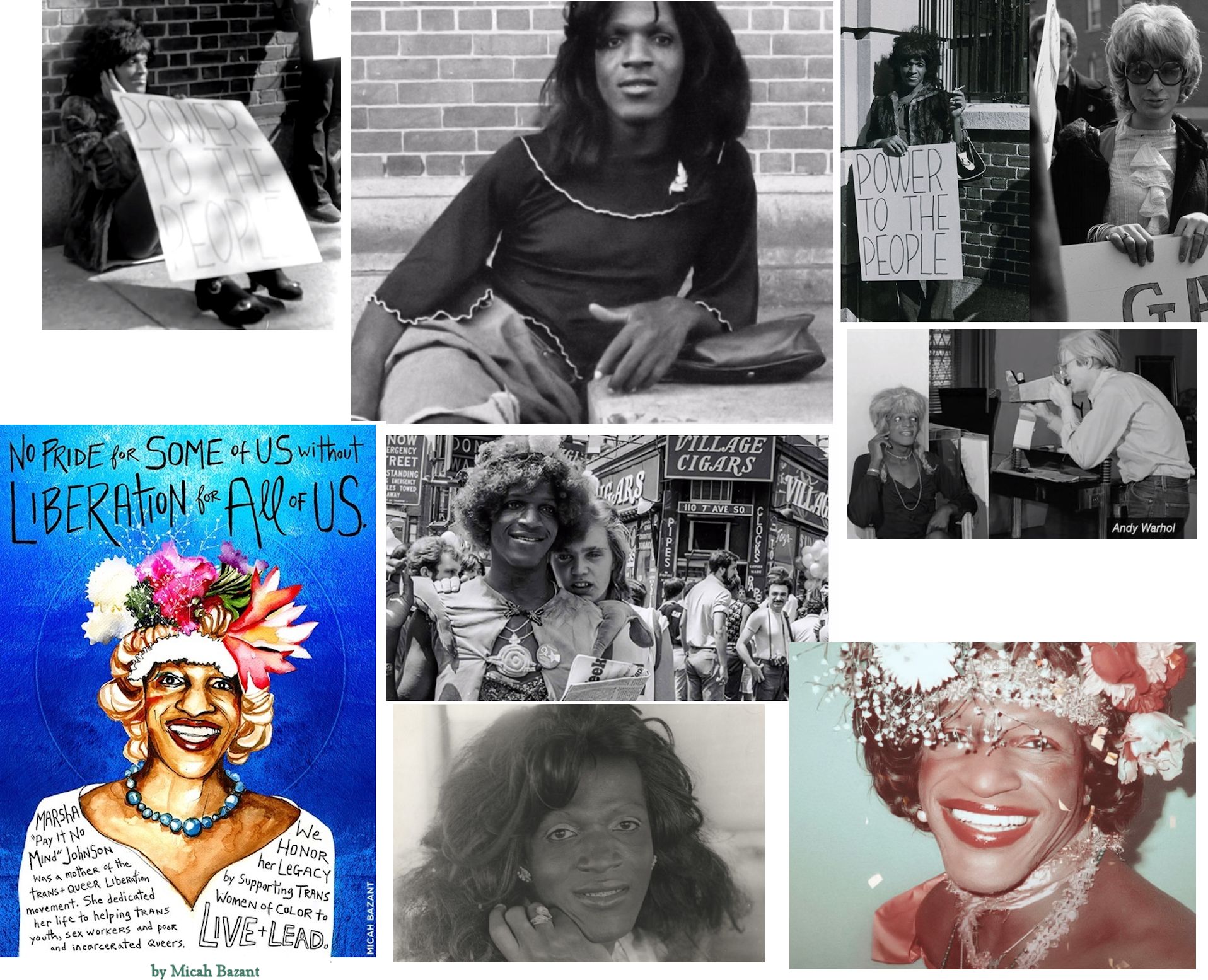
Several witnesses have said it was this Black transwoman, Marsha P. Johnson, who ignited the Stonewall rebellion. In some accounts, the first retaliation was by a transwoman who, when shoved by a cop, hit him in the head with her handbag, and some have said this was Marsha. (It is definite that trouble began inside the bar when "transvestites" or "cross-dressers" began refusing to line up and submit to "anatomical inspections" by the police, prior to arrest. This had all become normalized -- until that night.) The more commonly heard account is that, just after the fierce unknown lesbian/transman (now thought to be the bouncer, Storme DeLarverie) was dragged out in handcuffs bleeding but physically fought four cops, screamed to the crowd to "do something!," then broke out of the police car and vanished into the crowd, it was Marsha P. Johnson who threw the first object, "the shotglass heard 'round the world," which touched off the hail of coins (symbolizing payola), bottles, stones and the true rising, where for the first time, gay people rose up and physically fought back --successfully. No one is really sure exactly how it started, as accounts conflict, but the police barricaded themselves in the building for protection, a parking meter was used as a battering ram, and eventually the bar was set alight. (Deputy Inspector Pine, commander of the NYPD vice squad and the man who had planned the raid, was a veteran who had seen combat in WWII. He later described it as the "most scared" he had ever been in his life, though he did later say they had been prejudiced, had never expected any resistance from the gays, and had no idea what gay people were about then. By the end of his life, Pines went on record saying, "If what I did helped gay people, then I'm glad," which surprises many people today. There has been marked positive change in the wider society.)
The street battles went on for several days and all accounts place Sylvia and especially Marsha at the forefront. By Day 2 Marsha was seen scaling a lamppost and dropping --guess what-- a handbag with stones in it, which smashed the windshield of a police car and distracted the cops who were clubbing and teargassing people below. With Sylvia (she always gave all credit to Sylvia) she went on to found STAR, was a founding member of the Gay Liberation Front, was active in Act Up, and was present at every Pride event up to 1992.
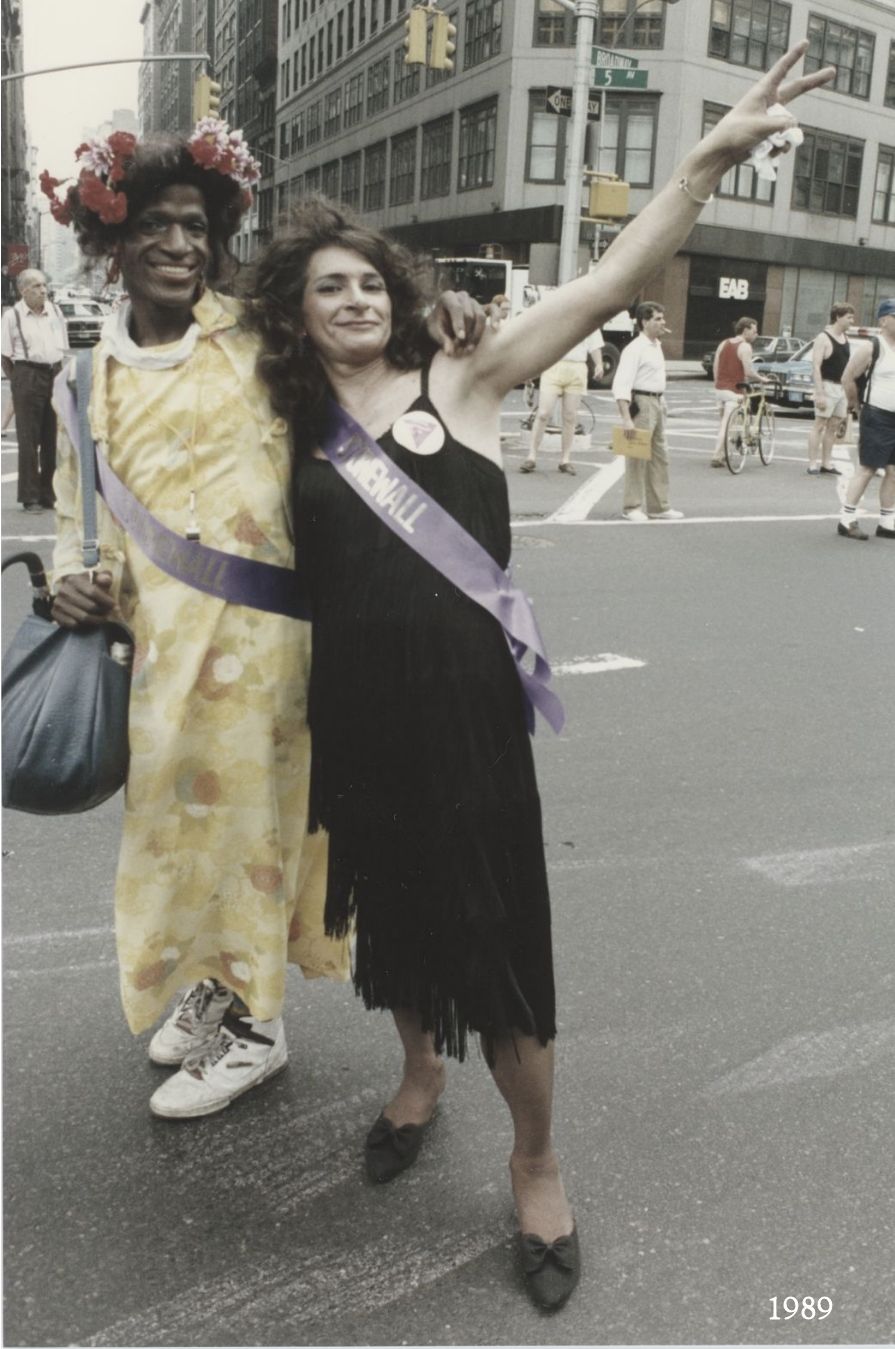
And this is really why it's a travesty for Coach to make that 50 Years video and not even mention Marsha P. Johnson or Sylvia Rivera. Where are they now, these heroines of Stonewall? Sylvia was almost drummed out of the movement for raising both trans and economic and racial issues, reappearing only a couple of times decades later, but stricken down at 51 by liver cancer in 2002. This is bad enough. But where is Marsha? Marsha disappeared four days after Pride, 1992. Her battered body was found in the river -- the same Hudson River she had been thrown into by homophobic attackers before, but swam strong and miraculously escaped. But this time she couldn't escape. She was only 46 years old. As they usually did when the victim was a gay person of color, the police declared it a suicide, even though there was a serious wound on Marsha's head. Rumors at the time said witnesses had seen her being hassled by a group of men and anti-gay epithets being hurled at her, and a man was even heard in a bar two days later bragging about killing "a drag queen named Marsha." It was only in 2012, under pressure, that the investigation was reopened as a possible murder case, let alone a hate crime. It remains unsolved. As noted in her obituary, this is the person who said, shortly before she was killed, "As long as gay people don't have their rights all across America, there's no reason for celebration."
This is why new-Coach has officially become contemptible. During the rise of Trumpism and a sharp uptick in homophobic attacks, instead of speaking out, they promote white, affluent, Yorkshire-born Stuart Vevers' travels around small-town America, seen through very rosy glasses. Many of those same towns, first, might not be safe for Vevers without a protective shield of wealth, but they certainly would not be safe for Marsha today -- in 2019-- and this matters. Especially today, when attacks on LGBTQ+ people have risen dramatically even since a year ago, a corporate sponsor of Pride, which produces a "50 Years" video commemorating Stonewall (to the tune of "I will Survive"), and features imagery that directly references the true revolutionaries who fought in the streets and risked their lives for gay liberation...but leaves them nameless? It's horrible. And this, while making ads with words like "defiance" and "grit," too? They deeply wounded Estelle with this tack. Now that the rest of us are woke...they have made many enemies.
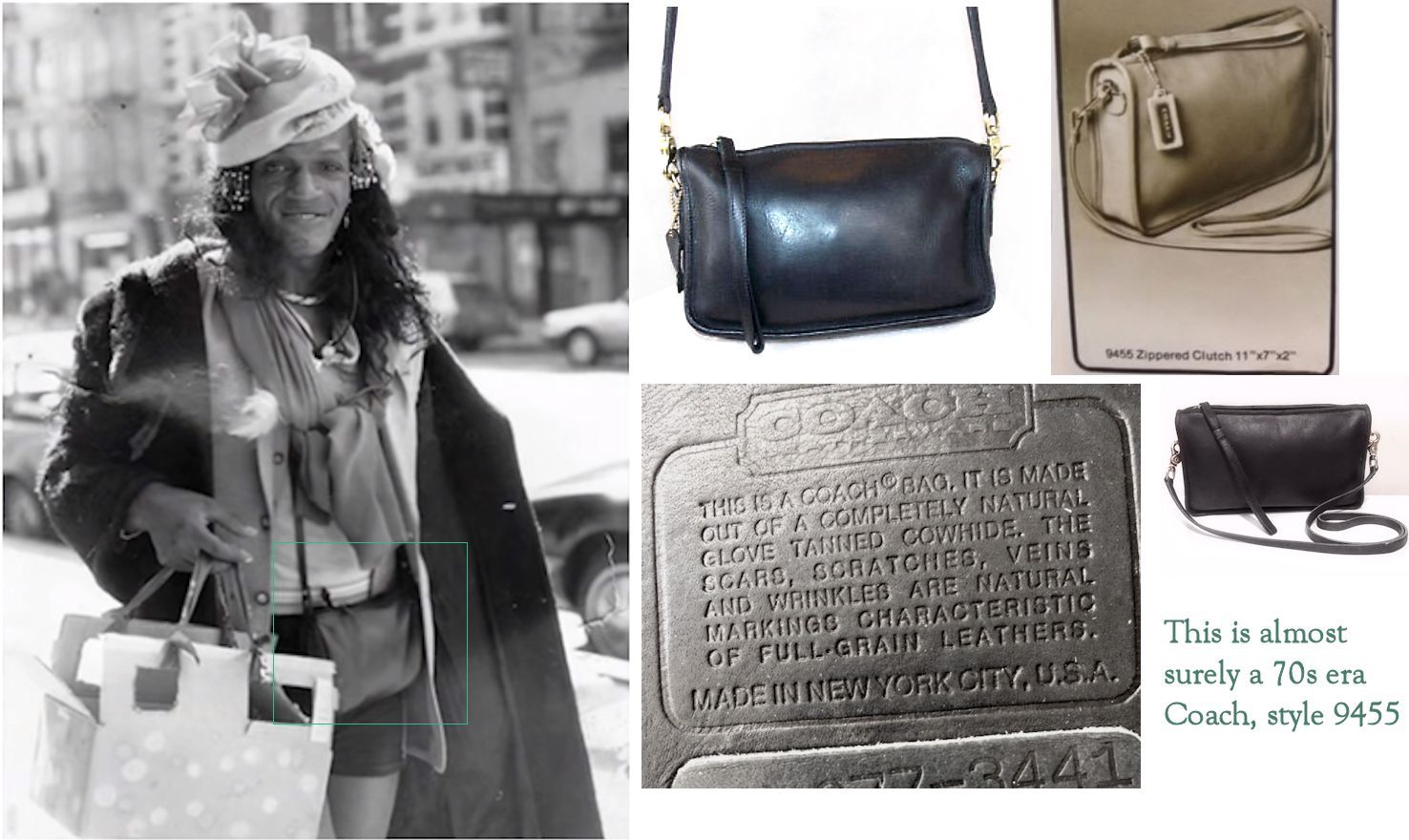
The final heartbreak is that, in some of those surviving images, we see that Marsha had at least one fairly obvious Coach purse (appears to be the 9455, zippered clutch with detachable strap, here worn crossbody). Sylvia's bag, while standing near the police barricade, and again on the march in '73, may also be a Coach tote, and the tubular straps are very much like those used on Bonnie Cashin's first larger totes. The staff at Coach must have noticed this, too, if they made the "50 Years Proud" video with selected (much later) vintage footage, and yet they said nothing at all. What is the purpose of having an "Archive" of handbags if it cannot be used to identify the bags carried by such historically significant figures at a time when the very act of carrying a handbag was a declaration of revolt? Was there ever a time when a handbag meant more? As people with an interest in handbags in general, we would really have been curious to know more about the bags Marsha and Sylvia chose, whether Coach brand or anything else, when venturing out with a bag meant so much more than style. But new-Coach hired dancers instead, and not one bag was to be seen in their 'commemorative' video. This, from America's handbag brand? (It's yet another WTF moment with this new-Coach.)
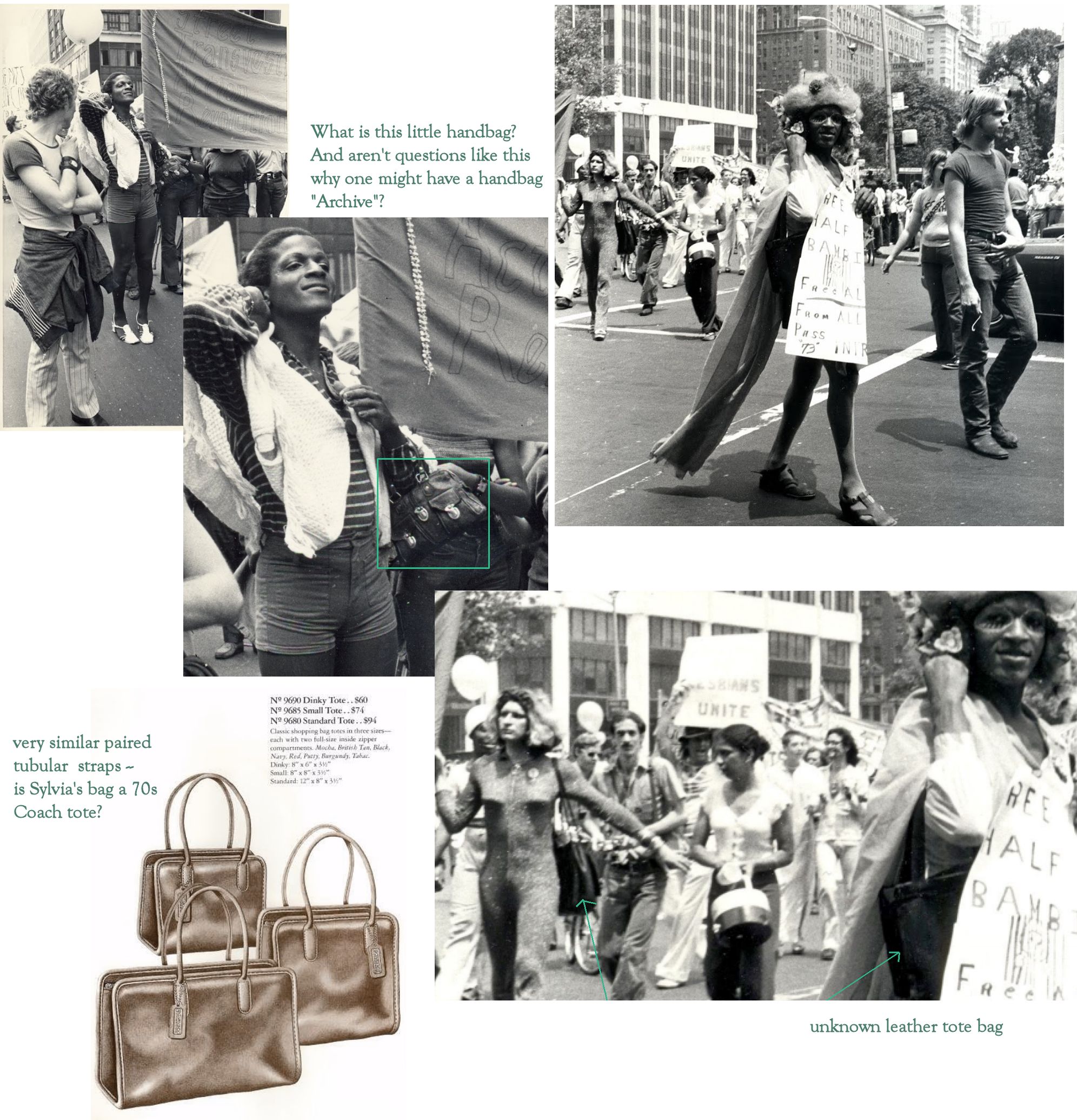
Were Marsha and Sylvia not good enough for this new $$$ designer-lifestyle-brand? Their bags wouldn't have been bought new even back then, but more likely from the Salvation Army where they shopped, because these people were poor, often desperately so, living hand to mouth. But they were crucial. They were the ones fighting like hell for the improvements the LGBTQ+ community enjoys today, fighting racism, misogyny, homophobia, and every other force of organized societal conformity and, yes, brutality. In Marsha's case, she battled mental illness, too, without humane treatment, and later lived with HIV, while caring for others similarly afflicted. She had been arrested literally hundreds of times. But she remained defiant. And yet infinitely generous, loving, and protective of her community. Everyone who knew her said, in their own way, this was a truly good person, there was a light that shone from her, which is why she was widely regarded as a bodhisattva, a mensch, even a saint in her own lifetime. Estelle felt that Marsha was like Joan of Arc, at times guided by a divine voice that others misunderstood. (Joan of Arc believed she was guided to take up arms by the voices of Saint Margaret and Saint Catherine of Alexandria.)
The way Estelle described meeting Marsha had a quality of both horror and magic about it. She felt Marsha had literally saved her life. Fleeing her increasingly abusive, nearly murderous stepfather in Maryland, Estelle was still "half-Esteban" when she arrived penniless in the Village in 1972, a 13 year old runaway covered with bruises and deep gashes from a struggle in which her drunken step-father had beaten her and tried to shave her head with a straight razor. She hid under cars and in bushes, eating from trash cans, until she felt she was healed enough to show her face without attracting attention that would get her handed to police and sent to a reformatory or, worse, sent back home to Maryland. On her 9th day in New York she entered a deli that seemed empty and asked the young Latino man behind the counter if she could please clean their sidewalk for a sandwich. He didn't say a word but just came around the counter and violently threw her out the door onto the pavement. She was stunned as he had been smiling when she entered. But he wasn't smiling with kindness as she had thought. As she lay there, at the breaking point, an elderly white woman came out of the deli, gave her her own food wrapped in a napkin, and told her, "Find Marsha! You must ask until you find Marsha Johnson. Go now, ask those people down there," and she pointed to a group at a distant corner. Estelle thought she was being told to look for another older white woman, maybe some kind of social services/institutional person, which she was afraid to do for fear of being sent back to Maryland. She walked toward the group pointed out, but on approaching they were prosperous looking white men in suits waiting to have their shoes shined. Very much afraid of them, she kept walking, for hours until it got dark, and returned to the deli, which had a sheltered stoop, planning to look for the woman who had given her the food in the morning. And it was huddled in the deli's doorway that night, just as two unknown and visibly drunk men had woken her and blocked her from leaving the threshold, that Marsha P. Johnson and her friend Eve found Estelle. "Now Billy, you know that's my child...come with us darling, we looked everywhere for you!"
And that was it, Estelle was safe. She described Marsha as other-worldly, tall and beautiful in a white dress with a flowing green shawl, like a mixture of Diana Ross and the picture of Our Lady of Guadalupe whose image she still carried for protection. From the instant she saw her, she knew this was the Marsha she had been told to find. Marsha knew everyone and everyone knew her. And they knew she protected desperate children, though she had almost nothing herself. Marsha and her friends found clothes for Estelle, including longsleeve shirts to hide her bruises, a pair of glasses good enough to see clearly with (hers had been broken in the struggle with the razor), and even a tote bag. They moved around, but they stayed together as a group, for safety. She saw Sylvia twice, but only from a distance, and afterward long regretted having been too shy to talk to her. (Mostly she was afraid of Sylvia's then-serious boyfriend, who she was staying with then and therefore wasn't with Marsha, as she usually was. This was apparently just before they officially formed STAR as a group.) They stayed at various friends' apartments, frequently had pot-luck dinners, and sometimes they visited churches --all sorts of churches, various denominations. It was Marsha who told Estelle to go in and ask for the Virgin's help, and she would receive it. For years Estelle had felt too ashamed to even set foot in a church, but Marsha told her that she knew that the force that united the universe loved all people equally, because she had been told so directly. Estelle believed her, that somehow Marsha really did know this to be true, and that was when she began to truly heal. She always felt that was her moment of epiphany, of becoming truly herself, and it changed her life.
Within ten days Marsha had found Estelle a legitimate job and a safe, permanent place to stay. A closeted but sympathetic businessman --known to the people on that corner she had feared to approach-- was willing to overlook her age and let her sleep in the back of the office if she cleaned it at night and ran errands during the day. Many children in her position ended up forced into survival sex as prostitutes, controlled by pimps and addicted to drugs, and died that way. Estelle was convinced that Marsha was the only thing that saved her from that fate because that job got her off the street, allowed her to learn bookkeeping and, eventually, accounting, which she liked and worked at in one form or another thereafter. Estelle never forgot Marsha as her rescuer. Within a few years she had enough money that she could return home to Maryland, fully Estelle, fully herself, free in her mind. She confronted her battering step-father, turned him out of her mother's house, and thereby protected her younger siblings from what she had suffered at his hands. She walked with her head held high then, and credited her time in New York, and mainly Marsha, with showing her how that could be done. She had become a powerful woman. A few of us had even heard of this Marsha who saved Estelle's life before, but none of us really knew she was that Marsha, the force for gay liberation as a revolutionary movement, the Marsha P. Johnson of Stonewall. And Coach --always Estelle's favorite handbag maker-- produces a video for Stonewall at 50, directly commercializes Marsha's style and presence, without even knowing anything about her, and then ignores her! Can you understand the heartbroken rage now? We can.
Twenty-three years after Stonewall, Marsha was killed for being a transwoman. This year alone there are six new books on Stonewall and Marsha appears in them all, sometimes on the cover. Coach --again, the handbag company-- had a real opportunity to say something here, at the 50th anniversary, if they were going to exploit the period's imagery and say anything at all. We might have actually reversed some of our more general bad opinions of new-Coach if they had taken this opportunity to stand up for Marsha P. Johnson and make it clear, the battle is not yet won, neither true equality nor even safety are yet achieved. And justice has not even been done for one of the most important founders of the movement. But they didn't use their resources to make that statement at all. Their Fall 2019 ads show us what kind of statement they did make.
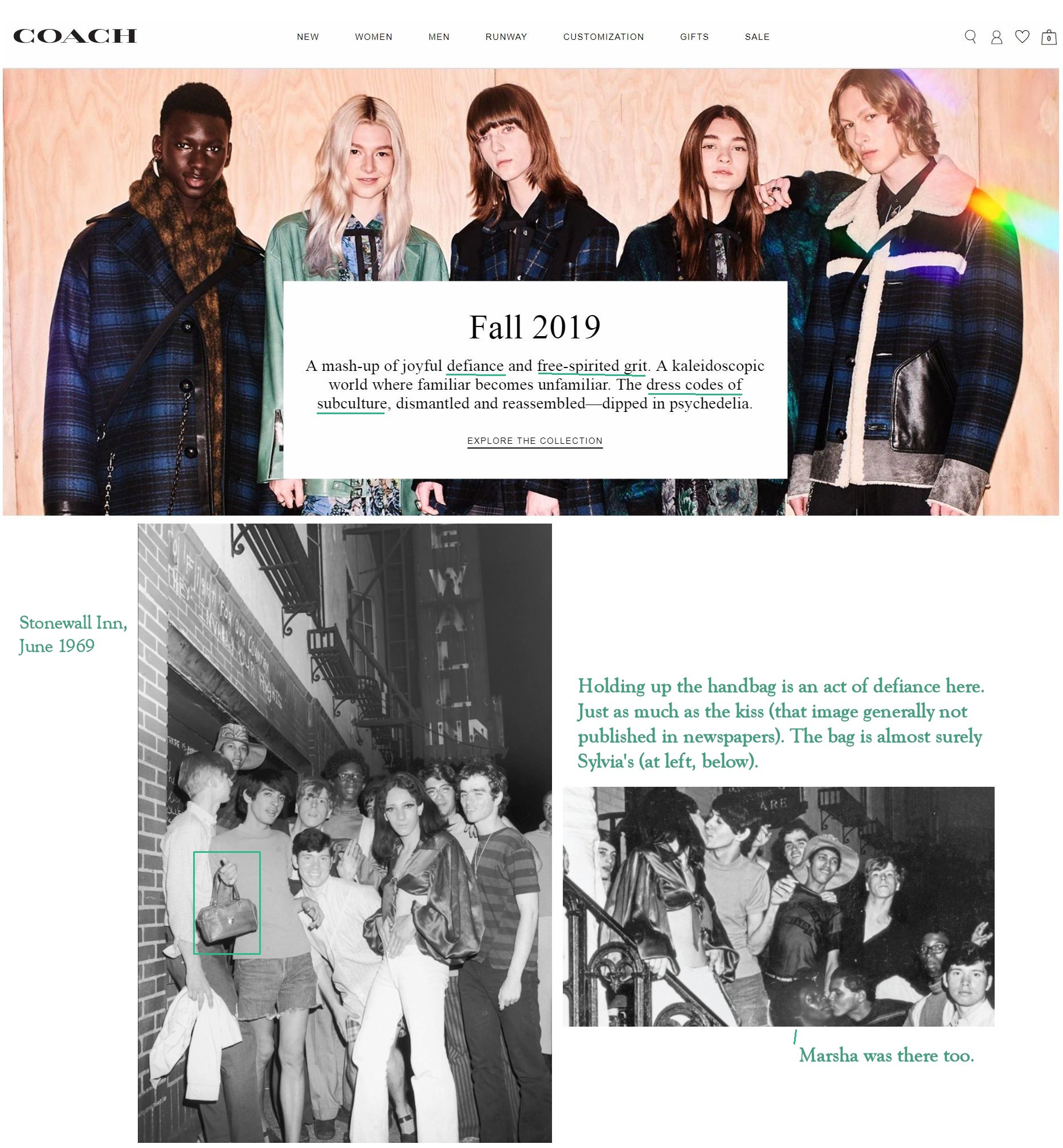
One of last messages several of us ever received from Estelle showed the Coach 2019 Fall image above side by side with these earliest Stonewall photos, with the caption, "Is it just me, or...?" And the answer is no, you don't need a direct personal connection to Stonewall to see that some kind of ugly commercialization is being attempted here. They even state that 'Pre-Fall 2019' is supposed to draw on an early 70s aesthetic (which, if you're old enough, you'll know is wrong for the things that came down the runway, those silhouettes are early 80s, not early 70s, but again, with new-Coach WTF moments are constant). The 70s vibe for many months, 'commemorating' Stonewall, sponsoring Pride (in Shanghai), all build up to runway shows and ads for pre-Fall 2019 looking strangely reminiscent of images of the desperate street kids of Stonewall in 1969. (Pre Fall, 2019: "The attitude of New York. A twilight world where rock-and-roll's elegance is suggestive of a bold early 1970s aesthetic. Debuted for the first time in China, featuring artwork by local creatives." Meaningless and idiotic, as usual, but we're pretty sure ad copy like this wasn't supposed to make you want to pelt these hacks with bricks and shotglasses. And yet....)
In a side by side comparison with some of the earliest and most famous images from the days after the rebellion, we see the real and the fake. Real street kids, like Estelle was in the early 70s, homeless, escaping abuse or thrown out of their birth families for being different, living day to day in fear, but then finally rising up and rebelling. Sylvia is prominent in this photo, but almost never mentioned by name, young and defiant. Contrast that with the suburban, affluent (look at the prices!) faux-rebellion, faux-"defiant," faux-"subculture." What a slap. Standing in front of a plywood backdrop, too...90s grungy if the slightly gay vibe scares you? And we won't even get into the idiocy of "psychedelia," but note the little rainbow to the right. Who do you think that's there for?
Notice too, in the real Stonewall image, the kid holding the handbag, and holding it up like a trophy, a handbag as an act of defiance. It's almost surely Sylvia's bag, as she was among the few brave enough to dress as herself and carry a bag on the streets at that point. We can see of course Marsha was there too, in the second image, being kissed on the cheek. Cameras were expensive in those days and these photos were taken by a newspaper photographer, but the second image wasn't used in any paper because the kissing was a defiant act that readers recognized and most would have deemed obscene. The handbag-as-badge image is much more famous. Think of what Coach --again, once the number-one handbag company in America-- could have done to commemorate Stonewall. And contrast that with what they did do. Wow.
This is bad enough, but the problem isn't just one of history and distortion of that history. It's a problem in the now, too. New-Coach is making a range of pseudo-not-quite-sure-but-we'll-try-it 'man-bags' lately. And this timid, ambivalent attempt to be all things to all people (greater market share) just comes off as cowardly and opportunistic. Several of the current bags are exactly the sort of thing that would have gotten you beat down if carried on the street, back in the day, by police and other bigots. And they might still get you that today, depending on where you are, what color you are, who you're with, even the hour, what else you're wearing, and who notices you. This is a serious problem that hasn't gone away. Things like "rugged" briefcases, "varsity stripe," and the frequent camouflage and goofy faux-military patches on "men's" Coach stuff from a few years ago weren't neutral but made problems like this worse. There is less of that aggressively 'masculine' imagery lately (because it was a fail commercially), but now it's replaced (except for some straggling camo and "wild beast print") largely with the cartoon dinosaur they cooked up in 2015 and have taken to calling "beloved" at every opportunity (begging the question, by whom??). Beyond the fact that "Rexy" reminds far too many people of those magnified images of parasites seen on anti-tick pet products (clearly not enough people in the focus groups!), it's worth noting that 'Rexy' is being pitched more in the Men section than the Women. Is a cartoon dinosaur supposed to cancel out the 'man-purse' vibe for a certain segment of the target audience? Is presenting machine-printed graphics on PVC as "brush strokes" supposed to convince as 'high art' and therefore cancel out the snarling dinosaur for a different target group? The whole thing just seems...confused.
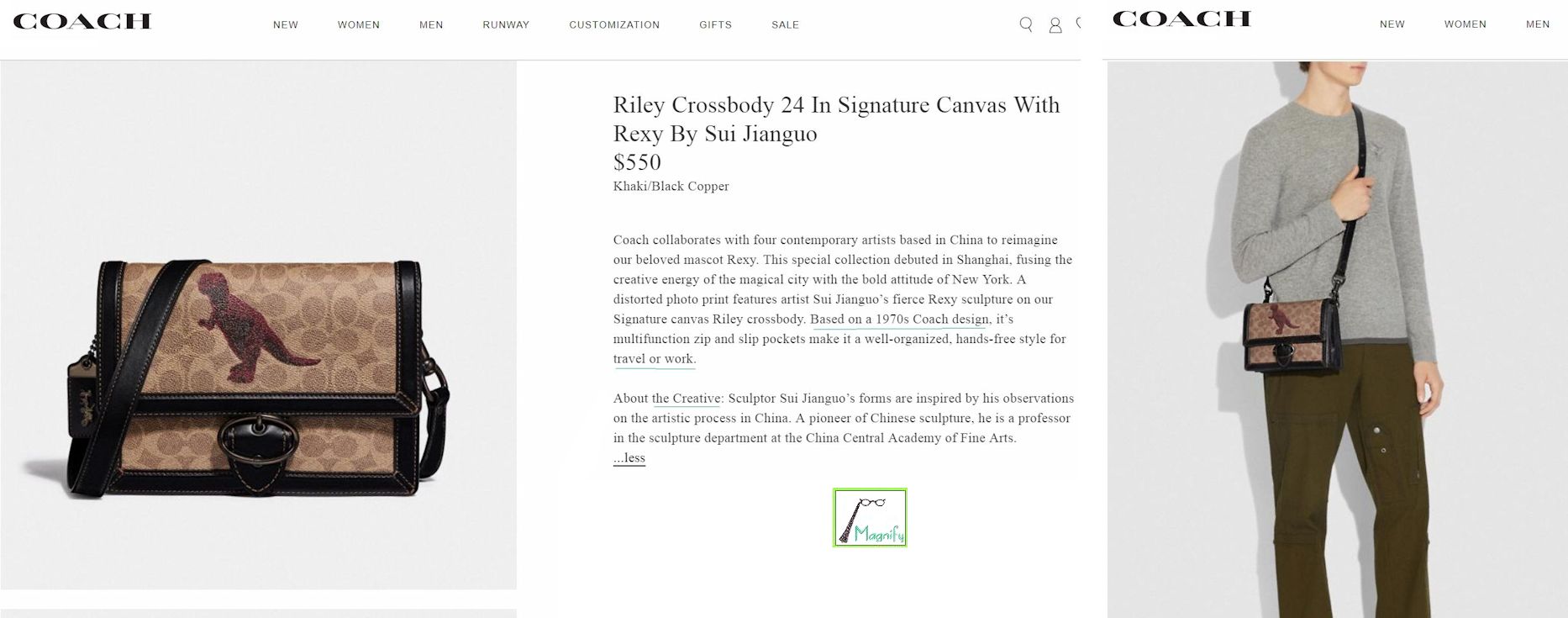
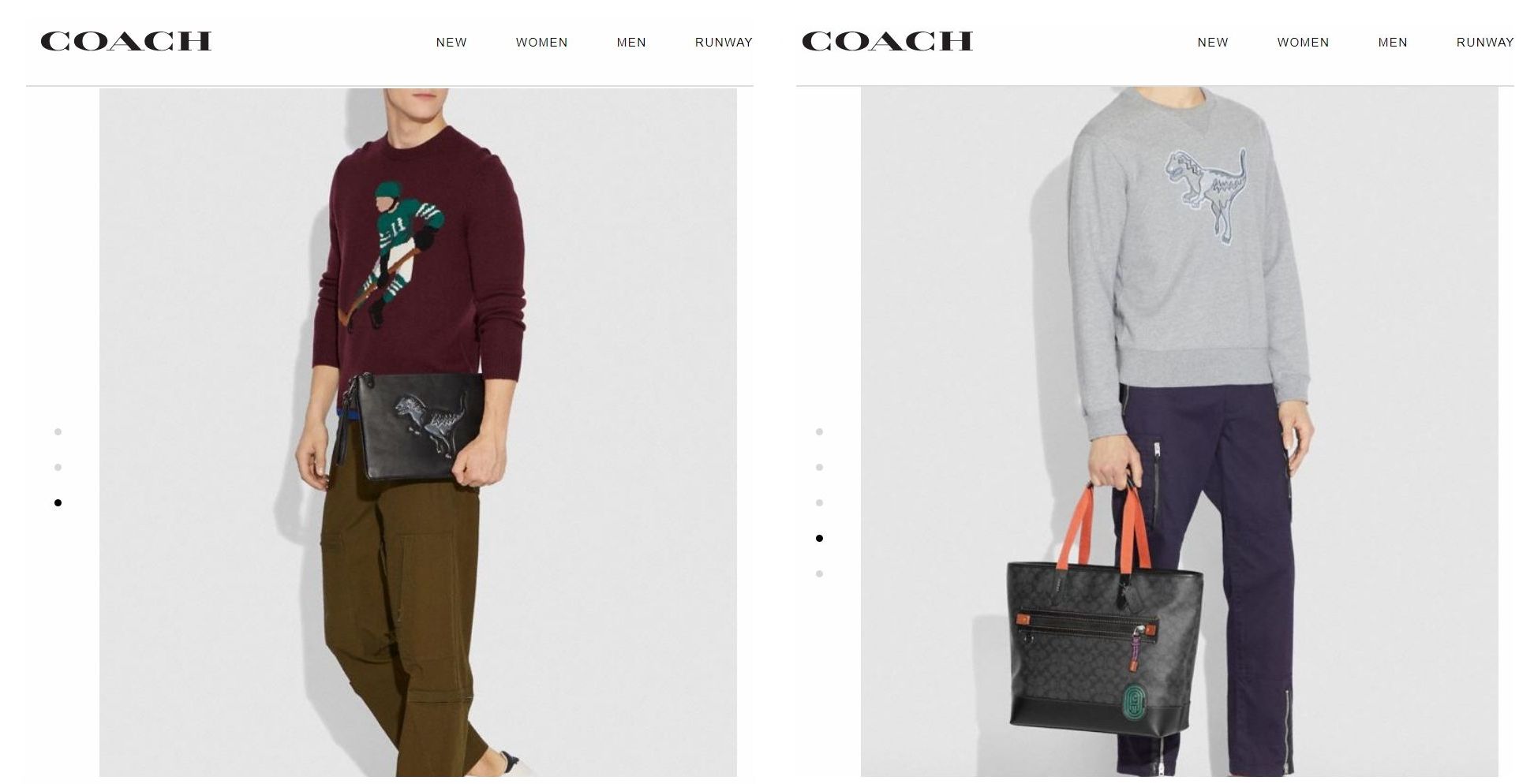
Only people like Sylvia Rivera and Marsha P. Johnson were brave enough to carry something that would be taken as a purse back in 1969. Only people as brave as Estelle dared to do it in the 70s and 80s. So if Coach is making 'man-bags' now, and dressing its young models as pseudo-street kids a la Stonewall, would it really have been such a radical concept to just make good leather bags for everybody, without sorting them into men's/women's anymore, so that everybody as an individual, without labels, could choose from everything, because they liked that bag and it fit their stuff? At the very least, why didn't they eliminate the rigid anachronistic men/women sorting of their site? This was Estelle's reason for lurking in the "Men" area of Coach's website from her hospital bed -- if they want to be allies, then be a leader and chuck that arbitrary, harmful division into two 'opposing camps.' Just chuck it altogether. It's high time. We think she was right about this, and that day isn't far in the future: the end of socially constructed binary gender as a meaningful category used to sort, and thereby constrain and restrict, a literally infinite variety of individuals. If Coach was going to commemorate a gay riot, how radical would this really have been? It could have been a real teaching moment. And everyone we've talked to about this, including people in their 80s and one in her 90s, was in favor, as part of the modern world, and would have respected Coach for it, had they done it. But apparently it never occurred to the company to eliminate the strictly segregated Men/Women 'ecosystems' of their site, not even the choice to sort into "Gifts for Him" and "Gifts for Her." Far from seeming an ally, now they just seem like opportunists (again), and that's really what queerbaiting is. Shame, new-Coach/Tapestry, shame.
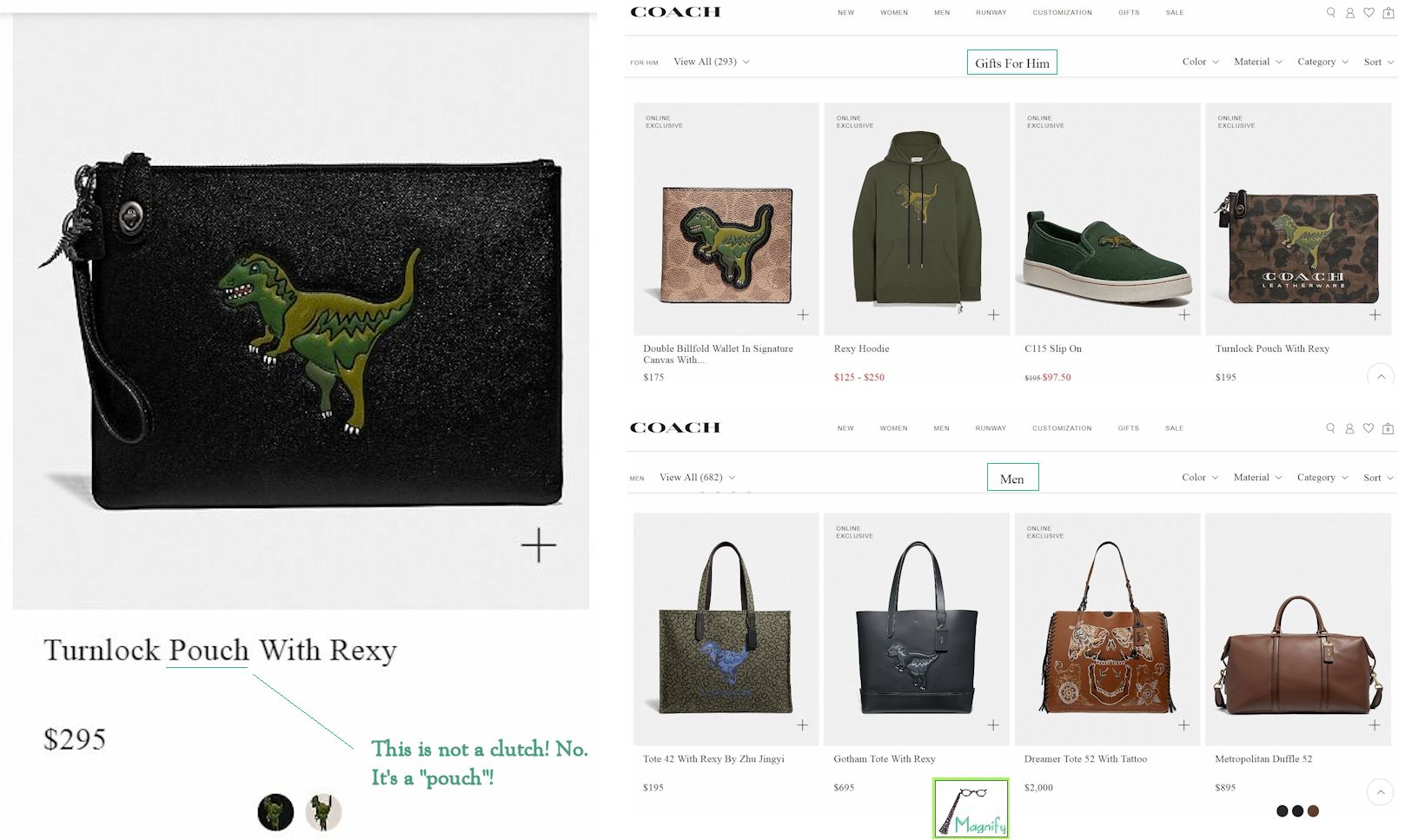
What this leaves us with is a distinctly divided series of categories of people and the products pitched to them. This is unappealing on its own, but is made worse by the subtext lurking in certain terms, "rugged" being among the worst. (Notice how "rugged" has gendered baggage, where "durable" is far more neutral. But rugged will reassure the (cis)men, while "durable" might be an issue with a single-year warranty. Naturally they went with rugged for the briefcase handles. Nothing pitched to anyone but (cis)men would ever be called "rugged" anymore, although the leather used in Coach's regular handbags was still described as rugged in the Coach ads as late as the early 80s. But those days, totally gone, as that faux-unique pink "embellished" monstrosity above showed.)
Coach could have bucked the trend in the larger market, where a 'man's bag' has to be either highly debonair (read: rich, expensive, e.g., Hermes), or more commonly, aggressively rugged, tough, Boss-Man worthy, in order to offset any unwanted (queer) implications, where a man-bag might be taken for a man-purse, Heaven forbid. (Think we're exaggerating? Look at a site called Modern Man Bags, where the first line of text on a page devoted to full-grain bags is: "Men like a rugged, scarred, and wrinkled leather." A fairly bad grade of full-grain, then. Really? Why?) What this seems to have resulted in is a lot stuff trying very hard to appear 'rugged,' as a counterbalance to an unstated fear by these men of carrying a handbag. This whole problem could be eliminated if some leaders in the industry took the step to get rid of the 'man-bag' vs 'woman-bag' categories altogether. There would just be bags for everyone. No one would have to worry about carrying the 'wrong' one anymore and the old categories and tacit assumptions would lose their meanings. Even in buying gifts, they could be chosen based on individual preferences or needs, rather than first limiting things into group a/b. But instead of anything useful like that, we see new-Coach doing something almost opposite, apparently concluding that there might be money to be made from a man-purse...so we'll timidly show a couple in the Men area as a test. (How much has really changed in 50 years?)
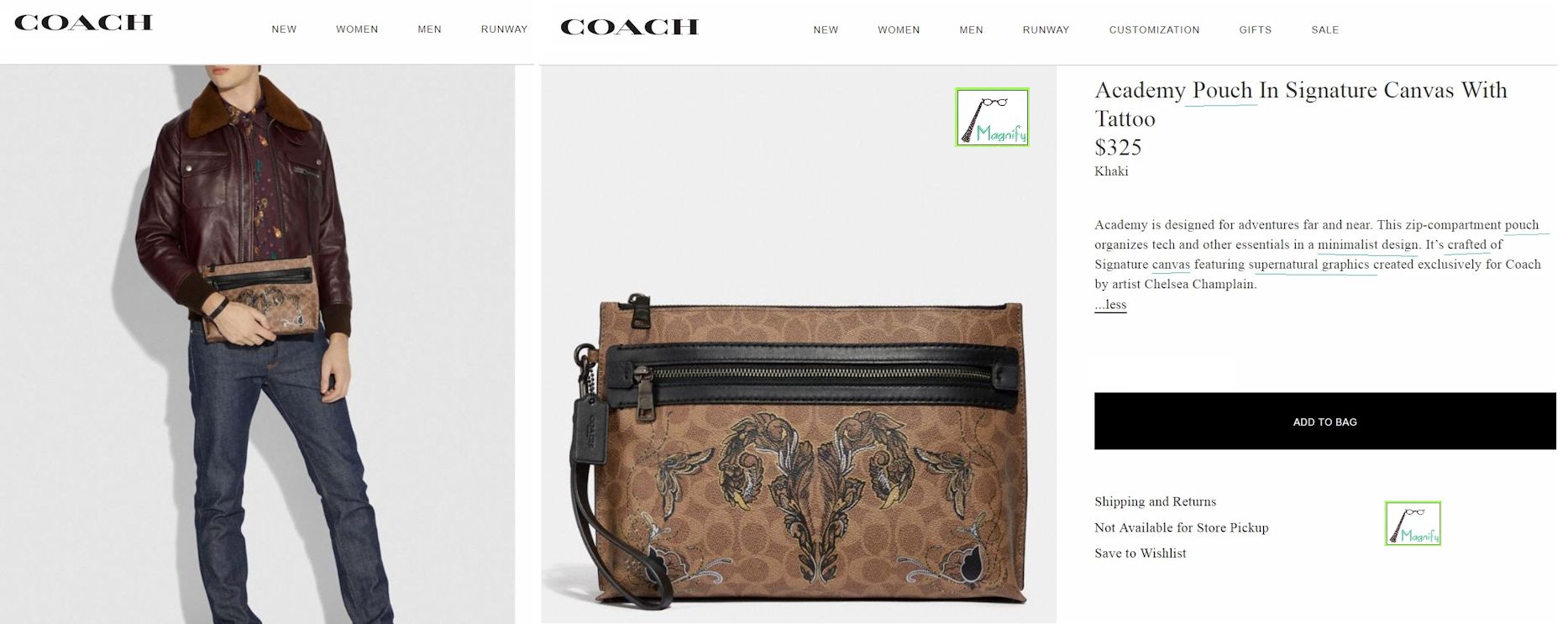
The final sign that this issue was in the minds of the marketing team: pouch. The choice to declare "pouches" in the Men section of the website to describe what has been called a "clutch" by just about everyone for almost a century isn't an accident. But we can't have man-clutches, no! Nor even just clutches for everybody or pouches for everybody, some kind of non-gendered term for a small bag. Not even something new like 'tech-clutches.' No, clutches is definitely too gay, it could scare off sales, and we'll never sacrifice something like profits for any crazy outdated idea like ethics or principles or allyship. Same thing with the bad "artwork," because we know those gays like their art and we can tell them to hug-it, too. In fact we'll tell them we know they've been looking for a cactus to hug. We'll be "inclusive." It'll be great. We'll have runway shows with androgynous models, charge $$$ for our "signature canvas" (maybe they'll confuse it with LV, they're very young and dumb). It'll be like taking money from a baby. To hell with the old norm of men's leather goods, where we had to assume that men knew something about leather quality. We'll just tell those wanna-be bossmen that the briefcases are "embossed" and the duller knives in the box will be confused, yet flattered, and still buy. What do we care, we're a designer-lifestyle-brand now. We'll rule the world. The buyers are children. They liked Barney, we'll give them a new cartoon dinosaur. And there won't be anyone left to note the irony when we proclaim ourselves America's "house of leather" with cartoon dinosaurs machine printed on PVC.
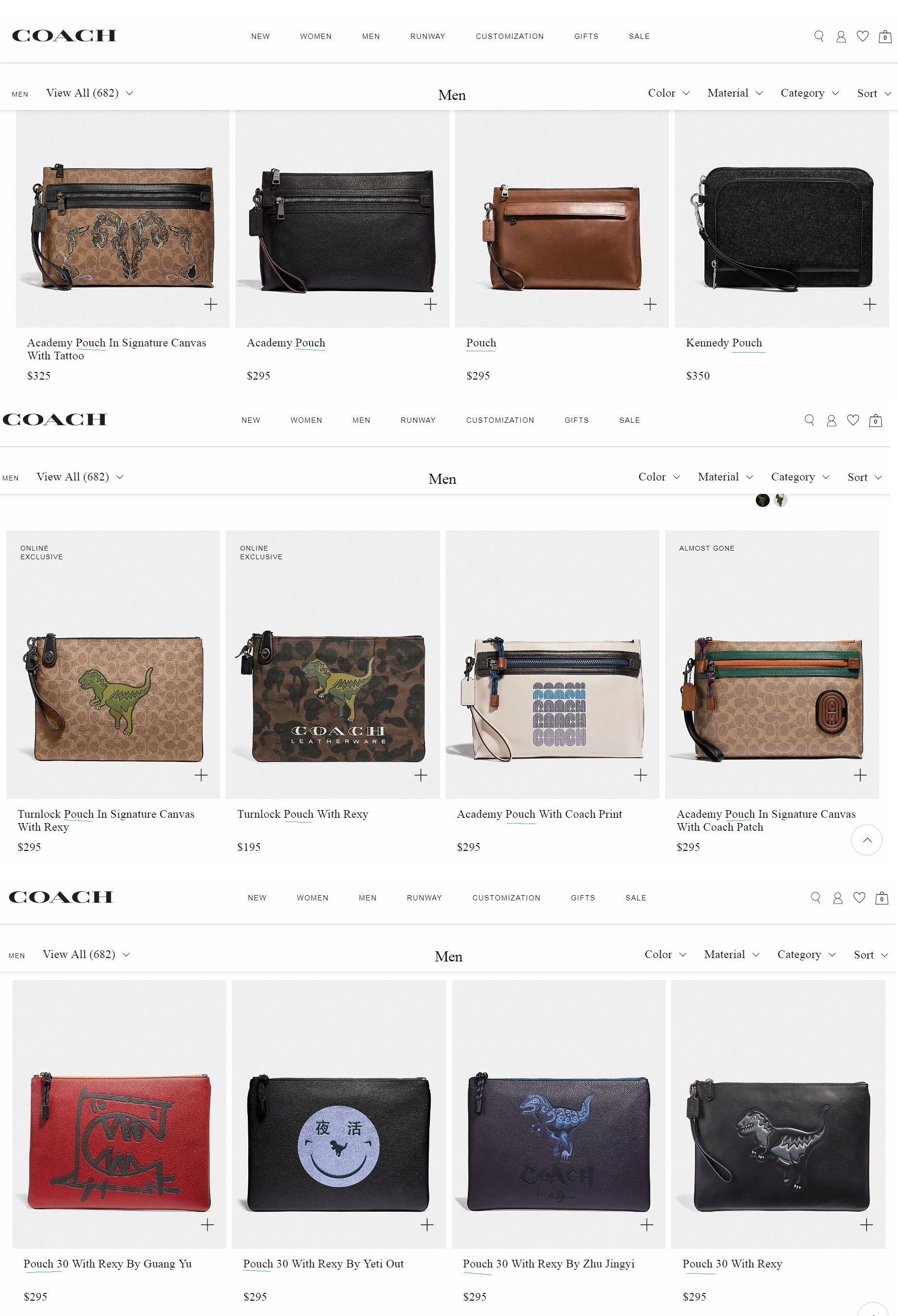
The Coach handbag is approaching its 50th year. Does it have another 50 years ahead of it, or no? We feel the tradition of the Coach bag, as anything recognizable as a Coach bag, is seriously imperiled by numerous misguided decisions taken by those now at the helm. The most significant choice has been the substitution of inferior grades of leather for what had once been some of the best leather used in handbags anywhere, culminating in a recent leap off the precipice of quality in the 2010s. Accompanying this shift has been a pattern of increasingly dubious if not duplicitous marketing patter (hug-it creed leather-alchemy), coy trade terms (genuine glovetanned leather), and the growing tendency, seen throughout Coach/Tapestry's public relations, to regard and address consumers as silly children in need of someone to 'style their lifestyle' for them. (If you recall the old catalogues, often opening with, "Dear Friends," and going on to describe the new product offerings in a neutral way, this change is marked. This company was unusual in approaching buyers on an equal footing, neither obsequious nor condescending, but as sensible like-minded people interested in good leather bags. Contrast that with now, where the adjectives chosen don't describe the physical product on offer, so much as the supposed identity 'aspirations' of the imagined consumer. There is something piteous in it.) It was one thing to recognize, somewhat belatedly, that everyone had had enough of the cheezy C fabric bags (e.g., Huffington Post, "Here's How Coach Bags Turned From Coveted Classics Into Tacky Chaos"), but quite another to suggest, yet again, that the company was making a return to real Coach (full-grain, full-aniline) leather, but instead switch to "genuine leather," and then tell us to hug-it.
In an attempt to become a conglomerated 'luxury lifestyle brand' a choice has been made to gut out the very core or dignity of the product, which is what it amounts to when a leathergoods establishment like the Cahns' substitutes faux-grain for full-grain, shifts production to third-party suppliers overseas, adds fabric, canvas and plastic, and doubles or quadruples prices, yet calls it "leveraging value." You can actually hear Victor Luis talking about how they'll "leverage value" in an interview with Brian Sozzi from 2016, after the acquisition of Stuart Weitzman but before Kate Spade, where he describes the initial "character-based" merchandizing ploys (pre-Disney, when Pac Man and Snoopy began to be plastered on Coach bags) as attempts to "engage with customers in very emotional, impactful ways" using "nostalgic retro characters" to create "impactful fashion vignettes." [Retch] And this would be done with a mind to remedy "overly promotional pricing," which is to say, the elimination of outlet stores (which is in the works, in an effort to 'elevate brand status'), and a general price hike. (Sound quality is poor at first, and Vevers can barely be heard, but the crassness and general used-car-salesman quality of Victor Luis' mentality comes through loud and clear, especially on the matter of Coach as a "house of leather" with "heritage, quality." That is, exactly what Pac Man on a Coach bag negates.)
There is also a noteworthy trend to chatter optimistically solely for the benefit of shareholders --now the only population that really matters-- including an overly rosy vision of Tapestry as America's luxury brand conglomerate, on the order of a LVMH (Louis Vuitton, Dior, Givenchy, Berlutti, Fendi, Loro Piana, etc.), a Kering (Gucci, YSL, Balenciaga, Bottega Veneta, Alexander McQueen, etc.), or a Richemont (Cartier, Montblanc, Chloé, Azzedine Alaïa, VC&A, etc.). Yeah, don't hold your breath. We can see this suggestion in many places (including fanciful yet direct comparisons by top staff of new-Coach with LVMH), but another is that SEC filing for 2015, which is a significant period because it marks an early phase of their "Transformation Plan" to make Coach a "designer lifestyle brand" and draw in 'a better sort of buyer.' In that filing we find:
"We believe that the Coach brand, established almost 75 years ago, is regarded as America's preeminent designer, producer, and marketer of fine accessories and gifts for women and men."
Our emphasis. Because wow. We would say this veers beyond arrogant or overly exuberant and into the terrain of delusional. Putting aside the American firms like Ralph Lauren and PVH (Calvin Klein, Tommy Hilfiger) that actually made the top ten lists of most powerful brands in recent years, we'd say the real holder of that position as the preeminent American brand for 'fine accessories and gifts' is a lot more likely in most people's minds to be a little company called Tiffany, which was around for 180 years by that point, and had been classed among the world's luxury brands for over a century. Coach clearly never was, nor ever tried to be, anything like that. Until now. To get a feeling for just how far-fetched the attempts at 'luxury brand' domination are, consider the Forbes list of the 100 most valuable brands for 2019. We see that Coach is not on this list at all, in any category. LV is #12, by far the highest ranked of its type, followed by Gucci at #30, Hermes at #33, and Chanel at #79. The odds of Coach suddenly transforming into something that will displace LVMH, apparently via plastic-coated bags with widdle fwowers and Rexy, seems decidedly unlikely. Here's another list, the "world's most valuable luxury fashion and accessories brands" as determined by Interbrand:
Louis Vuitton - $28.6 billion
Chanel - $20 billion
Hermes - $16.4 billion
Gucci - $12.9 billion
Cartier - $7.7 billion
Tiffany - $5.6 billion
Dior - $5.2 billion
Burberry - $5 billion
Prada - $4.8 billion
And another from Deloitte's "Global Powers of Luxury Goods 2019: Bridging the gap between the old and the new":
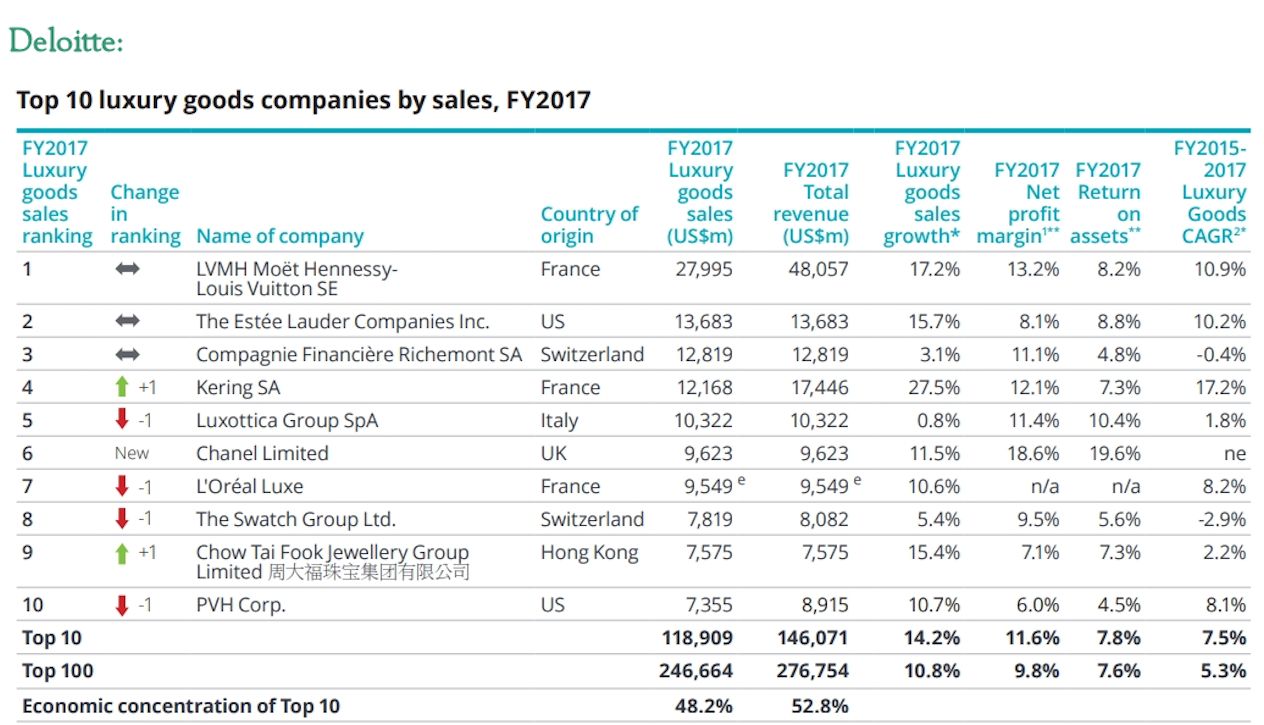
Most people just don't conceptually associate Coach or Rexy or Dumbo or Pacman or anything like it with LV or Chanel or Hermes. And rightly so, because that's never what the Coach company was about. (The truth is, read Paul Fussel's 1983 Class for a glimpse of the mentality that once gave 'status' to Coach bags, following an east coast low-key natural-materials kind of model he describes pretty accurately. It was the antithesis of logo-bling, which was seen as crass and insecure.) But the shareholders don't necessarily know anything about the ethos of the brand, its history, or the people who bought it. For them (and the SEC), we find rationales like:
"We attribute the prominence of the Coach brand to the unique combination of our original American attitude and design, our heritage of fine leather goods and custom fabrics, our superior product quality and durability [!] and our commitment to customer service."
There's some real humor in "custom fabrics," but the bit about quality and durability seems truly fanciful as regards the modern products, which is another reason patter like this seems geared solely to investors, as customers know better these days. The whole house of mirrors in fact seems designed to convince uncertain investors that the serious fall of Coach share prices in recent years (and the concurrent climb and ascendency of previously inferior brands like Michael Kors) was only a temporary result of the bursting of the handbag bubble in general, rather than a real series of errors by Coach (product design and quality, market research, PR, marketing, etc.). And it can all be remedied by creating an "upscale aura" again, as we see in a promo piece in Fortune from 2017.
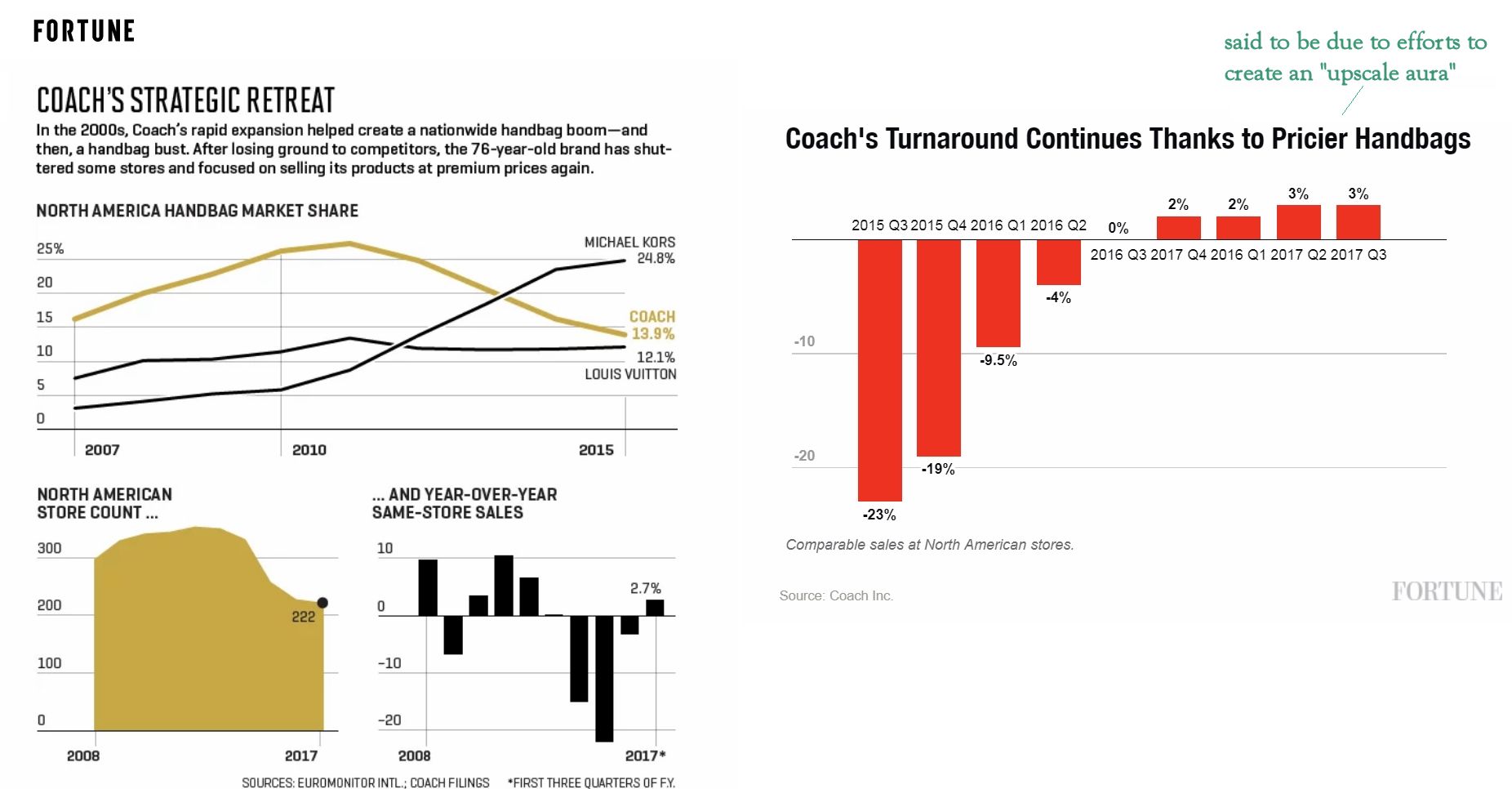
How do you create an "upscale aura" these days? Elimination of outlets (even though outlets still made up a majority of Coach sales figures in those charts above) and product placement in Neiman Marcus? Opening a flagship store in Paris (note "the brand's repositioning plan within the luxury segment, notably in its domestic market in the USA")? Runway shows? We saw some of that with the scraptrash bags above, but none of this seems to explain a situation where "sales are down but profits are up." Is that the 'upscale aura' at work? Or is it more easily explained by a switch to cheaper materials like canvas and (faux-grain) leather as a cost-cutting method, along with use of third-party suppliers in Vietnam (China is too expensive now) and Myanmar? (That's right, former Burma, where slavery and child labor are common, being gay is punishable by life imprisonment, and there's a genocide against the Rohingya. That's where I want American corporations making my handbags. Such an 'aura' there.) We would ask, at what price, these profits for shareholders? Then too, 'the consumers' one hears of in financial/investment media and in each year's prospectus, peon-like and presumably oblivious, can only be driven along like lemmings for so long. Once a substantial cohort of lemmings has gone over the cliff, they won't climb back up to buy more product the following year, year upon year, as should be obvious by what it means to run over a precipice. As has been made amply clear by Coach/Tapestry, even before the acquisition of Kate Spade and the name change in 2017, their "Transformation Plan" is premised on shifting the consumer base from the US to China. (We can also see the surface form chosen for this effort in things like the ham-fisted blurb accompanying the canvas/leather bags with killer-clown style pink smileys.) By 2018's SEC filing, we find that, "Manufacturers of Coach products were primarily located in Vietnam, the Philippines, mainland China and India." And, "We currently plan to open additional Coach, Kate Spade and Stuart Weitzman stores throughout Asia and other international markets, both directly and through strategic partners." Why? Now it's formalized: Tapestry/Coach is making "efforts to expand internationally into a global house of lifestyle brands."
No wonder the qualitatively cheap new Coach bags have so little in common with the excellent Coach leather bags of old. And repositioning as a 'house of brands' (at other points the 2018 document uses Luis' phrase "house of leather," too) means having a nuanced grasp of sociology and demography. On this score Tapestry/Coach seems uniquely obtuse. To get a feel for how pronounced this is (remembering, they want to be the American LVMH), it's worth quoting at length from Deloitte's 2019 analysis of the changing landscape of luxury marketing:
"Sustainability is KEY to win new customer generations' hearts. Historically, the luxury industry has been associated with concepts like excessive consumerism, extremely high costs, elitism or guilty pleasures. However, as the new generations are taking over the market with their new values, consumers' expectation for luxury brands are changing accordingly. Ethics and moral values are becoming increasingly important for consumers, in such a way that they are starting to strongly influence their purchasing decisions. Environment, sustainability, animal welfare, production and labor practices, positive impact on communities are all elements now taken into consideration when buying a product, and luxury goods are not an exception. In particular, younger generations and millennials are the most dedicated to sustainability and deeply care about a brand's ethical standards. Affluent millennial consumers want their preferred luxury brands to be involved and provide a positive contribution to their ecosystem with practical actions and are willing to pay a premium price for those products that come from a conscious brand. In fact, since they value transparency and authenticity, they expect the brands that they buy to reflect their own values. The new affluent generations are more socially and environmentally conscious, and so have higher expectations of luxury brands to be more sustainable and ethical in their production processes. This implies an important lesson for luxury brands that want to retain these customers: they need to evolve towards new models of ethical and sustainable luxury."
Our emphasis. We'd agree in this appraisal. And doesn't that sound a lot like what the old Coach creed was? It was a guarantee you could trust to mean the materials were natural, ethically sourced, worked up into bags by skilled workers fairly-paid and respectfully treated, by a company that was run by generally like-minded people. This is the deeper reason the 'transformation' of the creed into the 'storypatch' seems like such a slap. Somehow Tapestry/Coach remains remarkably clueless about all of this, on ethics and honesty, obviously, but even more so on any inkling of sustainability. Far from the old model, where the Cahns actually refused again and again to move the original Coach factory outside of NYC to cut costs, this new third-party manufacturing model in Vietnam/China/Myanmar (wherever is cheapest and least environmentally regulated) seems unusually mercenary and unaware, even compared to other brands. But they're making throw-away bags now, which has a lot to do with that. A couple of years back, "At Coach's fall 2017 New York Fashion Week show in February, Vevers showed off irreverent fare such as leather doctor bags covered in prints of vintage cars or cherries. 'The idea of luxury has shifted so much,' he tells Fortune." Painted/printed graphics of cherries and super-polluting vintage cars on disposable faux-grain bags lack reverence for what? Not just nature, but the old Coach ethics, we'd say, and we don't think that's a good thing. But it does look like the epitome of that oxymoron new-Coach loves to tout now, "affordable luxury."
By 2018, we heard that Coach would become fur-free by Fall 2019! But then, of course this is the new-Coach, where full-grain ball glove leather becomes "genuine glovetanned" and the creed quality-guarantee becomes a storypatch (it's storytime!), so everything must be understood in that light. Lambs don't count, because that is technically a hide and not a pelt, thus not "fur." (Shearling is the skin of a yearling lamb, shorn once; the skin is classed as a hide.) The fur taken from Angora rabbits and goats also doesn't count as pelt, thus fur. Instead, as InStyle relates, "The American fashion house has promised to completely phase out all types of animal fur, including mink, coyote, fox, and rabbit by the time they debut their Fall 2019 collection." Because, you know, Coach was always a major producer of mink and fox fur, right? They also won't be using pinecones, granite, or antique padparadscha sapphires in their collections. And they never did...but what a relief! Not for the lambs, of course, but we're a designer-lifestyle-brand now, we can't worry about that. And we'll take those lambskins and make them look as much like shaggy fur coats as humanly possible, not making shearling so much as mouton (i.e., hair-outside sheepskin), which was always an imitation of beaver fur coats. And we'll complete the shaggy fur look by printing our schlocky CC logos all over it! No normal hair-inside shearling for us, no. Instead we'll continue to promote the look of and demand for modern fur coats as much as possible. We're a luxury brand now. Maybe we'll trim some in snakeskin, too. We'll only go faux-vintage and retro and copyist in the design. We'll take more of those lambs and sheep (always a byproduct of food, mind you, since everyone today eats mutton daily) and make them into cheezy striped jackets which, when the style was original in the 70s, were always made of fabric or vinyl. And there's no irony here. No, we're not ironic in our BS. We're "iconic" now, whatever we do. Because we said so! (What emperor's clothes? Hans Christian who?)
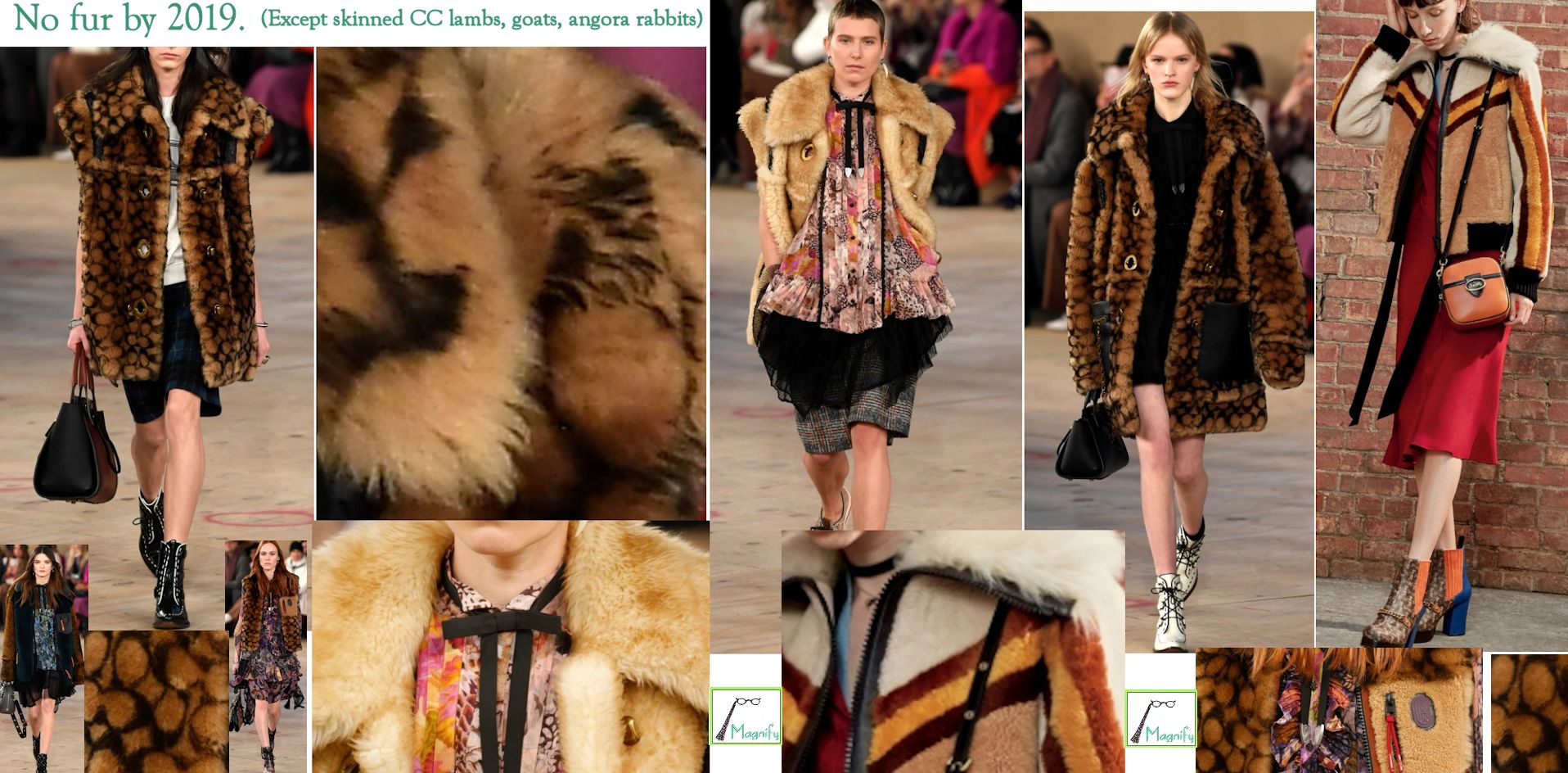
Unlike LVMH or Kering, which understands that brands must rise to meet shifts in consumer expectations if they want to survive, Tapestry/Coach (comparative sniveling yet boastful upstart that it is) just has better information. Instead, it knows that we, as consumers, must accept that now value inheres in logos alone, not materials, let alone how or where those materials are sourced or worked up into product. We must accept that the new $1000+ disposable 'leather' kitsch bags will only last a year now, if that, and then it's off to the landfill --and back to the Coach boutique for yet another, a cycle. We must also just accept that the target demographic will be spoken down to as insecure and lemming-like little girls, especially from China, who barely understand English anyway, and of course no one reads the fine print anymore. It's supposed to be like taking candy/money from babies, after all. No one will notice, right? (Interestingly, the first person to draw our attention to the pattern of grammatical bait-and-switch hair-splitting at new-Coach, where they seem to hope "glovetanned" will be confused with "full-grain" and "pelt" will be distinguished from "hide" to exclude lambs, was born in Guangdong and is here completing her doctorate in linguistics. She is definitely what the Deloitte piece calls a HENRY. When you consider that new-Coach has staked its hopes of 'brand growth' on fooling young Chinese women with weasel words because they lack a command of basic English, Jeannie's description of how she and her friends always parsed American ads back home is piss-yourself hilarious. Anxious shareholders, take note.)
To sum up this screed, the Cahns would never have approved of any of this. Nor would Bonnie Cashin. Nor would any buyer familiar with the true superiority of the old, original Coach products --unless that buyer were misled, tricked by misused terms, or otherwise deceived. And it seems the current leadership at Coach, Inc., may be trying to do just that. Both Lillian and Miles Cahn are gone now (Miles just in 2017), and Bonnie is gone, too. But did the new corporate owners of Coach really think that none of us would remember them, and what they stood for? Or even notice and study the superior quality of their surviving now-vintage bags? Did they think none of us would resent terms like 'legacy' and 'heritage' and 'history' being applied to the modern schlock the new Coach is cranking out (Dumbo!), almost as a mockery of the true legacy of giants like the Cahns and Bonnie Cashin, people whose ideas helped to shape a century? And most of all, did they really think no one would notice when the Cahn's proto-ecomark --the original creed-- was replaced by the ridiculously vague "storypatch"? Really? Total amnesia? That kind of arrogant, mercenary corporate obliviousness...breeds screeds.
Thus, if you or someone you know wants a high quality Coach bag that will be with you for years to come and become truly yours...unless and until Tapestry comes to its senses, we'd say go with a vintage one that says the word "full grain" in the creed. Plenty of the original Coach bags are still around in the secondary market and this by itself is a testament to their craftsmanship and general longevity, decades later. (There's eBay, CL, Mercari, but especially Etsy, because everything Coach on Etsy, if it belongs there, is 20 or more years old, "vintage," and therefore always going to be full-grain and full aniline. This includes all Etsy sellers with Coach bags on offer -- not just those of us with a hand in this Screed. For the sake of the Coach bag as we've known it, we all need to band together now!) This word in the creed --full-grain-- is the only time the wording of the creed really matters, since if it doesn't say "full-grain" somewhere in there, then it isn't, but is instead some grade of inferior leather that came into use later. "Full-grain" is no trade term or weasel word, but is a legitimate descriptive term indicating a good quality leather. But if the creed only says "genuine glovetanned leather," well...you now know what "genuine leather" is permitted to mean in the US.
Coach has been reissuing older designs (now designated as classic or archival models) for some years, but from the beginning astute observers have known that the leather quality and construction were declining. This screed has tried to lay out the details of how and why the quality objectively isn't the same anymore. The brand logo alone, now hollowed out, is supposed to give value, where originally that name was just an indicator or guarantee of the actual value, via quality materials and construction. We consider this brand-bankruptcy. We hope its days are numbered.
As of this moment, things for new-Coach/Tapestry are not going particularly well. We really believe there is a large body of people who still believe in the old Coach ethos, enough to keep a handbag company in business for many more years, and with stability. Far from that old Cahn-Coach model seeming dated or 'historical,' it actually feels quite modern and forward-looking to a lot of us, in 2019, if you consider it from a sustainability perspective, with the creed as a reliable pseudo-ecomark guaranteeing a long-lasting renewable product worth investing in for the future. And not just handbags, as 'women's handbags' have been understood, but new bags for new needs. Finally bags for all, without restrictions via outdated ideas of gender-appropriate groups, pink in one camp, blue in the other. It's a huge number of people who could really use a variety of good leather bags. The ongoing demand for something like that can last generations, while the demand for something like a 'designer-lifestyle-brand' --particularly in the absence of a founding designer-- tends toward a faddish if not formulaic quality that rarely survives one generation, let alone three or more. How many people really aspire to lead "a designer lifestyle" these days, let alone believe they can do it by buying into product? If Coach continued to do what the Cahns had always done, making top quality leather bags in pleasing minimalist forms with a longevity guarantee, we would all continue to support them with our buying decisions, including those of us who are just graduating from school backpacks and buying our first 'real-life' bags now. We want new Coach bags, too -- but made like the old ones.
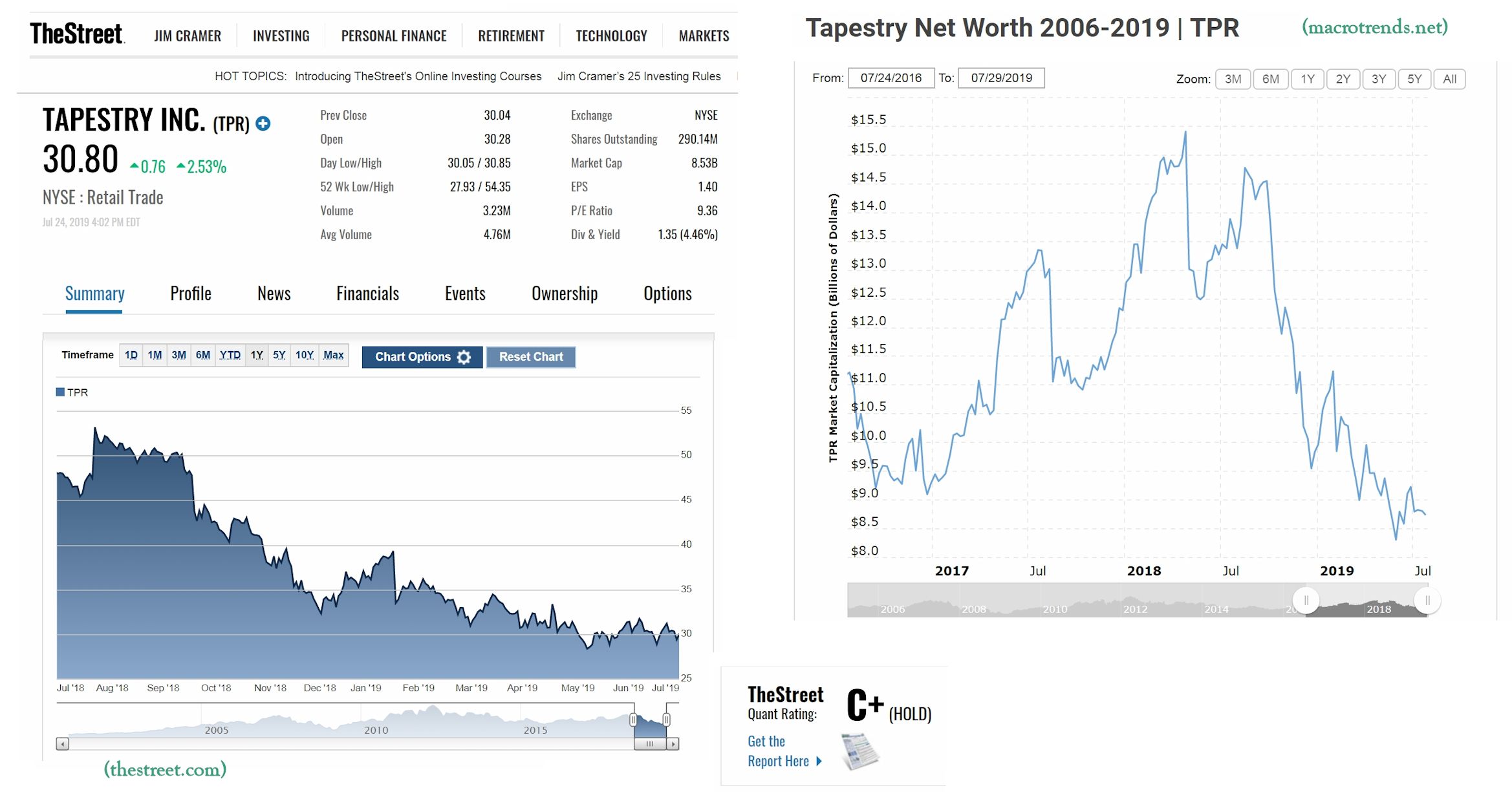
We're still with Lillian Cahn in believing a better kind of purse is possible, including a 21st century Coach purse. Coach/Tapestry might not outstrip LVMH that way, but more and more people don't want LV canvas logo bags, but instead a quality leather bag that's like an investment, not just in that bag's future usefulness and patination, but in sustainable, ethical manufacturing, in the environment, in the world we're going to leave to our kids. Most people we know don't want a bag that's going to be in a landfill in a year, and stay there in its plastic-coatedness for 1000 years. Most of us will go out of our way to avoid buying things like that. Some of us always look for ecomarks like the Blue Angel for reasons like this, while others have grown up always reading the creed. None of us sees a legitimate reason why we can't we have new designs, in a range of modern colors and styles as well as truly reissued classics, made as well as the models of 20 years ago, and using those same sustainable materials. Then you could feel ok personalizing it, without the sneaking dread that you might be tampering with an historical artifact whose like will never be available again. At least until meat is passé and mycoleather/Muskin displaces cowhide, full-grain leather is no less available now than it was 20 years ago, nor are skilled leatherworkers -- some of whom are women, as at the old NYC Coach factory. If Coach wants to support Step-Up and help girls and women, why aren't they supporting women to lead and design for Coach anymore? It was Lillian Cahn who steered Coach Leatherware to making handbags at all, while Bonnie Cashin invented everything that gave those handbags staying power. Women made Coach, for women, and that's a big part of why it worked. How could the current leaders of Tapestry have missed all this and gone so wrong? (There is an answer to this, and you can see it in documents like this, from 2014 when Li & Fung licensed Coach. When the marketing spiel offers you Dumbo while prattling about 'heritage' and 'tradition,' 'heirlooms' and lofts in NYC...recall those PP flow charts about "brand lifespan" and "capturing value at every stage" of it.)
For the customer who values the original Coach bag, then, there seems little choice but to buy only the good quality, renewable vintage bags --or those of a competitor who rises to fill this void by fulfilling the promises Coach once made, but has now broken. Unless and until, of course, Tapestry/Coach, Inc. hears the rumbling in time and opts to really bring the quality bags back, in a form that actually compares with the originals. And really, is it so much to ask of a company that they not gut out and make mere mockeries of the very product that put them on the map via our purchasing power? Coach always meant functional quality bags of superior leather. What can Coach mean after the functionality, quality, and superior leather are gone? If we really appreciate Coach bags, the only thing to do is to back away from the Tapestry trainwreck, unless and until this new regime comes to its senses. Those who were there don't have amnesia. Those who weren't there but are now, aren't actually stupid little girls. And those who are to come --now there's a thought, the young people of tomorrow. They either will or won't have ever heard of Coach bags, based on what Tapestry does now. If they get off the path they're on in time, Taylor Swift's grandkids will look with reverence at the Court bag below, like we look at Marlene Dietrich wearing Bonnie Cashin now.
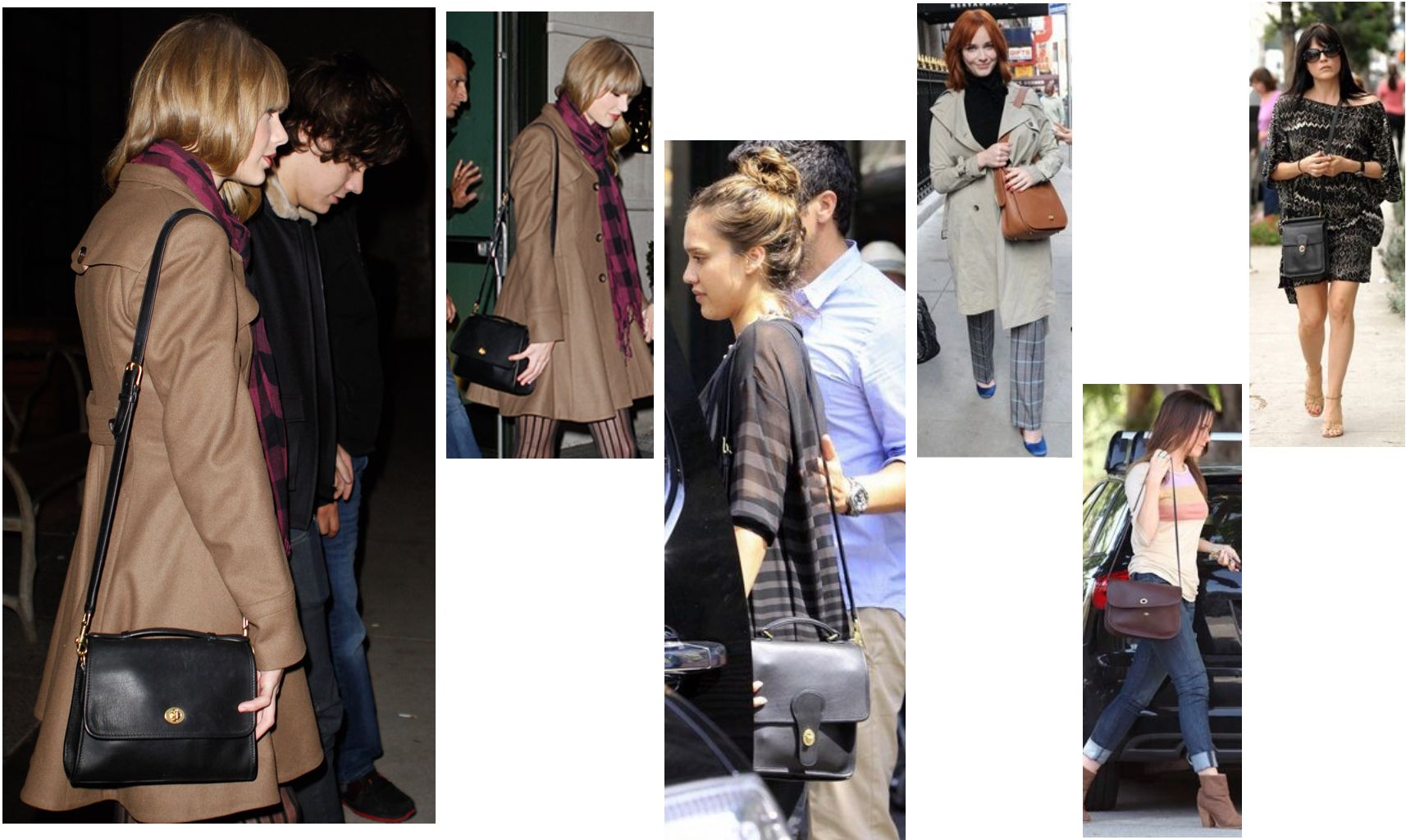
And if Tapestry just won't come to its senses and remember why so many people so loved their original Coach bags, well, maybe the overstock from new-Coach can be the "Dorcelle" bags of the future. The ones that actually sell and are carried will be headed off to the landfill, of course, and quickly...unless maybe we could find something else to do with them?

© The Coach Collectors' Coven
Posted here as a service to Etsy members by Cyberia Vintage
No new Coach until there's real Coach again!!